
Admin
-
Posts
7,477 -
Joined
-
Last visited
Content Type
Profiles
Forums
Events
Store
Gallery
Community Map
Posts posted by Admin
-
-
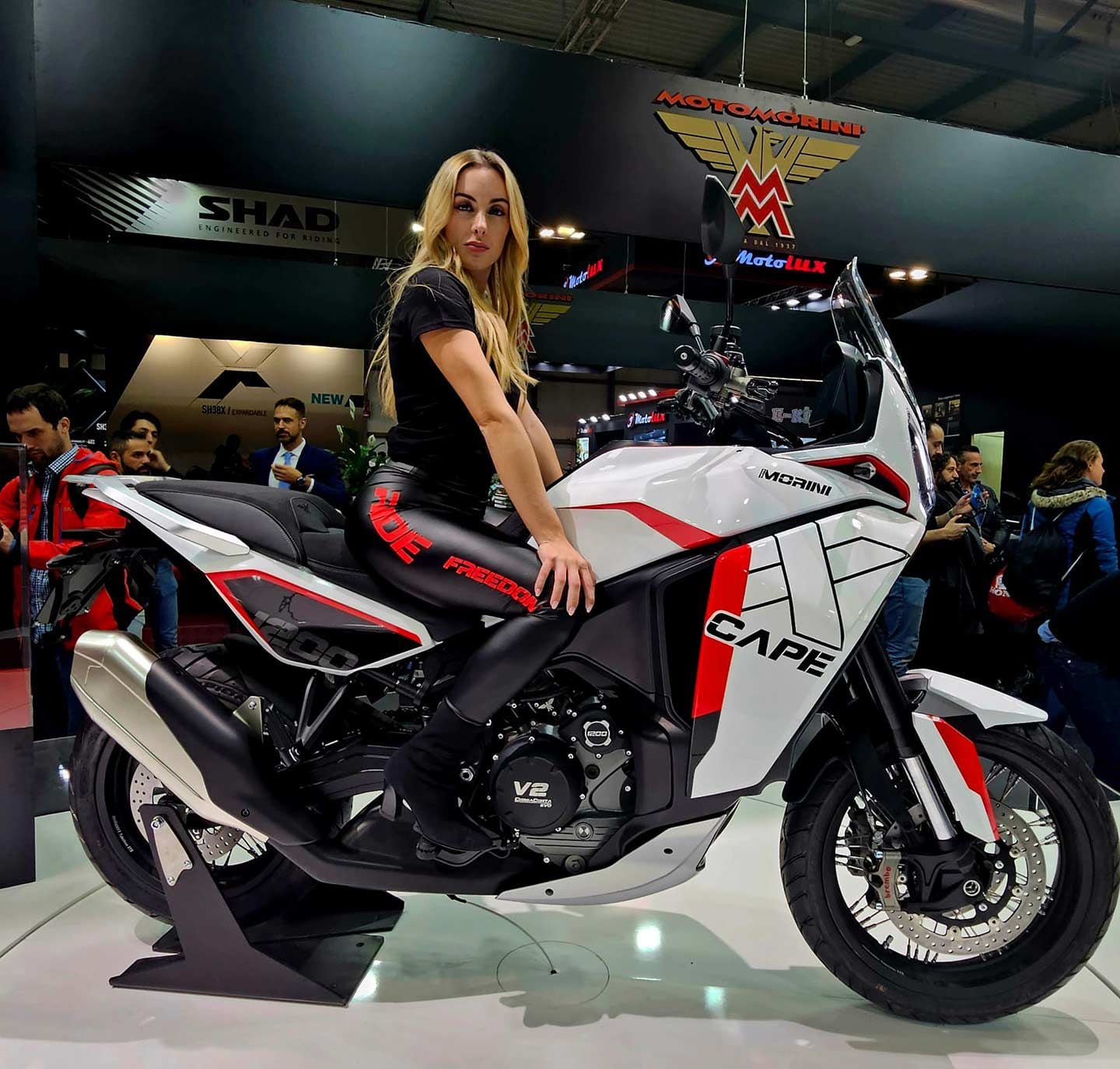
Moto Morini’s X-Cape 1200 acts as a reentry into the large-displacement category. (Moto Morini/)Moto Morini has gone through some very hard times over the past 20 years, and every attempt to get the legendary name back on its feet failed. Things didn’t appear to be getting any better when, in 2018, Chinese mega group Zhongneng Vehicle Group Co. stepped in, but new models slowly began to catch public attention—particularly the X-Cape, which was powered by a 650cc twin and gradually conquered a modest slice of the market.
The 2023 EICMA show marks a further acceleration of the Moto Morini revival with a return to the larger-displacement category and, even more meaningful, the introduction of locally designed engines. There is even a resurrection of the 1,200cc V-twin designed by Chief Project Engineer Franco Lambertini. Performance levels? How about a claimed 125 hp in Euro 5+ trim.
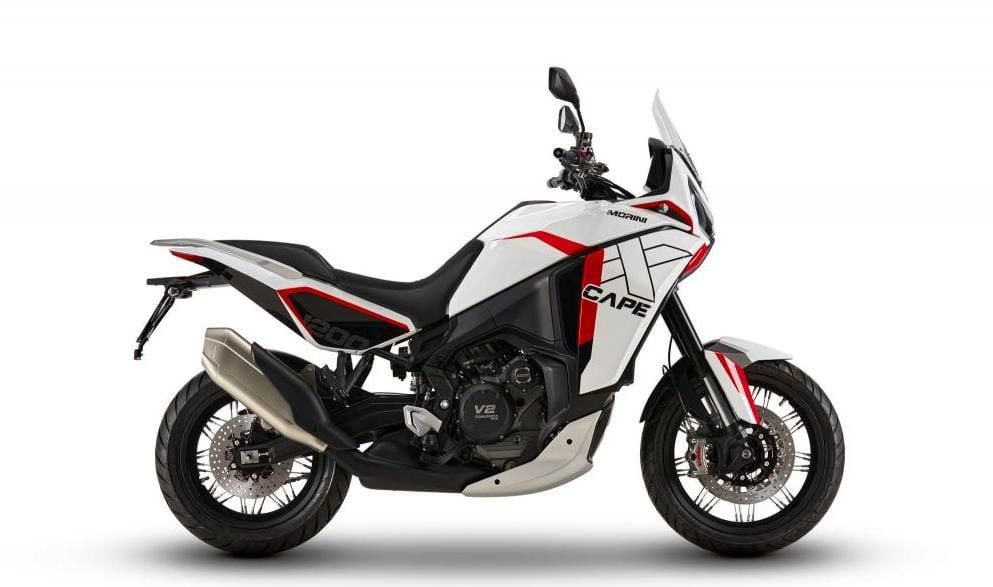
No shortage of tech or high-end hardware on the new X-Cape 1200. (Moto Morini/)That engine will power the all-new X-Cape 1200 adventure bike, which also gets an updated electronics package using a six-axis IMU. The engine-management system includes four riding modes, cruise control, traction control, and a quickshifter.
A 7-inch display is the central control system for infotainment functions and navigation. Safety assistance systems include a blind spot radar sensor. Braking is left to the capable hands at Brembo, the front setup headlined by 320mm rotors and four-piston Stylema calipers, with cornering ABS coming standard.
The X-Cape 1200 frame is composed of aluminum and steel-tube structures, with a wheelbase measuring 61 inches. Suspension is fully adjustable, with the X-Cape 1200 rolling on 19-inch front and 17-inch rear cross-spoke aluminum wheels shod with Pirelli Scorpion Trail tires.
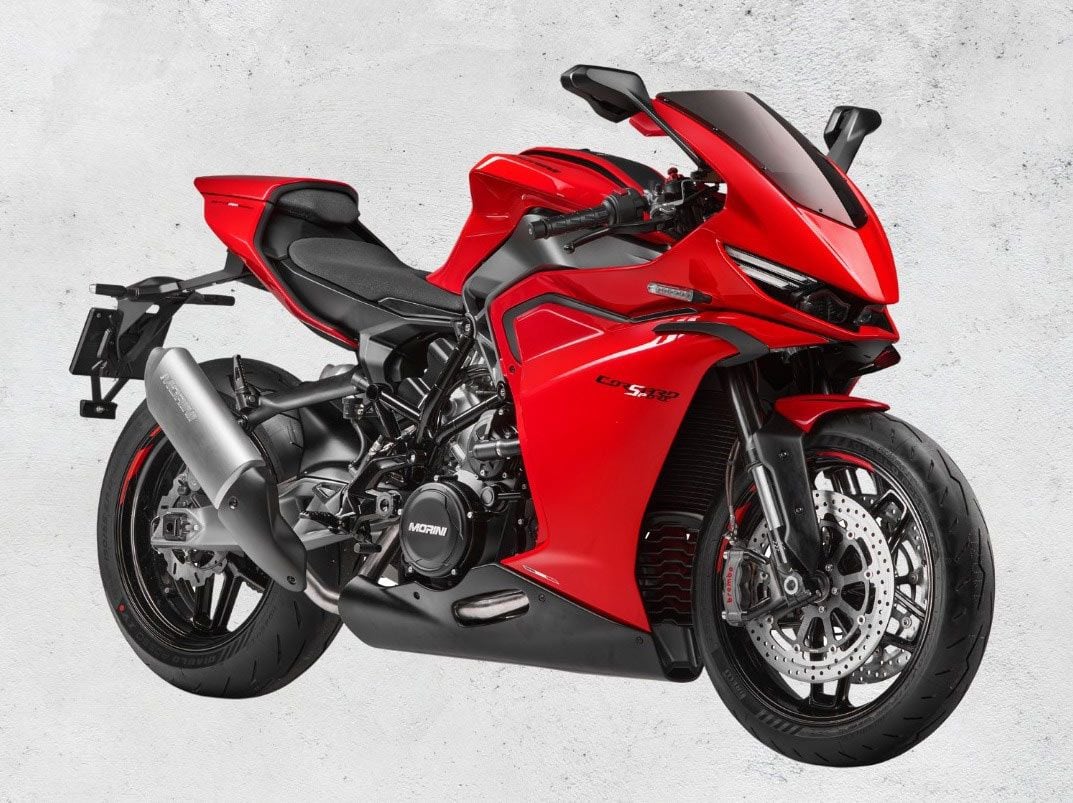
Moto Morini describes the Corsaro Sport as a “powerful, fun, and versatile sportbike that offers an unforgettable riding experience.” (Moto Morini/)More news from Moto Morini comes in the form of a completely new, 750cc 90-degree V-twin that’ll power the Moto Morini Corsaro 750 and Corsaro Sport. Output is a claimed 96 hp, with claimed wet weight coming in at around 440 pounds.
The chassis is once again a mix of aluminum twin-spar structure and steel tubing, with a wheelbase measuring 57.5 inches. Suspension is fully adjustable.
Not much was revealed about the electronics suite for either Corsaro model, but cornering ABS is assured, and you can expect Brembo brakes. Both models will roll on 17-inch cast-aluminum wheels with 120/70-17 front and 190/55-17 rear rubber.
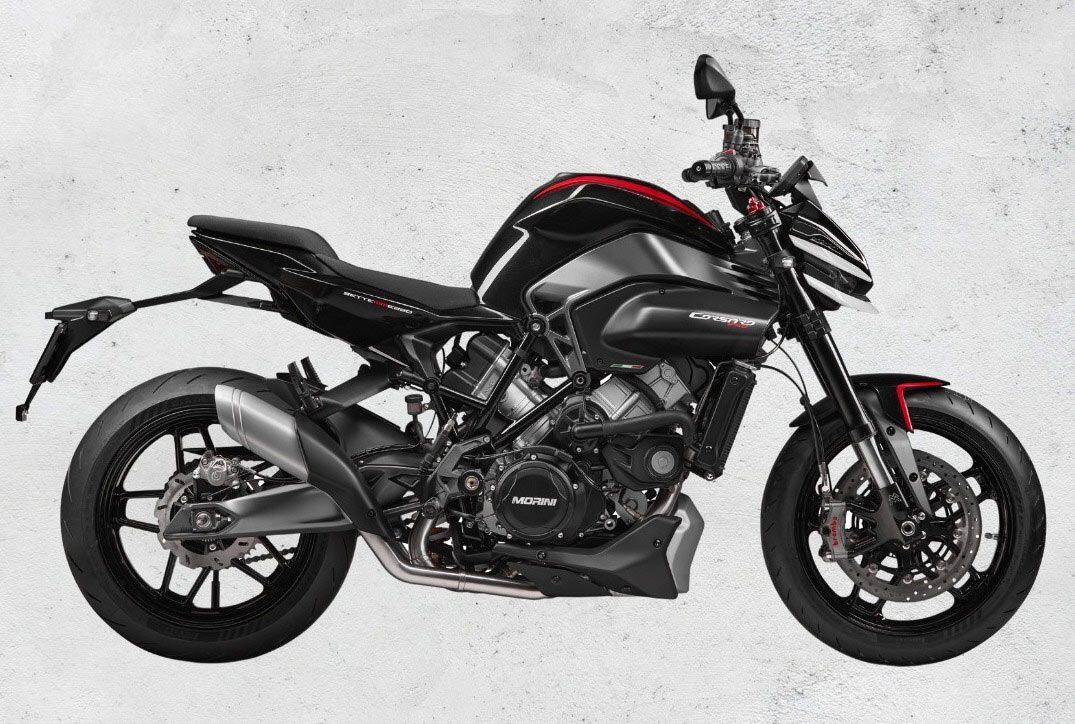
Will the Moto Morini Corsaro 750 be a legitimate contender in the increasingly popular naked bike category? Only time will tell. (Moto Morini/) -
CFMoto centers on sheer off-road performance with its latest adventure bike concept.
-
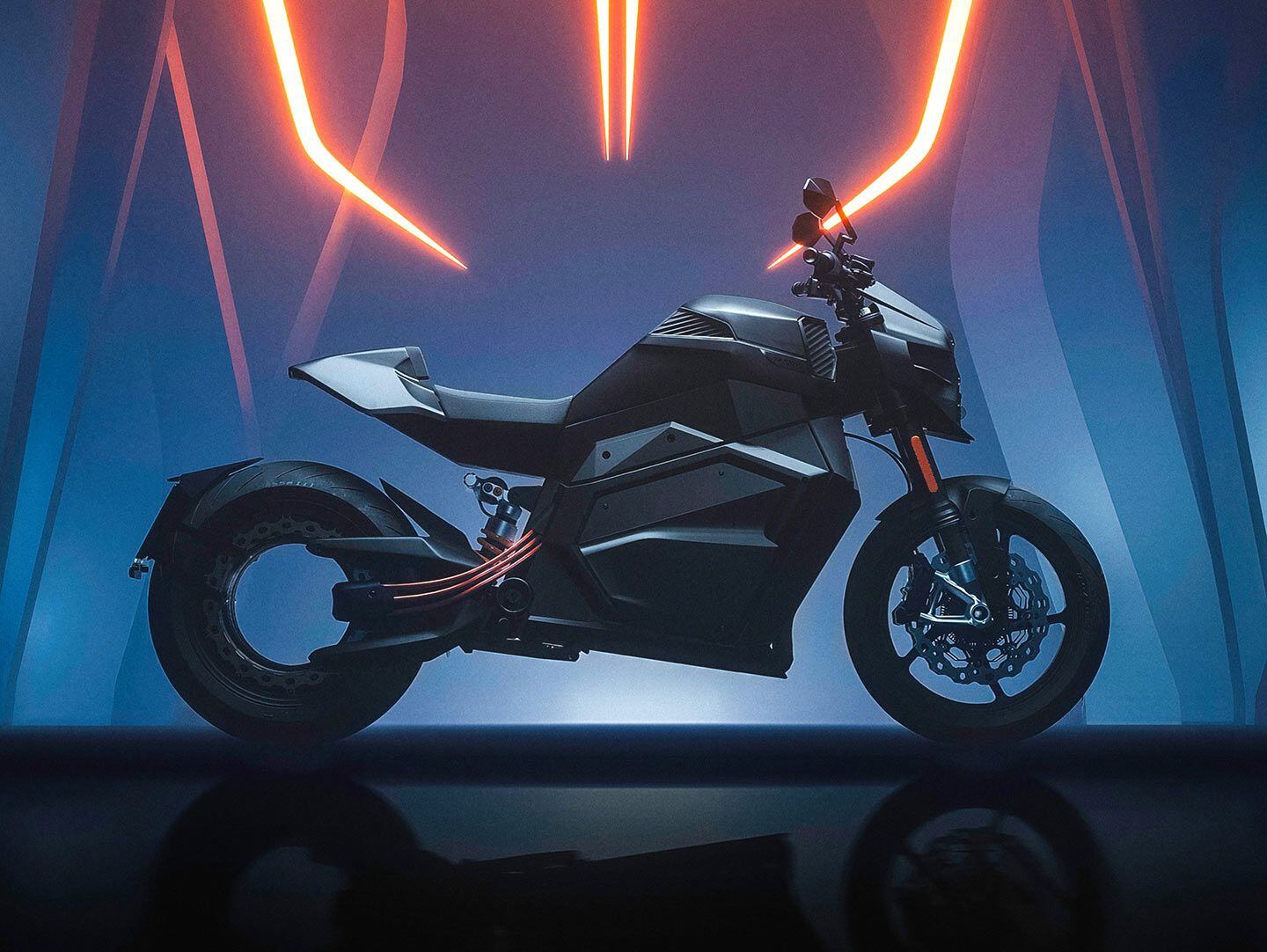
The 2024 Verge TS Ultra hit the stage at EICMA 2023. The bikes are set to ship to US owners by mid-2024. (Verge Motorcycles/) This isn’t really a first look at the Verge TS; it’s more like a third peek. We first reported on Verge’s preproduction, hub-motor electric bike at its unveiling at the 2019 EICMA show, when details were vague and specs not yet finalized. As with many preproduction models, especially electrics, the bike underwent a series of changes and delays over the years, and another update came earlier this year at the CES show with a serial production schedule and new TS Ultra model announced. Now we’re back at EICMA, where Verge is showing the original TS as well as the two more powerful and up-spec companion models, the TS Pro and aforementioned Ultra. The brand is currently accepting preorders, saying its bikes are expected to be delivered to customers by mid-to-late 2024.
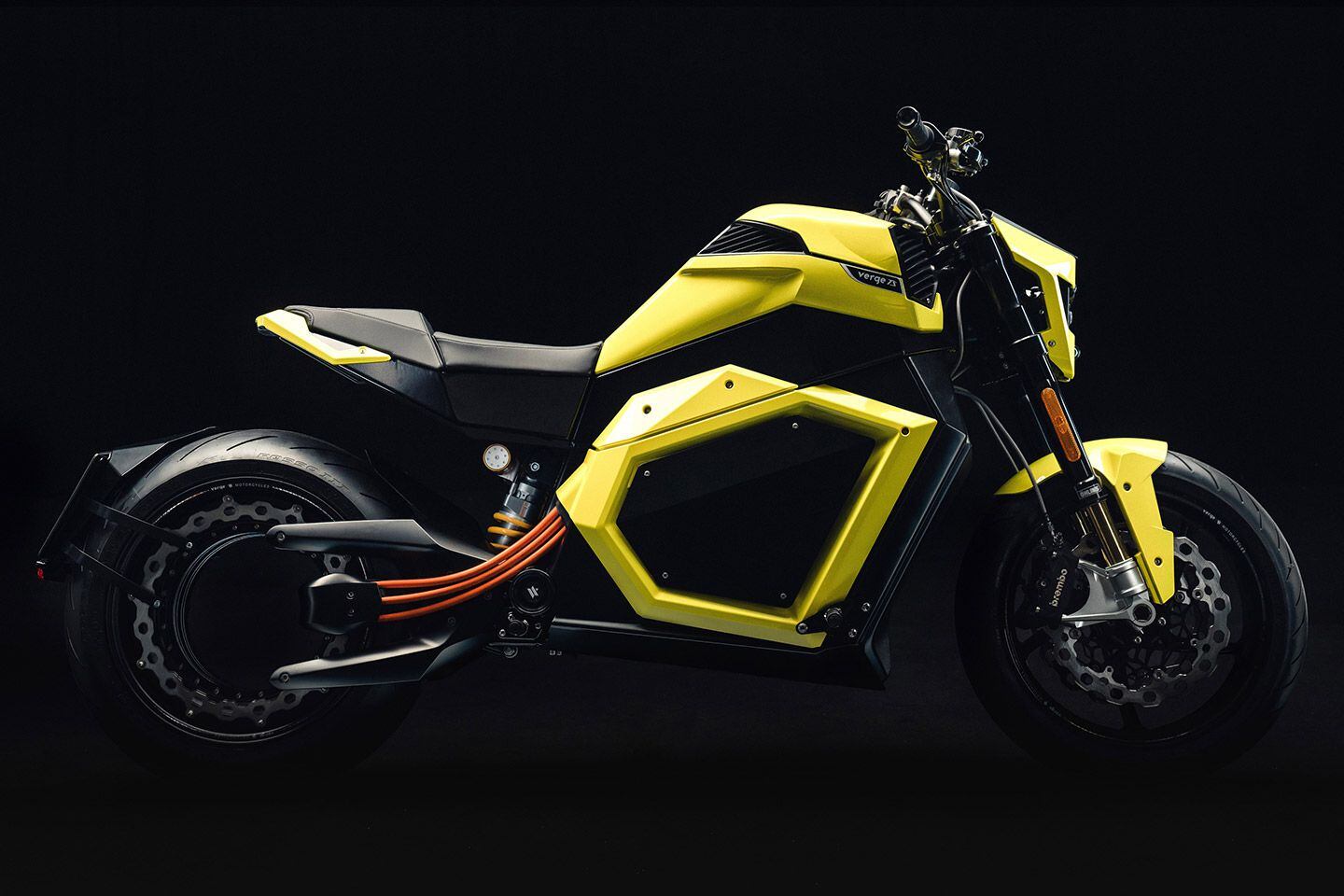
The middle-of-the-pack Verge TS Pro puts out a claimed 137 hp and retails for $29,900. (Verge Motorcycles/) All three models utilize Verge’s unique hubless rim motor, which is at the core of the whole design. With the motor integrated right into the rear-wheel rim (hence no hub) versus a conventional mid-mounted electric motor driving the wheel via a chain, shaft, or belt, all the power is transferred straight to the road. Integrating the motor also creates more space in the middle of the bike for the battery pack, allowing for low weight distribution and lighter handling. With residual drivetrain components removed Verge is able to go for a more spare design, which around the headlight up front, has evolved to become slightly more aggressive over the previous bikes. Call it Scandinavian light.
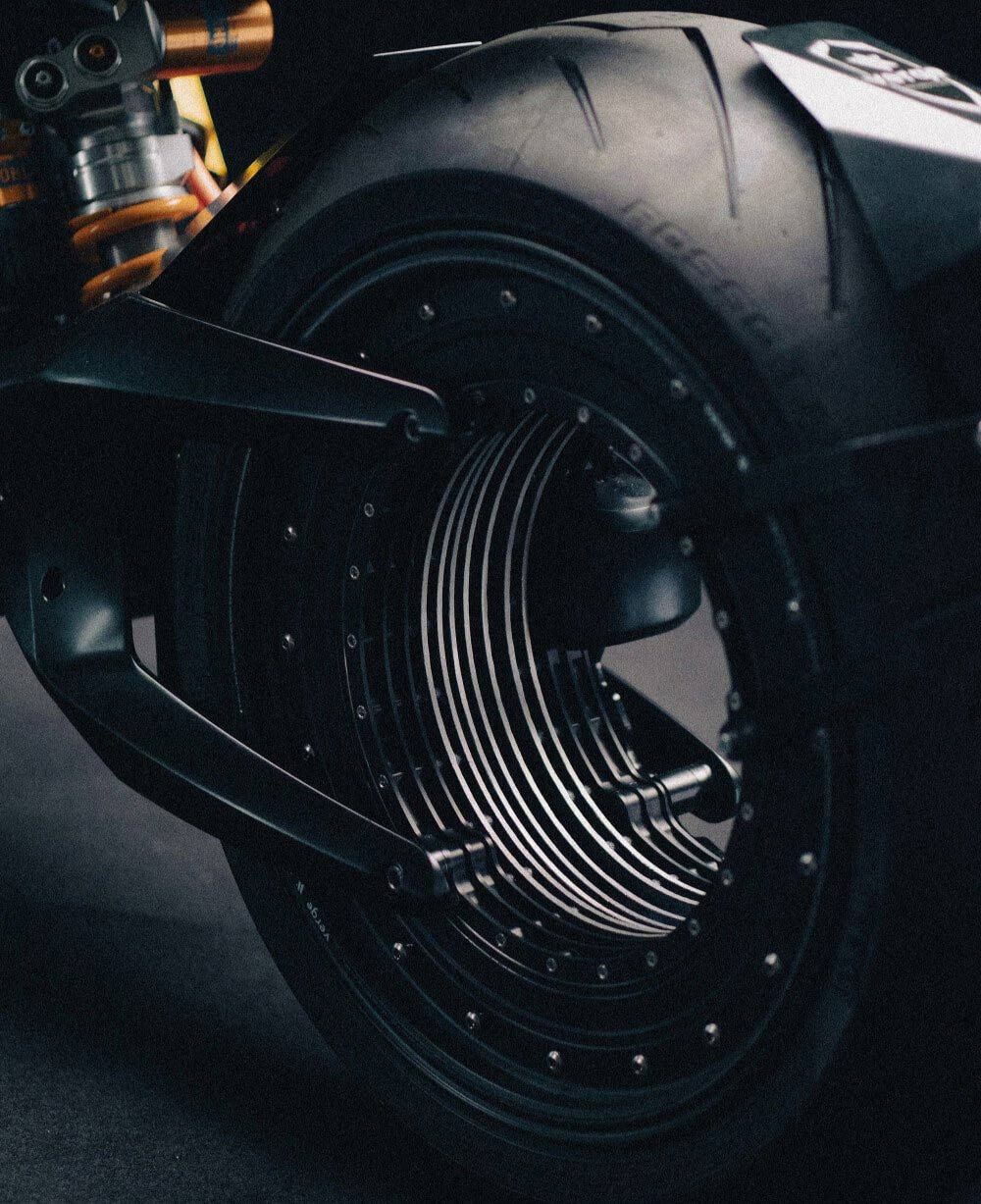
On Verge machines, the wheel <i>is</i> the motor, so power goes right to the ground. The rim contains fins to dissipate heat generated by it. (Verge Motorcycles/) The base-model Verge TS claims 107 hp from that unusual electric motor—a claim that hasn’t changed since the initial reveal. For more power, move up to the TS Pro model which gets a claimed 137 hp, and if you leap to the newer TS Ultra, the numbers get heady, with Verge claiming 201 hp—despite all the bikes looking virtually identical. In fact, the only thing we can see distinguishing the three models is a new nose fairing with built-in winglets and the solo seat and tail cover on the Ultra, but there’s also the matter of price. As is usual for electric bikes, the claimed torque figures are fairly astounding as well: 737 lb.-ft. for the TS and TS Pro, and a whopping 885 lb.-ft. for the TS Ultra.
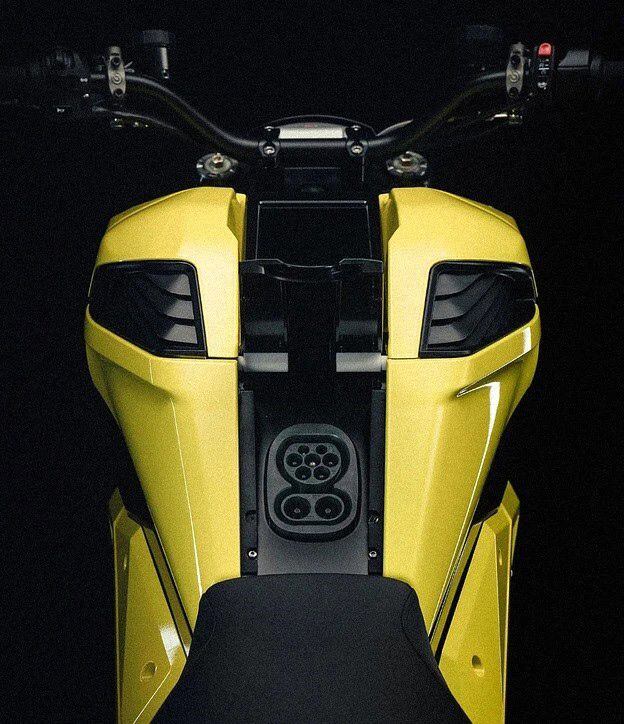
Big display atop the fake fuel tank shows speed, range, regen, and modes. Charge plug below will accept Tesla chargers, says Verge. (Verge Motorcycles/) Not surprisingly, the TS incorporates lots of up-to-date tech, with traction control, regenerative braking, and four rider modes for the user to manipulate: Range, Zen Beast, and Custom. Relevant information flickers across an iPad-like color panel integrated into the top of the dummy “fuel” tank, with what the company says is “intuitive software containing all important data and metrics.”
Further in-depth details are still sketchy, with no mention of suspension component dimensions, battery configuration, wheel material, and precise motor specs. Once the order is placed, the bikes are somewhat configurable, with owners able to choose from standard Wilbers or up-spec Öhlins suspension, a choice of seat materials and colors as well as bike color, but all versions of the bike spec Brembo front brakes and a Verge-made four-piston caliper out back.
The Verge is available in three trims: the Verge TS, the Verge Pro, and the truly insane Verge Ultra. The base-model Verge TS starts at $26,900 and claims a 4.5-second zero-to-60 mph time and a 155-mile range; the middle-child TS Pro retails for $29,900, gets to 60 mph in 3.5 seconds, and goes a claimed 217 miles on a charge. The beastliest of them all, the TS Ultra asks a whopping MSRP of $44,900, but it puts out over 200 hp and goes 0 to 60 in 2.5 seconds. The Ultra also promises a faster charge; with a DC fast charger, it’s said to reach 80 percent capacity of the 21.8kWh battery in just 25 minutes. (The base TS takes 55 minutes with the same charger.)
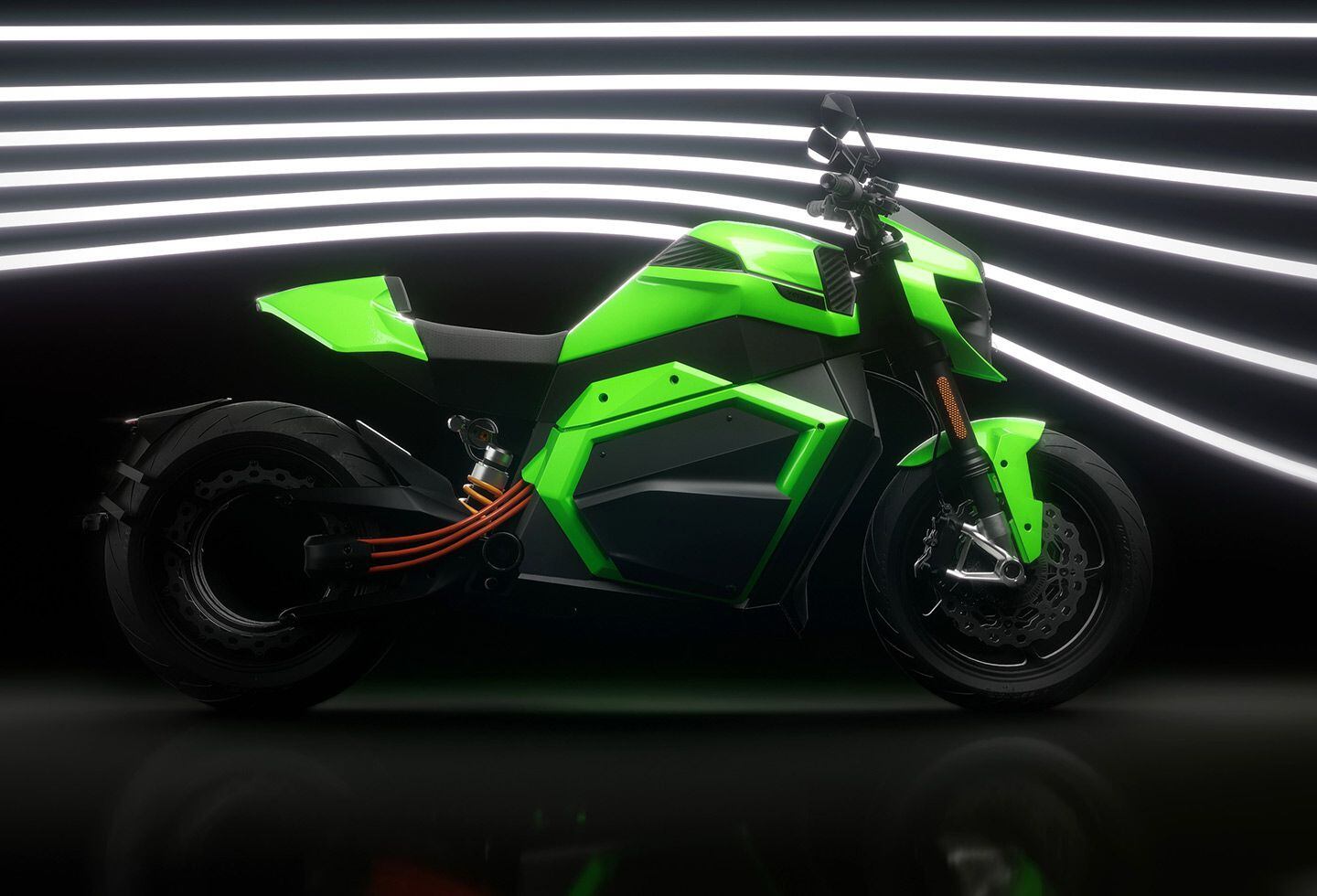
The 2024 Verge TS Ultra puts out 201 hp and retails for $44,900. Bikes are expected to reach owners in late 2024. (Verge Motorcycles/) Verge looks serious about making a push into the US market, with the company opening a North American headquarters and innovation office in San Francisco
and announcing its intent to adopt Tesla’s NACS charging connector, opening up its products to the most extensive fast-charging system in North America.
The company says the Pro is expected to reach customers by middle of 2024, with the base TS expected around the same time, and the Ultra simply scheduled for “end of 2024.”
2024 Verge TS / TS Pro / TS Ultra Specs
Price: $26,900 / $29,900 / $44,900 Motor: Hubless air-cooled electric rim motor Claimed Torque: 516 lb.-ft. / 737 lb.-ft. / 885 lb.-ft. Claimed Power Output: 107 hp / 138 hp / 201 hp DC Fast Charge Time: 55 min. / 35 min. / 25 min. Range: 155 mi. / 217 mi. / 233 mi. Front Suspension: 4.7 in. travel Rear Suspension: Monoshock; 4.1 in. travel Front Brake: 4-piston Brembo M4.32 calipers, 320mm discs w/ ABS Rear Brake: 4-piston Verge caliper, Galfer 378mm peripheral Tires, Front/Rear: 120/70-17 / 240/45-17 Rake/Caster Angle: 20.5°/4.3 in. Wheelbase: 60.6 in. Seat Height: 30.7 in. Claimed Curb Weight: 540 lb. Contact: vergemotorcycles.com -
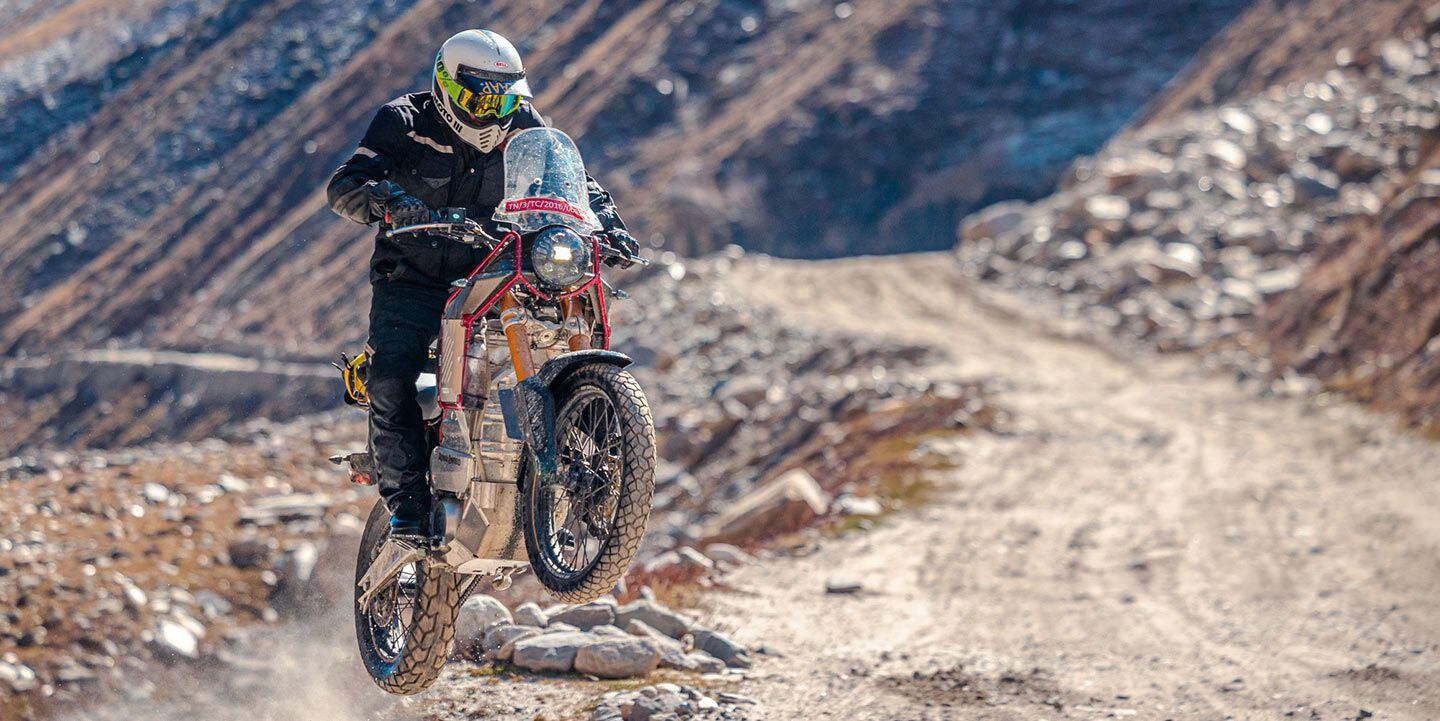
Royal Enfield’s Electric Himalayan prototype has been undergoing testing in the same rugged Himalaya mountains where the new ICE model was developed. (Royal Enfield/)Royal Enfield spent decades as the butt of jokes about its archaic product range and capitalizing on the desire among parts of the motorcycle-buying population to stick to tried-and-tested ideas rather than adopting anything new. So there’s little that illustrates the recent transformation of the brand from throwback to forward-looking pioneer than the reveal of the Electric Himalayan prototype—a running test bed that’s being used to explore ideas for a battery-powered future.
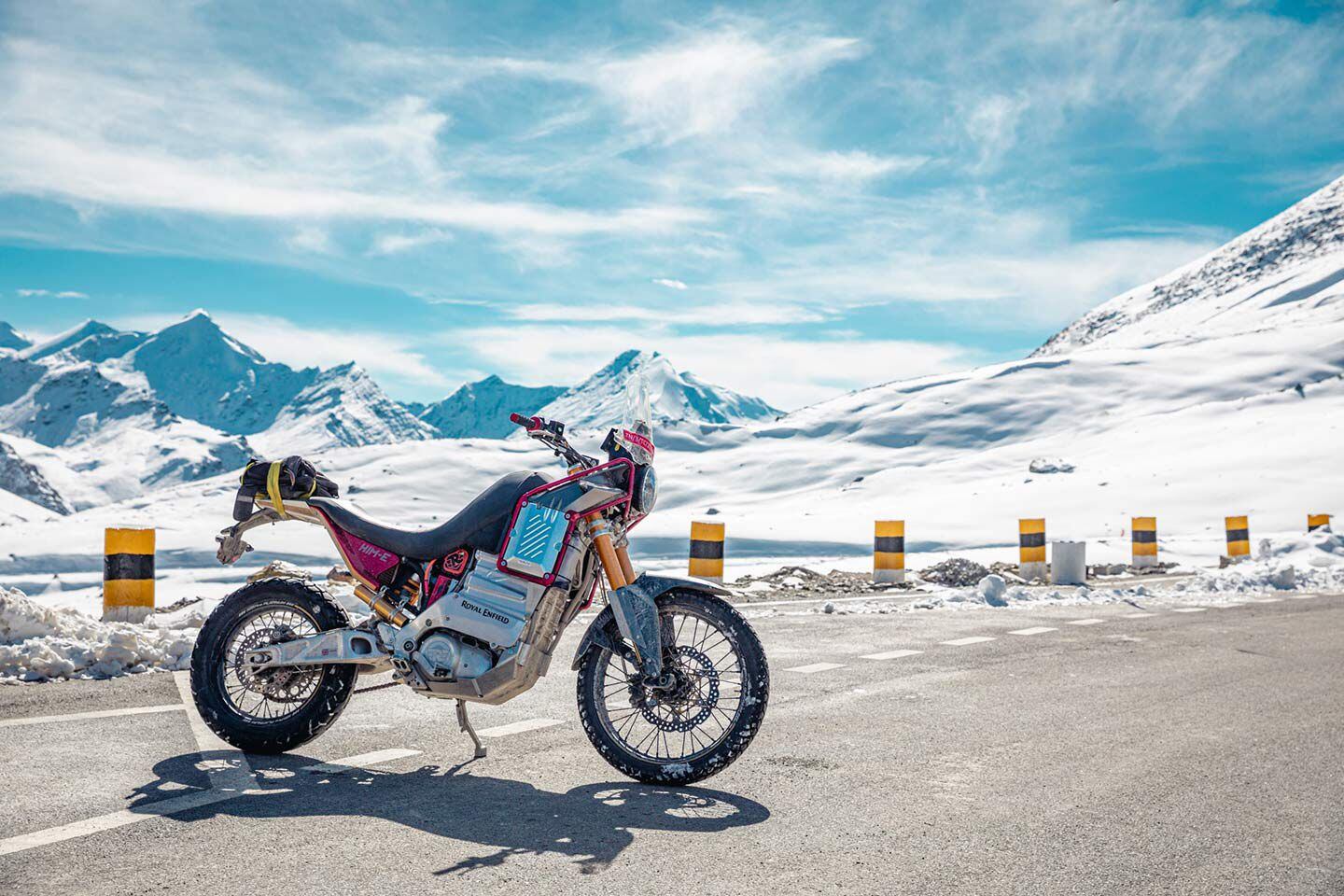
Royal Enfield is looking past its recent successes and is preparing for its future. (Royal Enfield/)Royal Enfield, remember, was a company that stuck to 1950s-style right-hand gearshifts until well into the 21st century and didn’t add a fifth-gear ratio until 2002. Fuel injection is still a relatively new addition to its bikes, and the new Himalayan, launched at EICMA this week, is the company’s first liquid-cooled model. Other companies make retro models, but for much of Royal Enfield’s history its bikes have simply been old-fashioned.
Not anymore. Not only does the latest Himalayan feature up-to-date tech, but the company is already working on its electric future, revealing the Electric Himalayan on its stand at EICMA in Milan.
Related: Most Interesting Electric Motorcycles of 2023
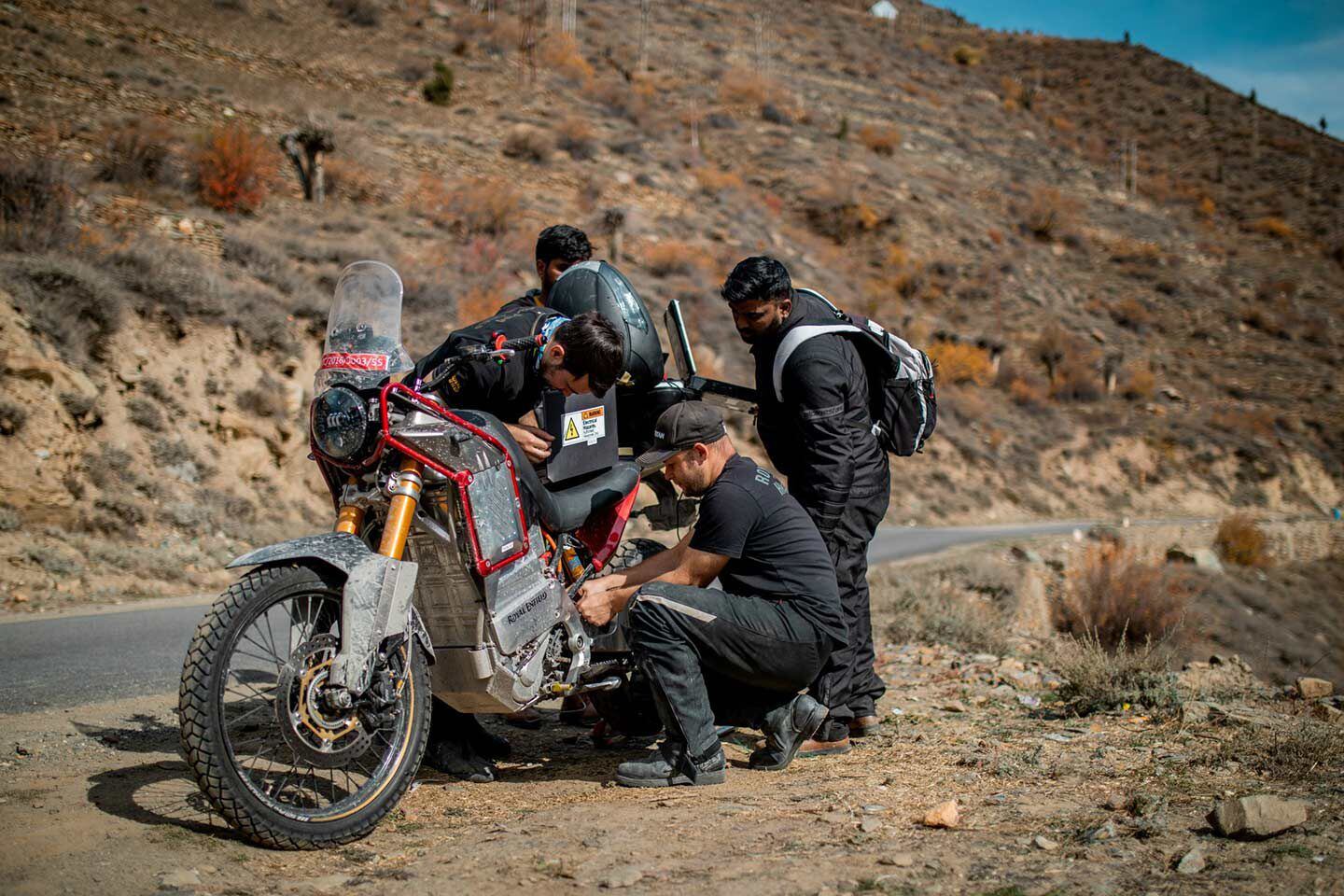
If the prototype can survive the harsh environment that the mountains it's named after dish out, then it will survive anything. (Royal Enfield/)The Electric Himalayan isn’t a production model or even a tease for an upcoming machine. Instead, it’s a test bed to see how well electric-bike tech can cope with the sort of rugged existence the Himalayan is designed for, operating in the very mountain range that it’s named after. Royal Enfield has used rapid prototyping and ideas including a structural battery box that doubles as the bike’s chassis—developed by Harris in the UK—and the use of organic flax fiber for the composite bodywork.
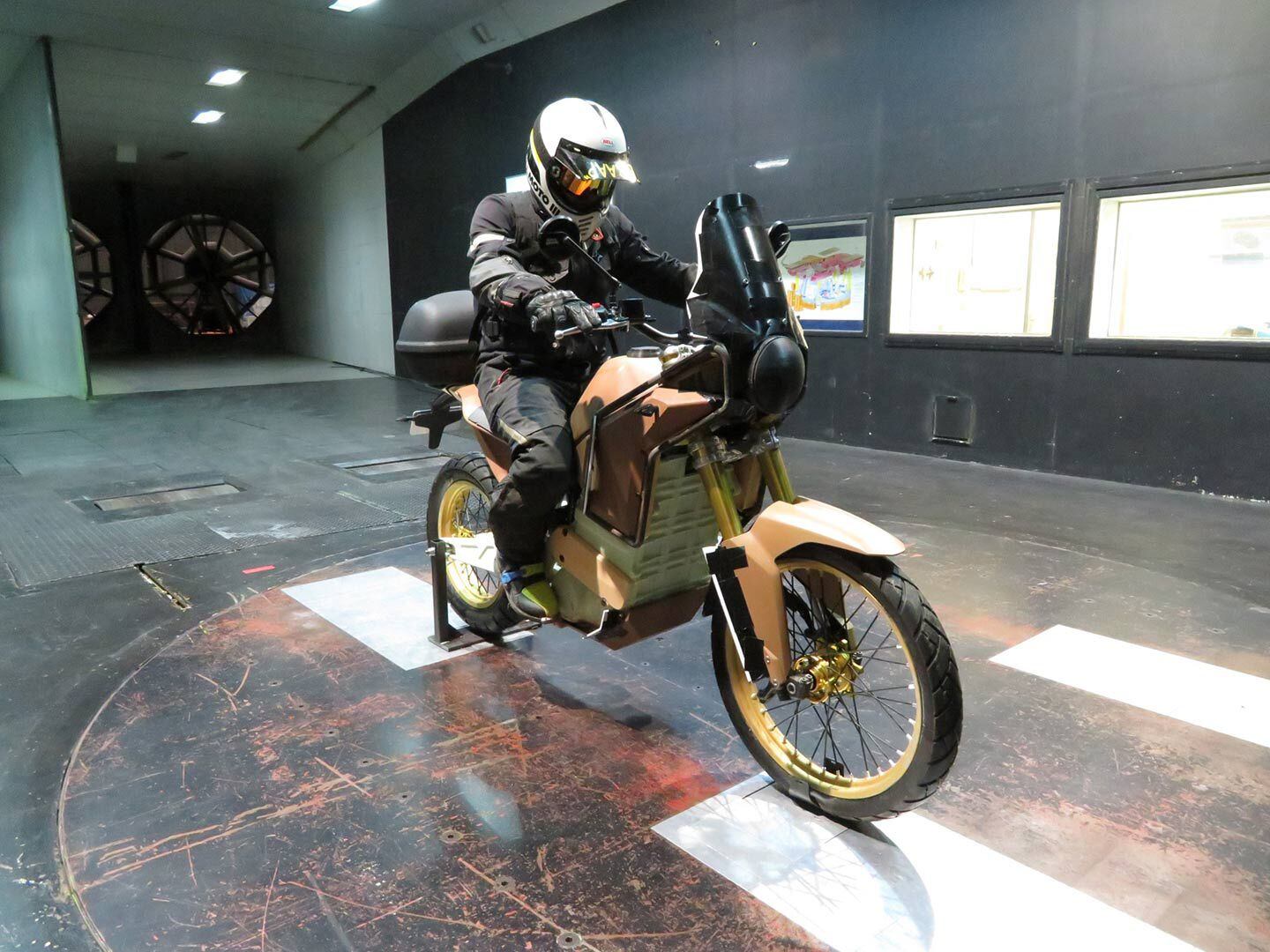
The electric Himalayan in clay model form. (Royal Enfield/)Details of the bike’s performance, battery capacity, and range remain secret and are likely to evolve as the project develops further, but it’s clear that electric bikes are something that Royal Enfield is serious about pursuing.
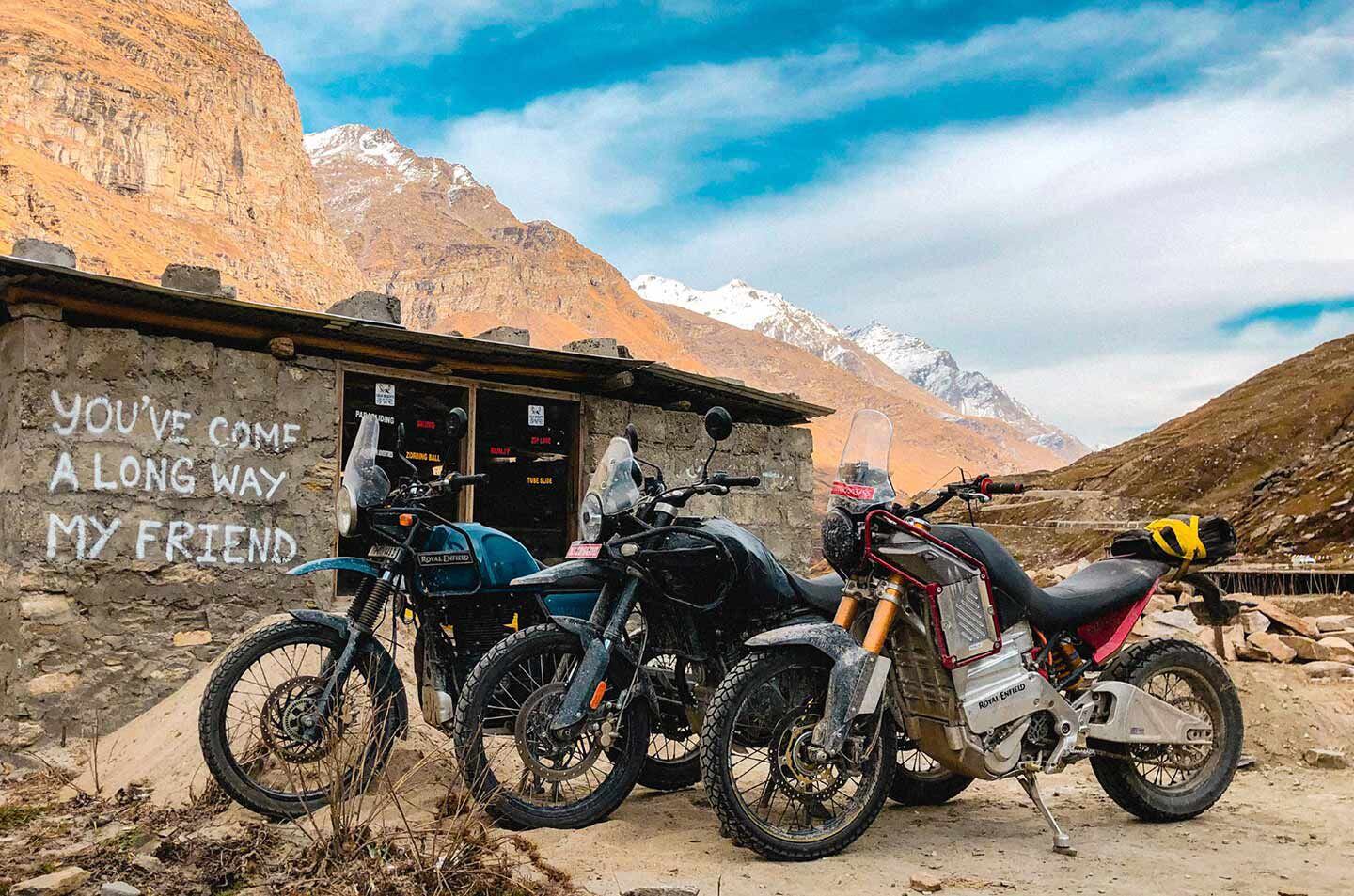
Progress is happening quickly at RE. The original Himalayan, new 2024 liquid-cooled model, and electric prototype. (Royal Enfield/)“When we started this project, we were keen to create something that would be a guiding light for long-term sustainable travel in the Himalayas,” said Mario Alvisi, chief growth officer for EV at Royal Enfield. “More than building a motorcycle for regulations or directive, we saw this as an opportunity to create something unique and to inspire future generations. What began as a capability exercise for our teams is now this electric adventure motorcycle we are very proud of; a new expression of our love for adventure and the mountains. The Electric Himalayan Testbed is much more than a design concept. For us, this is our vision and a glimpse of what to expect from us in the future. There is a much larger electric mobility blueprint that is being brought alive at Royal Enfield as we continue to work on multiple ‘electrifying’ expressions of pure motorcycling.”

Royal Enfield is committed to the future of motorcycling, and electrics are bound to be a big part of that. (Royal Enfield/)“At Royal Enfield, our Electric Mobility team is powered by the objective of preserving the quintessential Royal Enfield DNA, and extending that into our creative ideas and designs for electric motorcycles as well,” said B. Govindarajan, Royal Enfield CEO. “This Electric Himalayan concept motorcycle is an outcome of this pursuit, as purpose and innovation meet distinct Royal Enfield design and character. This motorcycle is only just a part of a much bigger sustainable ecosystem of exploration and adventure that we are working on in the Himalayas. From green charging pit stops to our responsible travel initiative, from creating self-sustaining communities to collaboration with UNESCO to preserve the intangible cultural heritage of the Himalayan region, there are a lot of initiatives we are passionately driving.”
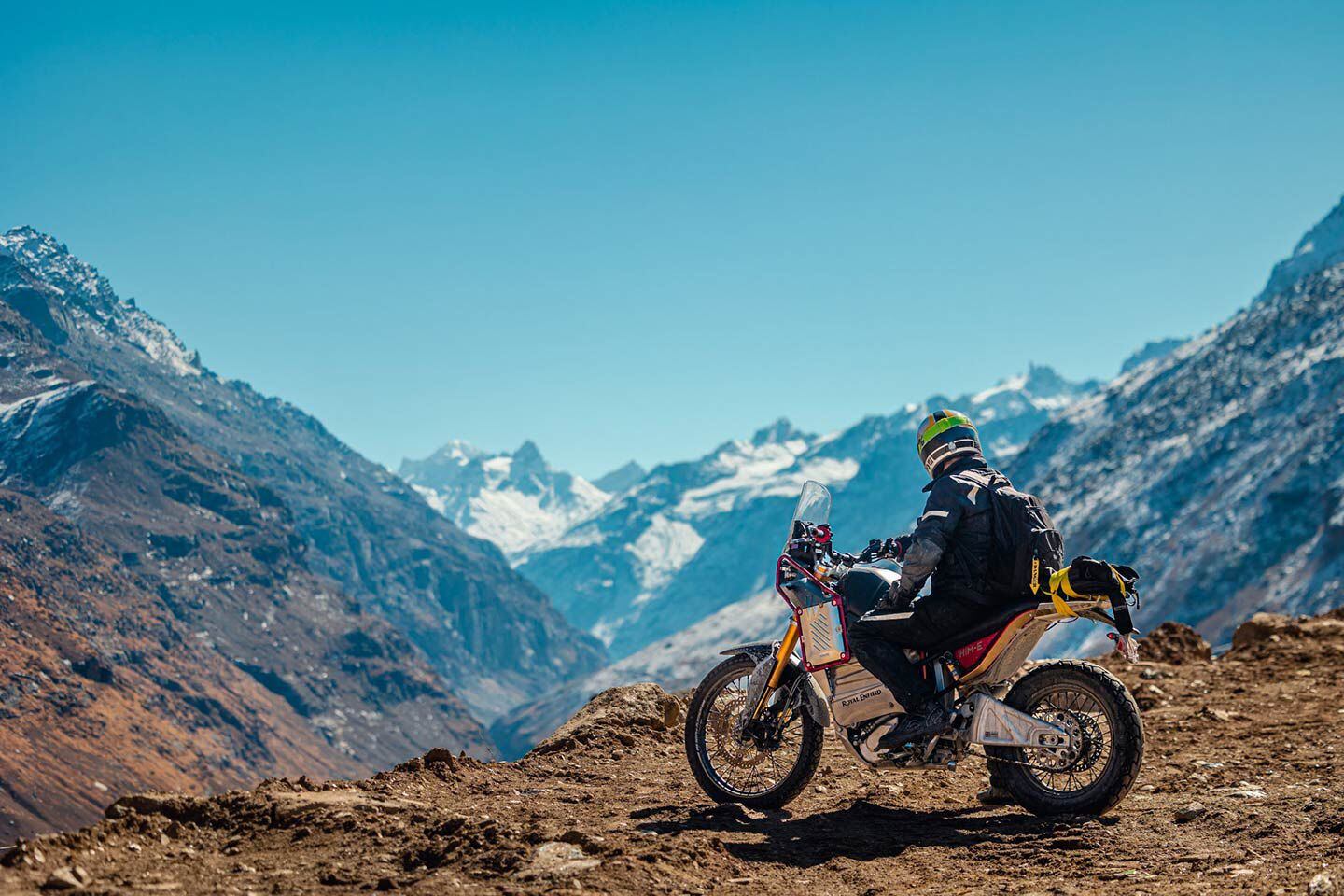
Overlooking the Chenab River valley in the Himachal Pradesh region of northern India. (Royal Enfield/)-
 1
1
-
-
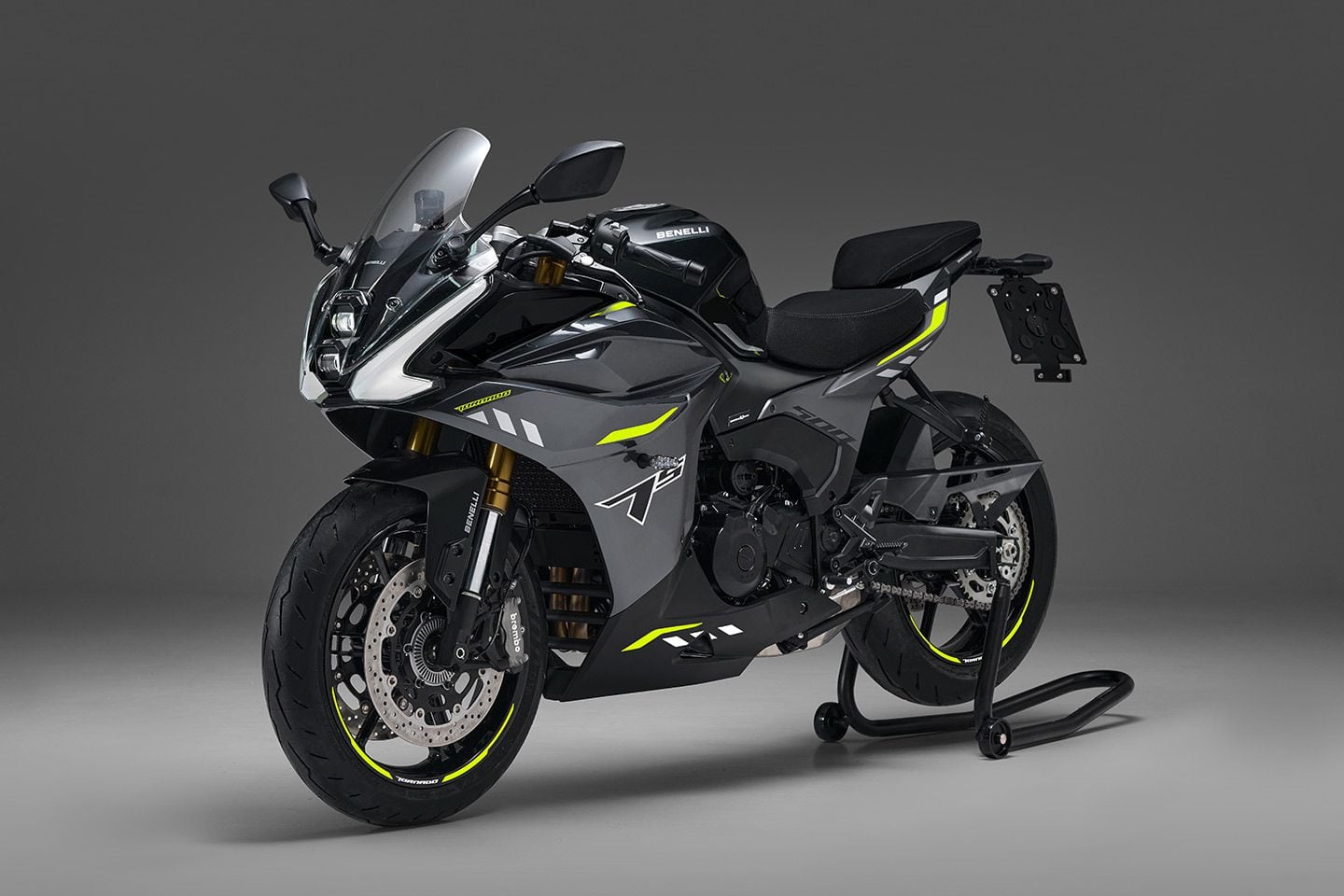
Benelli took the wraps off the new Tornado 500, powered by a 500cc parallel twin. (Benelli/) Benelli appears to be proceeding very cautiously with the expansion of its model range. It recently unveiled the very promising TRK 702 that has an evolution of the 502 parallel-twin engine in it. In this application it has 698cc displacement, more power, and torque, without gaining much, if any, weight or physical size.
Yet at this year’s EICMA show, the new 702 engine appears to be only available in the same existing TRK 702, while Benelli seems to be focusing on the 500cc twin that helped contribute to making the TRK 502 the bestselling bike in Italy. This same unit is now offered in two new middleweight models, with a fully faired sportbike version called the Tornado 500, and a stripped-down roadster version called the Tornado Naked Twin 500.
The Tornado 500 is a sportbike featuring a full fairing and clip-on bars that will compete against bikes like Honda’s new CBR500R, and Kawasaki’s new Ninja 500. Power comes from the aforementioned 500cc parallel twin that has been updated to meet Euro 5+ emissions. Claimed output is 48 hp at 8,500 rpm, with 34 lb.-ft. of peak torque at 6,000 rpm. It has a reputation as a flexible engine with good reliability.
The Tornado 500 is compact, with a wheelbase spanning 56 inches (just a half an inch more than the new Honda CBR500R). The seat is set at a moderate 31 inches above the ground, while curb weight is a claimed 410 pounds. The frame is a steel-tube unit with a 41mm inverted fork up front and cantilevered monoshock out back. There are a pair of radial-mount, four-piston Brembos up front with 320mm discs and Bosch ABS as standard.
The electronics suite is relatively limited, but the display is a 5-inch TFT unit that will offer Bluetooth connectivity and navigation.
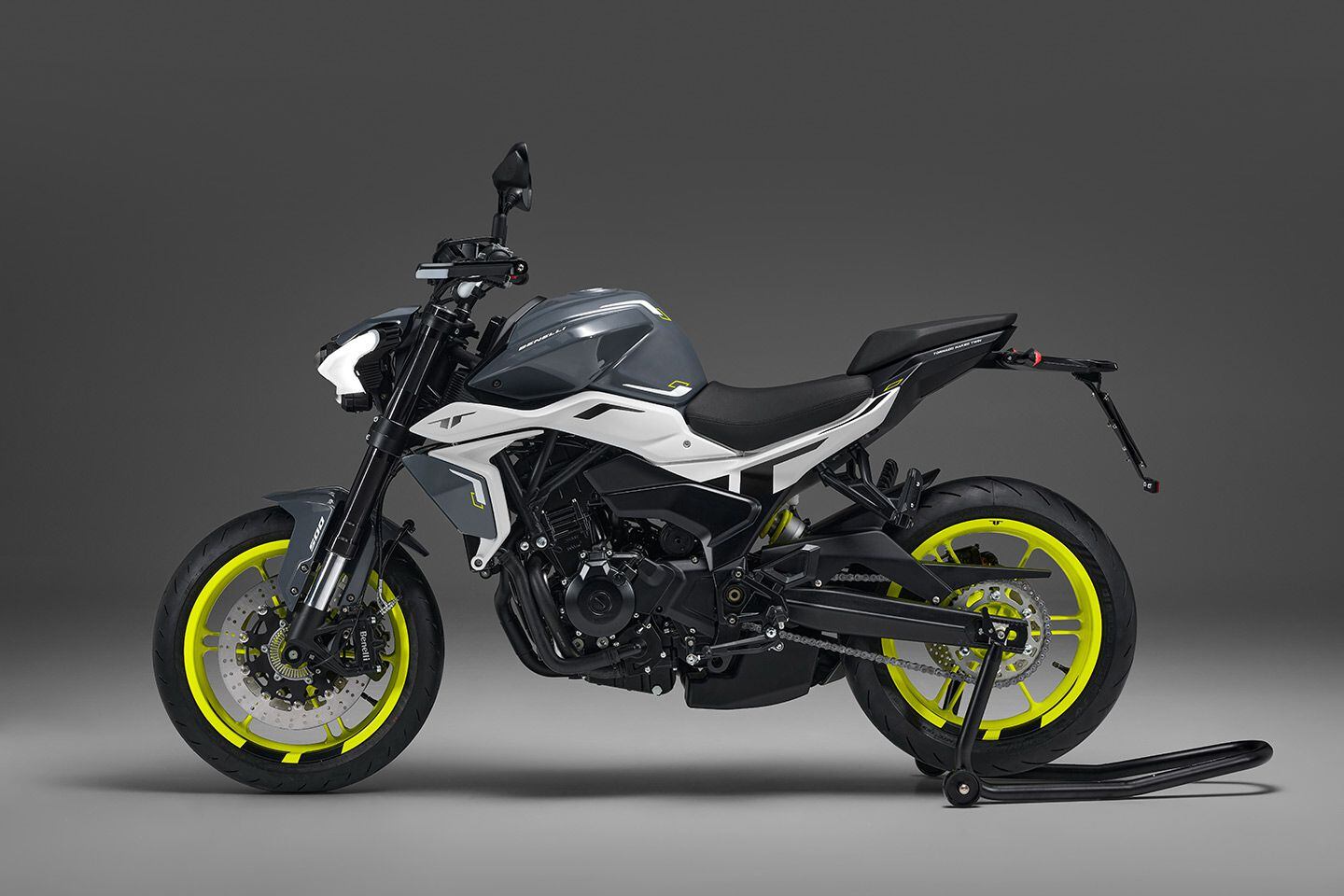
There will also be a naked version of the bike called the Tornado Naked Twin 500. (Benelli/) With almost identical specifications, the Tornado Naked Twin 500 is simply an undressed variation of the Tornado 500. Engine and chassis specs remain the same except for the curb weight, which has increased to 429 pounds. Both bikes have sharp and modern styling with the faired bike looking a bit more refined and sharp compared to the Naked.
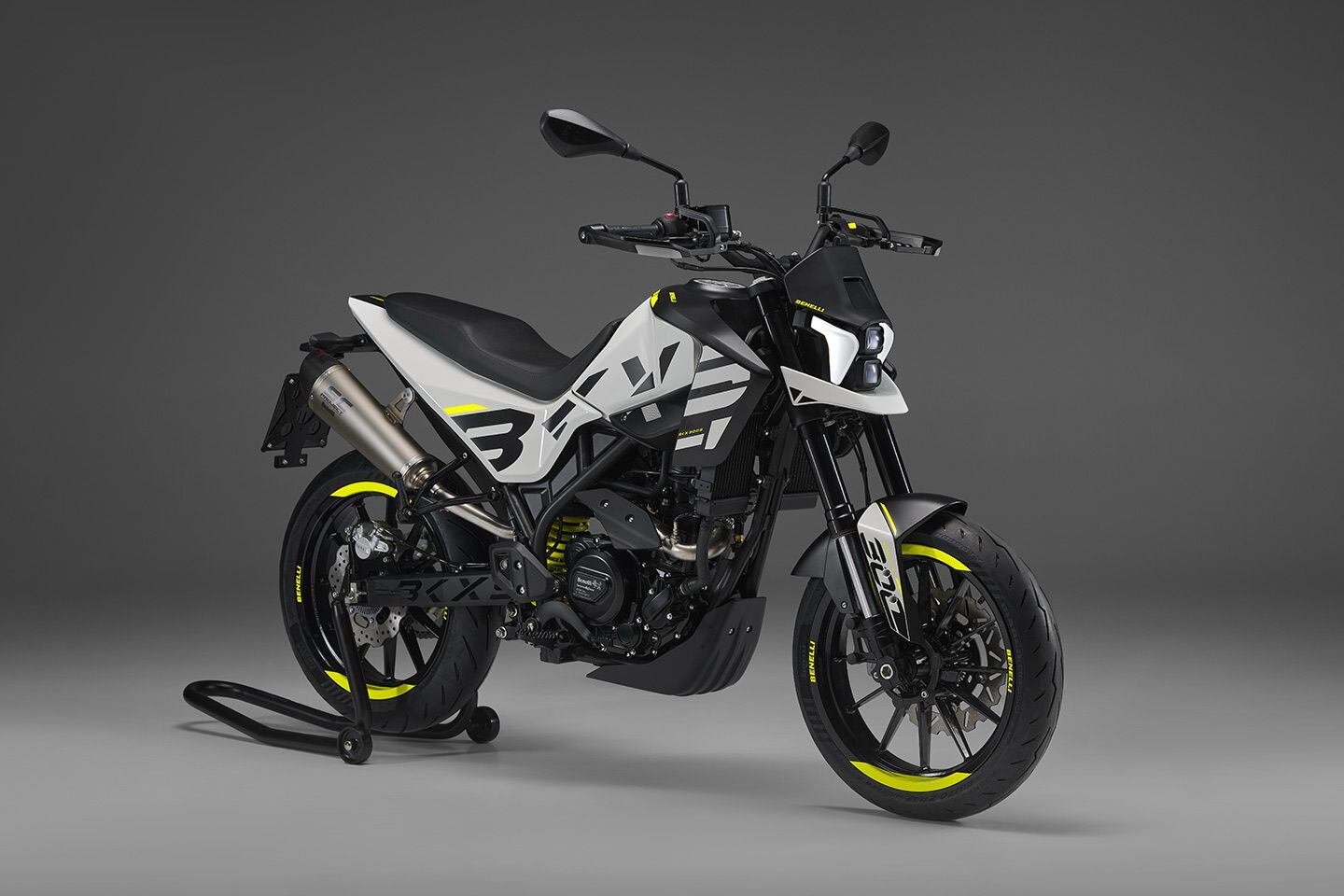
Benelli’s all-new BKX 300 S has a brand-new 300cc single. (Benelli/) A third new model also shown at EICMA is the BKX 300 S. This all-new model comes with a brand-new 300cc single-cylinder engine, which replaces the old 300cc twin that has since grown into the 502 outlined above. The single has 78 x 61.2mm bore and stroke dimensions and makes a claimed 29 hp at 9,000 rpm and 18 lb.-ft. of peak torque at 7,000 rpm, which is very similar to the old twin.
Claimed curb weight is not particularly light at 364 pounds, but that can be attributed to its very stout build. The fork is a 42mm inverted unit, while a link-actuated shock sits out back. Braking is handled by a single four-piston caliper up front with a 280mm rotor, with ABS included as standard. That’s it for electronic sophistication, but that is to be expected on a bike that is expected to be priced very low.
-
 1
1
-
-
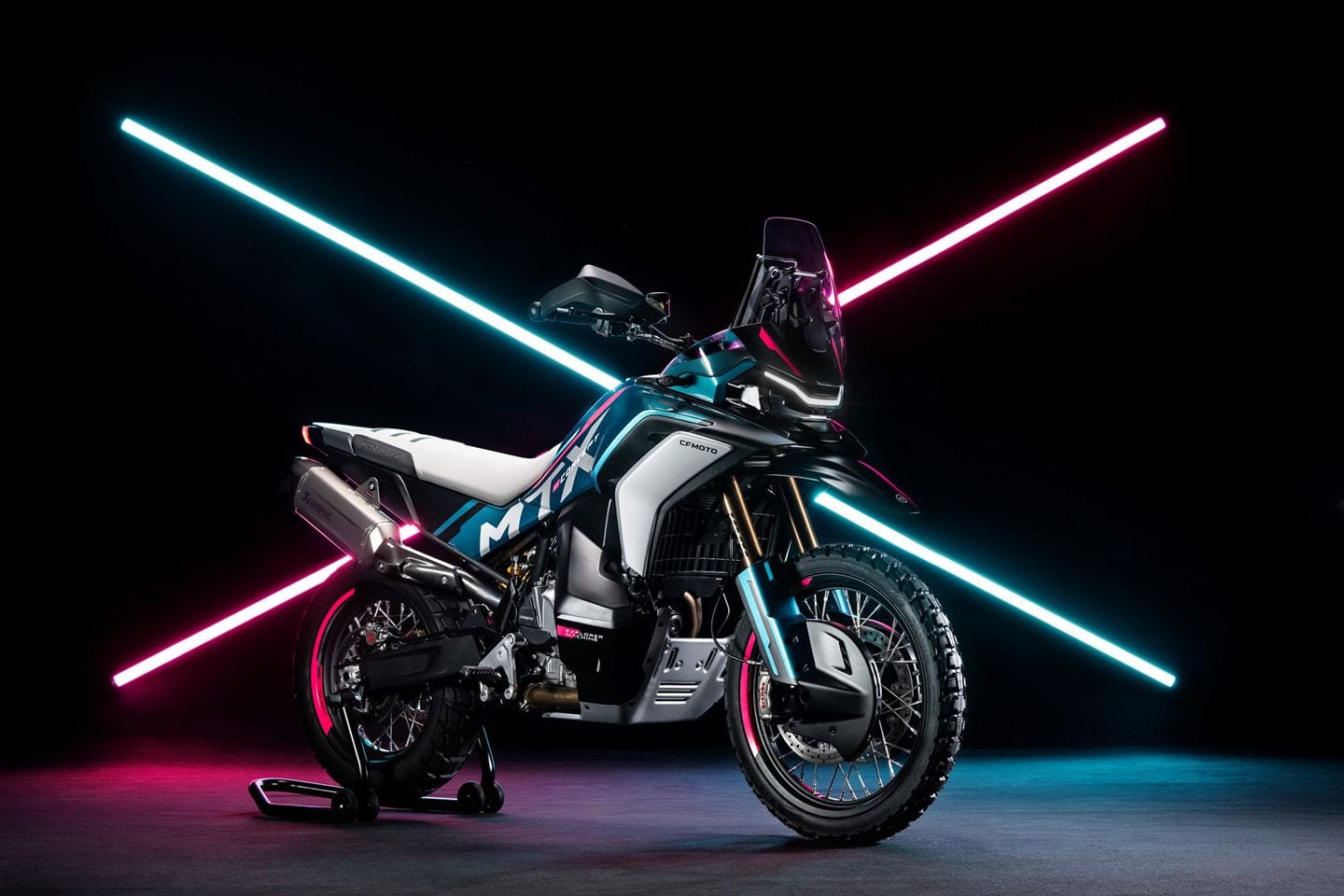
Sharing an engine with KTM’s 790 Adventure, which CFMoto manufactures, the MT-X concept is designed to be a hardcore ADV machine to compete in the middleweight category. (CFMoto/)China’s CFMoto chose EICMA in Milan to preview an array of upcoming 2024 developments including a new hardcore adventure model that’s currently going under the code name “MT-X” and appears to be a new 800cc off-road twin.
CFMoto hasn’t revealed many details of the MT-X, only confirming it’s the company’s new “ultimate explorer” model, with the “X representing the infinite possibilities” that it offers. But digging into the details of the bike we can see that behind that marketing spin is a serious rival to the likes of KTM’s 790 Adventure here.
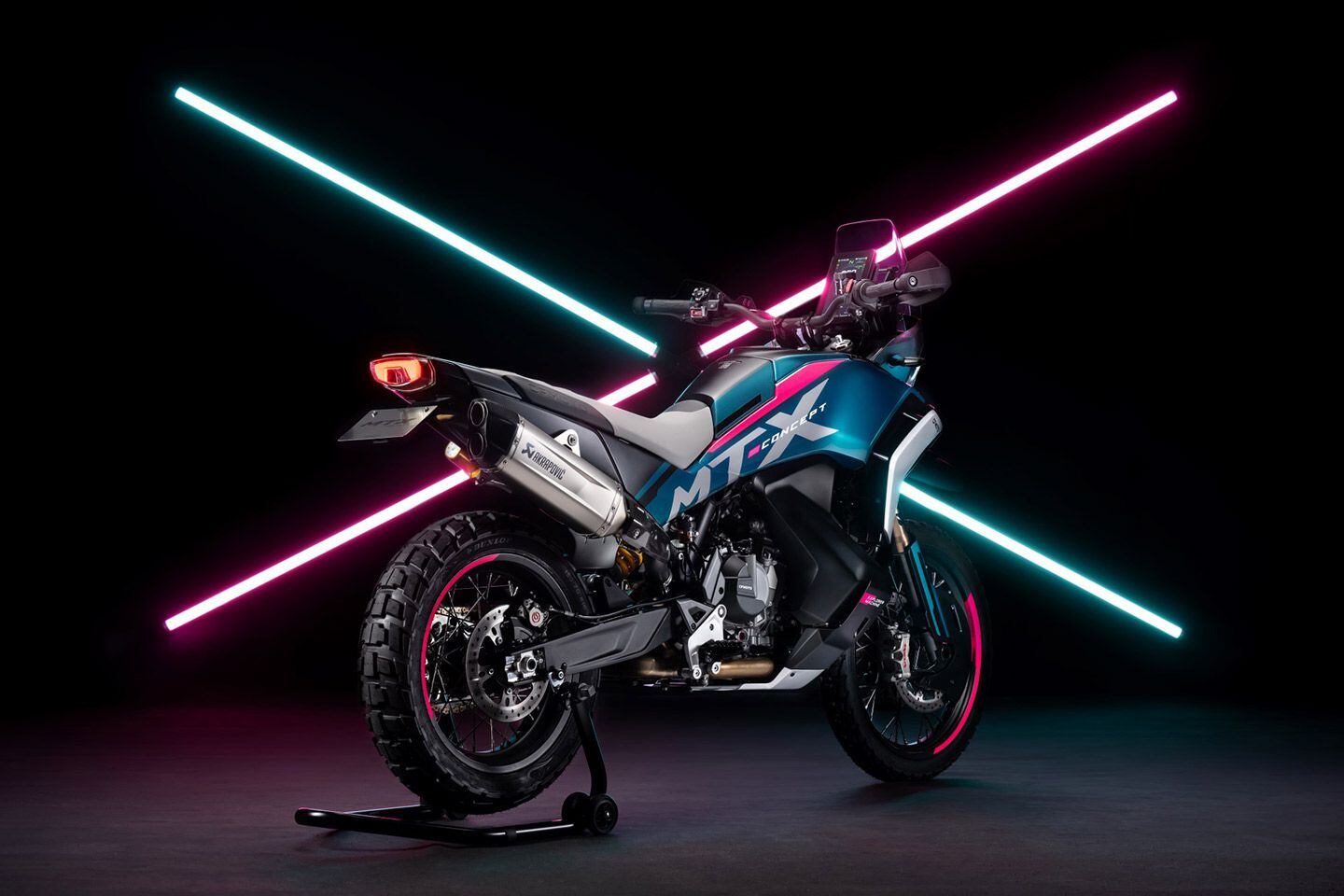
Rear three-quarter view of the CFMoto MT-X concept. (CFMoto/)The engine is the same parallel twin, developed by KTM, that’s used in the existing Ibex (known as the 800MT outside the US market). CFMoto already has a joint venture with KTM and builds these engines, as well as complete bikes including the 790 Adventure, on behalf of the Austrian firm, so it’s not some cheap Chinese knockoff. It’s also clear that, like the KTM 790 and 890 Adventure models, the MT-X has its fuel tank split into two and mounted low down on either side of the engine, lowering the center of gravity.
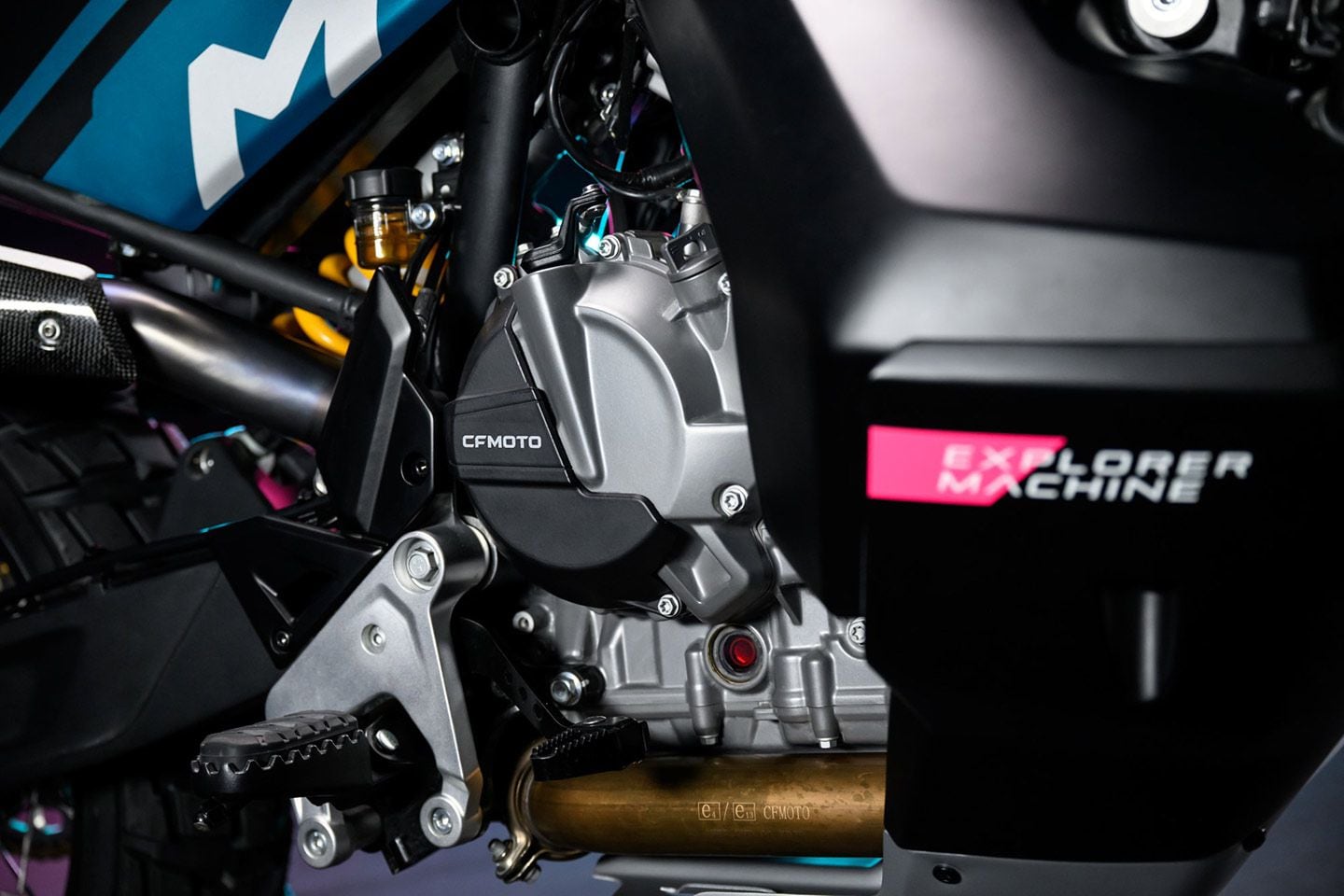
The engine in the CFMoto MT-X is the same unit that it makes for KTM and the 790 Adventure. (CFMoto/)Although the chassis is largely hidden by bodywork, the elements that can be seen again show a similarity to KTM’s Adventure models, with a near-identical layout of the steel main tubes, the subframe attachments, and the rear suspension and linkage. The same is true of the existing Ibex, though, so it’s possible the chassis is a carryover from that bike, which shares the same swingarm design seen on the MT-X concept. Above it, the bodywork has the sort of serious off-road look we’d associate with the KTM Adventure R Rally models, with a high, flat, motocross-style seat instead of the deeply stepped design seen on the road-oriented Ibex. The front end and headlight, however, have a clear family resemblance to the Ibex and other CFMoto machines.
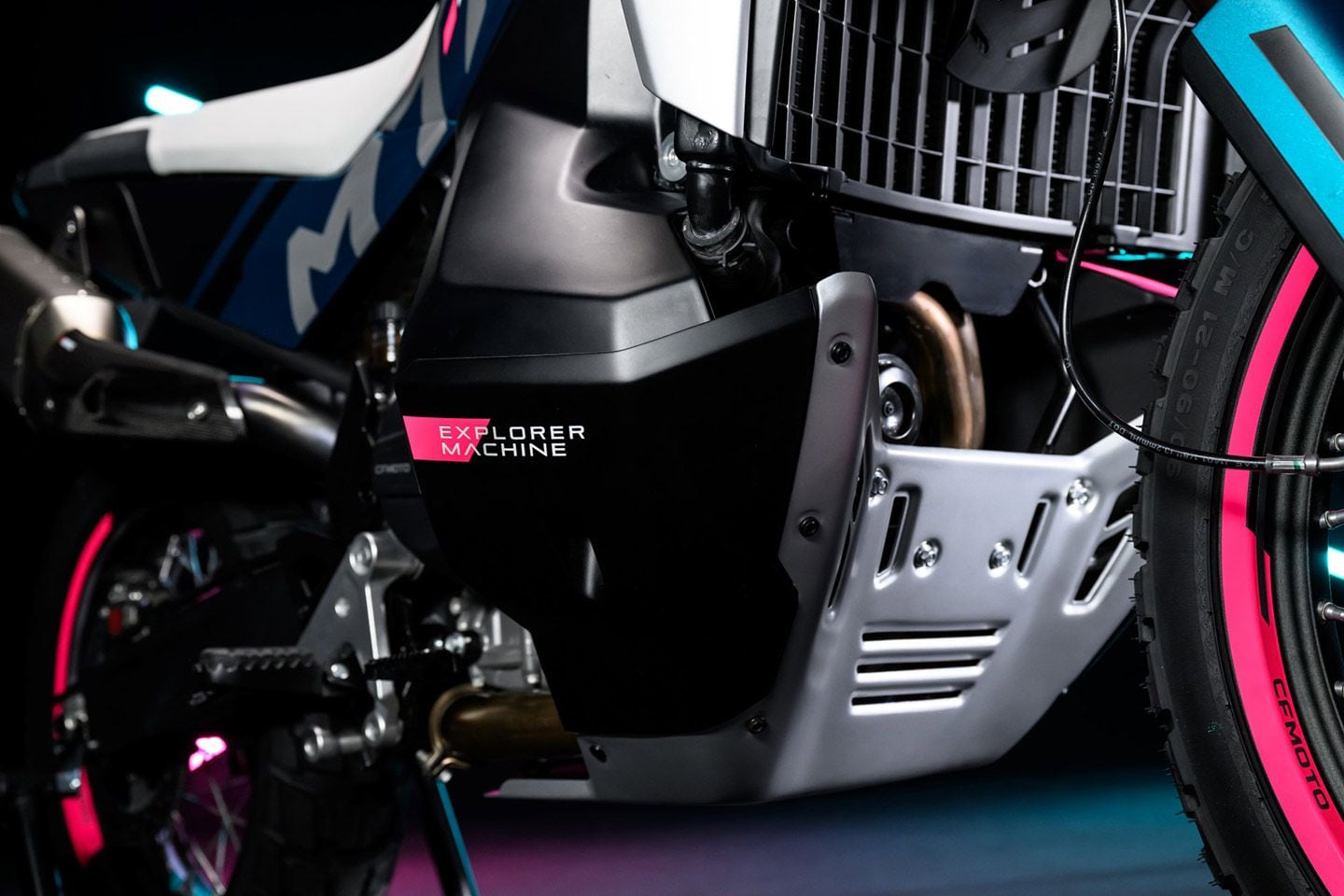
The CFMoto MT-X even shares twin saddle fuel tanks like KTM’s middleweight ADV models. (CFMoto/)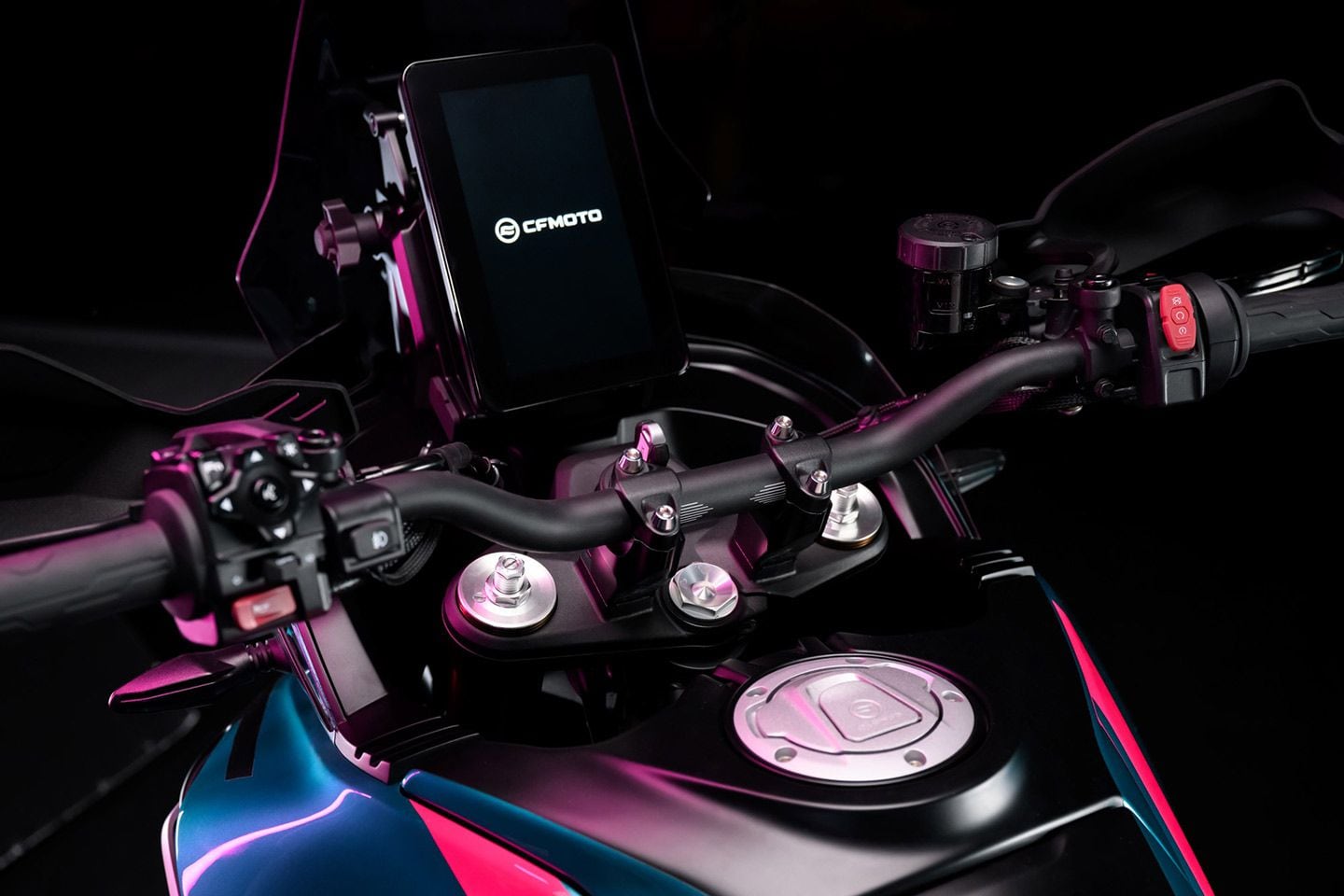
A view of the CFMoto MT-X dash. (CFMoto/)CFMoto claims the bike is particularly light, and that it will arrive “very soon” in production form, so we don’t have to wait too long before finding out more about the company’s plans.
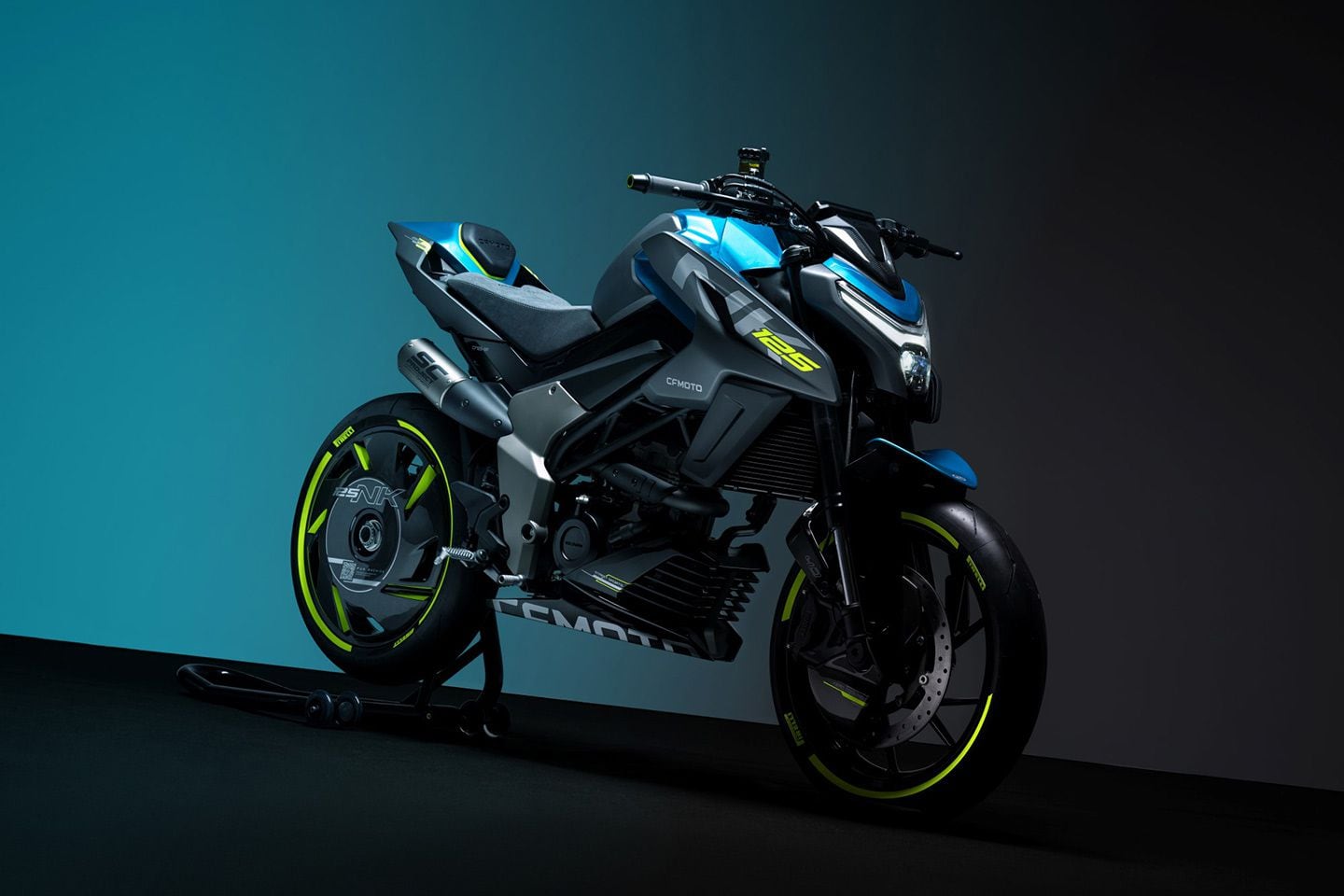
CFMoto’s 125NK concept was shown at EICMA. (CFMoto/)At EICMA, CFMoto also displayed the 125NK concept, looking very much like a near-production machine, with styling aligned with the 450NK and the latest 300NK models, although the single-sided swingarm, carbon fiber wheels, SC-Project exhaust, and Alcantara seat aren’t likely to make it to the production version that’s expected to debut in the coming months.
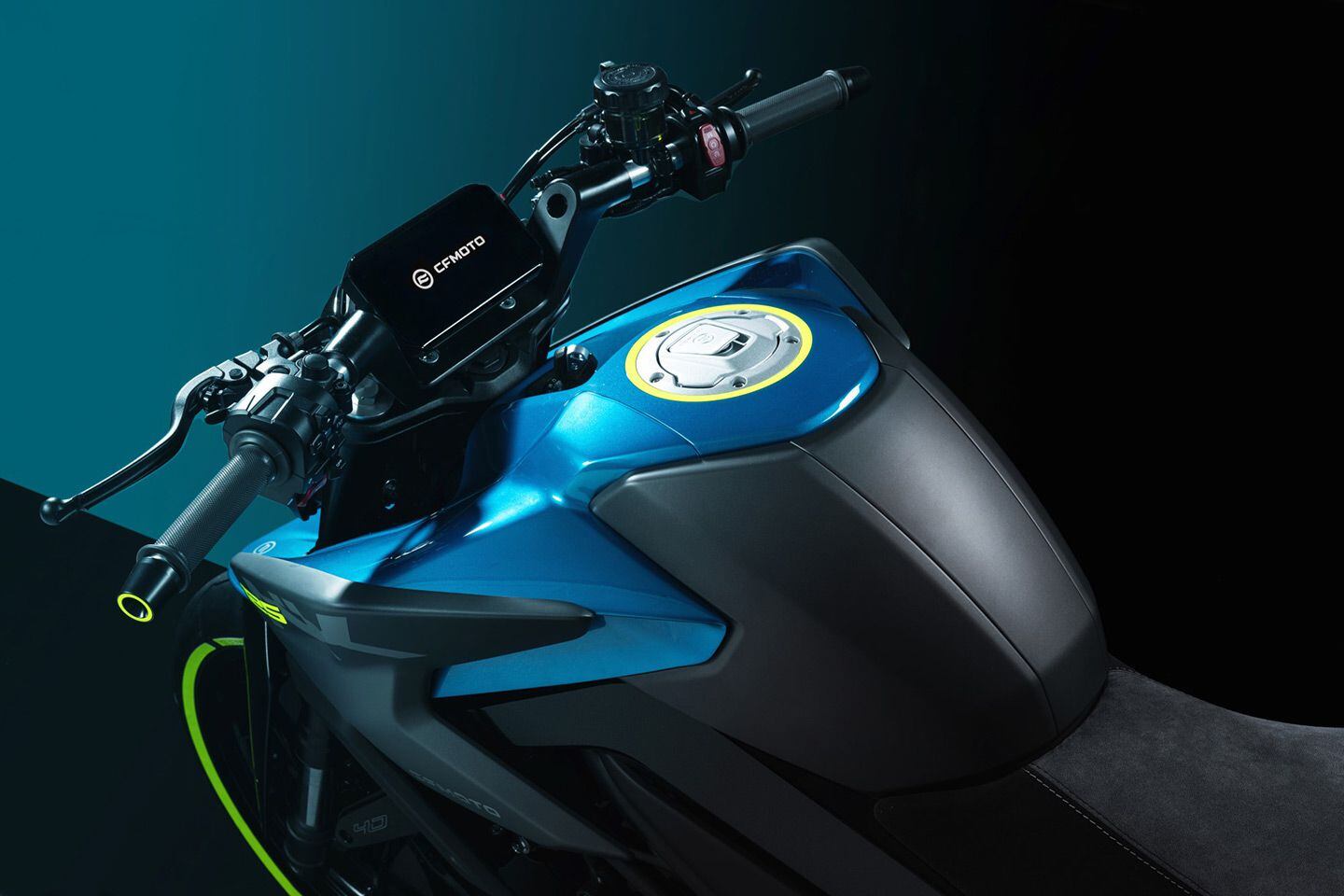
Looking like a near-production-ready machine, the 125NK could be on the market soon. (CFMoto/)Perhaps most intriguingly of all, CFMoto opted to use EICMA to update the progress of its 657cc three-cylinder engine project, which is set to debut in a sportbike that was teased back in September.
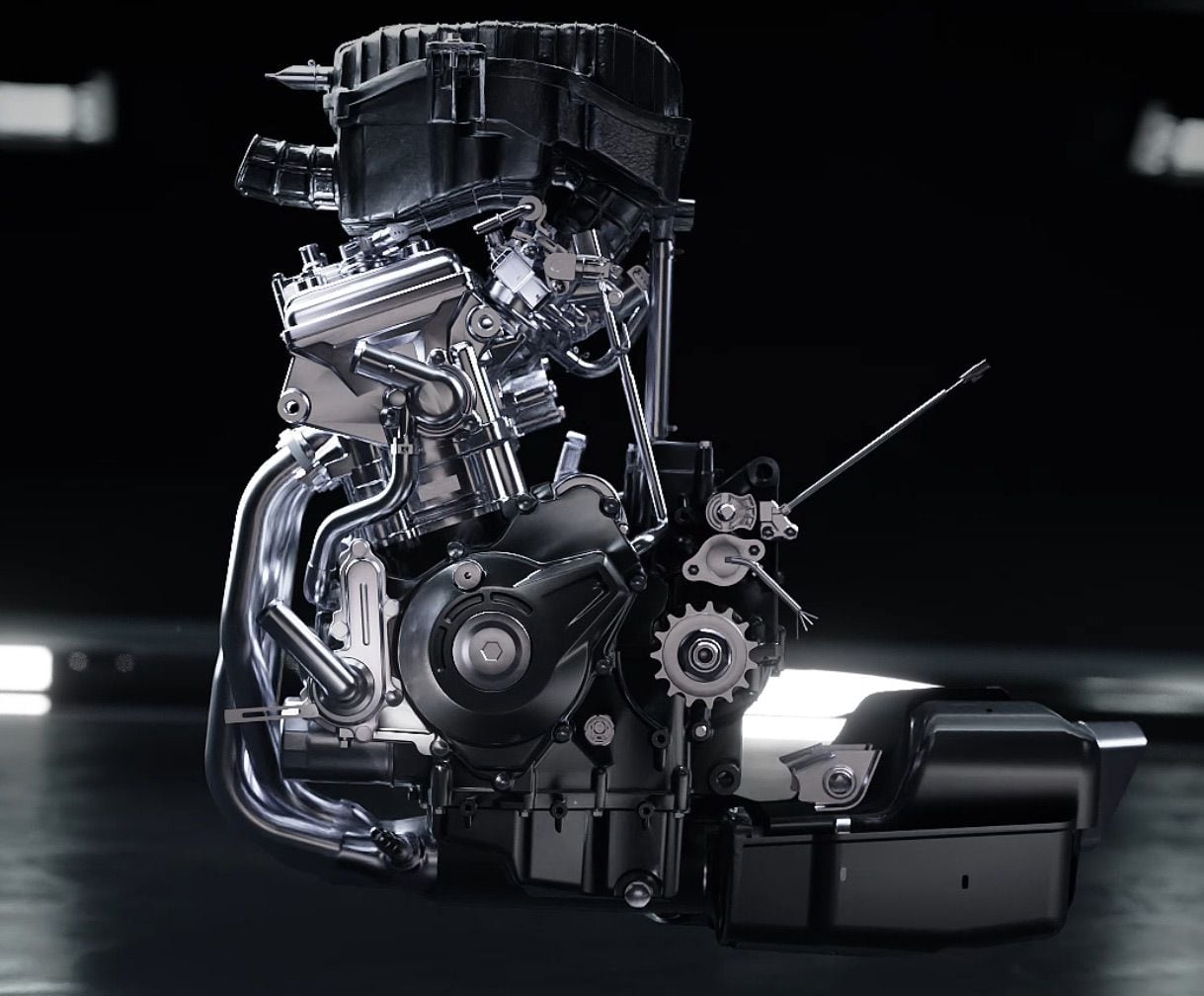
Teased a few months ago, CFMoto’s sportbike 675cc triple will make in excess of 100 hp and features some trick internal parts. (CFMoto/)The company has confirmed the engine will make in excess of 100 hp, with revs peaking at over 12,300 rpm, and adds that it’s the lightest triple in its class. Not that there are many 675cc three-cylinder machines currently out there to compete with. The latest information includes the tidbits that there are cobalt alloy valves and forged aluminum pistons, and that the whole engine weighs less than 121 pounds.
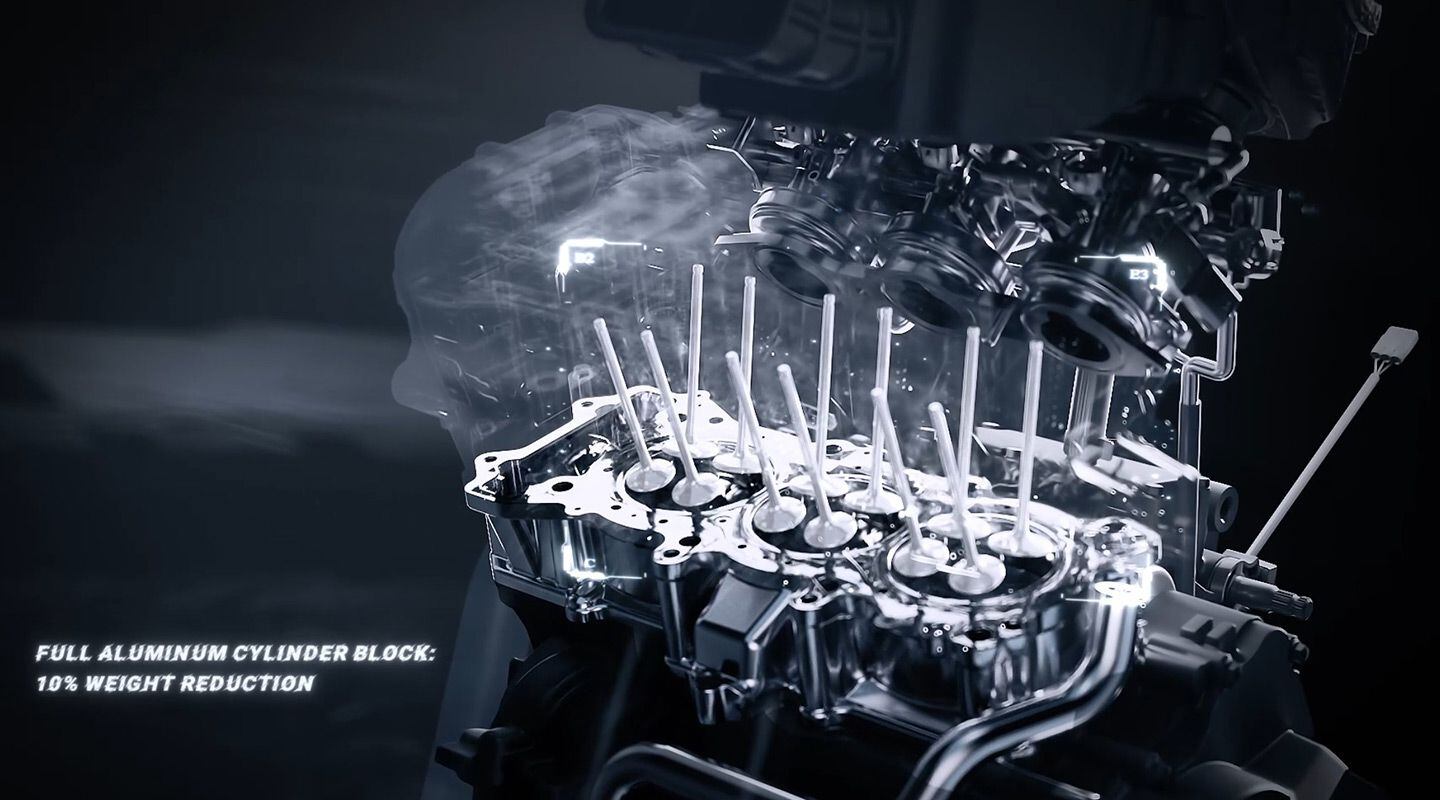
The engine is said to have cobalt alloy valves and forged aluminum pistons. (CFMoto/)There’s also a “low inertia crankshaft” that gives 12 percent improved response—although it’s not clear what that is being compared to—and perhaps most importantly the engine has completed 200-hour continuous-running dyno tests with no failures. Reliability might well prove to be more important than outright performance in proving CFMoto’s credentials when entering this new segment of the market.
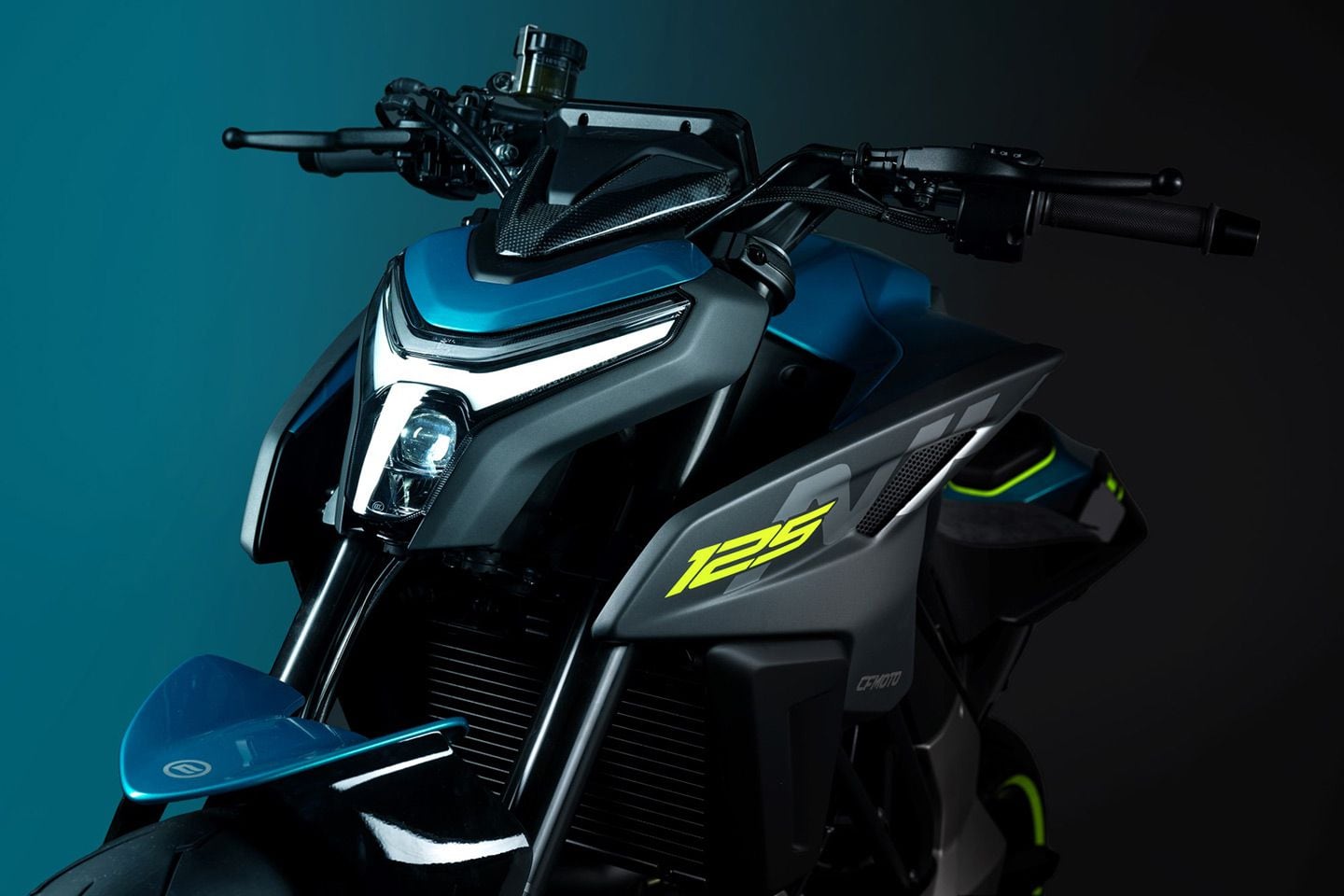
The CFMoto 125NK’s front nose. (CFMoto/)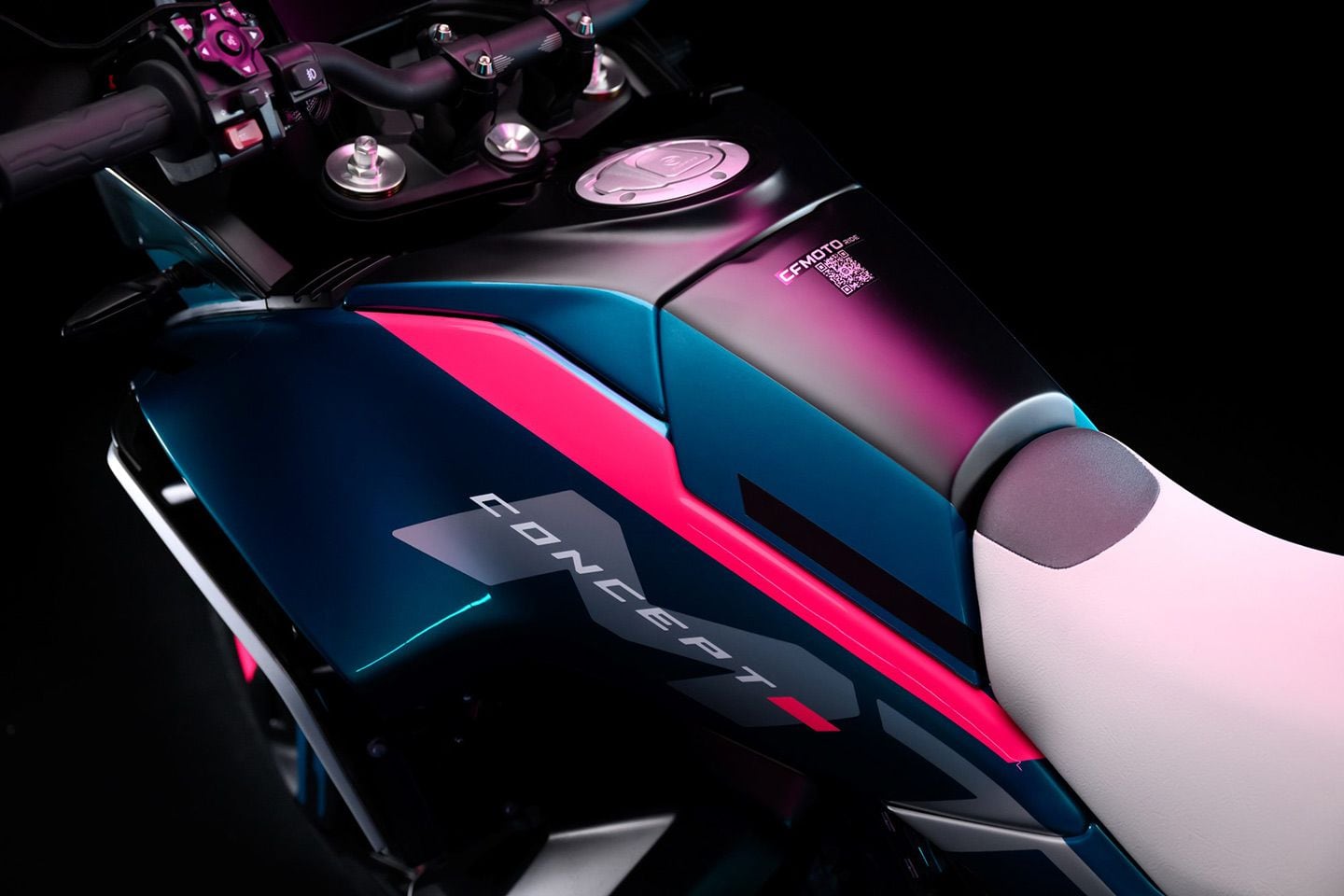
The cockpit looks very similar to KTM’s 790 Adventure. (CFMoto/)-
 1
1
-
-
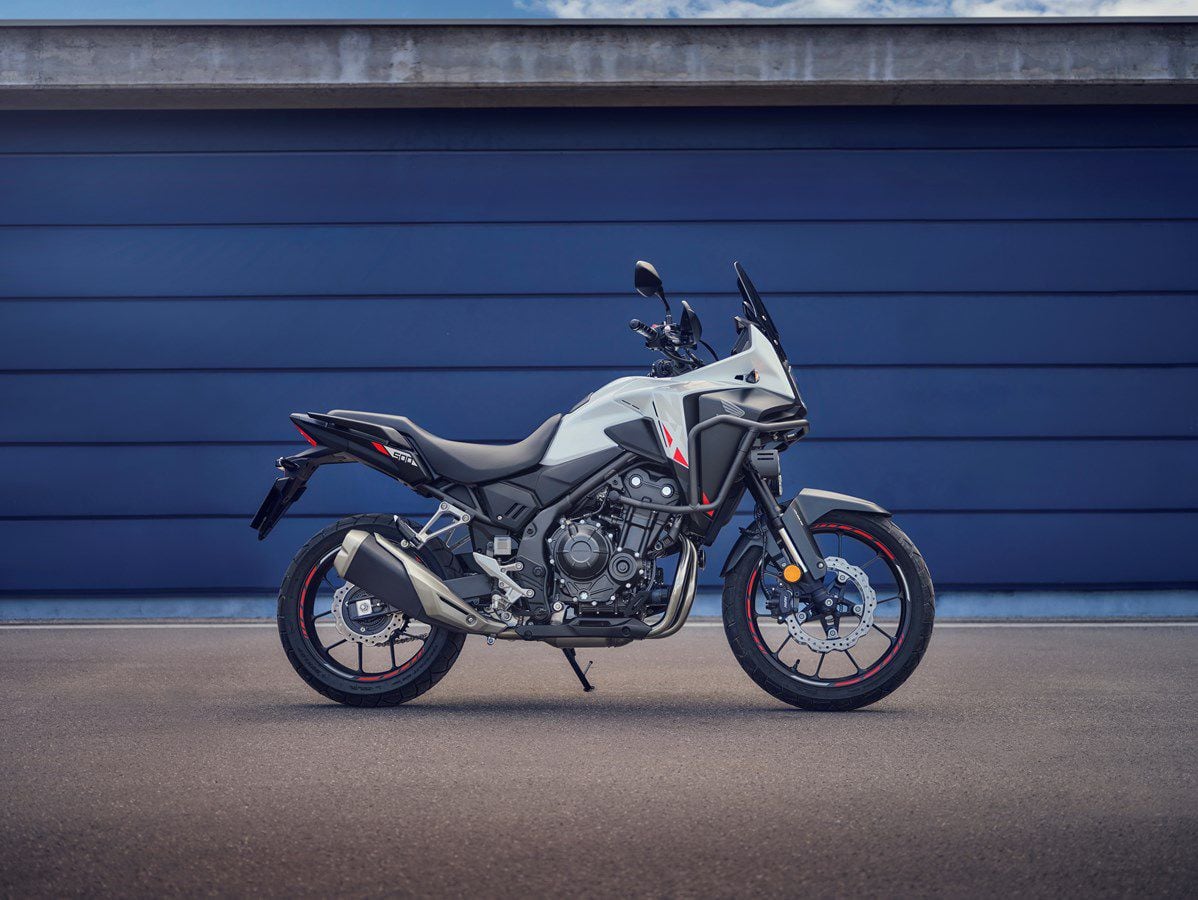
Honda’s CB500X gets an updated name, now called the NX500, in addition to some minor updates. (Honda/)Honda has revamped its long-lived CB500 range to bring it into line with the company’s latest naming and styling themes—replacing the CB500F with the CB500 Hornet, the CB500X with the NX500, and restyling the CBR500R to match the latest superbike models.
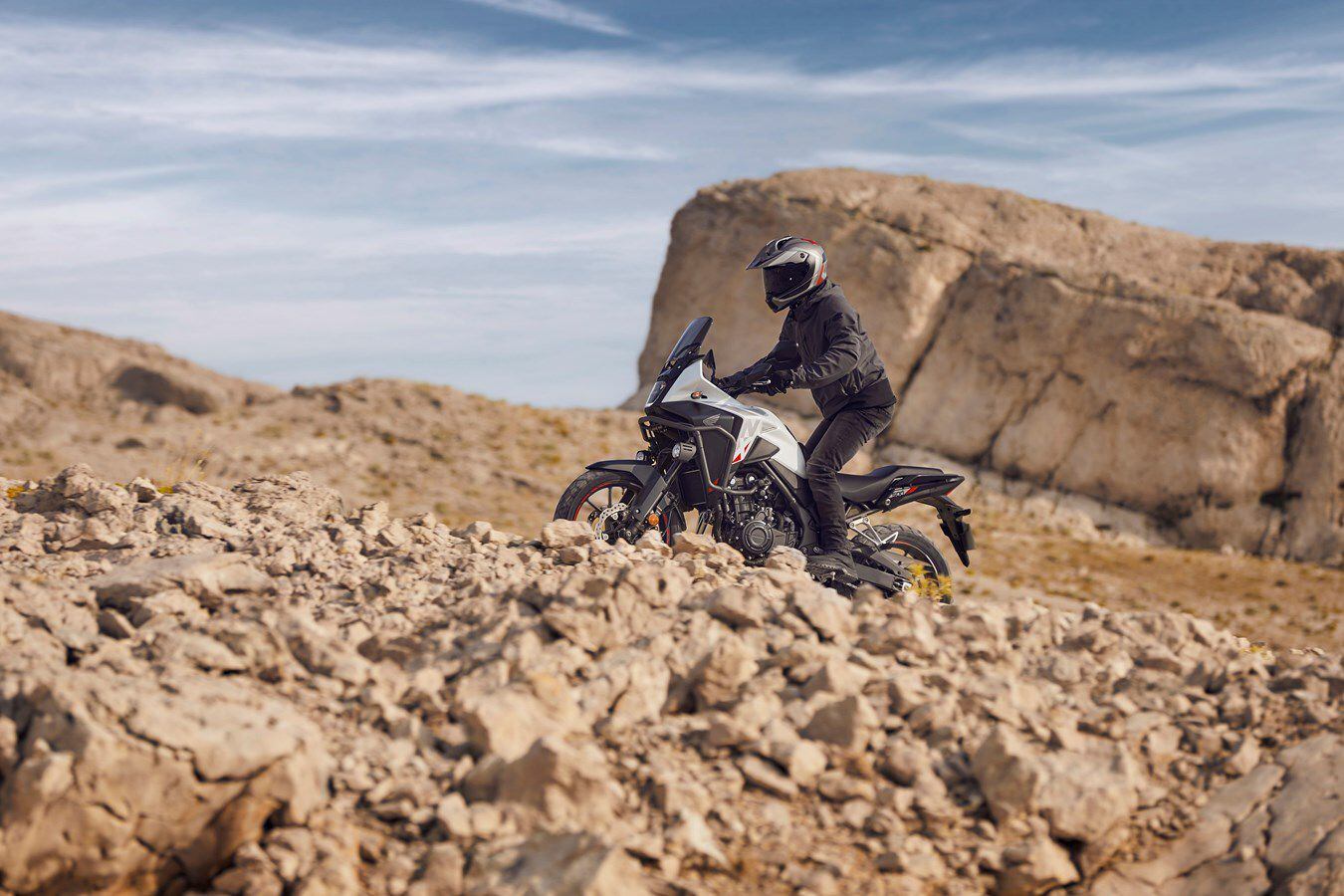
Honda’s 2024 NX500. (Honda/)The most notable change is the NX500, a completely new title for the model previously known as the CB500X, which is also revised and restyled to suit. The “NX” title is, of course, a throwback to the old NX650 Dominator, sold from 1988 to 2003 as a lower-range adventure alternative to the Africa Twin and Transalp models. With both those names now back in Honda’s lineup, it makes sense to bring back the NX, although—in Europe at least—the Dominator branding hasn’t been revived.
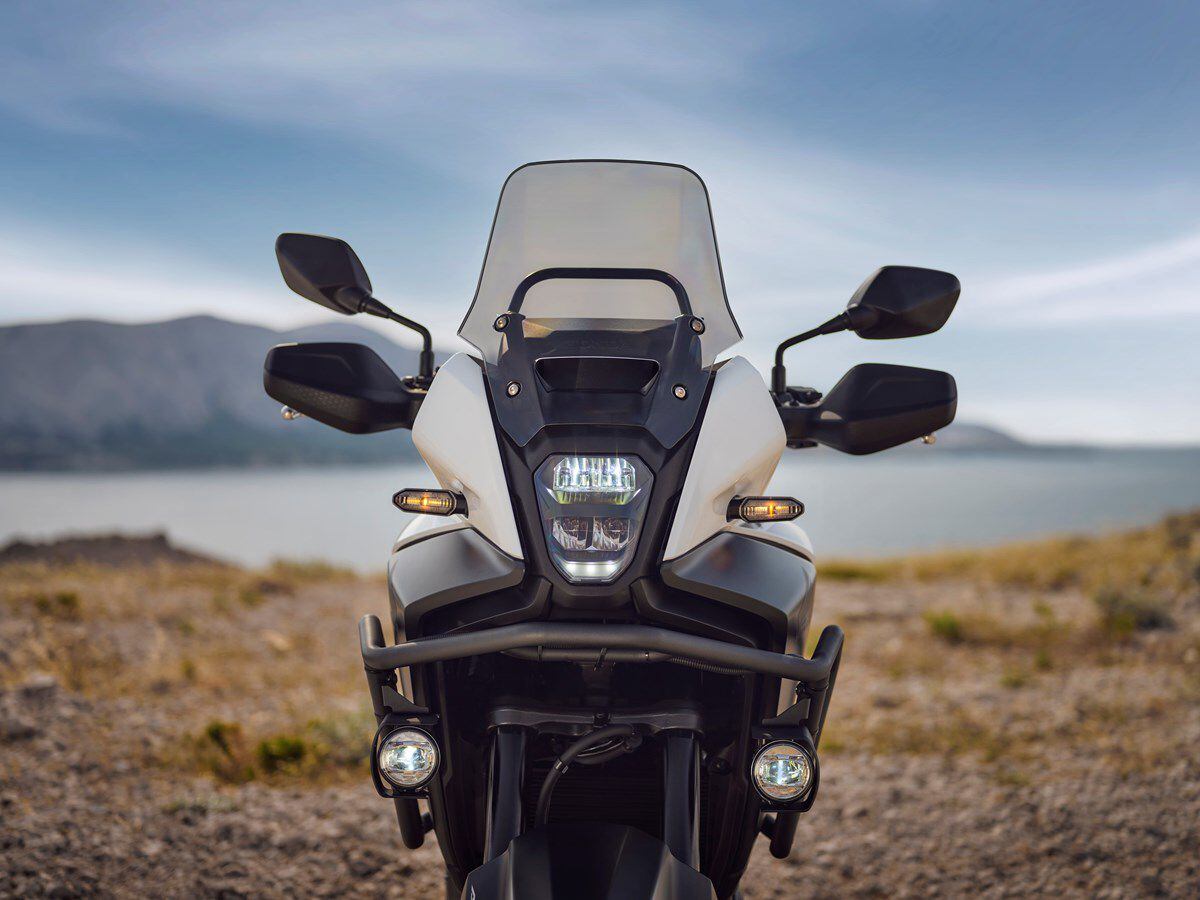
The 2024 NX500 gets an updated look with a flatter upper fairing and without the former bike’s beak. (Honda/)Technical changes to the NX500 are minor. The existing 47 hp, 471cc parallel twin is carried over to the new model, along with an unchanged frame, although there are tweaks to the engine’s ECU to improve response and to add HSTC traction control.
Visually, Honda has swapped the wheels for a new, lighter design, saving 3.3 pounds, as part of an update that cuts a total of 6.6 pounds from the bike’s mass. The 41mm Showa fork and shock are essentially the same as before, but with revised settings. On board there’s a new 5-inch TFT dash that offers smartphone connectivity via Honda’s RoadSync app, plus updated bar controls to operate it.
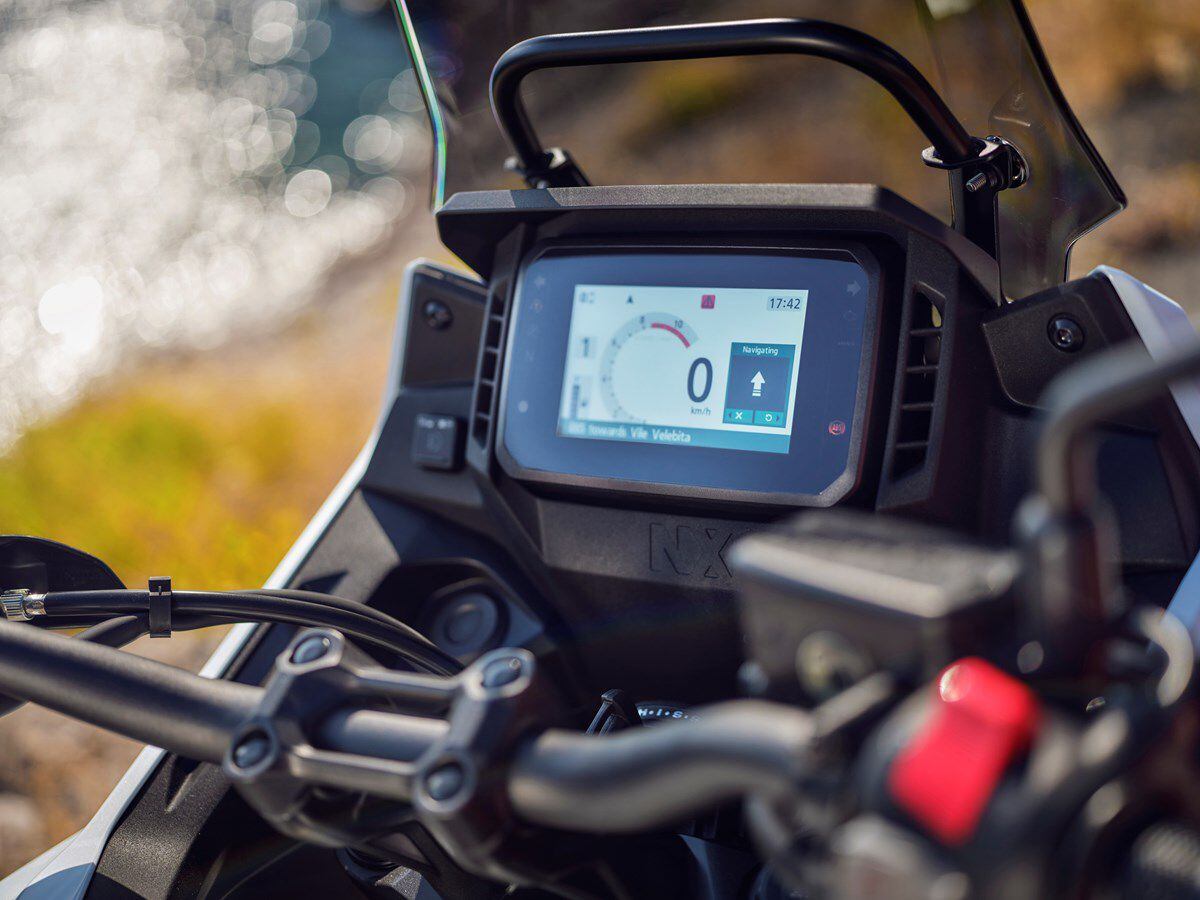
A new 5-inch TFT display offers smartphone connectivity via the RoadSync app. (Honda/)The styling changes include a new front end with an LED headlight and a more flat-faced look that ditches the vestigial beak of the CB500X, in keeping with Dakar-style trends in the adventure-bike market and giving a family link to the Transalp and Africa Twin models.
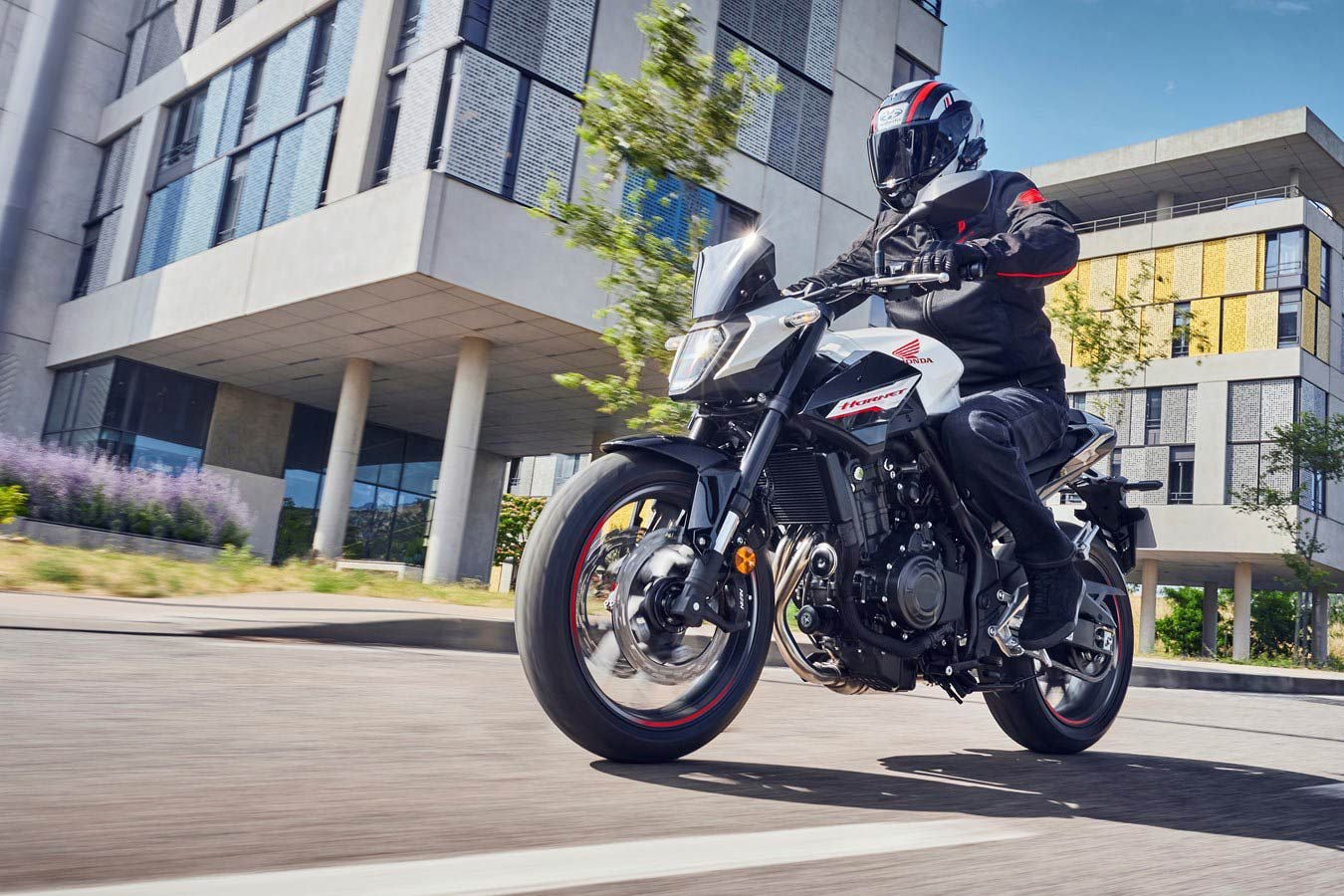
The CB500F is now called the CB500 Hornet. (Honda/)The new CB500 Hornet is a direct replacement for the CB500F and shares most of its main parts—the name change brings it into line with the CB750 Hornet and the new CB1000 Hornet that was also unveiled at EICMA. Like the NX500, the updates include the same new TFT display, bar controls and phone connectivity, as well as similar ECU updates to the 47 hp, 471cc twin to add HSTC, which can be switched off if you prefer.
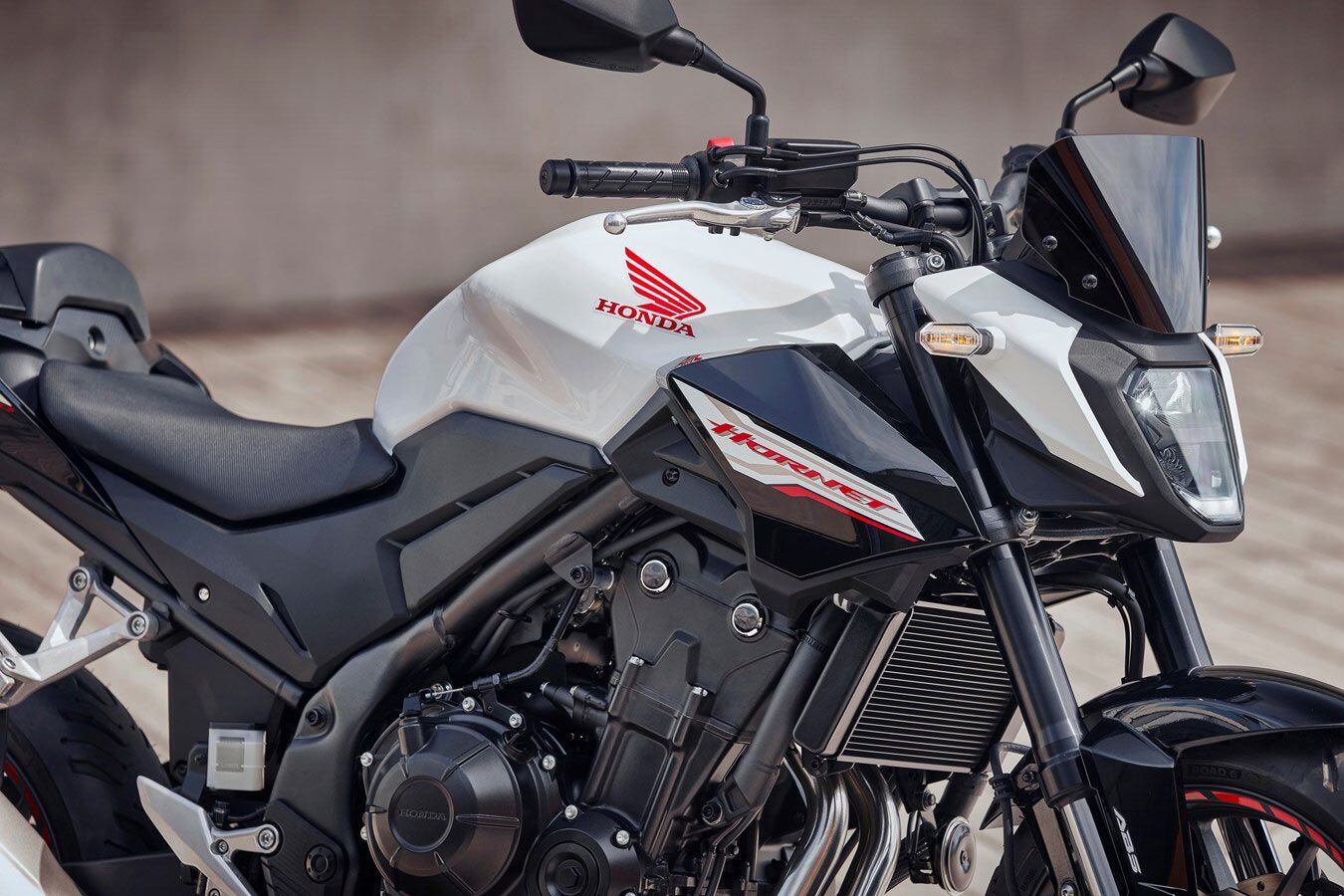
The 2024 CB500 Hornet gets a new LED headlight and updated styling. (Honda/)The styling updates include a new LED headlight design and revisions to the ducts on either side of the tank, but the rear section remains unchanged.
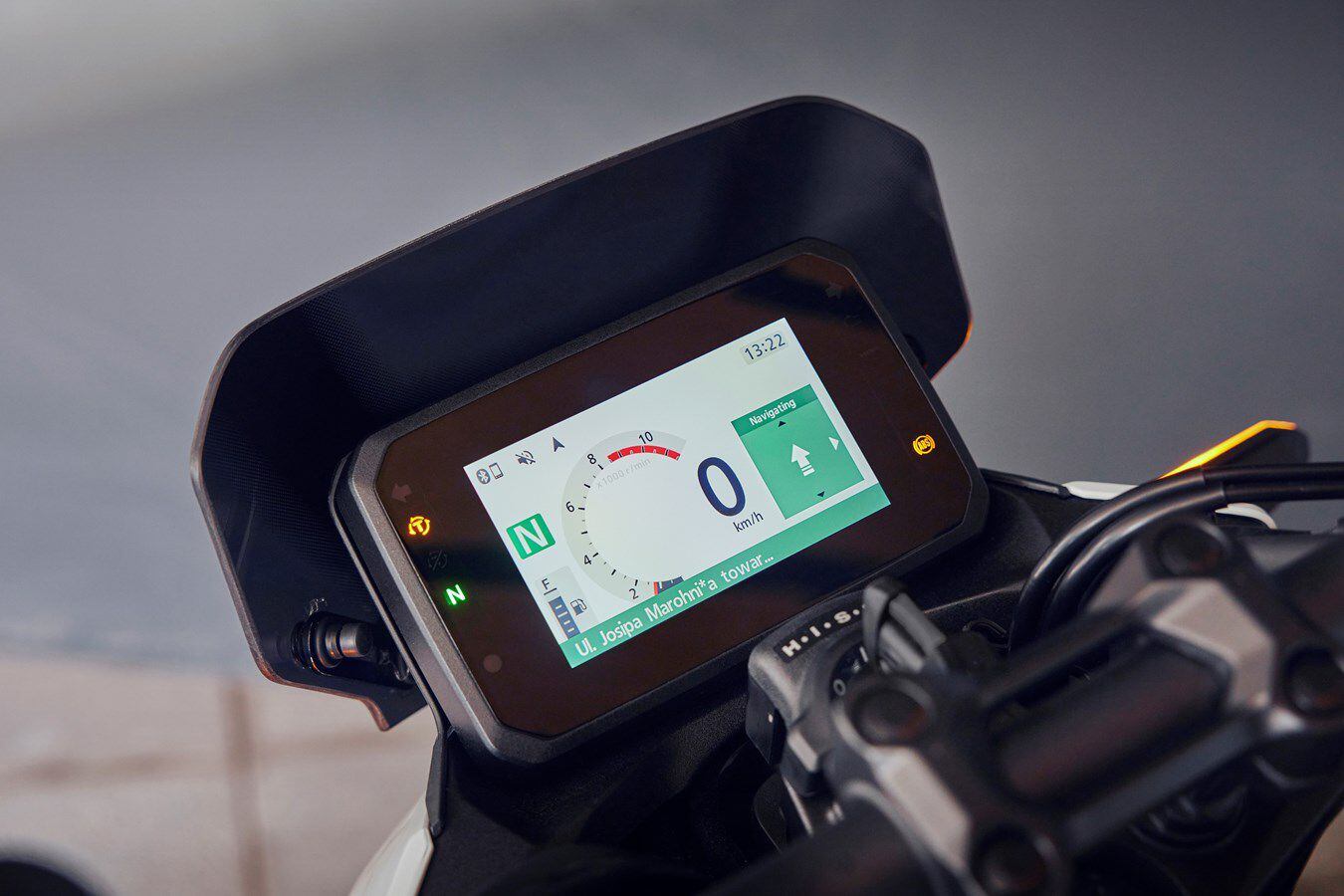
The CB500 Hornet’s new 5-inch TFT display. (Honda/)It’s a similar story for the CBR500R, the only model in the range that doesn’t get a name change. Its engine has the same electronic updates but remains mechanically the same as the previous version, and having gained suspension updates including Showa SFF-BP forks in 2022 there’s been no further improvement to the 2024 model.
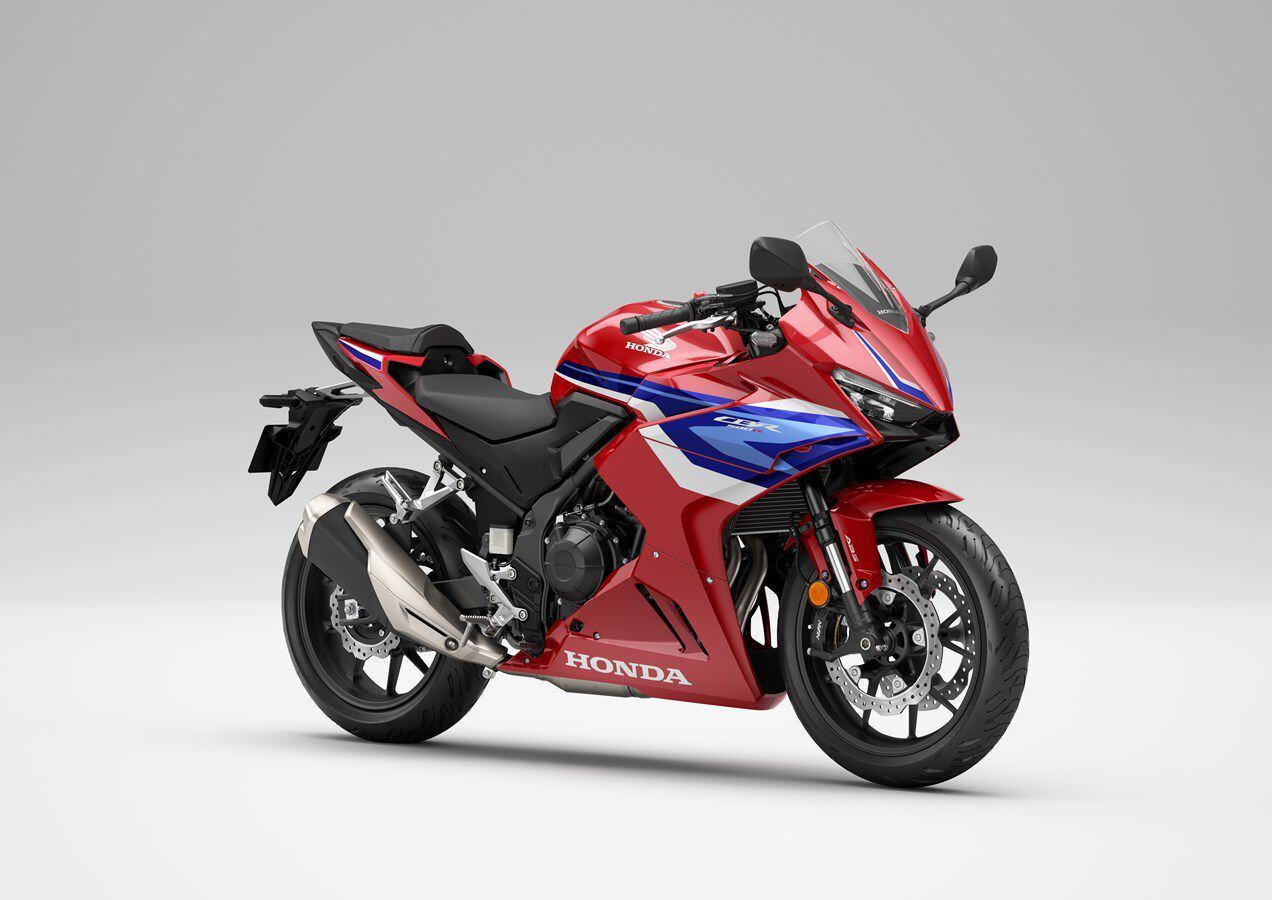
The CBR500R keeps its name but gets some minor updates in line with the rest of the model range. (Honda/)That leaves the styling as the biggest revision for the new version, with an updated fairing that takes its cues from the CBR1000RR-R, including new headlights. Like the rest of the CB500 range it also gains the new 5-inch TFT dash and matching bar controls to navigate the phone connectivity it brings.
2024 Honda NX500 Specs
MSRP: TBA Engine: DOHC, liquid-cooled, four-stroke parallel twin; 4 valves/cyl. Displacement: 471cc Bore x Stroke: 67.0 x 66.8mm Compression Ratio: 10.7:1 Transmission/Final Drive: 6-speed/chain Claimed Horsepower: 47 hp @ 8,600 rpm Claimed Torque: 31.7 lb.-ft. @ 6,500 rpm Fuel System: PGM FI electronic fuel injection Clutch: Wet, multiplate slipper/assist Engine Management/Ignition: Full transistorized Frame: Steel diamond Front Suspension: Showa 41mm SFF-BP USD fork Rear Suspension: Pro-Link monoshock, preload adjustable Front Brake: Nissin 2-piston caliper, 296mm discs w/ ABS Rear Brake: Nissin 1-piston caliper, 240mm disc w/ ABS Wheels, Front/Rear: 19 x 2.5 in. / 17 x 4.5 in. Tires, Front/Rear: 110/80-19 / 160/60-17 Rake/Trail: 27.5°/4.25 in. Wheelbase: 56.9 in. Ground Clearance: 7.1 in. Seat Height: 32.7 in. Fuel Capacity: 4.6 gal. Claimed Wet Weight: 432 lb. Contact: powersports.honda.com 2024 Honda CB500 Hornet Specs
MSRP: TBA Engine: DOHC, liquid-cooled, four-stroke parallel twin; 4 valves/cyl. Displacement: 471cc Bore x Stroke: 67.0 x 66.8mm Compression Ratio: 10.7:1 Transmission/Final Drive: 6-speed/chain Claimed Horsepower: 47 hp @ 8,600 rpm Claimed Torque: 31.7 lb.-ft. @ 6,500 rpm Fuel System: PGM FI electronic fuel injection Clutch: Wet, multiplate slipper/assist Engine Management/Ignition: Full transistorized Frame: Steel diamond Front Suspension: Showa 41mm SFF-BP USD fork Rear Suspension: Pro-Link monoshock, preload adjustable Front Brake: Nissin 4-piston caliper, 296mm discs w/ ABS Rear Brake: Nissin 1-piston caliper, 240mm disc w/ ABS Wheels, Front/Rear: 17 x 3.5 in. / 17 x 4.5 in. Tires, Front/Rear: 120/70-17 / 160/60-17 Rake/Trail: 25.5°/4.0 in. Wheelbase: 55.5 in. Ground Clearance: 5.7 in. Seat Height: 30.9 in. Fuel Capacity: 4.5 gal. Claimed Wet Weight: 414 lb. 2024 Honda CBR500R Specs
MSRP: TBA Engine: DOHC, liquid-cooled, four-stroke parallel twin; 4 valves/cyl. Displacement: 471cc Bore x Stroke: 67.0 x 66.8mm Compression Ratio: 10.7:1 Transmission/Final Drive: 6-speed/chain Claimed Horsepower: 47 hp @ 8,600 rpm Claimed Torque: 31.7 lb.-ft. @ 6,500 rpm Fuel System: PGM FI electronic fuel injection Clutch: Wet, multiplate slipper/assist Engine Management/Ignition: Full transistorized Frame: Steel diamond Front Suspension: Showa 41mm SFF-BP USD fork Rear Suspension: Pro-Link monoshock, preload adjustable Front Brake: Nissin 4-piston caliper, 296mm discs w/ ABS Rear Brake: Nissin 1-piston caliper, 240mm disc w/ ABS Wheels, Front/Rear: 17 x 3.5 in. / 17 x 4.5 in. Tires, Front/Rear: 120/70-17 / 160/60-17 Rake/Trail: 25.5°/4.0 in. Wheelbase: 55.5 in. Ground Clearance: 5.1 in. Seat Height: 30.9 in. Fuel Capacity: 4.5 gal. Claimed Wet Weight: 421 lb. -
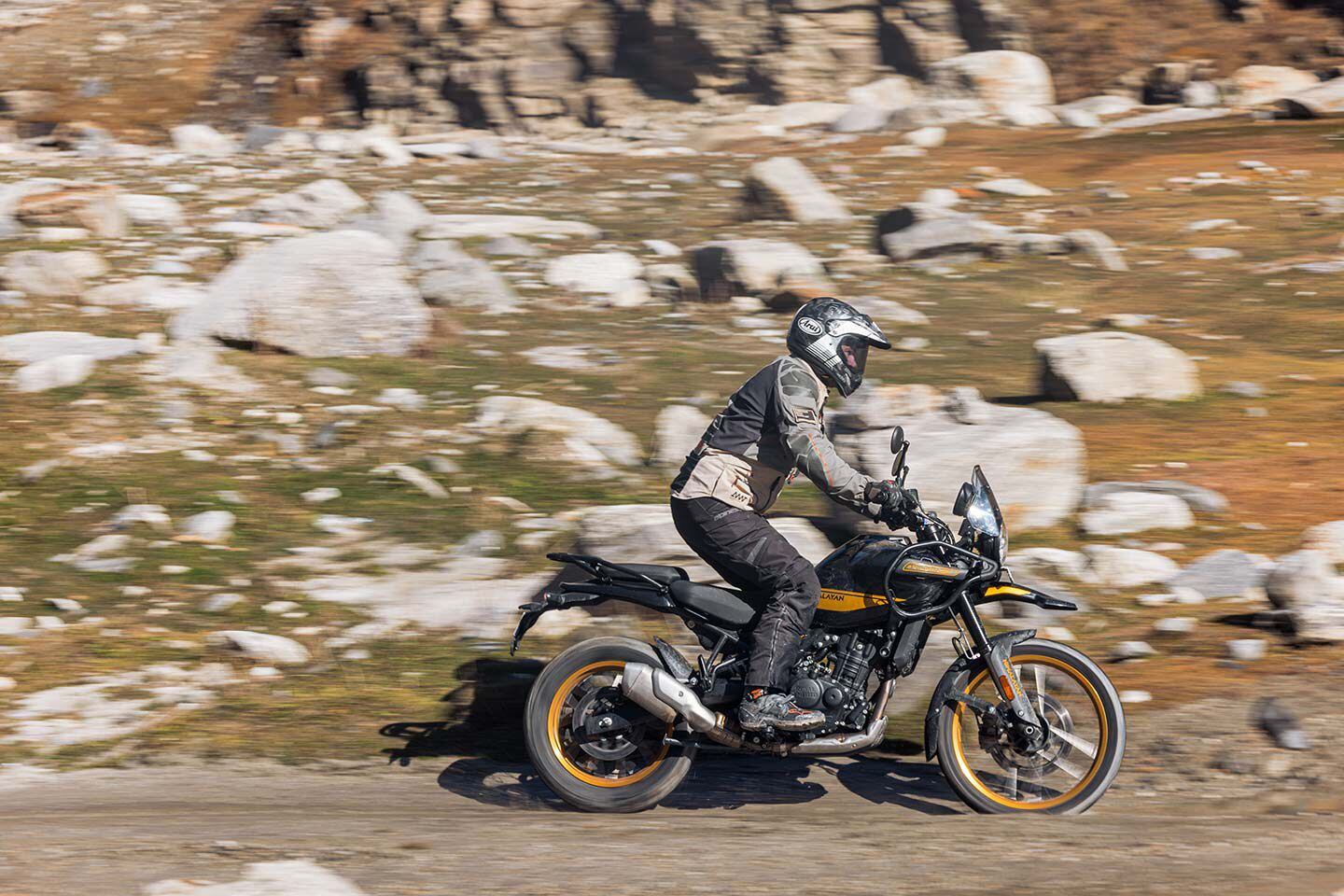
Royal Enfield completely redesigned the 2024 Himalayan from the wheels up. A new engine, chassis, and electronics share nothing with the previous model. (Royal Enfield/)Royal Enfield’s affordable, authentic retro offerings are currently the biggest draw to a company that’s gone from strength to strength in recent years, but until now the brand has been short of a genuinely modern bike for riders who aren’t looking for a taste of the past. With the new Himalayan that gap is filled.
Sporting an all-new, liquid-cooled DOHC four-valve single-cylinder engine, with ride-by-wire controlling the throttle and mated to a six-speed transmission, the new Himalayan is a very different prospect to its air-cooled predecessor. While its position in the range is the same as the original version, which itself broke new ground for Royal Enfield at its launch in 2015, the new bike shares nothing with the earlier model apart from the general shape and role as a go-anywhere, lightweight adventurer.
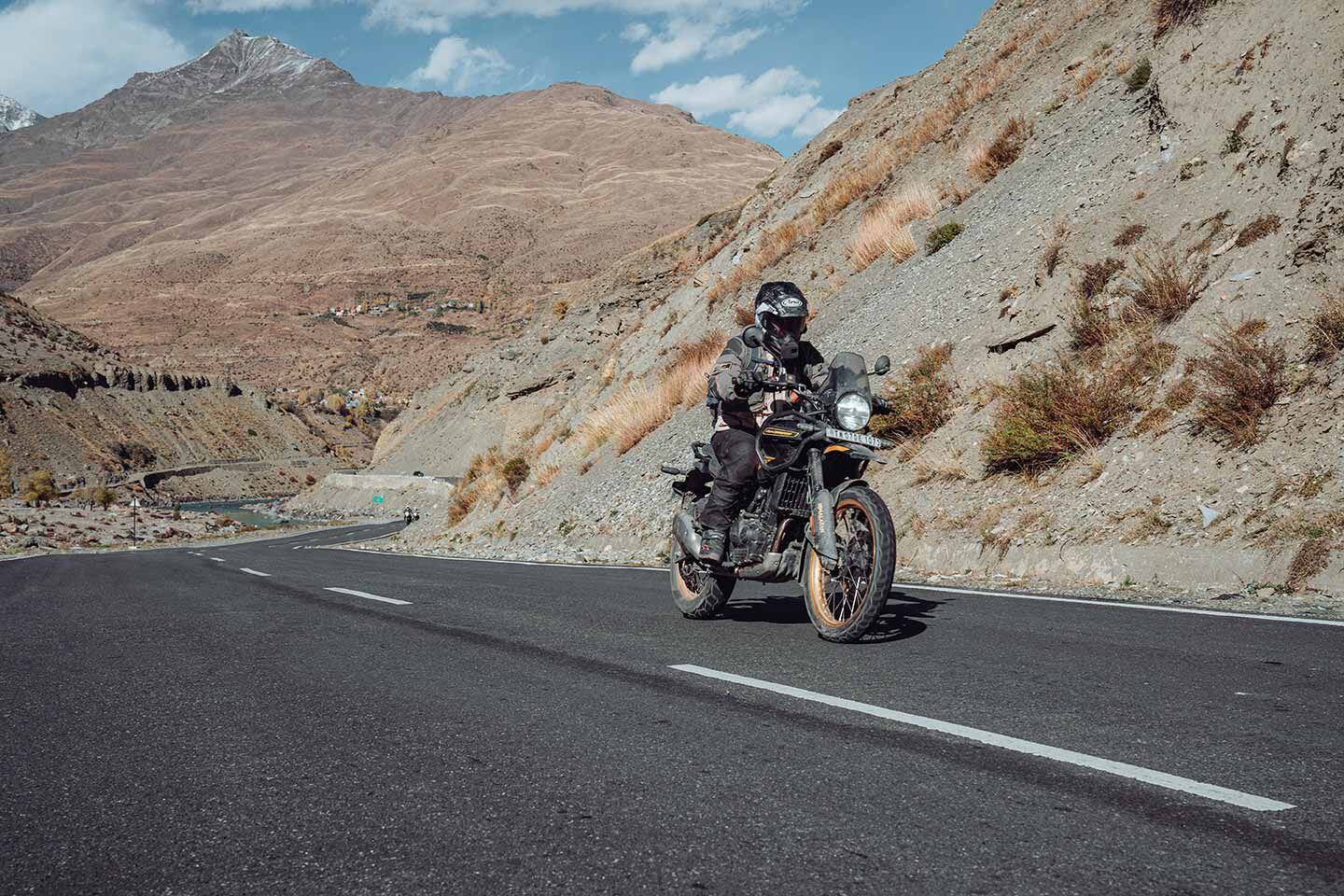
Royal Enfield has taken the lightweight adventure bike to the next level with the 2024 Himalayan. (Royal Enfield/)Where the old Himalayan was the debut platform for Enfield’s 411cc air-cooled SOHC two-valve single, which wheezes out 24 hp at 6,500 rpm, the new bike features the company’s new Sherpa 450 engine. Measuring in at 452cc, its performance increase is far more than you’d expect from the addition of another 41cc. Liquid-cooling allows a much higher state of tune to be adopted, with an 11.5:1 compression ratio instead of the old engine’s 9.5:1, while four valves and two camshafts let gases in and out much more freely. The result is a peak of 40 hp at 8,000 rpm, with 29.5 lb.-ft. of torque arriving at 5,500 rpm.
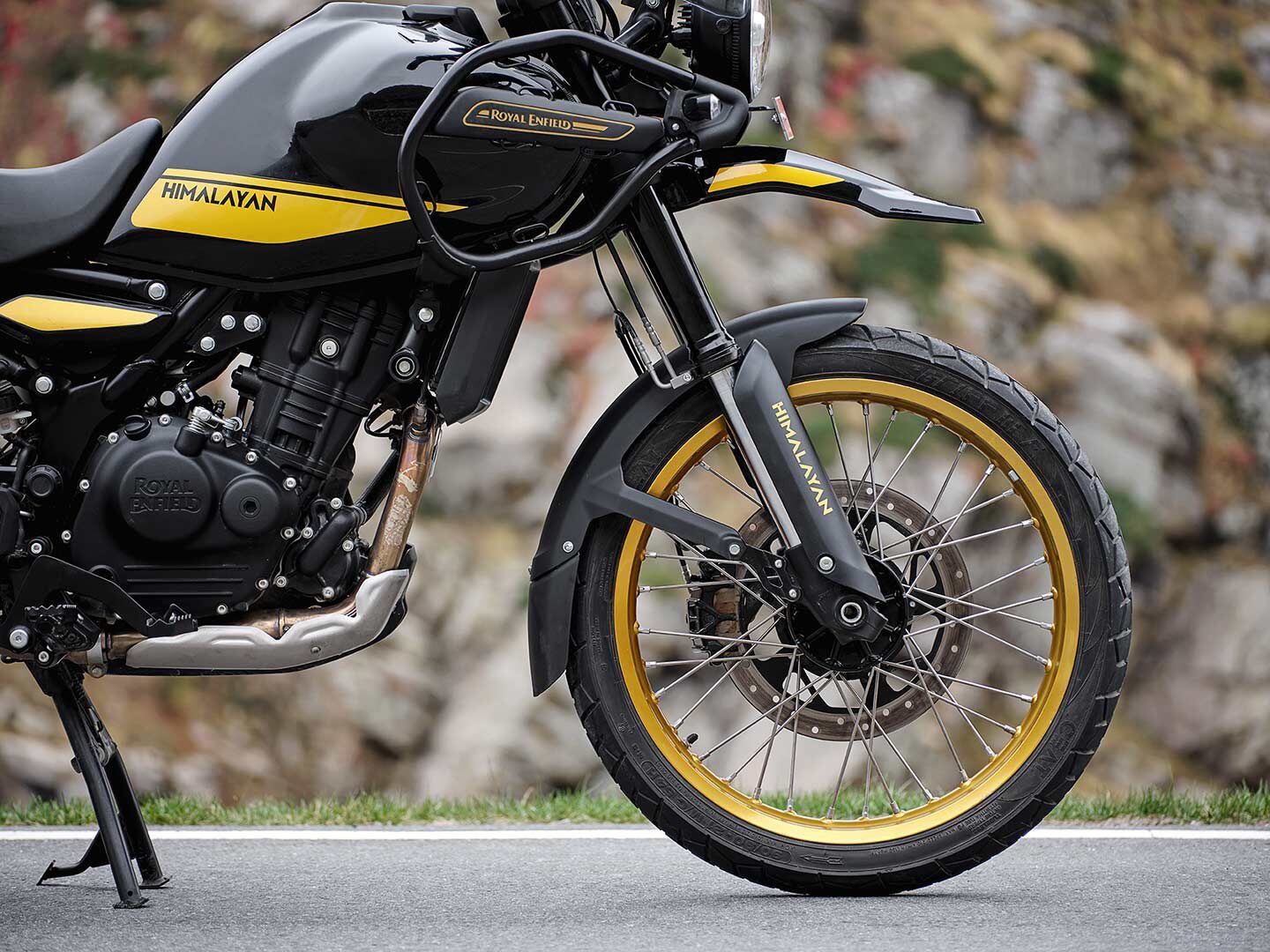
The brand-new 452cc liquid-cooled engine pumps out 65 percent more horsepower than the previous model. (Royal Enfield/)That engine hangs beneath a newly designed, steel twin-spar frame in place of the old bike’s half-duplex, split-cradle design, with much more modern suspension at either end. Up front, an upside-down 43mm Showa fork replaces the earlier bike’s skinny, 41mm right-way-up version, and at the back there’s a curved alloy swingarm that’s connected to a Showa monoshock via a rising-rate linkage. It’s a design that more than offsets the extra mass of the liquid-cooled engine and radiator, bringing the bike’s total curb weight down from 439 pounds to 432 pounds, including a 90 percent full tank of fuel. It’s a bigger fuel tank too, up from 4 gallons on the original Himalayan to 4.5 gallons on the 2024 model.
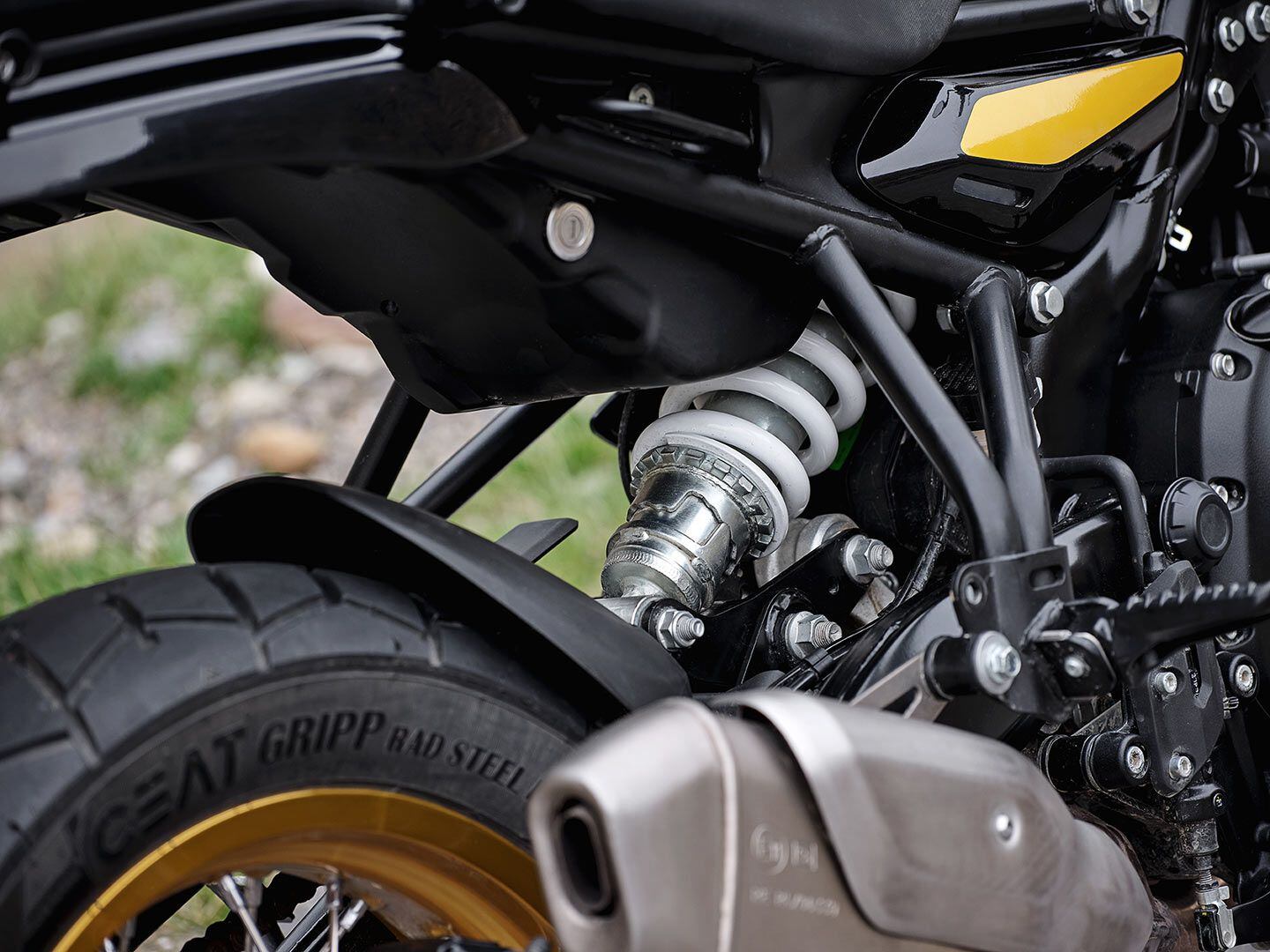
Showa suspension at each end offers 7.9 inches of travel with a 21-inch front wheel/tire combo and a 17-inch rear. (Royal Enfield/)The suspension offers 7.9 inches of travel at each end, and the bike’s off-road ability is bolstered by wire-spoked wheels wearing 90/90-21 rubber at the front and a 140/80-17 at the rear (with tubeless versions an option). Even the brakes are substantially improved, with a single 320mm front disc and ByBre dual-piston caliper and single-pot rear stopper on a 270mm rotor, with switchable ABS.
Although not intended to be sleek, the 2024 Himalayan has a more sculpted look than the original, swapping pure utilitarianism for a more conventionally attractive style. The traditional-looking, round LED headlight is mounted a little lower, the front “beak” and rear fender are flatter, and the fuel tank’s sides are more voluptuous. A two-part seat offers an adjustable height for the rider, from 32.5 inches to 33.3 inches, with the option of a lower version that can be dropped to 31.7 inches.
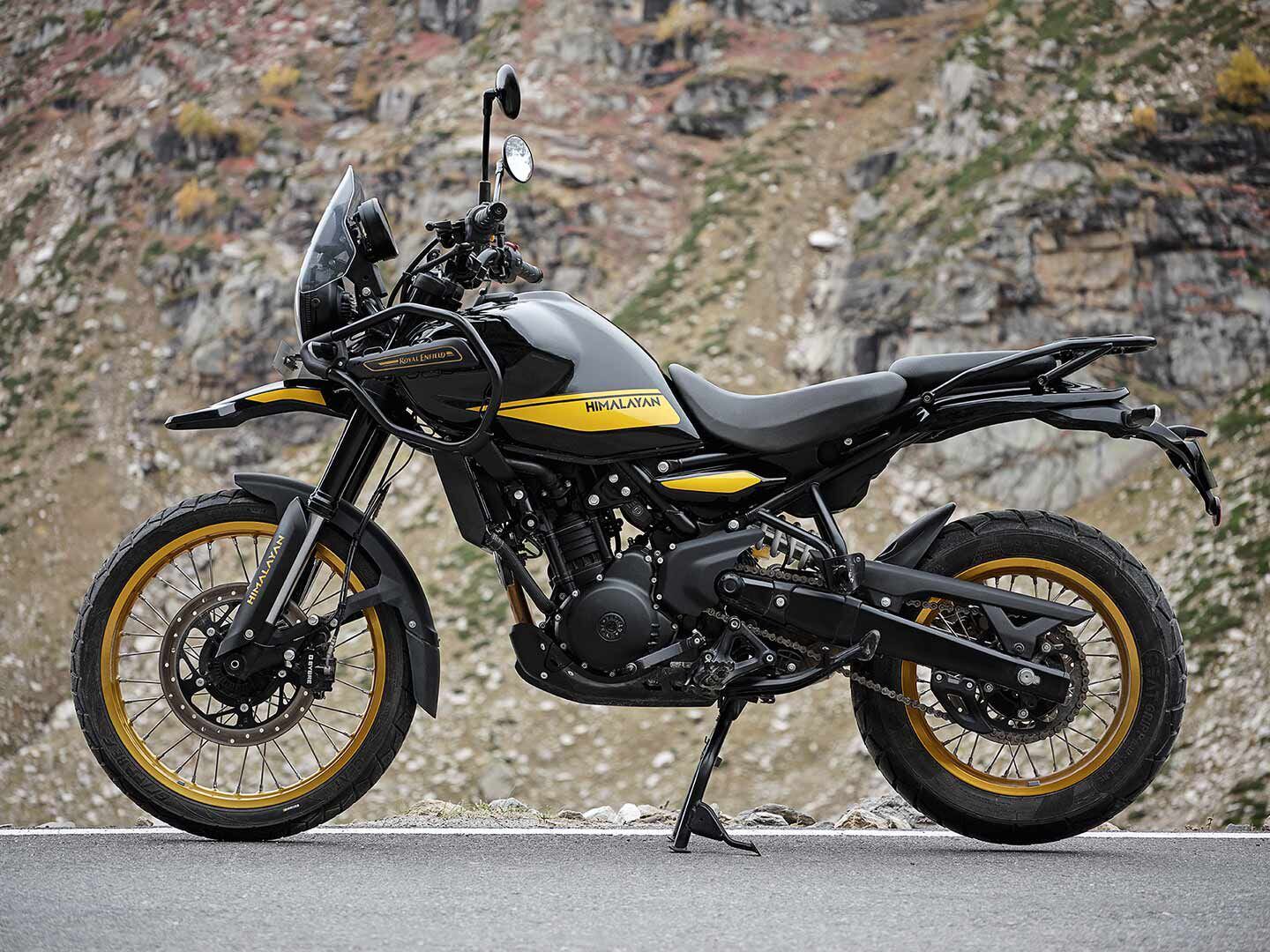
Although completely new, the 2024 Himalayan retains its rugged purpose if perhaps in a much more modern way. (Royal Enfield/)Some elements have been carried over, including the unusual luggage bars either side of the fuel tank that offer both protection to the bodywork and an extra place to strap things to, and there are plenty of options to make the Himalayan even more rugged with engine guards, a radiator protector, an under-engine bash plate and headlight guard, as well as a taller screen and aluminum hard luggage.
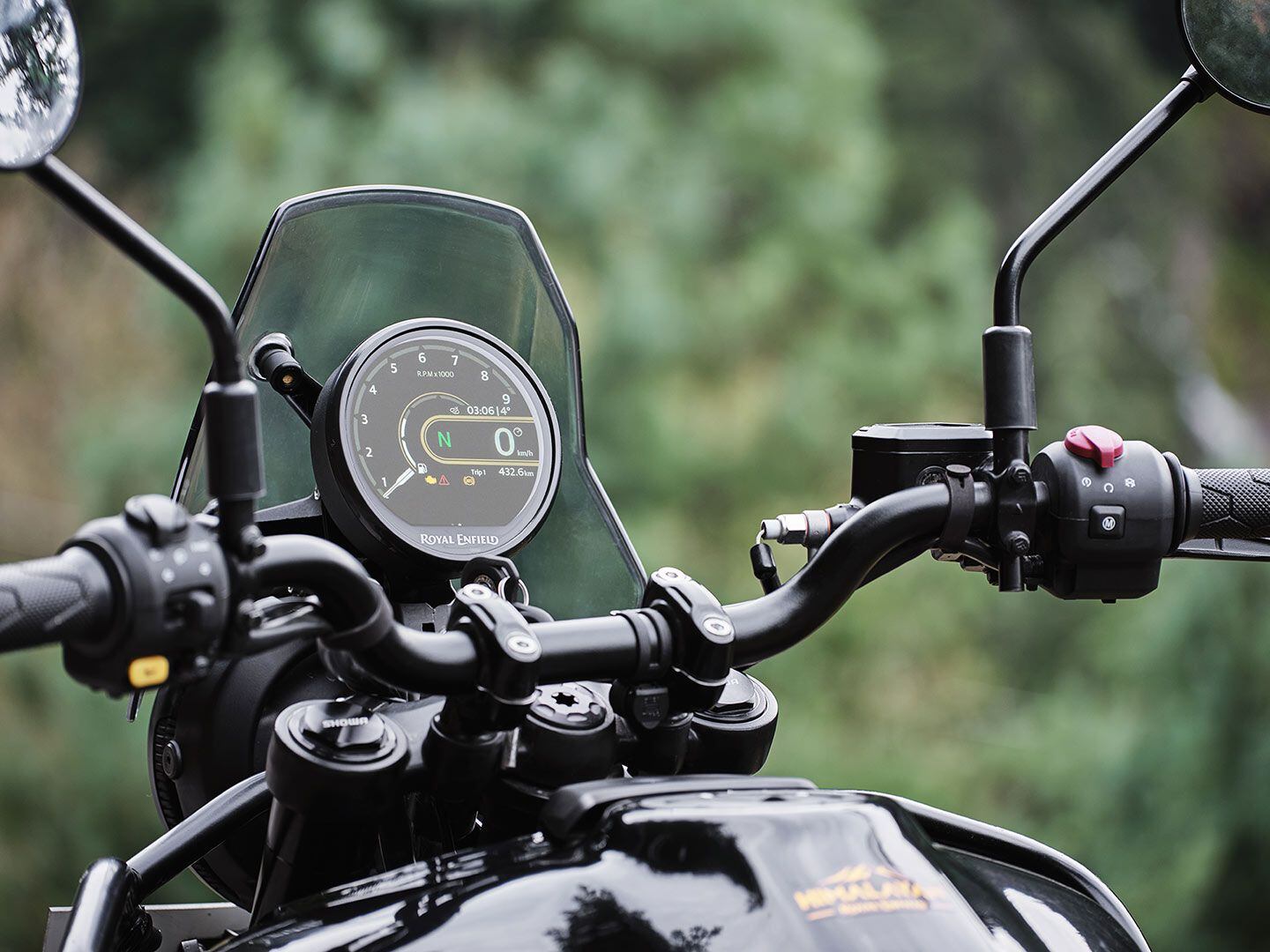
The Tripper TFT display is full color and offers smartphone connectivity, Google-powered navigation, and the interface for changing modes and settings. (Royal Enfield/)From the rider’s seat, the view ahead features a simple, circular display that’s really a full-color TFT that even incorporates phone connectivity and Google map-based navigation—more useful away from the beaten track than the turn-by-turn nav that’s more commonly found on smartphone-connected instruments. The modern tech continues with the LED headlight and joystick-controlled riding modes.
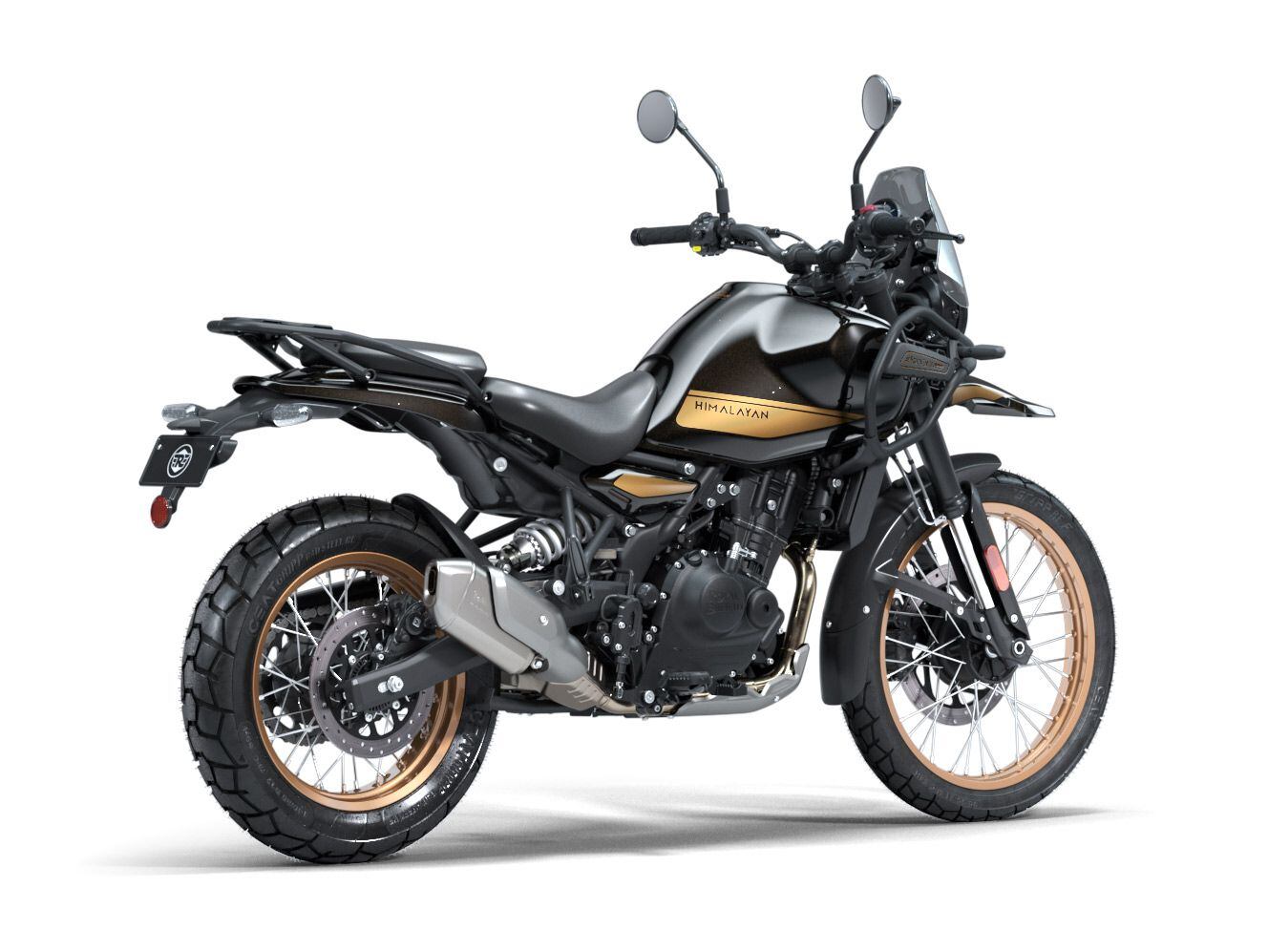
Pricing hasn’t been released on the 2024 model, but we hope it stays in a range that screams bargain. (Royal Enfield/)In a world of increasingly large, powerful, and heavy adventure bikes, the Himalayan has a recipe that seems better suited to globe-trotting adventures than most, provided your emphasis is on off-road travel rather than high-speed highway touring.
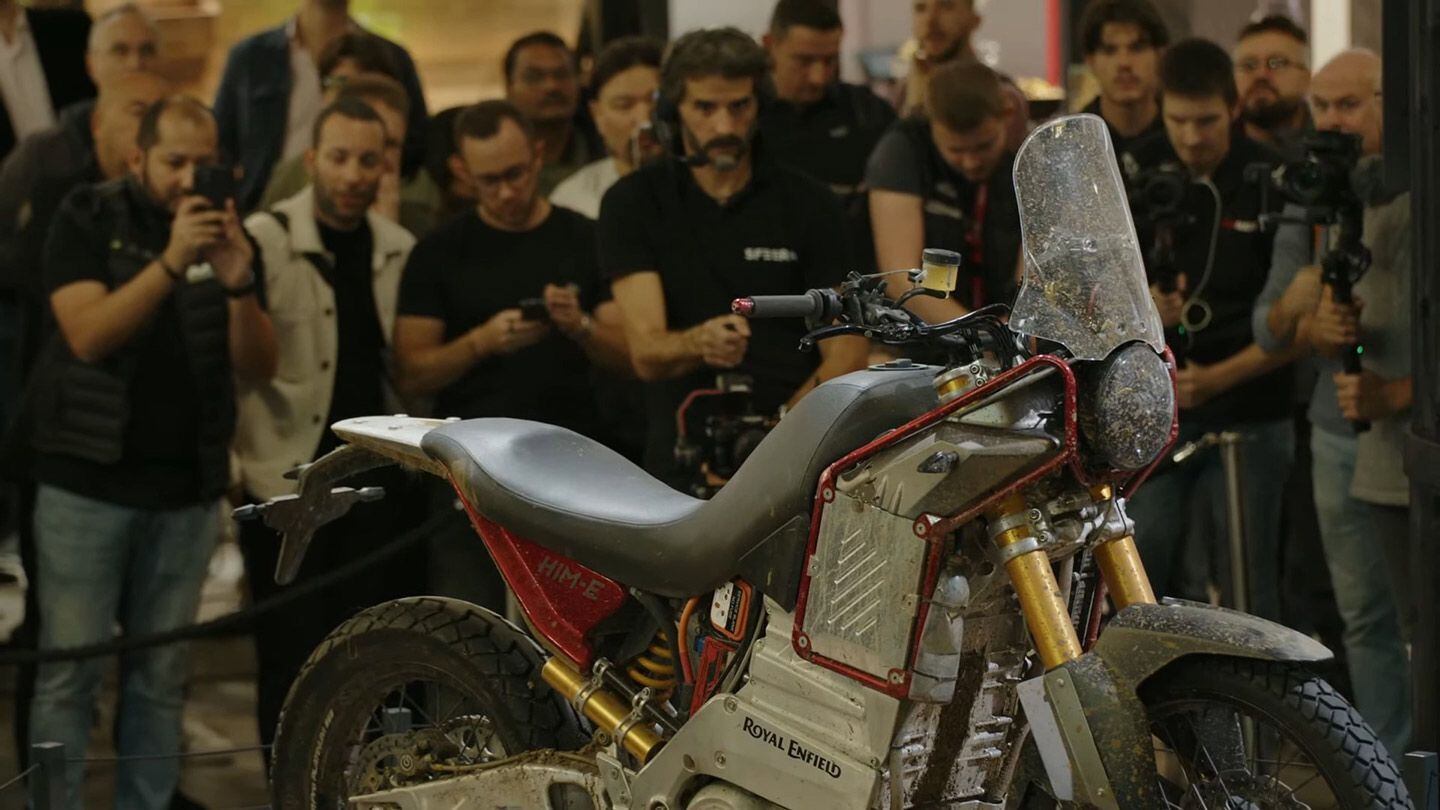
Royal Enfield also showed off its working prototype of its electric Himalayan at EICMA. (Royal Enfield/)Royal Enfield also unveiled a prototype electric version of the Himalayan at EICMA in Milan, alongside the new production model. Although still a test bed rather than a production-intended model, it’s a running machine that’s already undergoing further development as Enfield eyes a battery-powered future.
Look for our First Ride Review of the 2024 Himalayan November 10.
2024 Royal Enfield Himalayan Specs
MSRP: TBA Engine: DOHC, liquid-cooled, four-stroke single; 4 valves Displacement: 452cc Bore x Stroke: 84.0 x 81.5mm Compression Ratio: 11.5:1 Transmission/Final Drive: 6-speed/chain Claimed Horsepower: 40 hp @ 8,000 rpm Claimed Torque: 29.5 lb.-ft. @ 5,500 rpm Fuel System: Fuel injection w/ 42mm throttle body Clutch: Wet, multiplate, slipper/assist Engine Management/Ignition: Ride-by-wire/electronic Frame: Steel twin-spar tubular Front Suspension: 43mm Showa SFF inverted fork; 7.9 in. travel Rear Suspension: Showa monoshock, preload adjustable; 7.9 in. travel Front Brake: ByBre 2-piston caliper, 320mm disc w/ switchable ABS Rear Brake: ByBre 1-piston caliper, 270mm disc w/ switchable ABS Wheels, Front/Rear: 21 in./17 in. Tires, Front/Rear: 90/90-21 / 140/80-17 Rake/Trail: TBA Wheelbase: 59.4 in. Ground Clearance: 9.0 in. Seat Height: 32.5 to 33.3 in. Fuel Capacity: 4.5 gal. Claimed Wet Weight: 432 lb. Contact: royalenfield.com -
 1
1
-
-
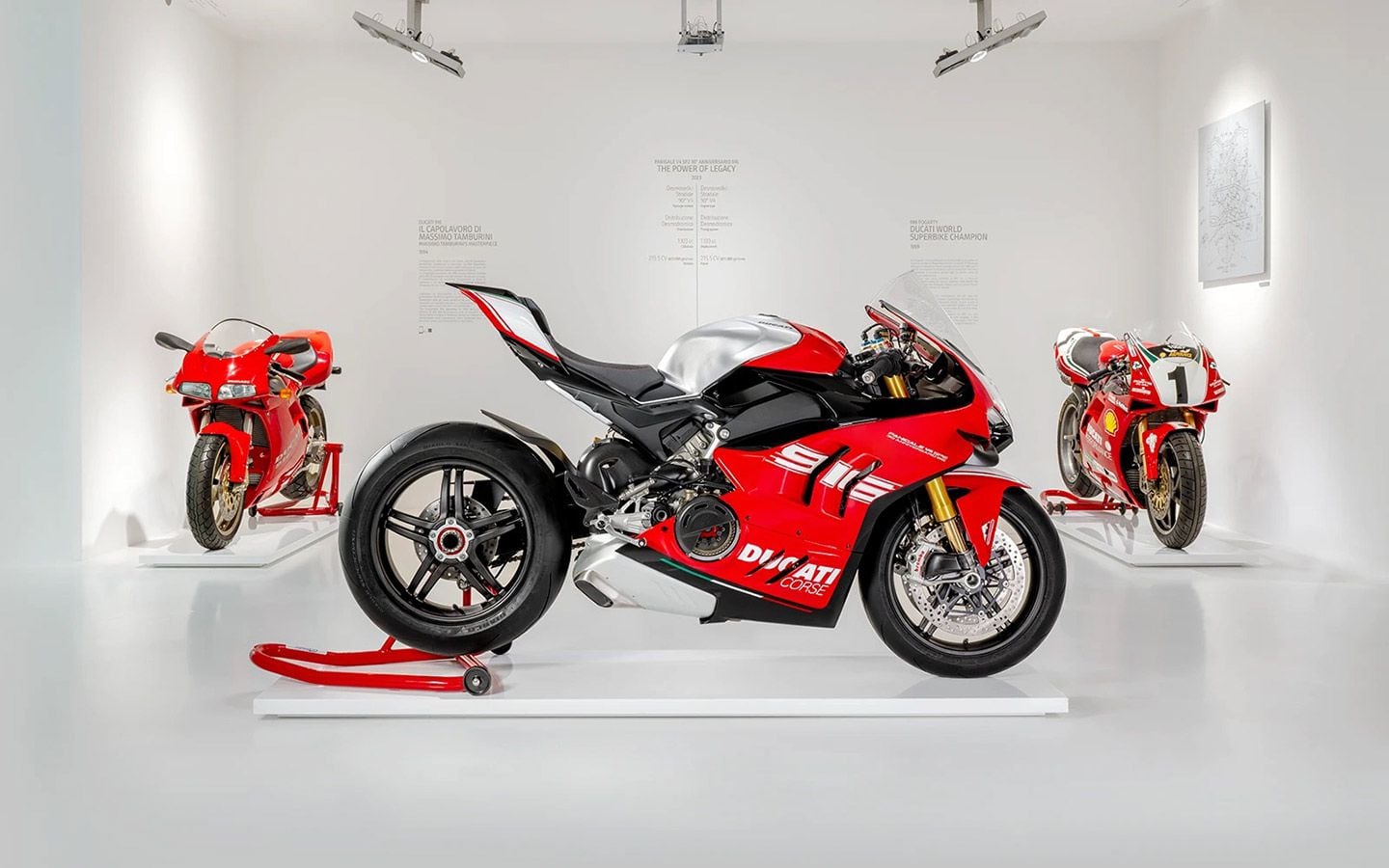
The Panigale V4 SP2 30th Anniversario 916 pays homage to the Ducati 916 and is produced in a numbered and limited series of 500 units. (Ducati/)Every legend deserves to be celebrated, and Ducati is doing that in the only way it knows how—by introducing the 2024 Panigale V4 SP2 30th Anniversario 916, which pays homage to the iconic Ducati 916 drawn up by Massimo Tamburini. Like your bikes in limited trim? Lucky for you, this bike will be produced in a numbered, limited series of 500 units.
The rest of us will simply have to drool over the special livery and long list of carbon fiber sprinkled throughout. That livery is, of course, from the bike that Carl Fogerty won the 1999 Superbike World Championship aboard. Sweet, sweet history!
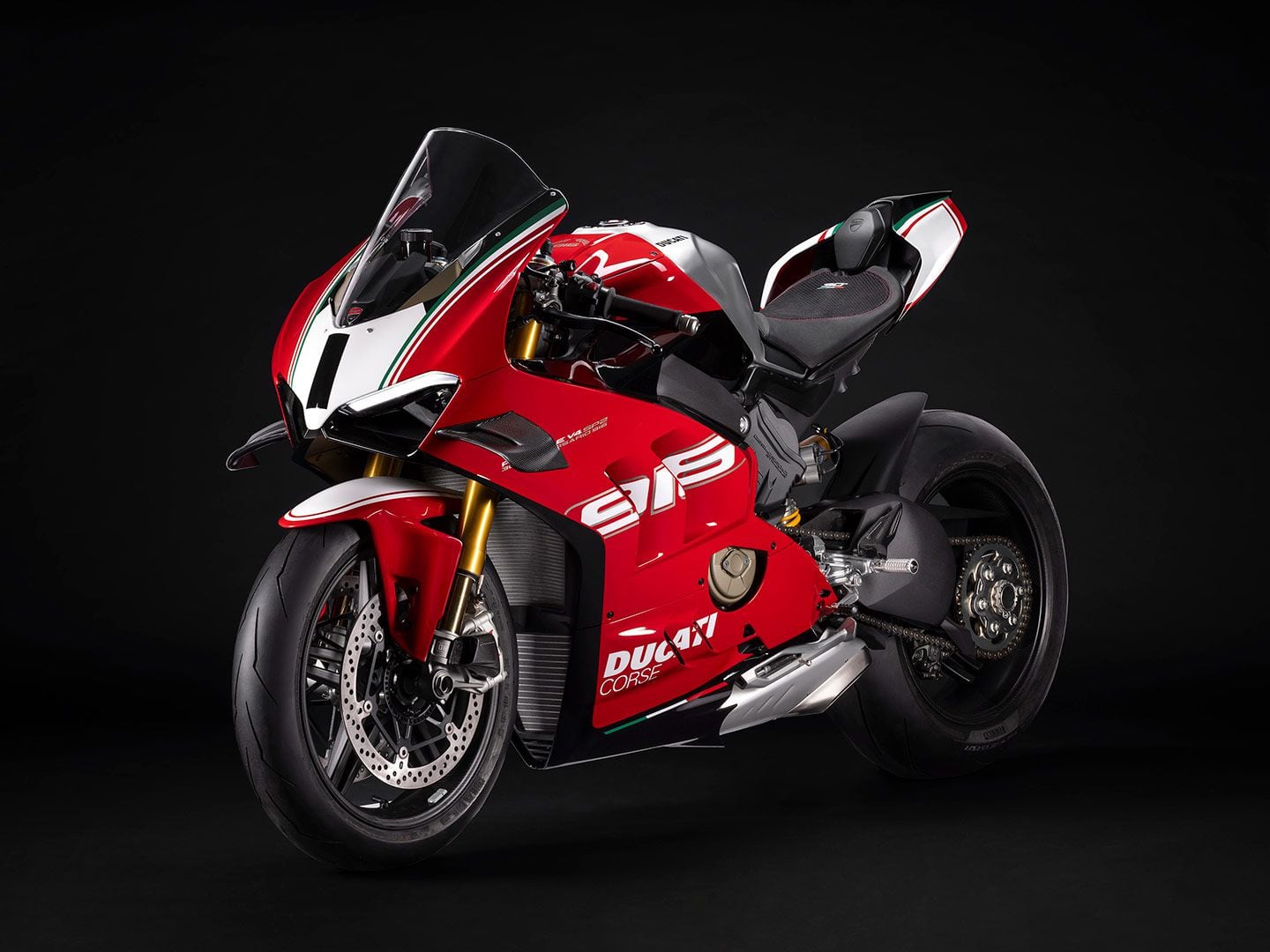
Not that anyone was complaining about the Panigale V4’s looks before, but it’s especially hard to argue with the styling on the 30th Anniversario 916 model. (Ducati/)In terms of hardware, the Anniversario 916 separates itself through the use of a billet aluminum fuel cap, front brake air ducts, an exhaust heat shield, plus carbon fiber mudguard and wings.
Five-spoked carbon fiber wheels are 3 pounds lighter than the forged Marchesinis on the V4 S and 7.5 pounds lighter than the Panigale V4 wheels, reducing inertial momentum by 26 percent at the front and 46 percent at the rear, for added agility.
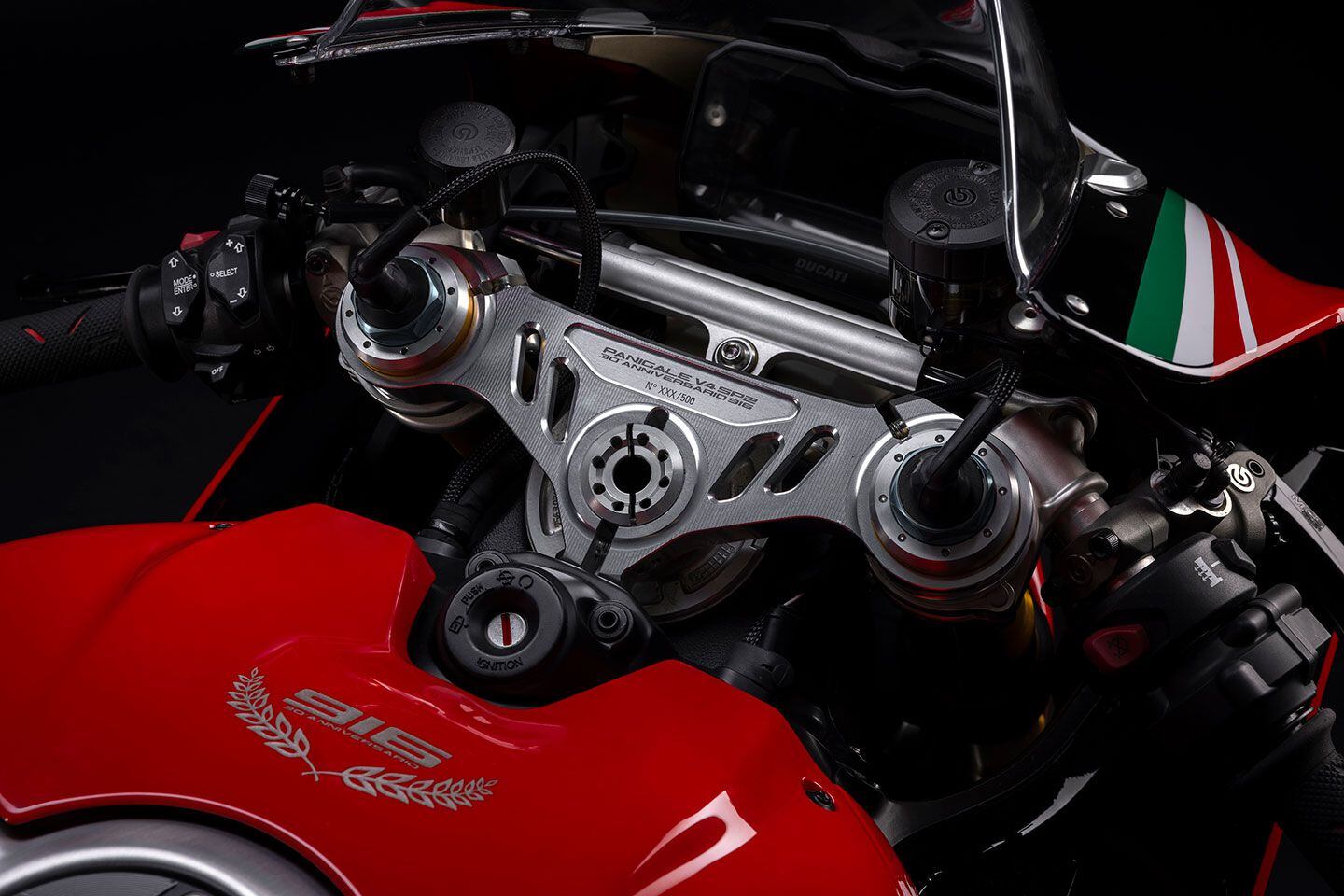
Each Panigale V4 SP2 30th Anniversario 916 is numbered, with production number engraved on the steering plate. The bike will also come with a certificate of authenticity and a dedicated motorcycle cover. (Ducati/)Braking package is equally as impressive, the Anniversario 916 coming standard with Brembo Stylema R calipers and the aforementioned cooling ducts, as well as a Brembo MCS master cylinder with remote adjuster. An STM EVO dry clutch offers classic Ducati sounds.
Below is a closer look at the Panigale V4 SP2 30th Anniversario 916 equipment list.
- “30th Anniversario” commemorative livery
- Headstock machined from billet with model name and bike number (XXX/500)
- Brushed aluminum tank
- Dedicated seat with “30th” logo
- Carbon fiber wings
- Carbon fiber front mudguard
- Carbon fiber brake caliper scoops
- Carbon fiber exhaust heat shield
- Five-spoke split carbon fiber wheels
- STM EVO-SBK dry clutch
- Final drive with 520mm chain, specific sprocket, and pinion
- Brembo Stylema R front brake calipers
- Brembo MCS 19.21 (Multiple Click System) front brake master cylinder with remote adjuster
- Front brake and clutch levers milled at the ends
- Billet aluminum adjustable rider footpegs with carbon heel guards
- Single-seat configuration
- Ducati Data Analyzer+ (DDA+) kit with GPS module (included)
- Carbon fiber open clutch cover (supplied)
- License plate removal cover (supplied)
- Billet aluminum mirror hole cover (supplied)
- Billet aluminum fuel filler cap (included)
- Certificate of authenticity and dedicated motorbike cover
The Panigale V4 SP2 30th Anniversario 916 will be available starting from March 2024, with an MSRP of $45,995.
2024 Ducati Panigale V4 SP2 30th Anniversario 916 Claimed Specs
MSRP: $45,995 Engine: Desmosedici Stradale 90-degree, liquid-cooled desmodromic V-4; 16 valves Displacement: 1,103cc Bore x Stroke: 81.0 x 53.5mm Compression Ratio: 14.0:1 Transmission/Final Drive: 6-speed/chain Claimed Horsepower: 210 hp @ 12,500 rpm Claimed Torque: 90.6 lb.-ft. @ 11,000 rpm Fuel System: Electronic fuel injection, 52MM elliptical throttle bodies Clutch: STM EVO dry, multiplate slipper; hydraulic actuation Engine Management/Ignition: Ride-by-wire Frame: Aluminum Front Suspension: 43mm Öhlins NPX 25/30 semi-active fork; fully adjustable; 4.9 in. travel Rear Suspension: Öhlins TTX 36 semi-active shock; fully adjustable; 5.1 in. travel Front Brake: 4-piston Brembo Stylema R calipers, dual 330mm semi-floating discs (w/ Cornering ABS Evo) Rear Brake: 2-piston caliper, 245mm disc (w/ Cornering ABS Evo) Wheels, Front/Rear: 5-spoke carbon fiber; 17 x 3.50 in. / 17 x 6.00 in. Tires, Front/Rear: Pirelli Diablo Supercorsa SP; 120/70-17 / 200/60-17 Rake/Trail: 24.5º/3.9 in. Wheelbase: 57.8 in. Ground Clearance: N/A Seat Height: 33.5 in. Fuel Capacity: 4.5 gal. Claimed Dry Weight: 381 lb. Contact: ducati.com 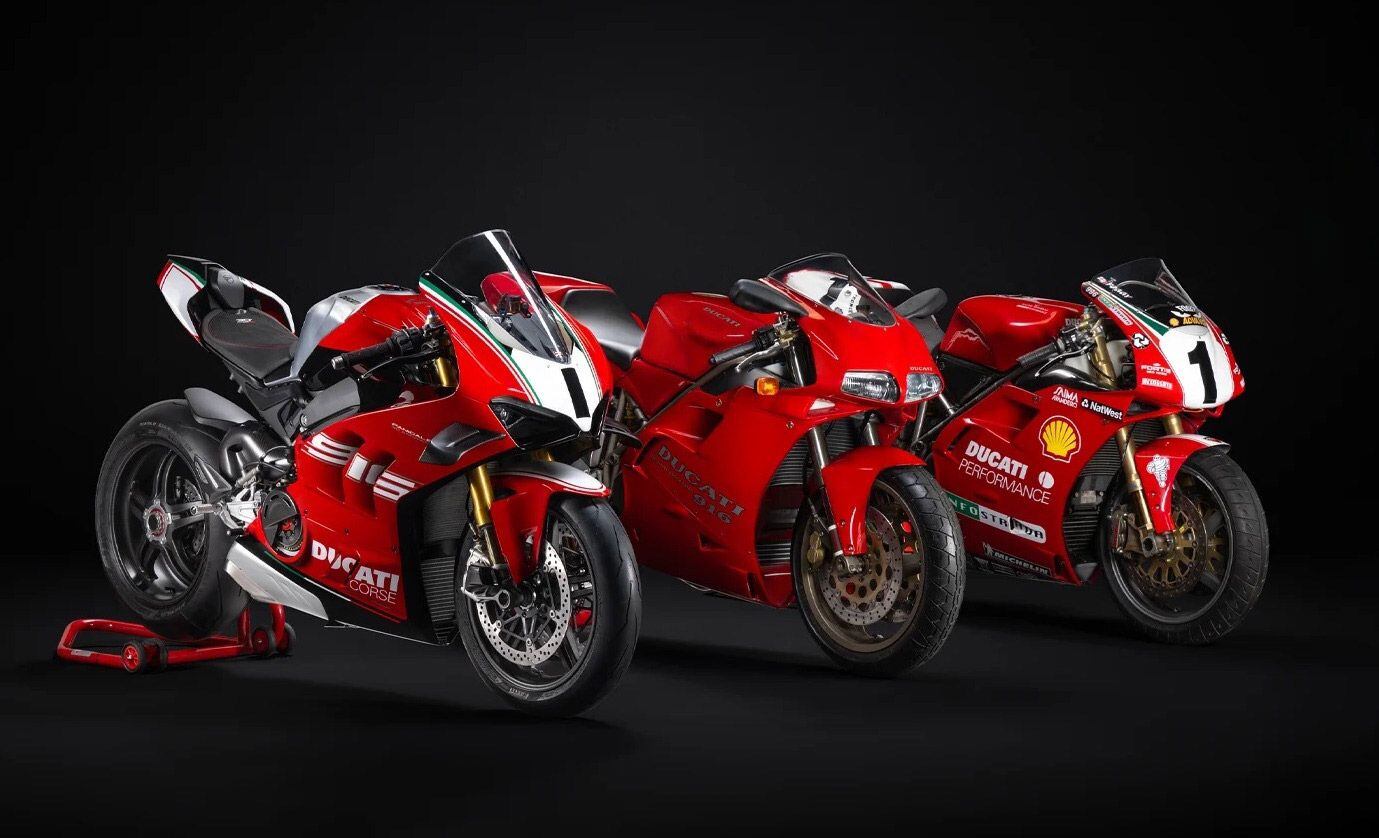
The 2024 Ducati Panigale V4 SP2 30th Anniversario 916 alongside the 916 and Foggy’s race bike. (Ducati/)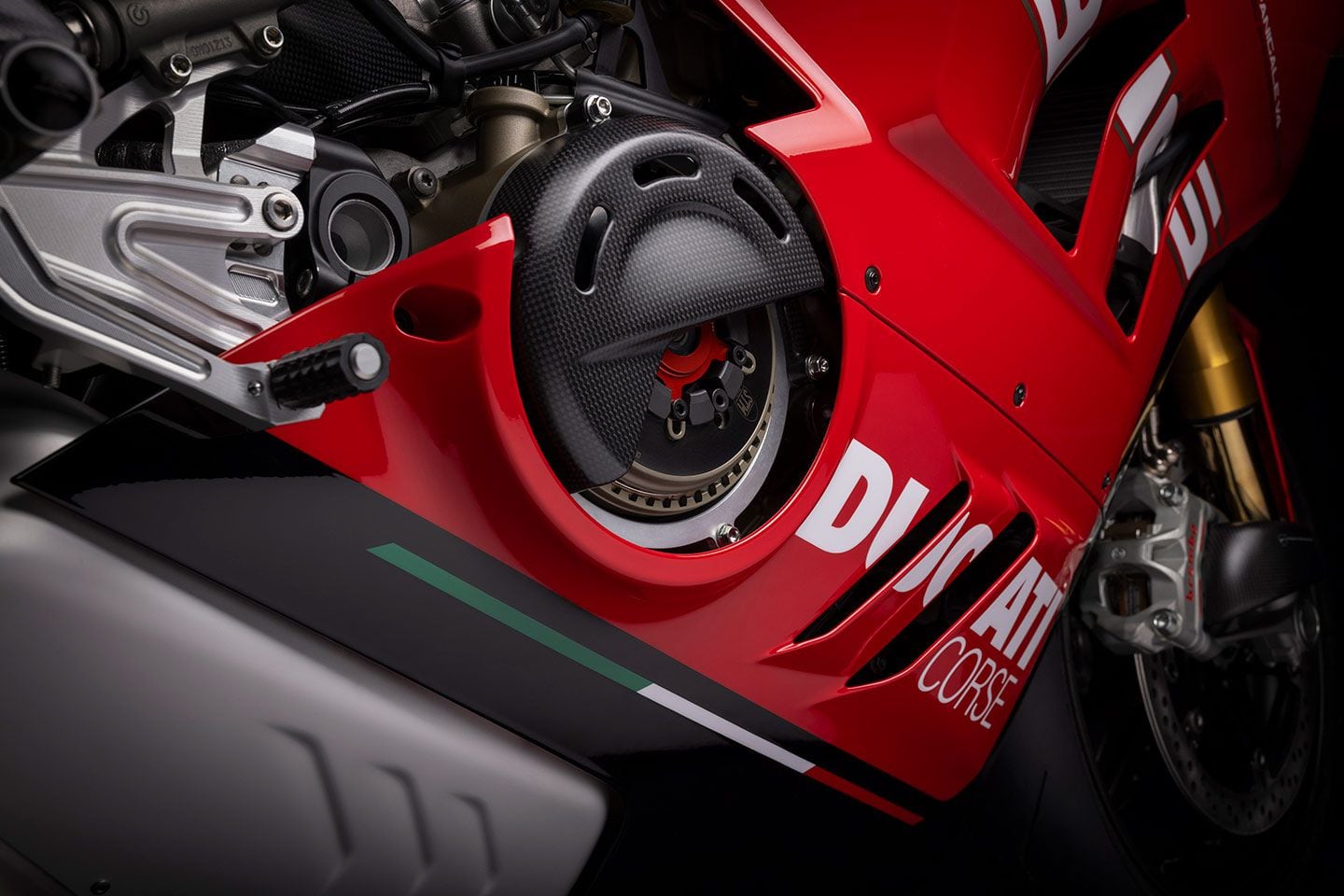
2024 Ducati Panigale V4 SP2 30th Anniversario 916 STM EVO-SBK Dry Clutch. (Ducati/)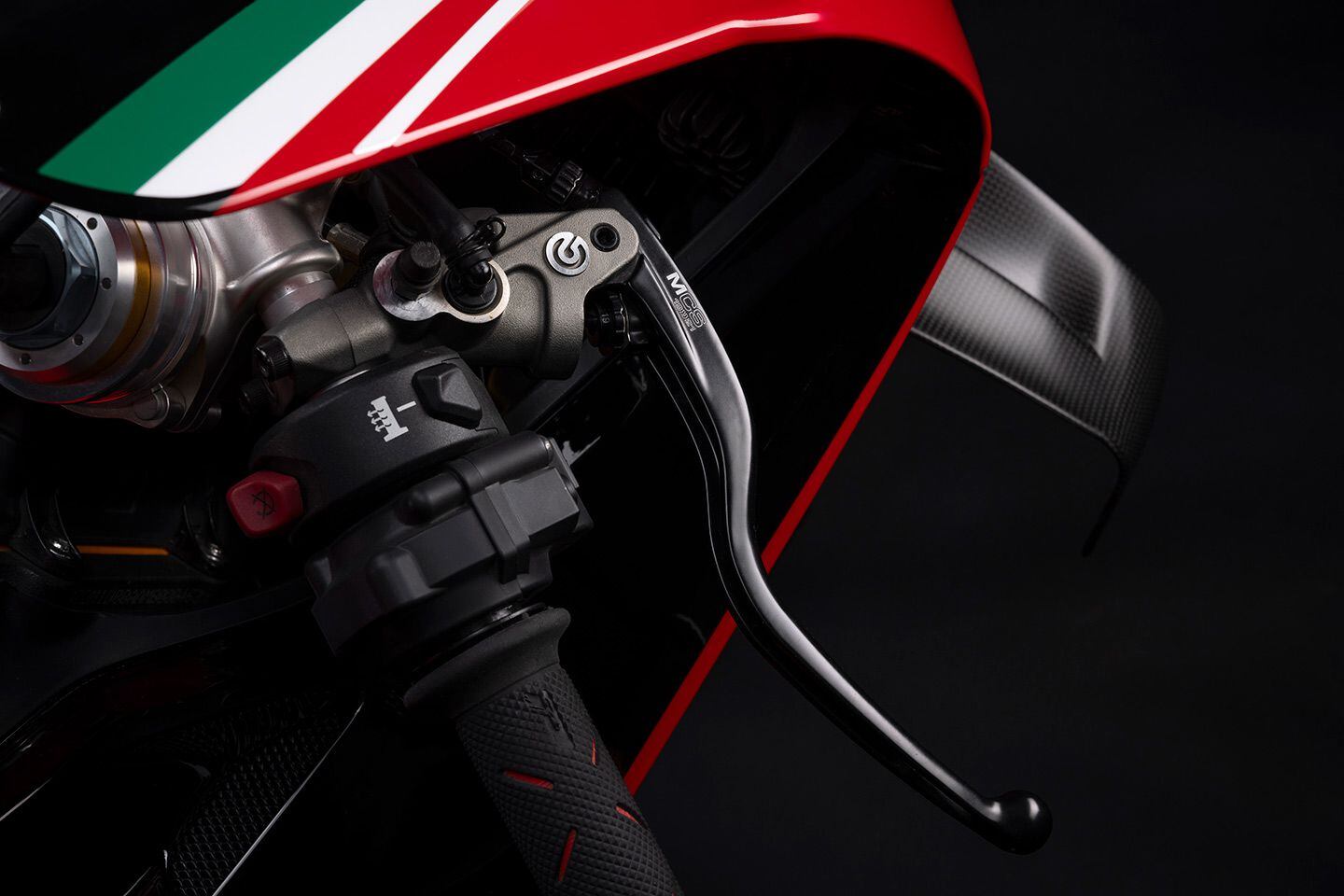
The 2024 Ducati Panigale V4 SP2 30th Anniversario 916 has a Brembo MCS master cylinder. (Ducati/)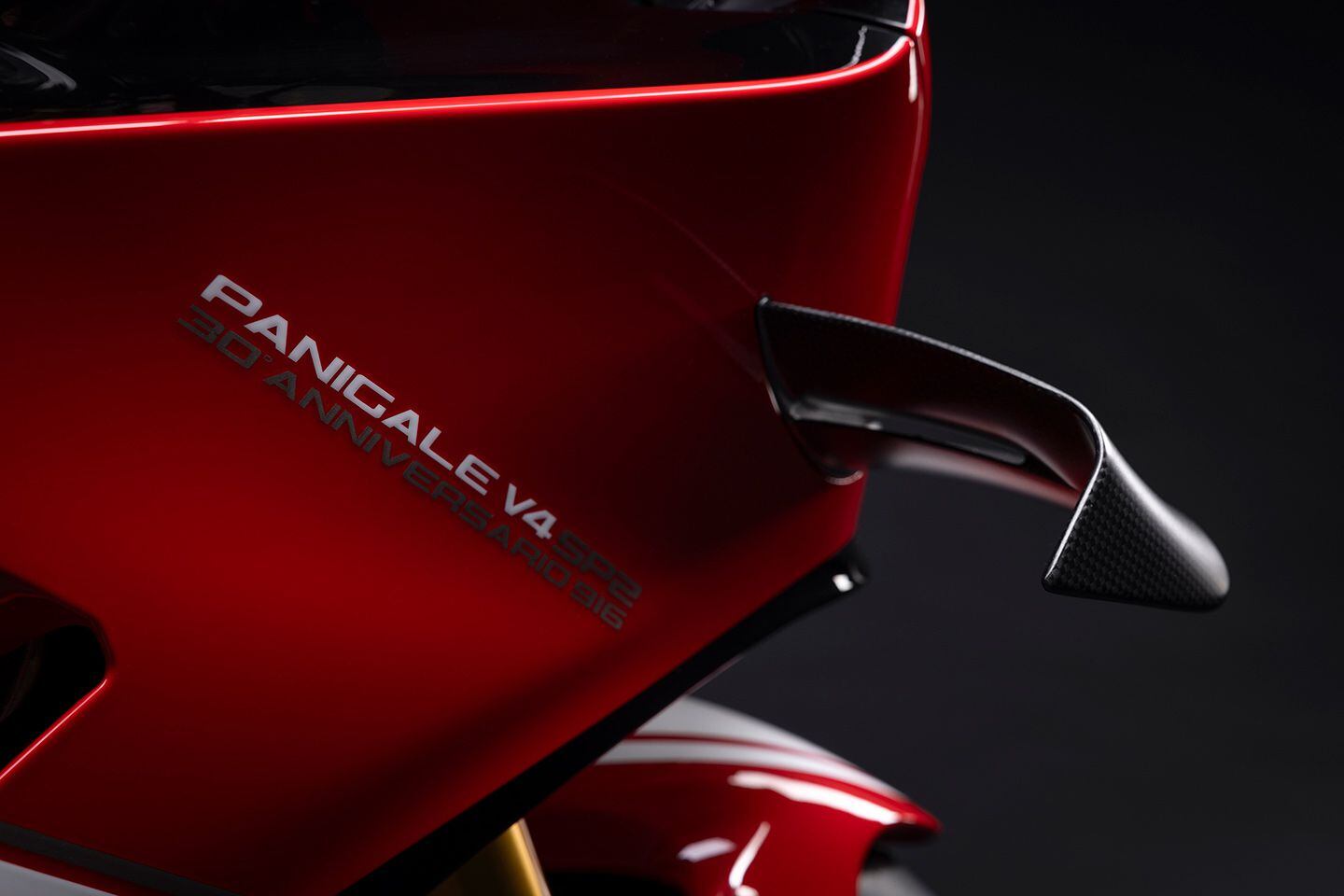
The 2024 Ducati Panigale V4 SP2 30th Anniversario 916 builds on the already impressive SP2. (Ducati/)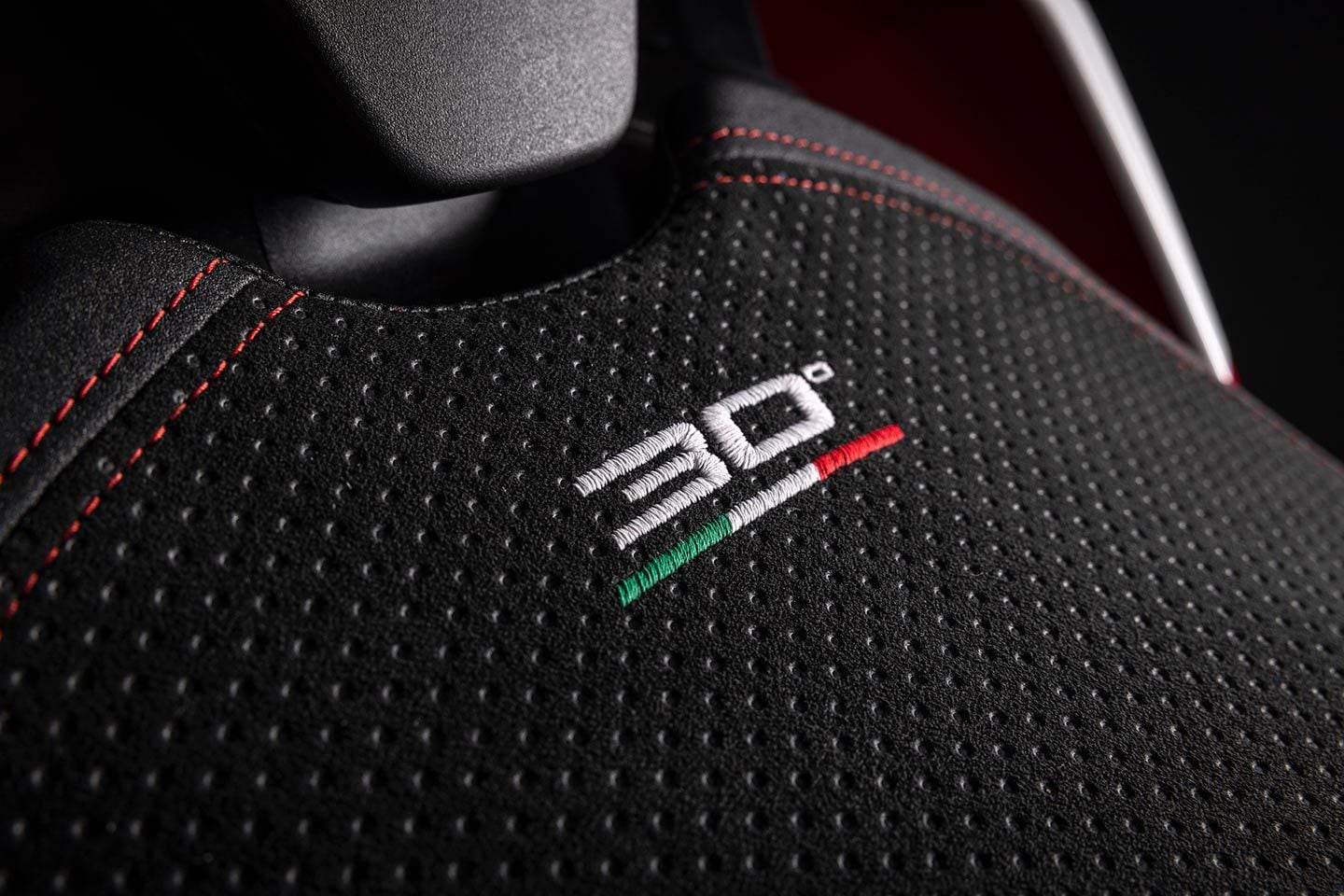
2024 Ducati Panigale V4 SP2 30th Anniversario 916’s embroidered seat. (Ducati/)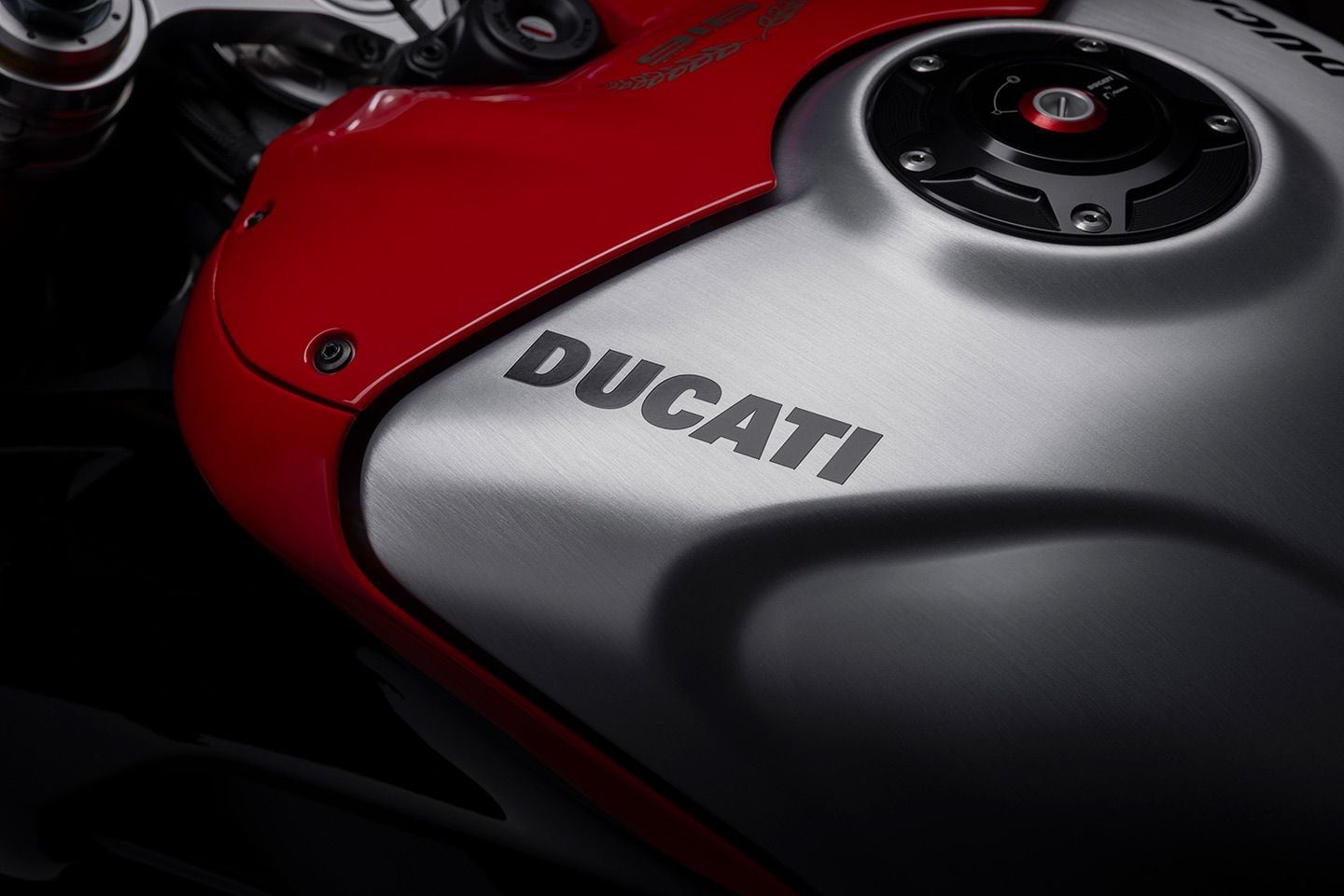
2024 Ducati Panigale V4 SP2 30th Anniversario 916’s billet gas cap. (Ducati/) -
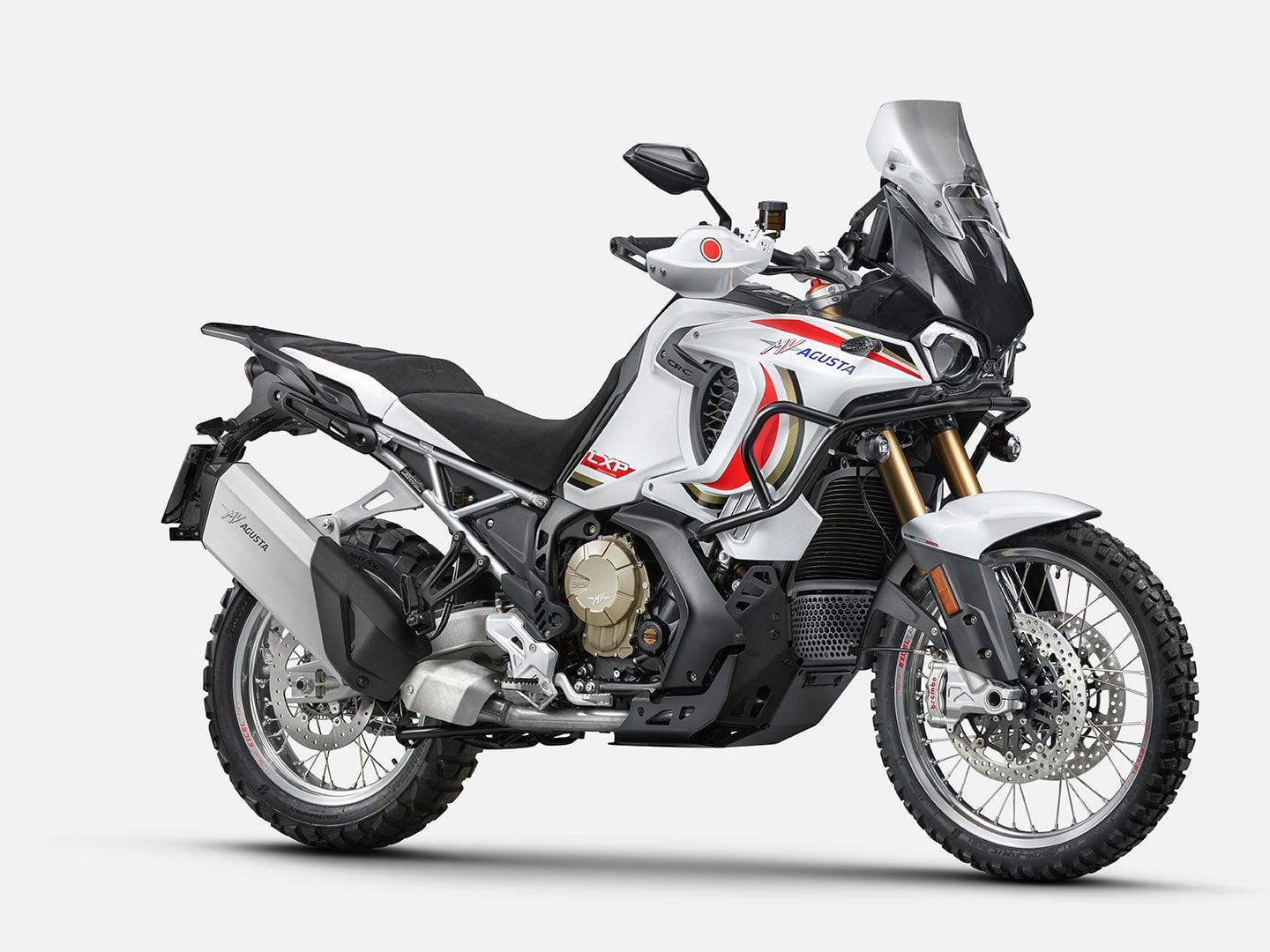
MV Agusta’s LXP Orioli is powered by a 931cc triple. (MV Agusta/)MV Agusta’s LXP Orioli adventure-touring class finally surfaced in its final form at EICMA 2023. The whole project has been vastly revised since KTM took control of the historical Varese, Italy-based make. Gone is the Lucky Explorer name reminiscent of the Cagiva Elefant that challenged the Paris-Dakar, replaced with a name that recognizes Italian rally champ Edi Orioli. And, in line with KTM’s new plans for MV Agusta, the 5.5 version powered by a twin-cylinder engine derived from the Benelli 502 has been scrapped.
The new LXP Orioli is powered by the latest MV Agusta triple, a liquid-cooled 931cc DOHC engine designed and developed by Chief Project Engineer Brian Gillen. This 81mm bore and 60.2mm stroke has been fully refined to Euro 5+ emission standards and now delivers 124 hp at 10,000 rpm with 75.2 lb.-ft. of peak torque at 7,000 rpm. Numbers that confirm this new MV Agusta three is both powerful and flexible, perfect at home on an upper-class adventure model.
Electronics informed by an advanced six-axis inertial platform that interfaces with the ECU to ensure performance and safety with four dedicated riding modes: Urban, Touring, Off-Road, and Custom All Terrain. Traction control comes in five levels: two street, two specifically for off-road, and one for rain. Engine-braking action is selectable over two levels. Cornering ABS has been specifically tuned to apply proper braking control both with road and knobby tires, and the system includes a Rear Wheel Lift-up Mitigation function.
Related: New MV Agusta Range Revealed
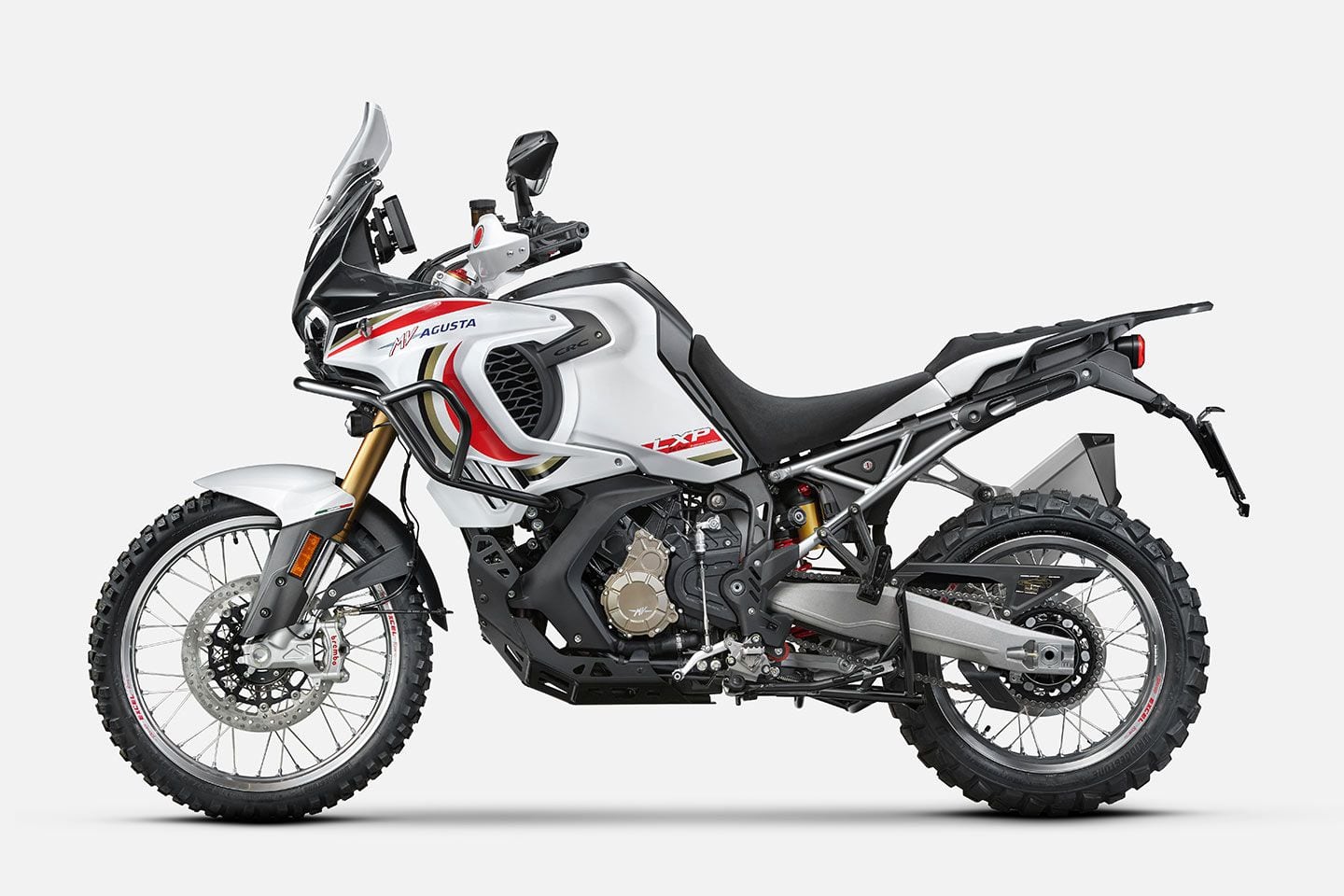
Hints of the now discarded Lucky Explorer name are still seen in the LXP Orioli’s graphics. (MV Agusta/)Infotainment and Bluetooth functions are controlled via a 7-inch TFT dash. MV Agusta’s Ride App offers a navigation system and a Mobisat geolocation anti-theft system. Cruise control is standard.
An upper steel-tubing trellis frame integrates a full double-cradle lower section, and chassis components are top-quality by Sachs. A 48mm fork and a link-actuated gas-charged rear shock absorber are both fully adjustable and offer 8.3 inches (210mm) of wheel travel at both ends. Wheelbase is a longish 63.4 inches and steering geometry is an undisclosed rake that uses a 4.6-inch trail. Seat height is adjustable between 34.3 and 33.5 inches while ground clearance is a more than adequate 9.1 inches.
Braking is handled by four-piston Brembo Stylema calipers matched to twin 320mm rotors. At the rear, a 245mm disc is squeezed by a twin-piston caliper.

Only 500 examples of the LXP Orioli will be available. (MV Agusta/)Right now, the mighty MV Agusta LXP Orioli is planned for a 500-unit limited production run. Pricing is TBA.
2024 MV Agusta LXP Orioli Specs
MSRP: TBA Engine: DOHC, liquid-cooled triple; 4 valves/cyl. Displacement: 931cc Bore x Stroke: 81 x 60.2mm Compression Ratio: 13.4:1 Transmission/Final Drive: 6-speed/chain Claimed Horsepower: 124 hp @ 10,000 rpm Claimed Torque: 75.2 lb.-ft. @ 7,000 rpm Fuel System: Fuel injection w/ 47mm Mikuni throttle bodies, ride-by-wire Clutch: Wet, multiplate; hydraulic actuation Frame: High-tensile steel double cradle Front Suspension: 48mm Sachs USD fork, fully adjustable; 8.3 in travel Rear Suspension: Sachs monoshock, fully adjustable; 8.3 in. travel Front Brake: Brembo 4-piston Stylema calipers, dual 320mm discs w/ ABS Rear Brake: 2-piston caliper, 245mm disc w/ ABS Wheels, Front/Rear: Spoked, tubeless; 21 x 2.15 in. / 18 x 4.0 in. Tires, Front/Rear: 90/90-21 / 150/70-18 Rake/Trail: TBA/4.6 in. Wheelbase: 63.4 in. Ground Clearance: 9.1 in. Seat Height: 33.5/34.3 in. Fuel Capacity: 5.3 gal. Claimed Dry Weight: 485 lb. Contact: mvagusta.com -
 1
1
-
-
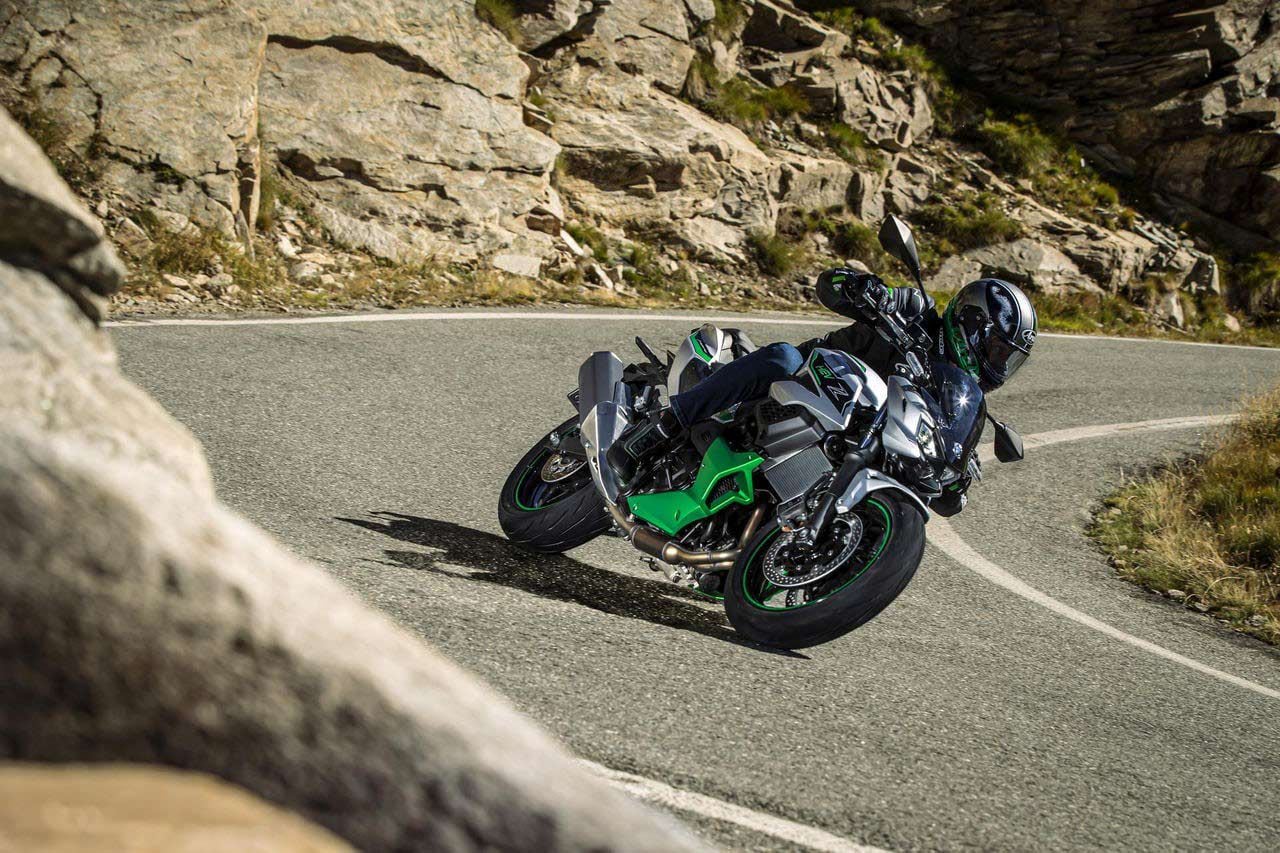
The 2024 Kawasaki Z7 Hybrid is a naked version of the brand-new Ninja 7 Hybrid. (Kawasaki/)With the Ninja 7 Hybrid revealed earlier this year, Kawasaki introduced the world’s first production “strong hybrid” motorcycle—in other words a bike that can run purely on electric or gasoline power as well as combining the two. Now there’s a second one in the range in the form of the Z7 Hybrid.
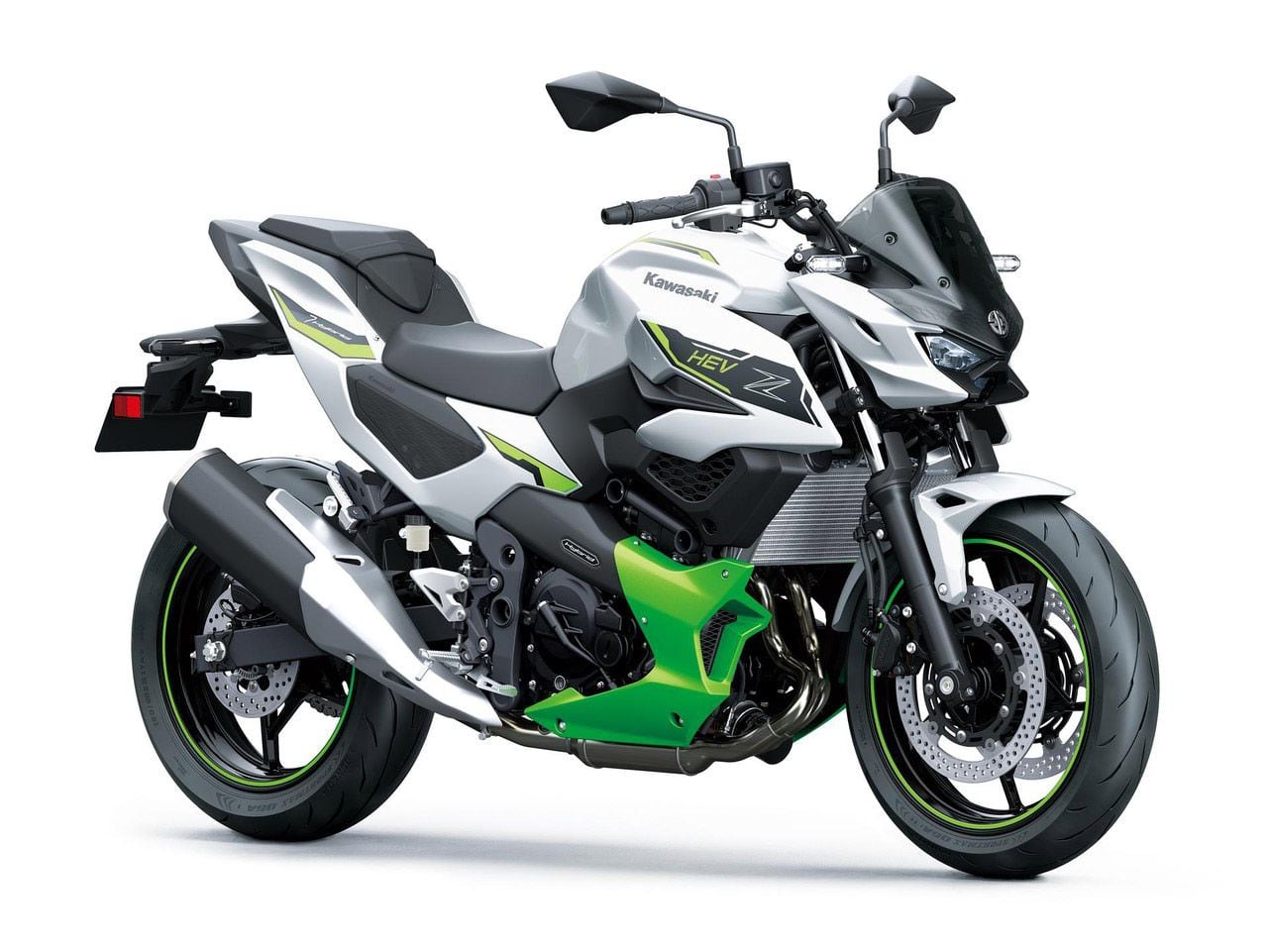
The Z7 Hybrid uses the same powertrain and chassis as the Ninja 7. (Kawasaki/)Anyone with an eye on Kawasaki’s modus operandi around its Ninja and Z model ranges probably won’t be surprised. The strategy of stripping the fairing away from cowled Ninja models to create roadster-style Z versions is a long-established one, and the Z7 Hybrid is exactly that—a Ninja 7 Hybrid with the fairing removed.
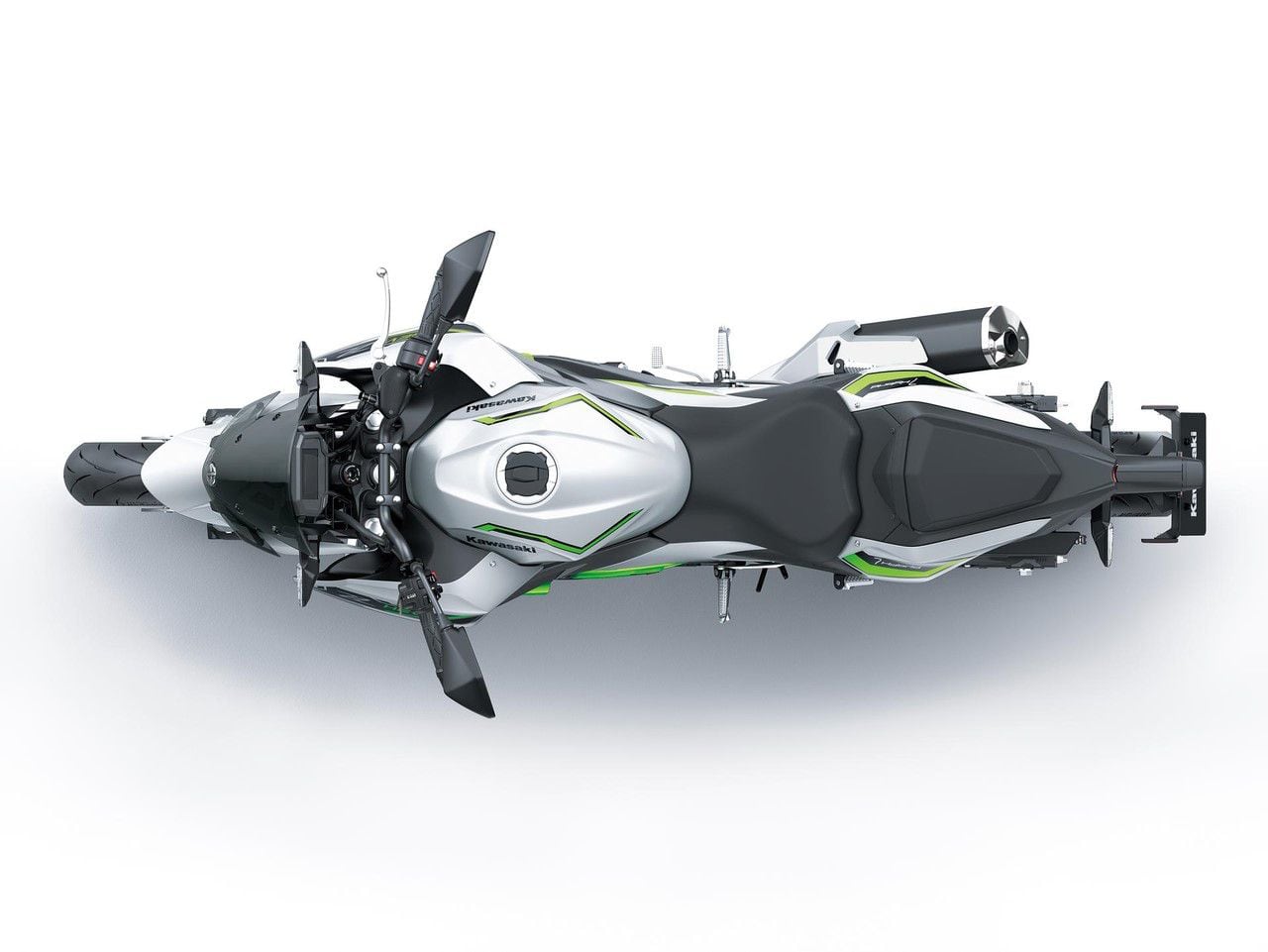
A view of the Z7’s cockpit. (Kawasaki/)In fact, not even that much of the fairing is gone. The bellypan from the Ninja 7 Hybrid is retained for the Z7 Hybrid, and there’s still a windshield, so the changes revolve mainly around the nose and side panels, which are less extensive than those on the Ninja version. Although the Ninja 7 already has a relatively upright riding position and tall bars, those on the Z7 Hybrid are higher still, even if the footpeg positions aren’t changed.
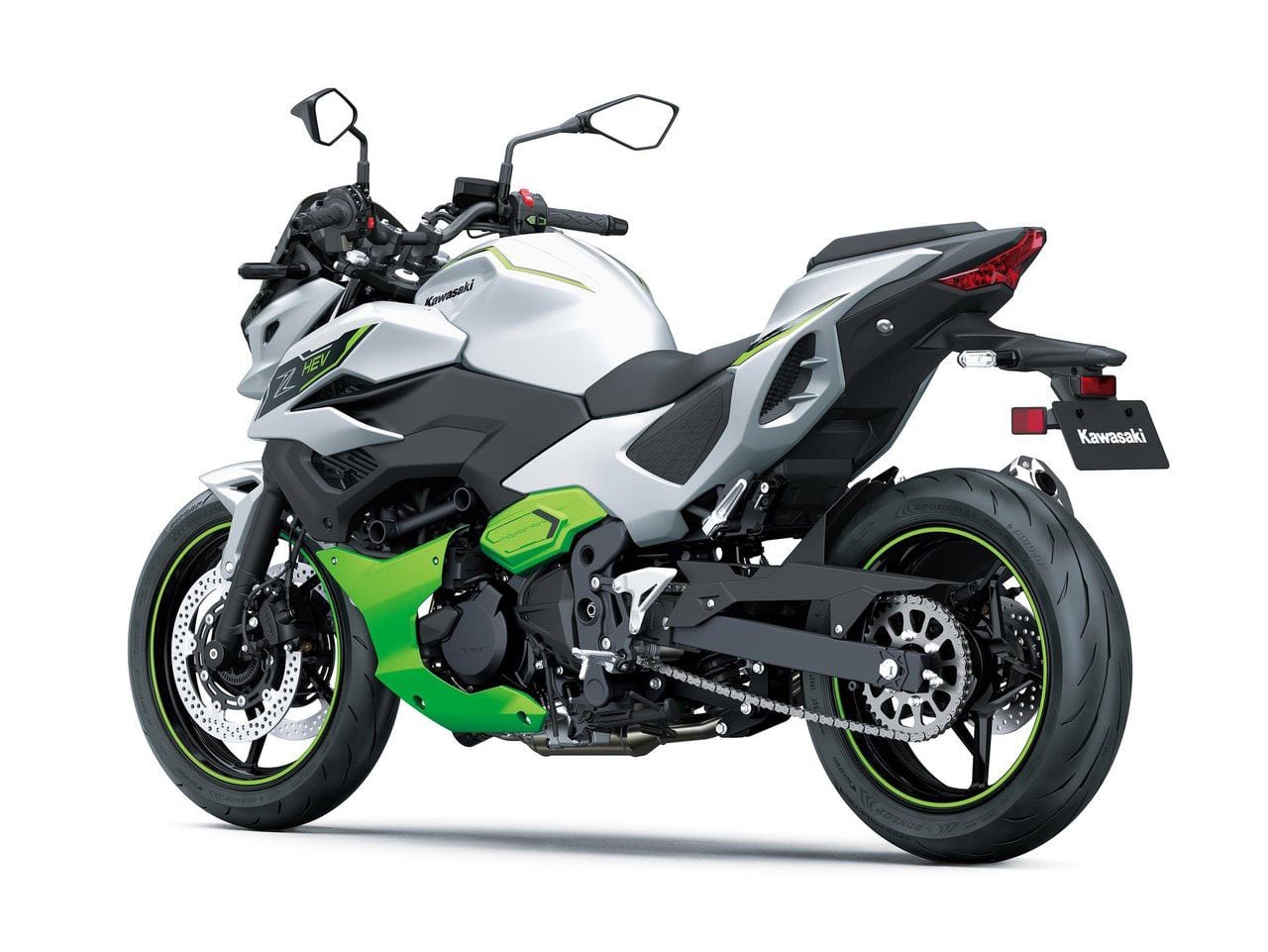
The rear end of the Z7 Hybrid is identical to that of its stablemate, the Ninja 7 Hybrid. (Kawasaki/)The entire rear end, and all the mechanical parts, are carried over from the Ninja to the Z. That means a steel-trellis frame is hidden under all that plastic, wrapped around the 451cc parallel-twin engine that first appeared in the Eliminator. In the Z7 Hybrid, like the Ninja 7 Hybrid, that engine is bolted to an electric motor/generator that can be operated either on its own or along with the gas engine for a combined peak power of 68.5 hp, while the engine on its own is good for 58 hp at 10,500 rpm.
The two are combined via an innovative automated manual transmission—essentially a conventional six-speed unit that replaces the mechanical foot shifter with push-buttons on the bar. There’s no clutch lever or conventional foot shift, and the system can operate either in manual mode, letting you select the ratios, or in a fully auto setting.
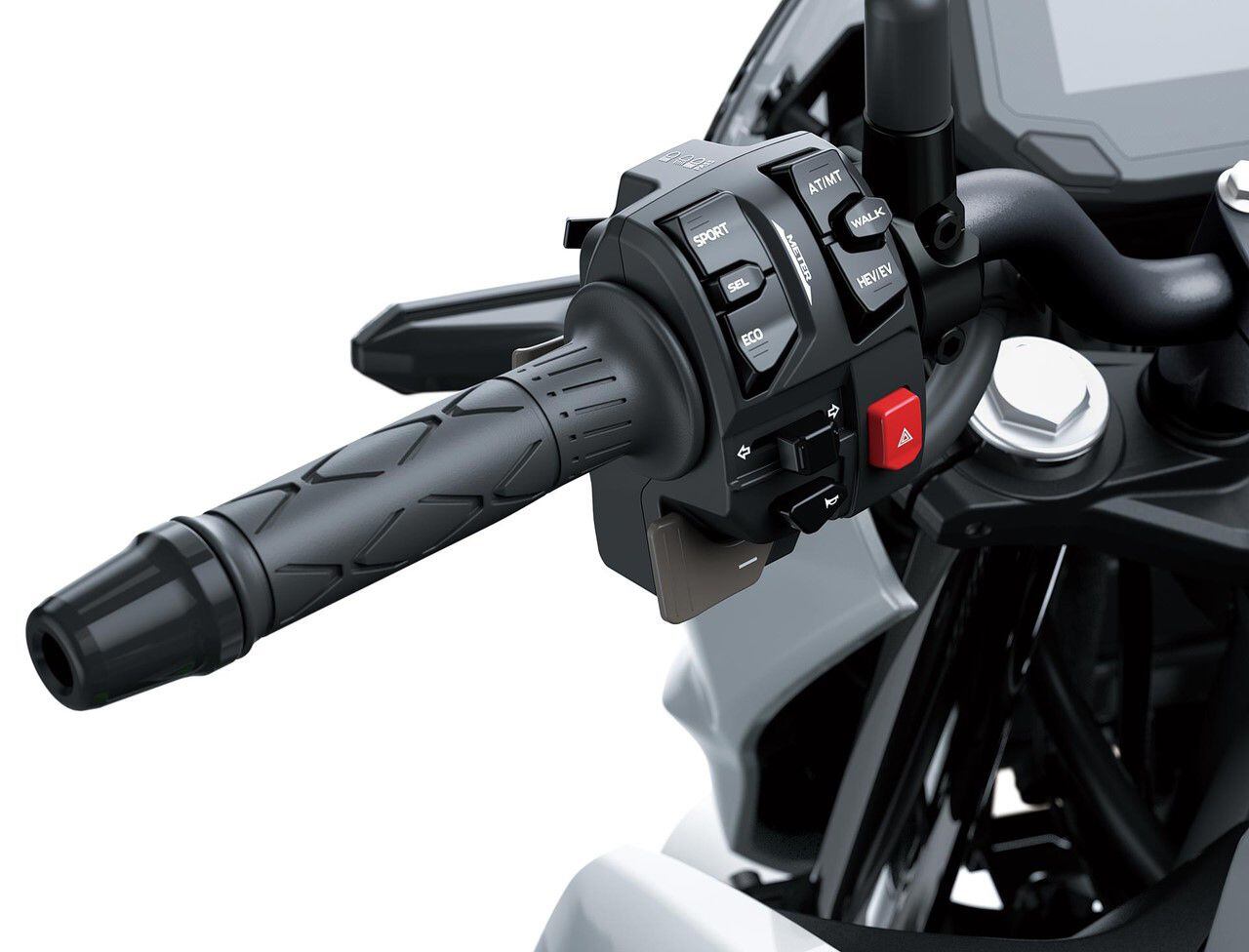
The Z7 uses an automated manual transmission with push-button control and a full-automatic mode. (Kawasaki/)Like the Ninja 7 Hybrid, the Z7 Hybrid can manage a few miles purely on electric power, albeit at low speed, but will spend most of its time using both powertrains in harmony, either in Sport or Eco modes. The latter includes an idle-stop system and uses the electric motor to pull away before adding thrust from the ICE. There’s also the “e-boost” function, available in Sport mode, that combines the output of both powertrains for that 68.5 hp peak, albeit only for brief periods up to five seconds.
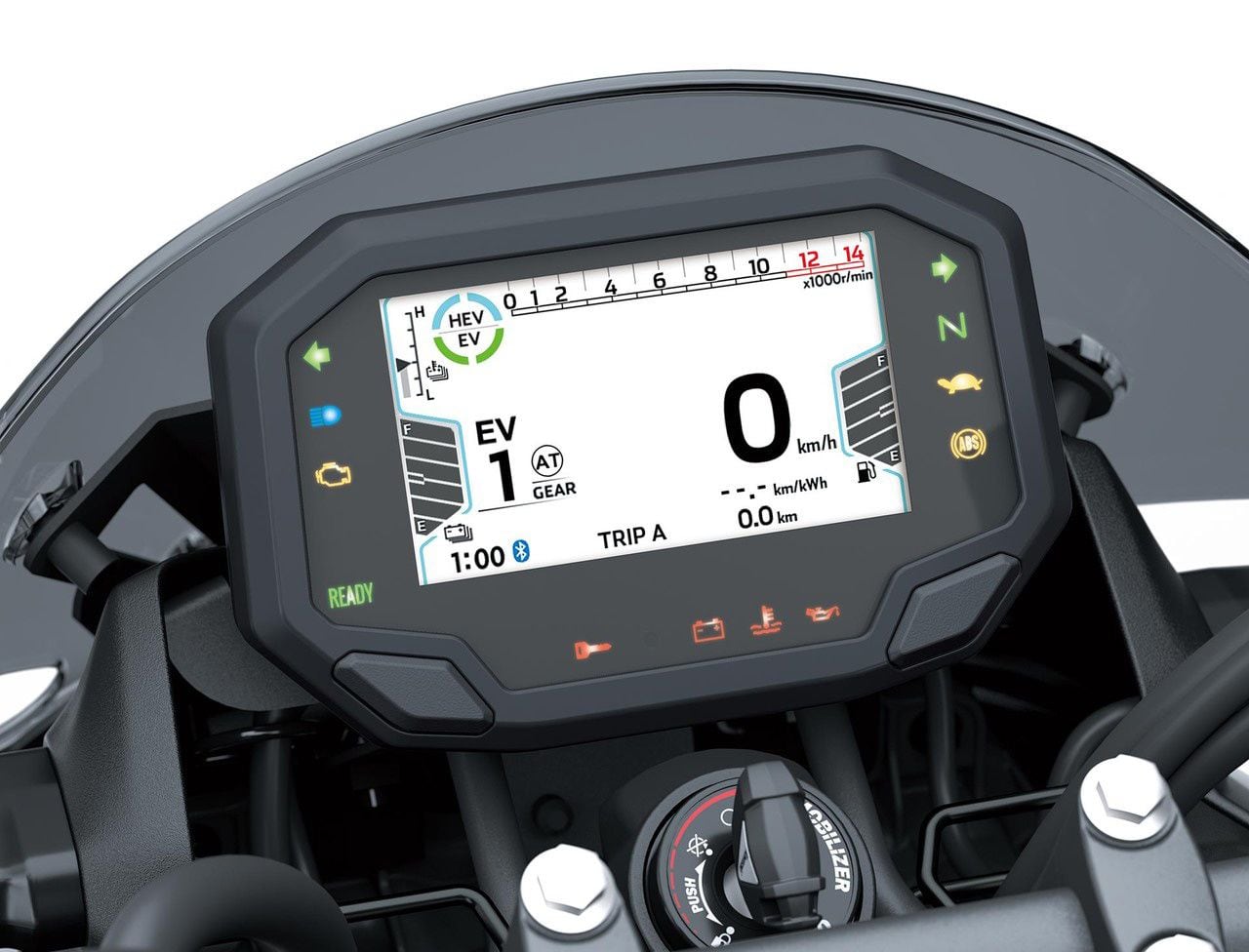
The Z7 comes with a 4.3-inch TFT display. (Kawasaki/)However, the real benefit comes not from performance but from economy. Despite acceleration that’s on a par with a 750cc bike (hence the “Z7″ name) the fuel consumption is claimed to be similar to bikes in the 250cc ICE class.
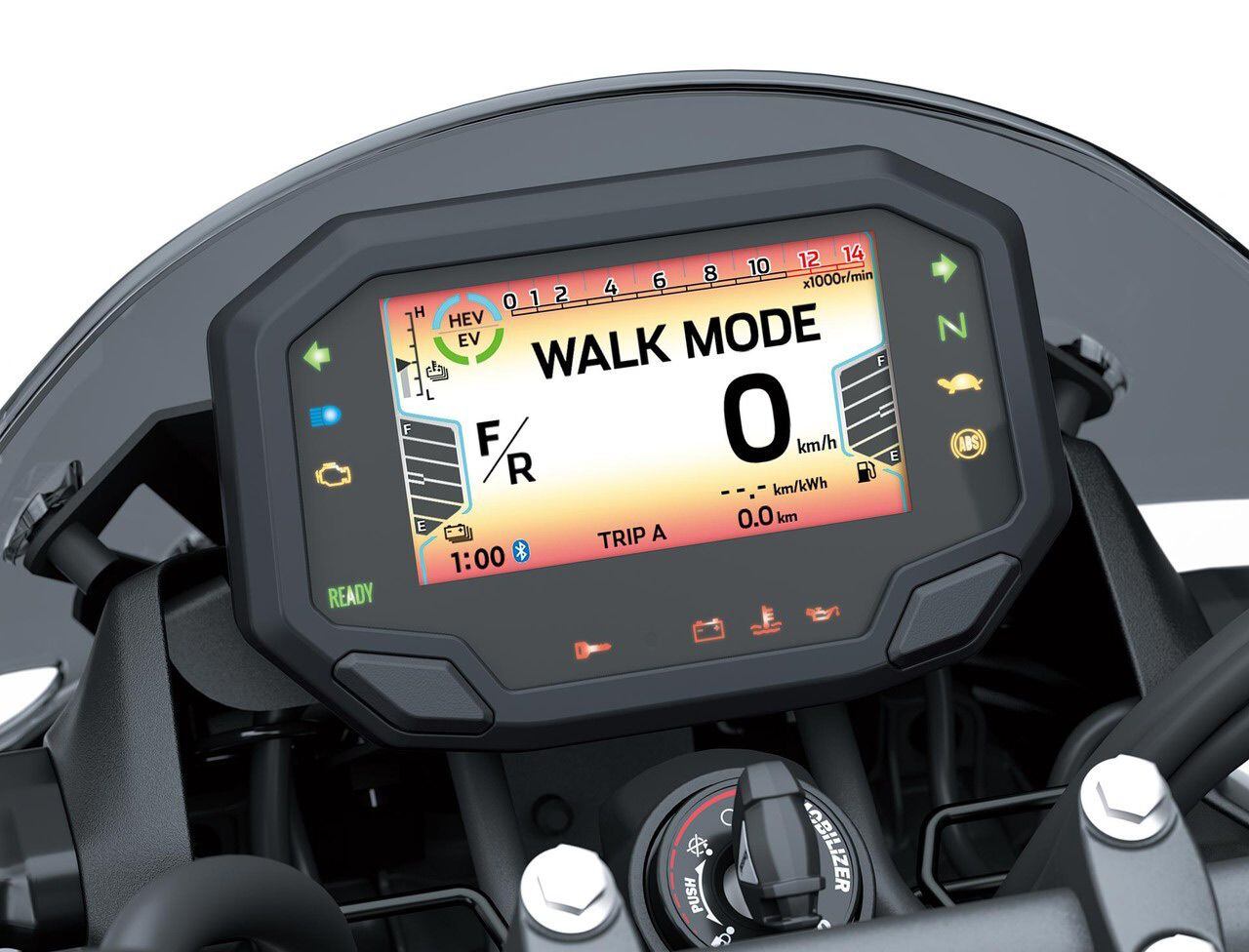
The Z7 features a Walk mode that allows the bike to creep at low speed for easy maneuvering in a parking lot. (Kawasaki/)For low-speed maneuvering, there’s also a “walk” mode that runs the bike forward up to 3 mph or backward at up to 1.9 mph. The rest of the bike’s tech is more familiar, including the now-expected TFT dash, a small 4.3-inch unit with smartphone connectivity, and all-LED lighting. There’s no full spec yet, but the bike’s overall weight is sure to be within a whisker of the mechanically identical Ninja 7 Hybrid, which comes in at 500 pounds.
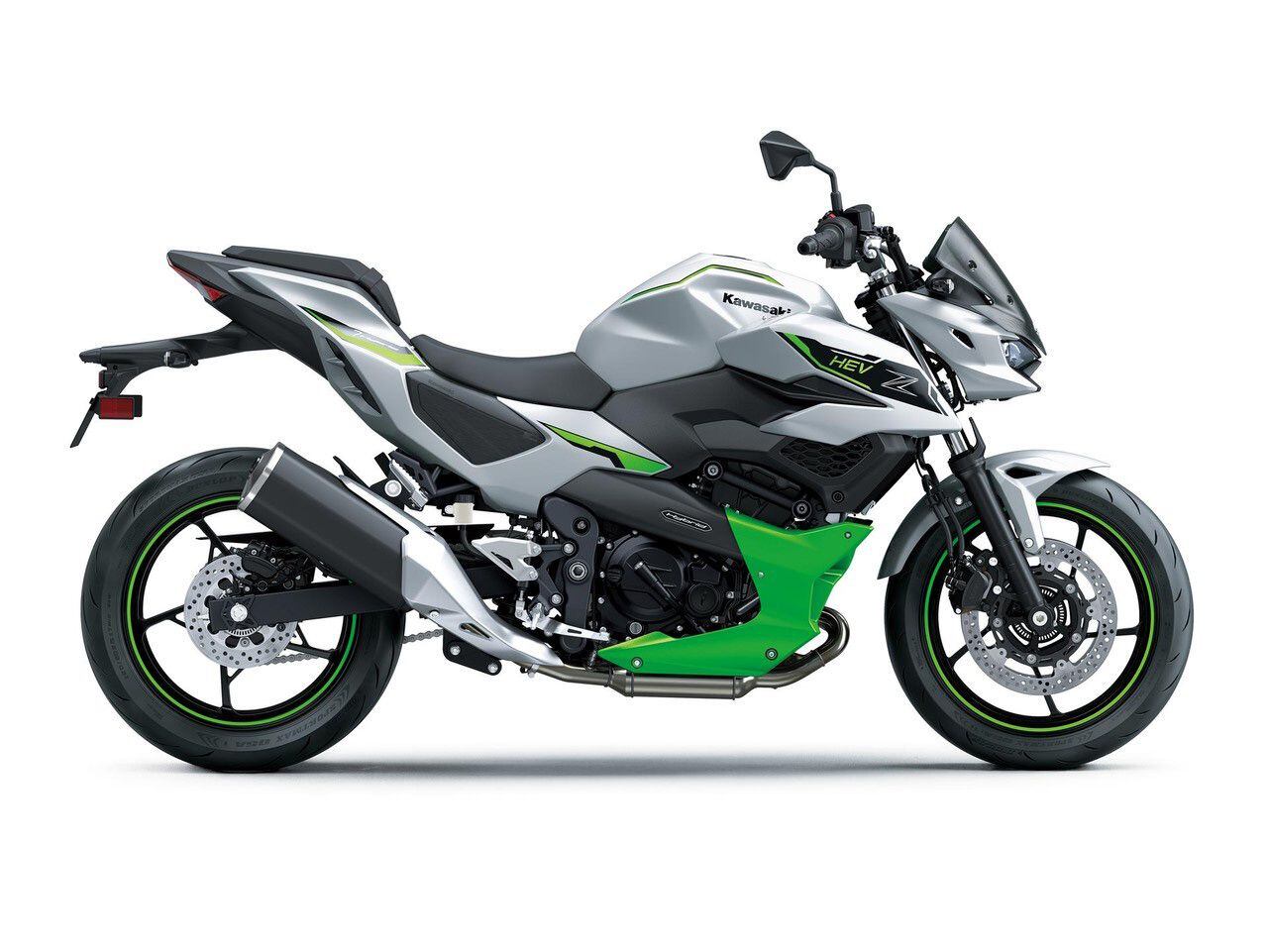
From the side view you can see the Z7’s tall handlebars and relaxed riding position. (Kawasaki/)-
 1
1
-
-
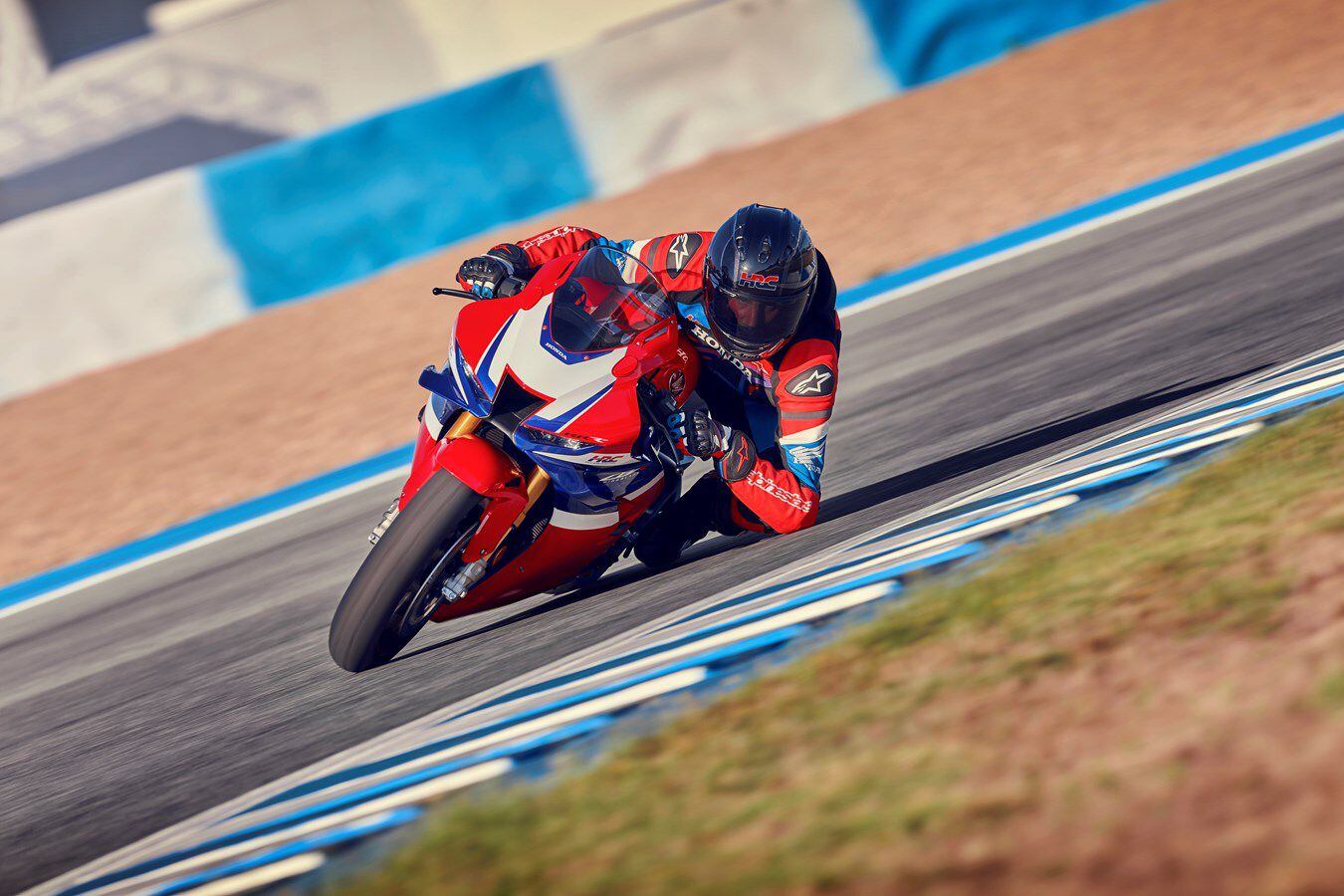
Honda means business in 2024, and has given the CBR1000RR-R SP a host of changes to help it find its way to the front in World Superbike and international competition. (Honda/)Back in July we commented on Japanese rumors that the Honda CBR1000RR-R was getting updates including new front winglets for 2024—now those updates have proved true, but they’re just the start of the changes to next year’s CBR1000RR-R.
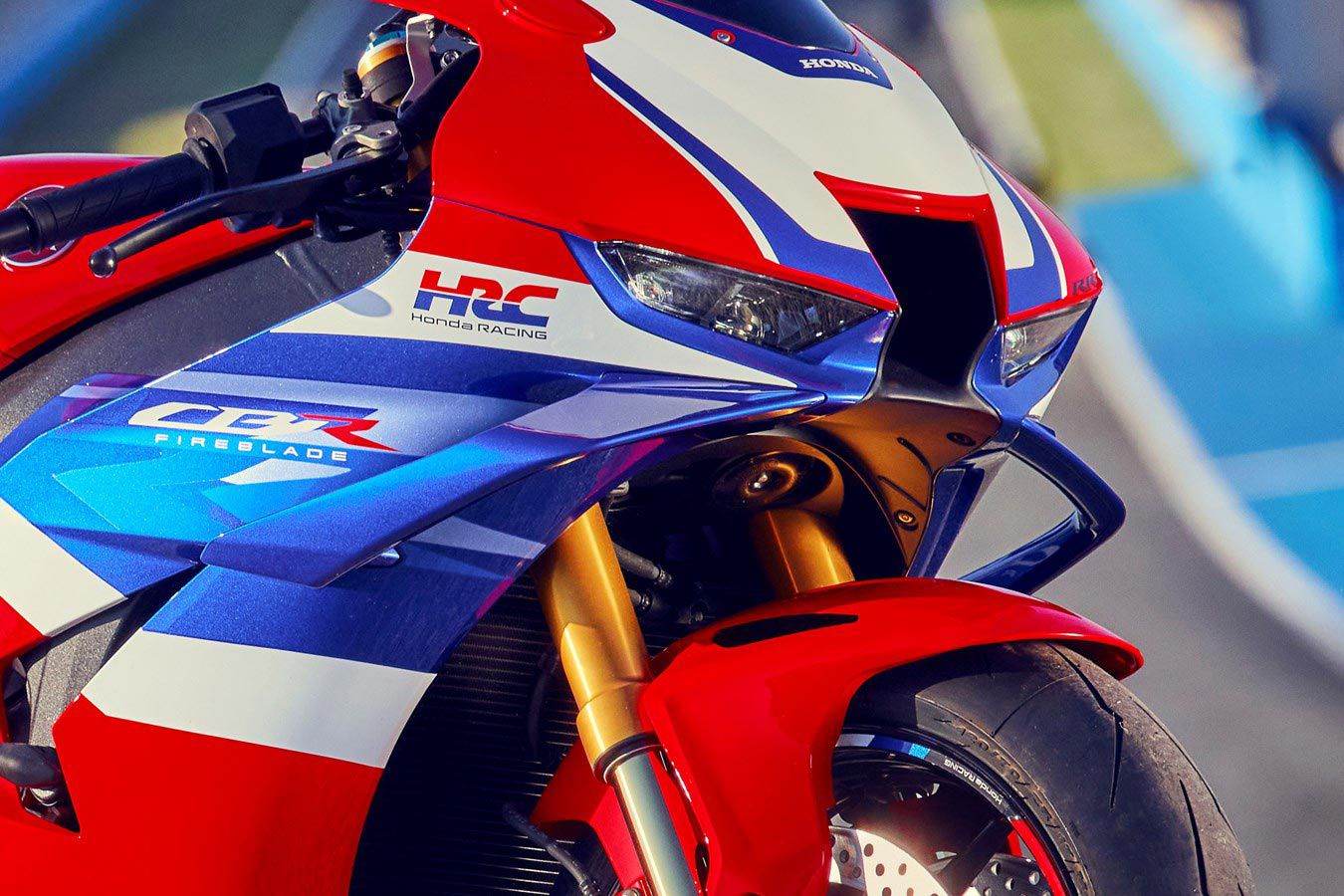
As rumored, Honda has given the 2024 CBR1000RR-R SP MotoGP-inspired winglets. (Honda/)Updates to the 2024-and-beyond CBR1000RR-R SP have been revealed at EICMA in Milan, including the new-look winglets on the fairing that are claimed to offer the same downforce as before but with less impact on the weight of the steering. But under the slight visual tweaks there are much more in-depth updates.
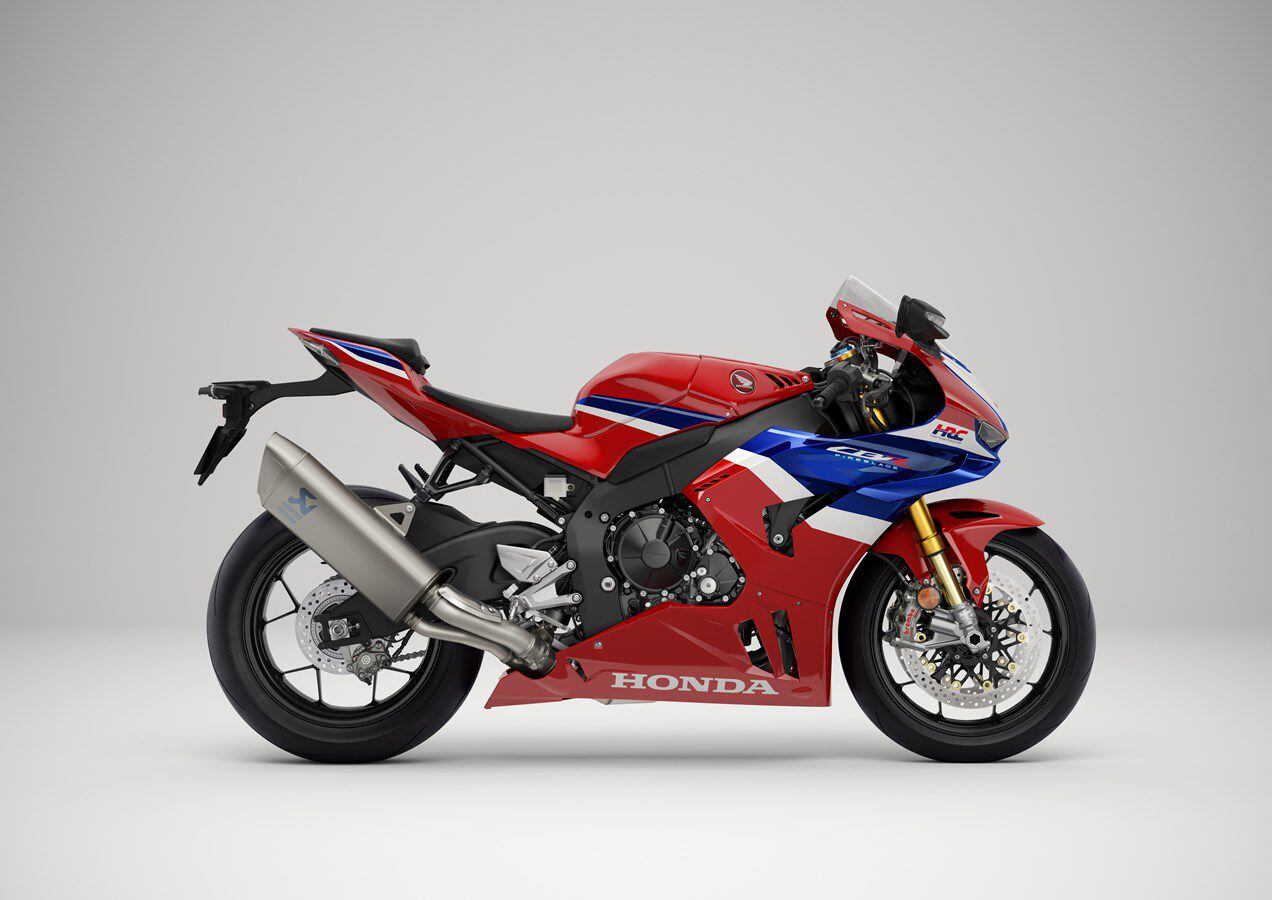
While there are obvious changes to the appearance of the CBR1000RR-R SP, there are a lot more changes under its skin. (Honda/)The engine, for instance, gets a new cylinder head with more compression, up from an already-high 13.4:1 to 13.6:1, as well as revised camshafts with different duration and lift, new valve springs, and revised ports. Deeper in the motor, the crankshaft pin and journal diameters are changed, saving a remarkable pound of inertial mass. The connecting rods are lighter too, and another 0.55 pound has been removed from the crankcases.

The SP’s engine gets a bunch of updates including a higher compression ratio, revised cams and valvetrain, updated crankshaft and rods. (Honda/)The intake system is completely new, with a twin-motor throttle-by-wire system that controls the cylinders in two pairs. Cylinders one and two are controlled by one throttle motor, cylinders three and four by the other, allowing their throttles to be opened and closed separately to give improved response and to add an extra layer of engine-braking control. The nine-level traction control system has also been tweaked for 2024.
In performance terms, the engine’s peak power remains at claimed 215 crankshaft horsepower, but it arrives slightly lower in the rev range at 14,000 rpm, while peak torque of 83.3 lb.-ft. comes at 12,000 rpm.
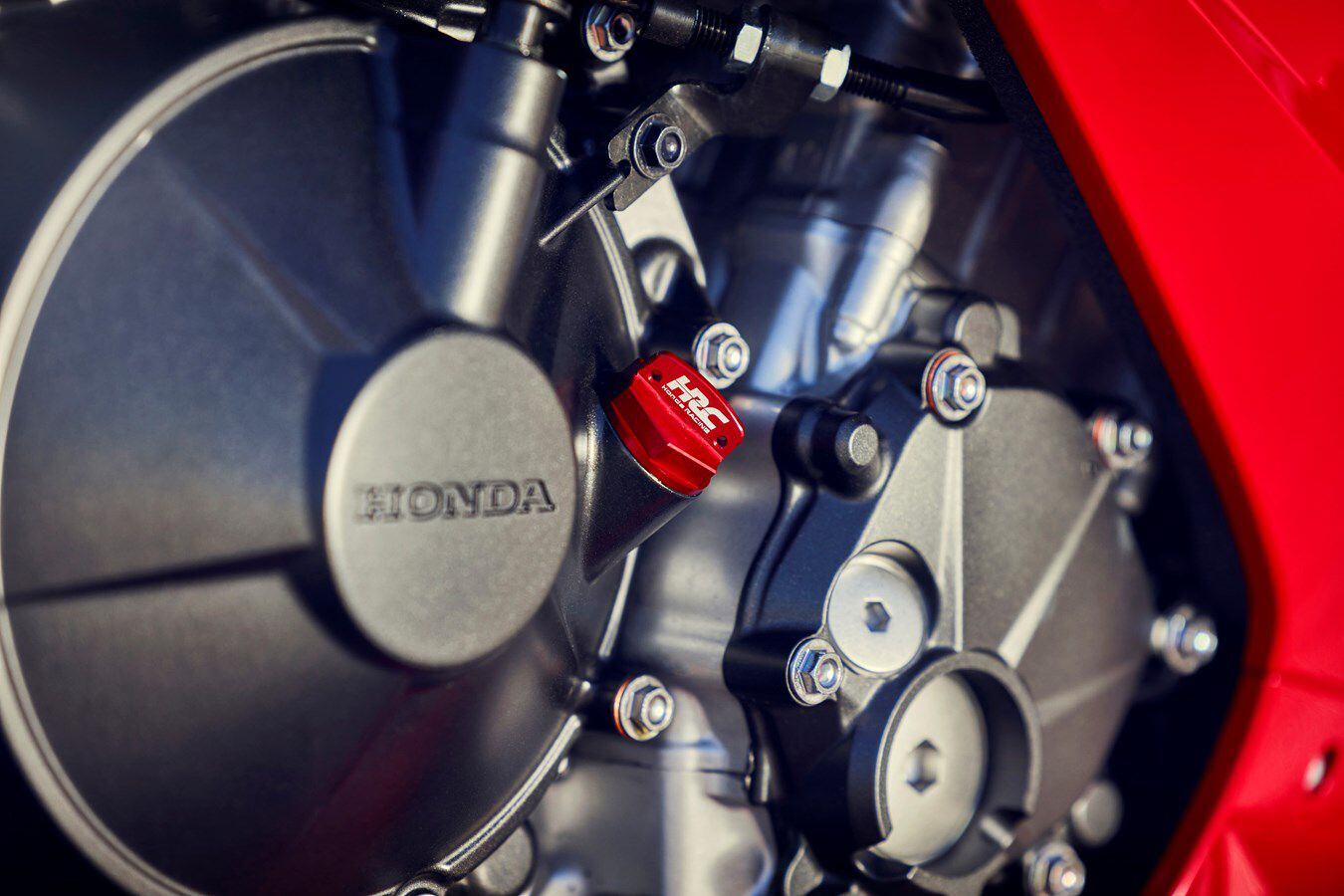
Claimed power is 215 hp at the crankshaft, but the power arrives slightly lower in the rpm range at 14,000. (Honda/)The frame might look the same as the current model, but its weight and rigidity are tweaked. There’s less internal ribbing and the thin-wall section of the frame has grown for 2024, cutting its weight by 2.1 pounds. The weight loss is secondary, though, to the increased lateral and torsional flexibility that the changes bring, intended to give a more supple feel. There are riding position changes too, with higher bars and lower pegs than before to give more space and control.
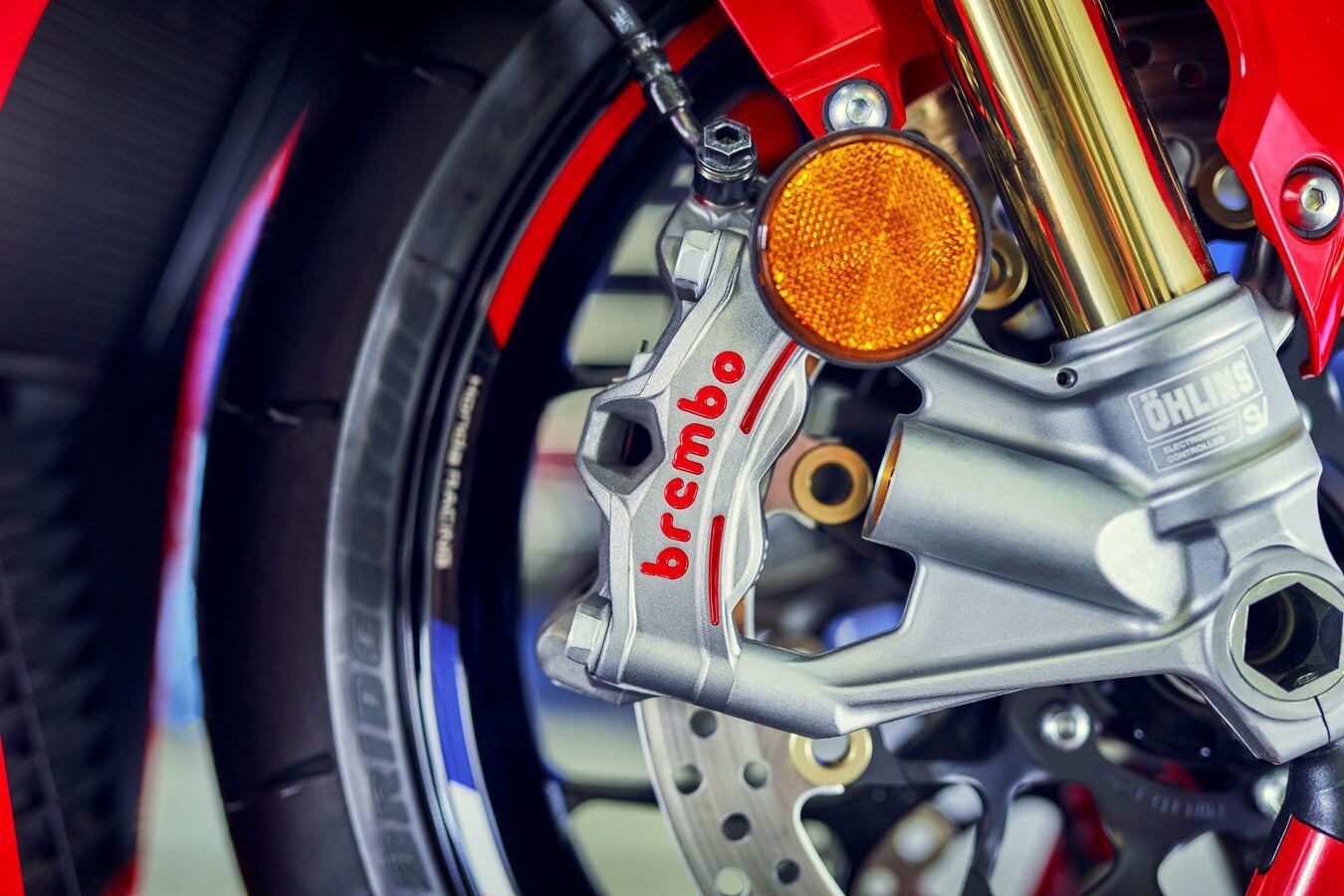
The 2024 SP gets the latest Brembo Stylema R calipers. (Honda/)As in the past, the SP model has Öhlins electronic suspension, and for 2024 it’s upgraded to the third-generation S-EC3.0 on the 43mm Öhlins NPX fork and TTX 36 shock. The brakes are also improved, gaining the latest Brembo Stylema R calipers.
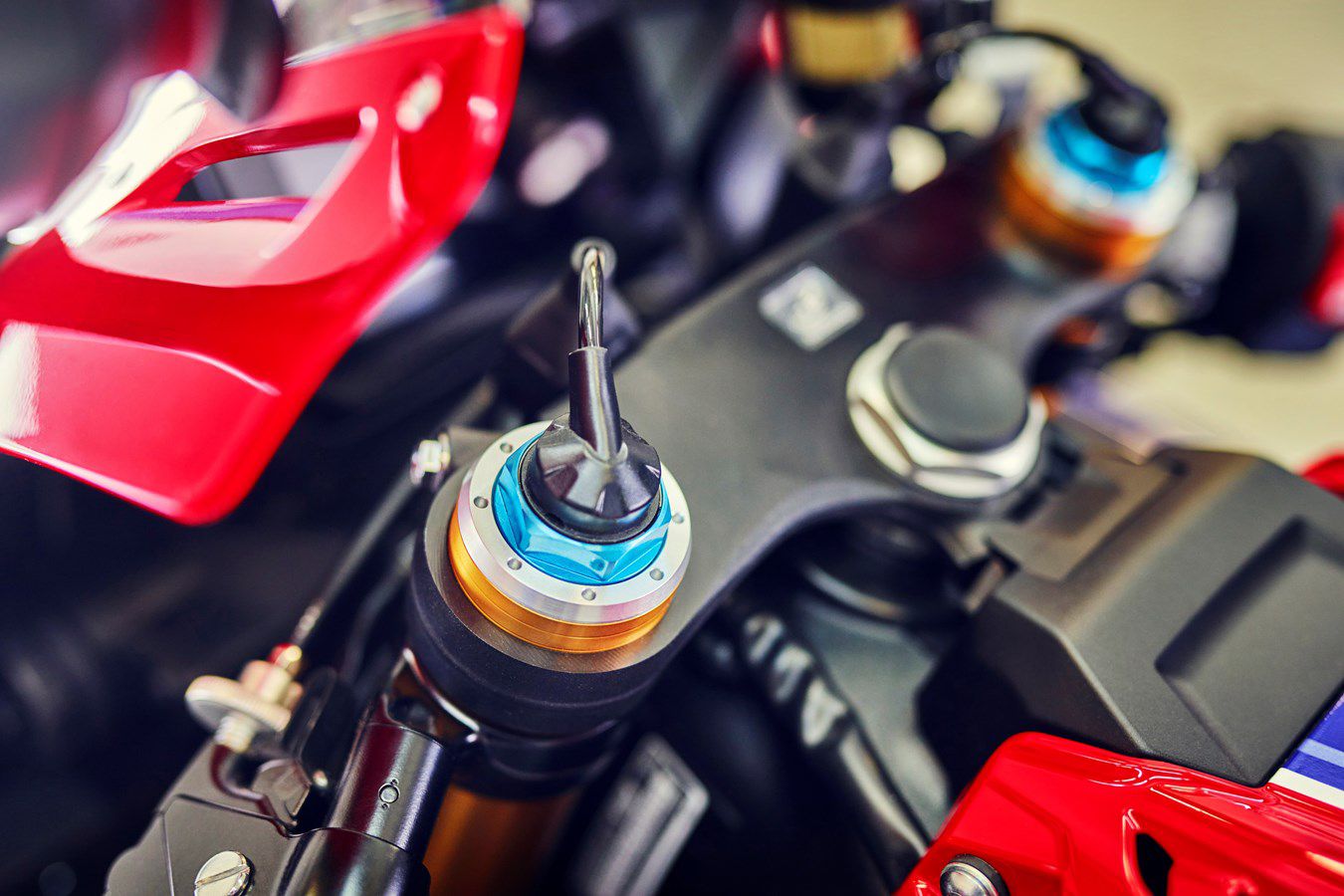
Third-gen Öhlins S-EC3.0 electronic suspension is used. (Honda/)Although the winglets are the most visible change, there are other bodywork alterations as well. The fuel tank is bigger than before at 4.4 gallons, but it’s also reshaped to give more space when you’re tucked in and to improve knee grip on the sides.
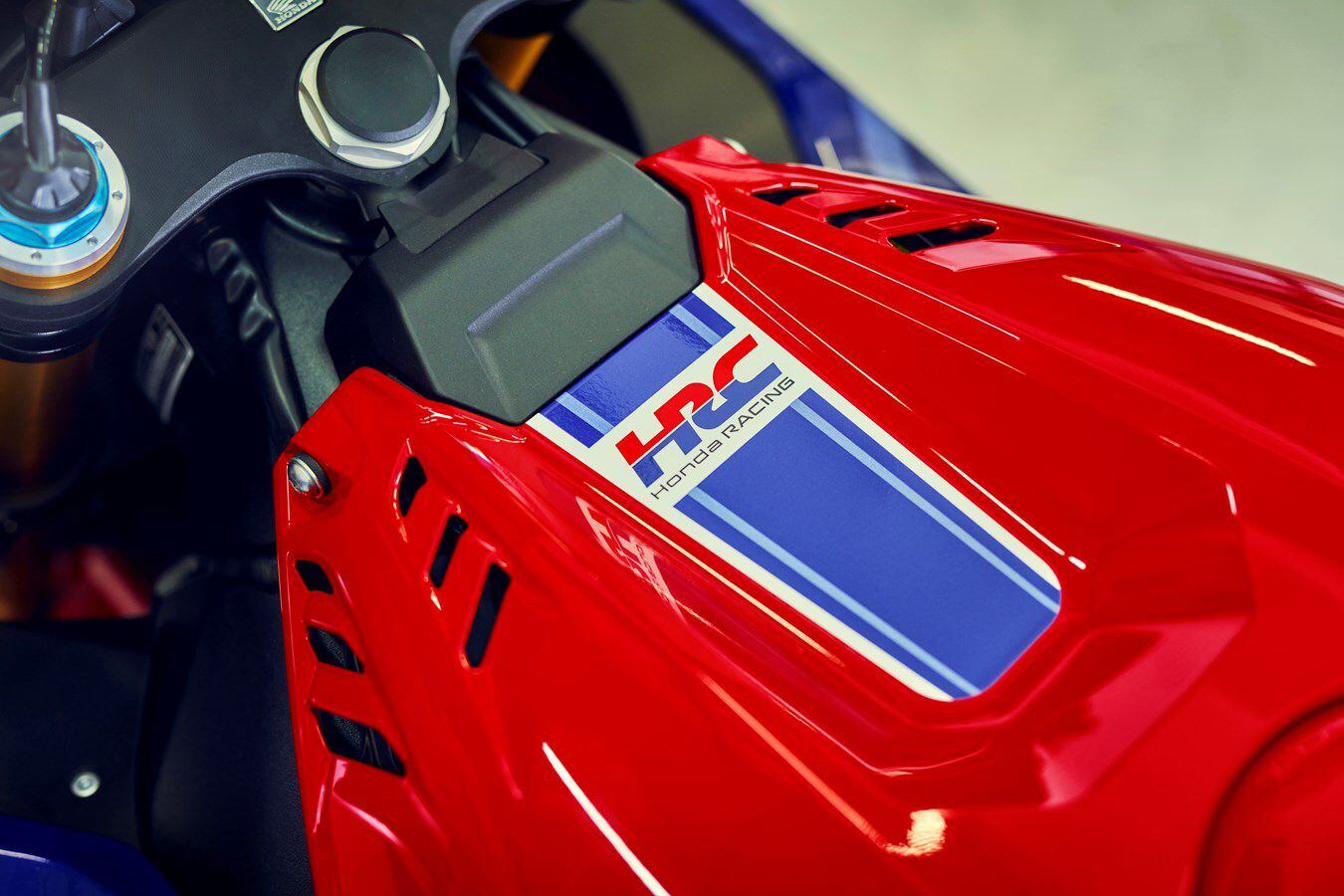
The fuel tank has been altered to allow the rider to get tucked in more. (Honda/)Although the 2024 changes aren’t likely to be enough to persuade many existing owners of the 2021 to 2023 model to upgrade, they’re expected to come to the fore in racing, where the CBR1000RR-R SP hasn’t yet managed to achieve the sort of success that Honda’s used to in WSBK competition.
Honda has also introduced a Carbon Edition of the bike in Europe, including carbon bodywork, that drops the bike’s weight by another 2.2 pounds compared to the standard model.
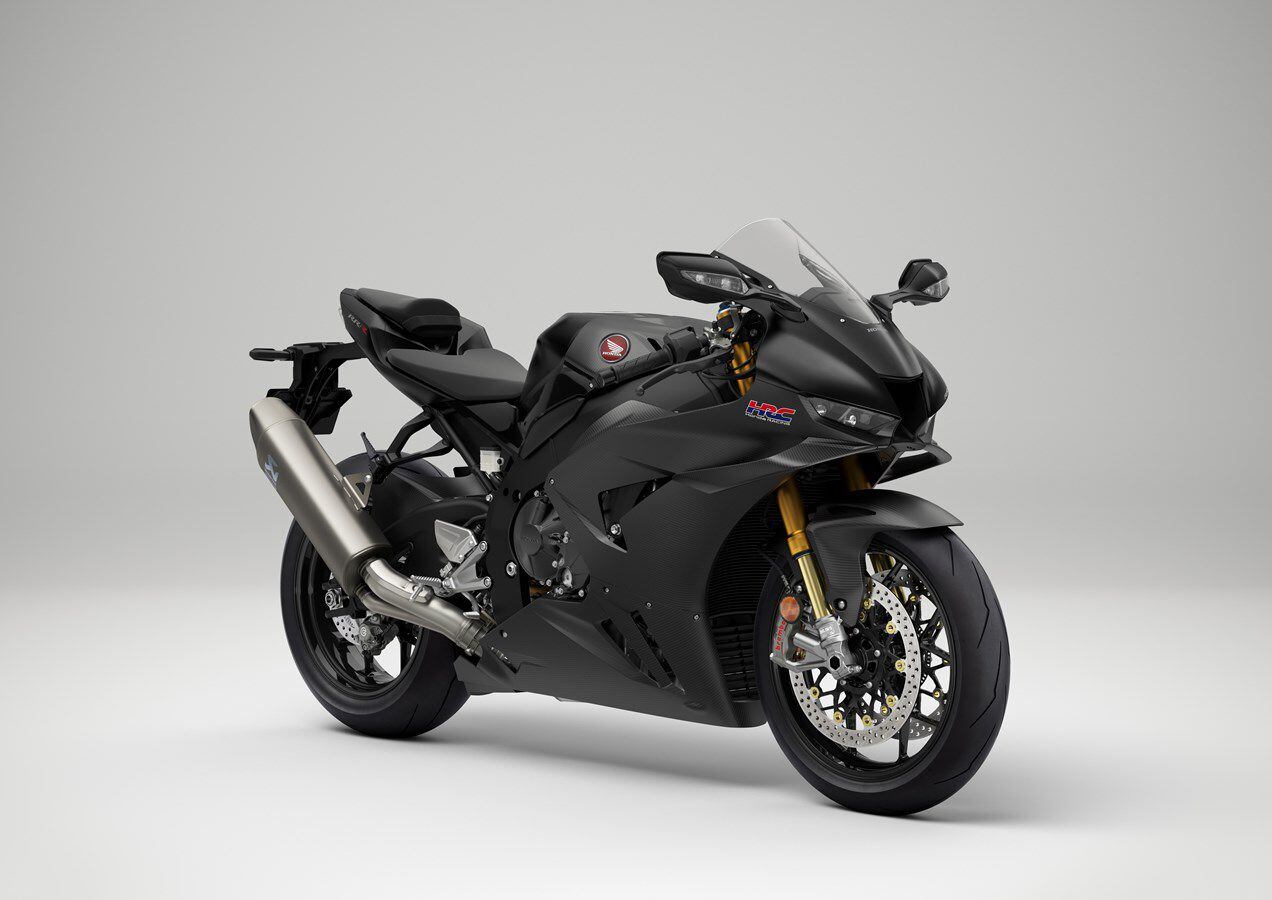
The 2024 CBR1000RR-R SP is available in a Carbon Edition in Europe with c-f bodywork shaving an additional 2.2 pounds off the bike’s weight. (Honda/)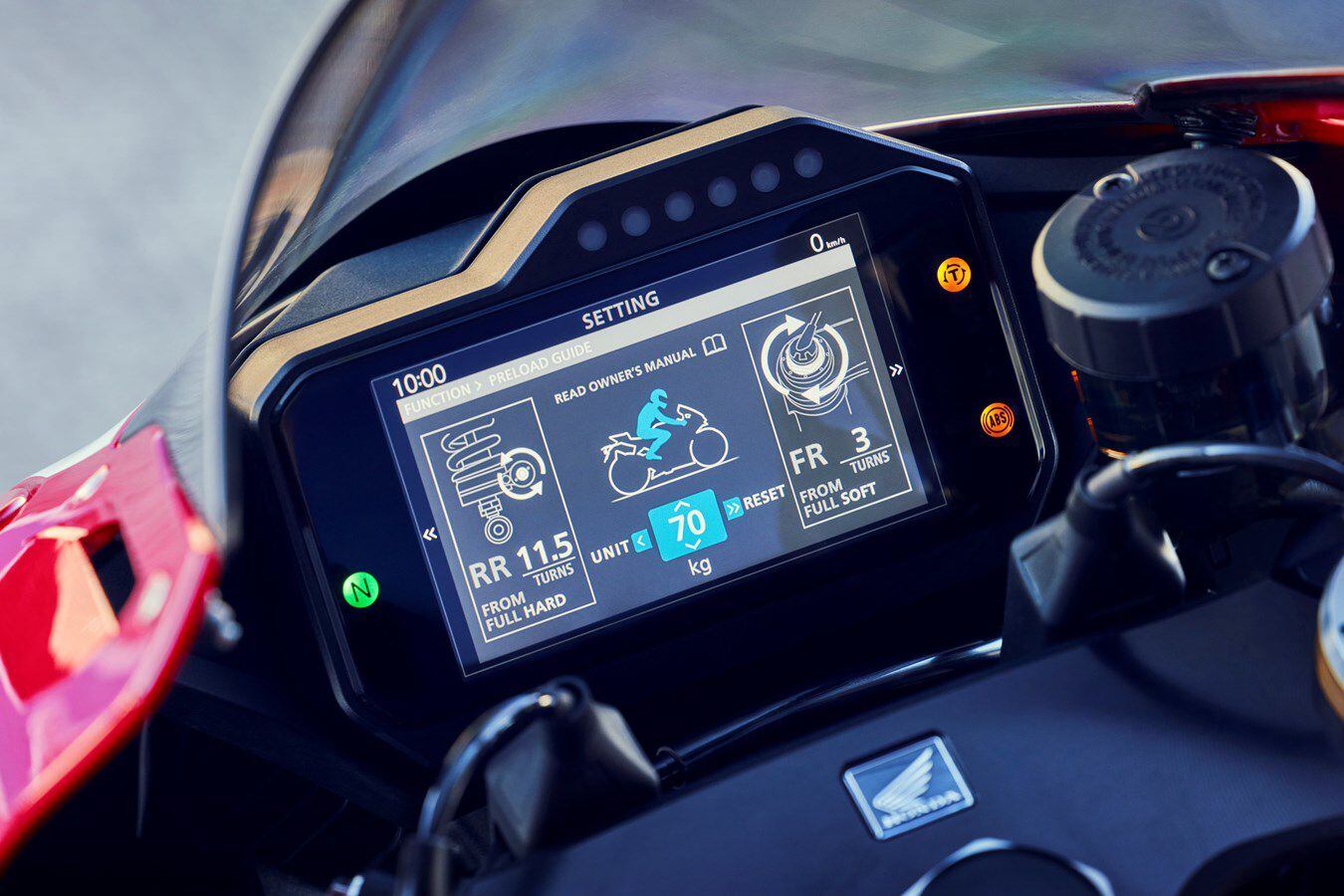
A closer look at the CBR’s TFT display. (Honda/)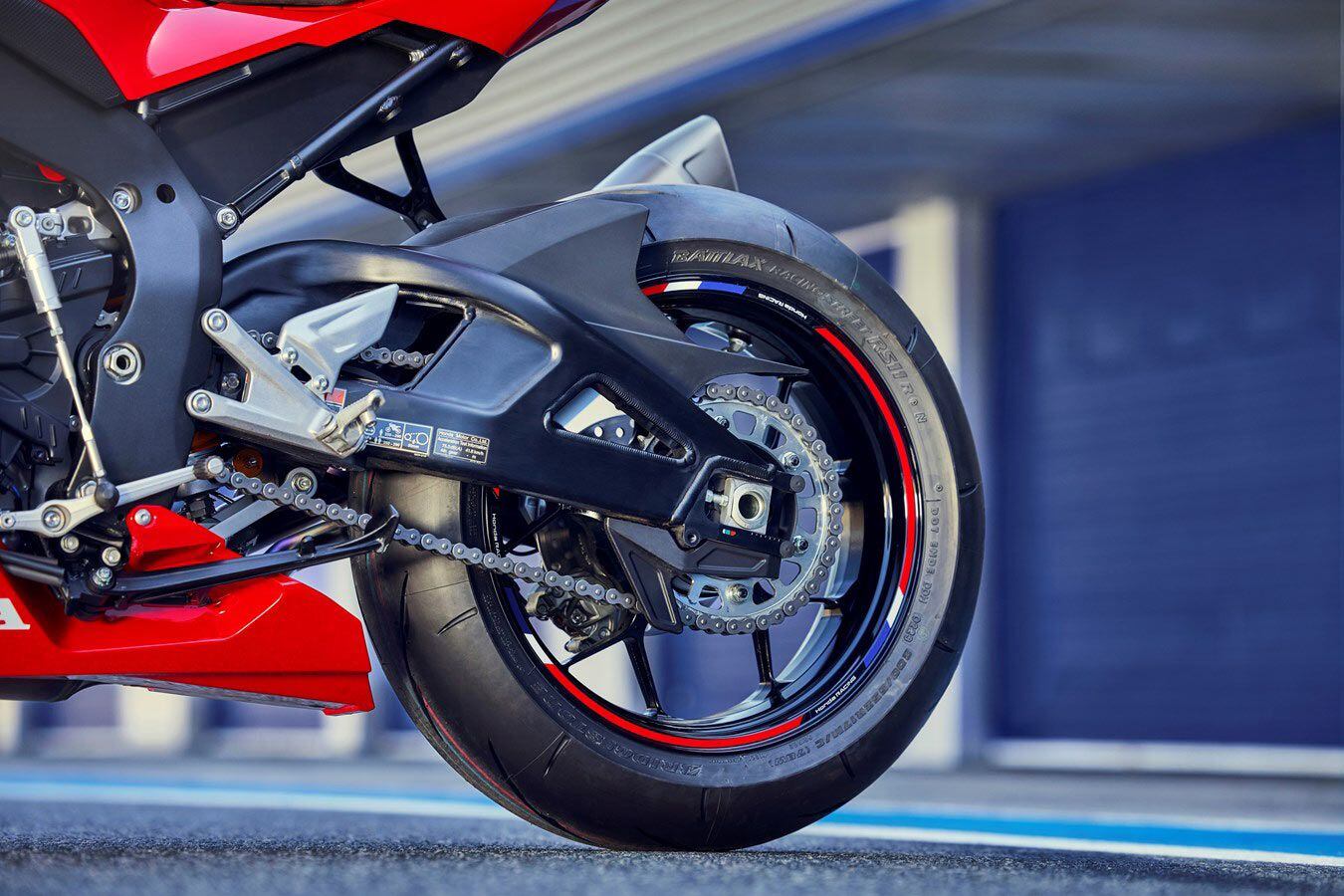
The CBR gets an updated frame and chassis for 2024. (Honda/)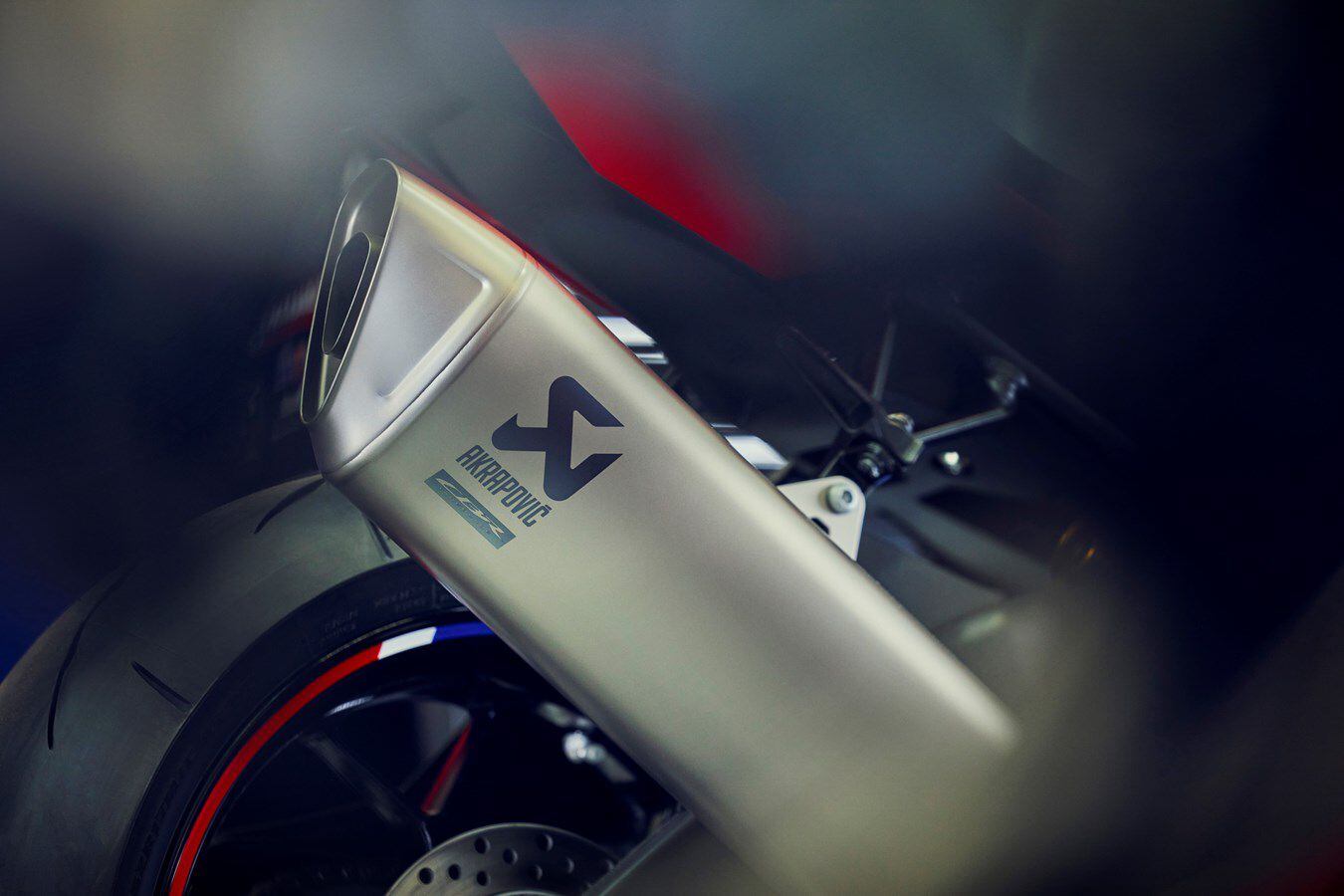
A closer look at the Akrapovič exhaust silencer. (Honda/)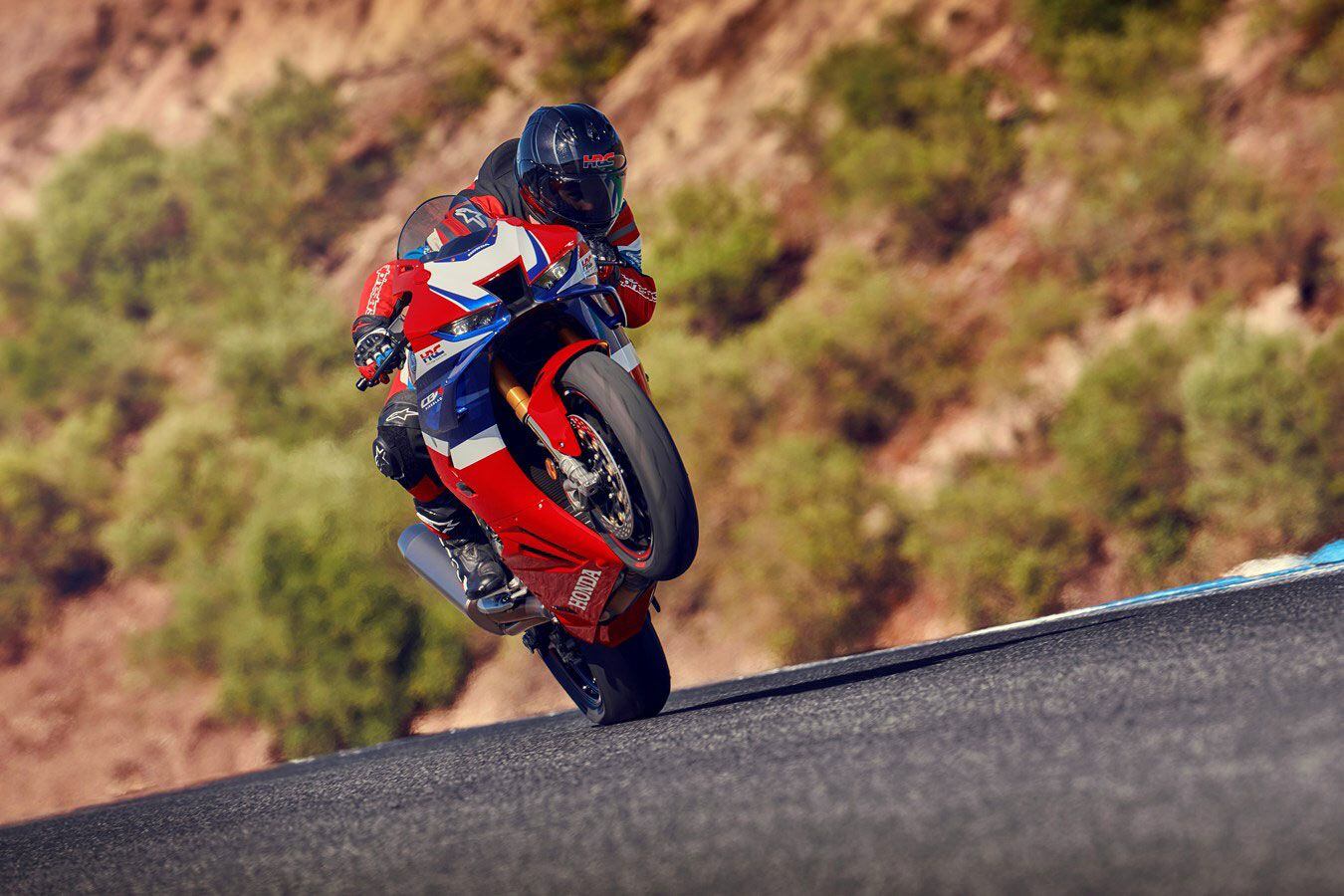
2024 Honda CBR1000RR-R SP wheelie action. (Honda/)2024 Honda CBR1000RR-R SP Specs
MSRP: TBA Engine: DOHC, liquid-cooled, four-stroke inline-four; 4 valves/cyl. Displacement: 1,000cc Bore x Stroke: 81.0 x 48.5mm Compression Ratio: 13.6:1 Transmission/Final Drive: 6-speed/chain Claimed Horsepower: 215 hp @ 14,000 rpm Claimed Torque: 83.3 lb.-ft. @ 12,000 rpm Fuel System: PGM-FI Clutch: Wet, multiplate Engine Management/Ignition: Throttle-by-wire, digital transistorized w/ electronic advance Frame: Aluminum twin-tube composite twin spar Front Suspension: Öhlins 43mm S-EC3.0 NPX USD fork, fully adjustable, 4.9 in. travel Rear Suspension: Öhlins TTX 36 S-EC3.0 shock, Pro-Link swingarm, fully adjustable, 5.6 in. travel Front Brake: Brembo Stylema R radial-mount calipers, 330mm discs w/ ABS Rear Brake: Brembo 2-piston caliper, 220mm disc Wheels, Front/Rear: 17 x 3.5 in. / 17 x 6.0 in. Tires, Front/Rear: 120/70ZR-17 / 200/55ZR-17 Rake/Trail: 24.7°/4.0 in. Wheelbase: 57.3 in. Ground Clearance: 5.1 in. Seat Height: 32.7 in. Fuel Capacity: 4.4 gal. Claimed Wet Weight: 443 lb. Contact: powersports.honda.com -
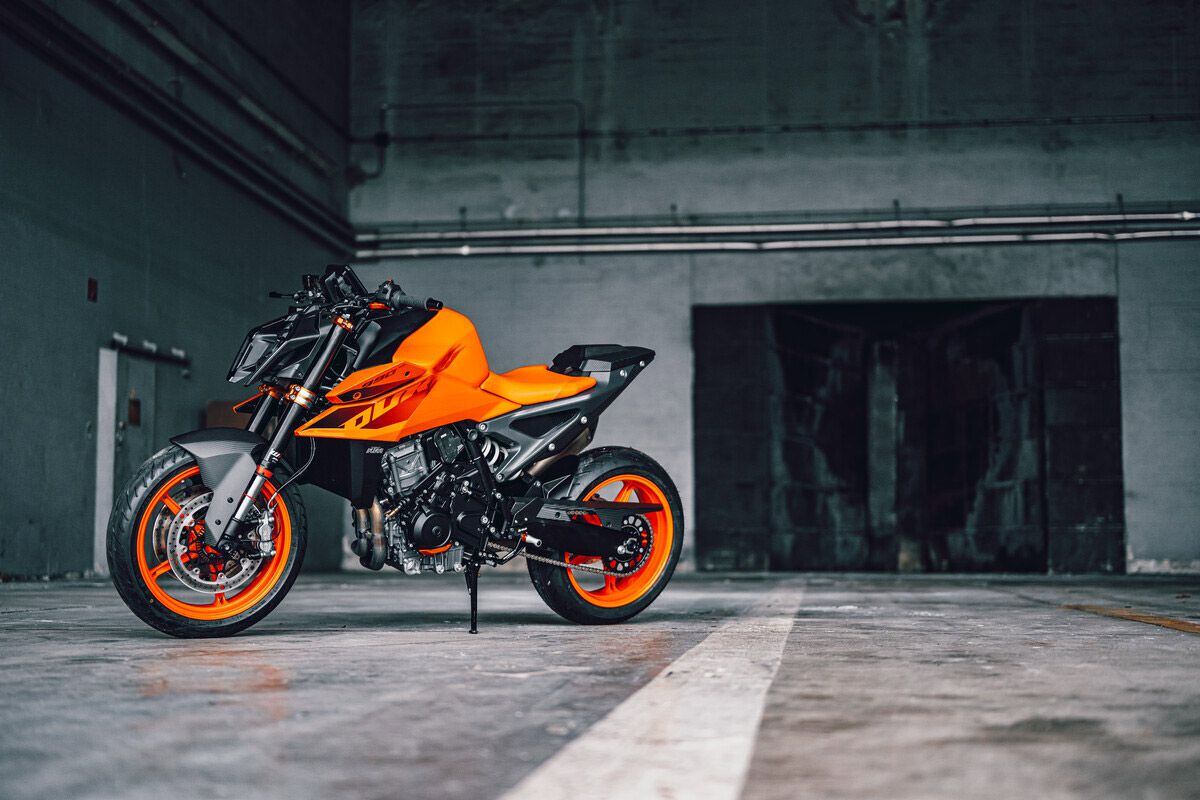
KTM’s 2024 990 Duke gets an all-new, more aggressive look. (KTM/)Bigger is better, at least according to KTM, who announced a larger-displacement 990 Duke for 2024. Built on the same prerequisites as the 790 Duke and 890 Dukes that came before it, the 990 promises lightweight, scalpel-like performance through numerous changes, including a new chassis, swingarm, and electronic technology. The bike also gets a new look and what KTM describes as “larger proportions.”
“Sharper” has always been a keyword in the launch of new Duke models and that continues here, KTM saying this latest model is the “lightest, sharpest, most performance-focused middleweight naked ever produced at KTM’s main plant.” That’s saying a lot considering the performance of the 890 Duke GP that came before it. But how do you get to this point?
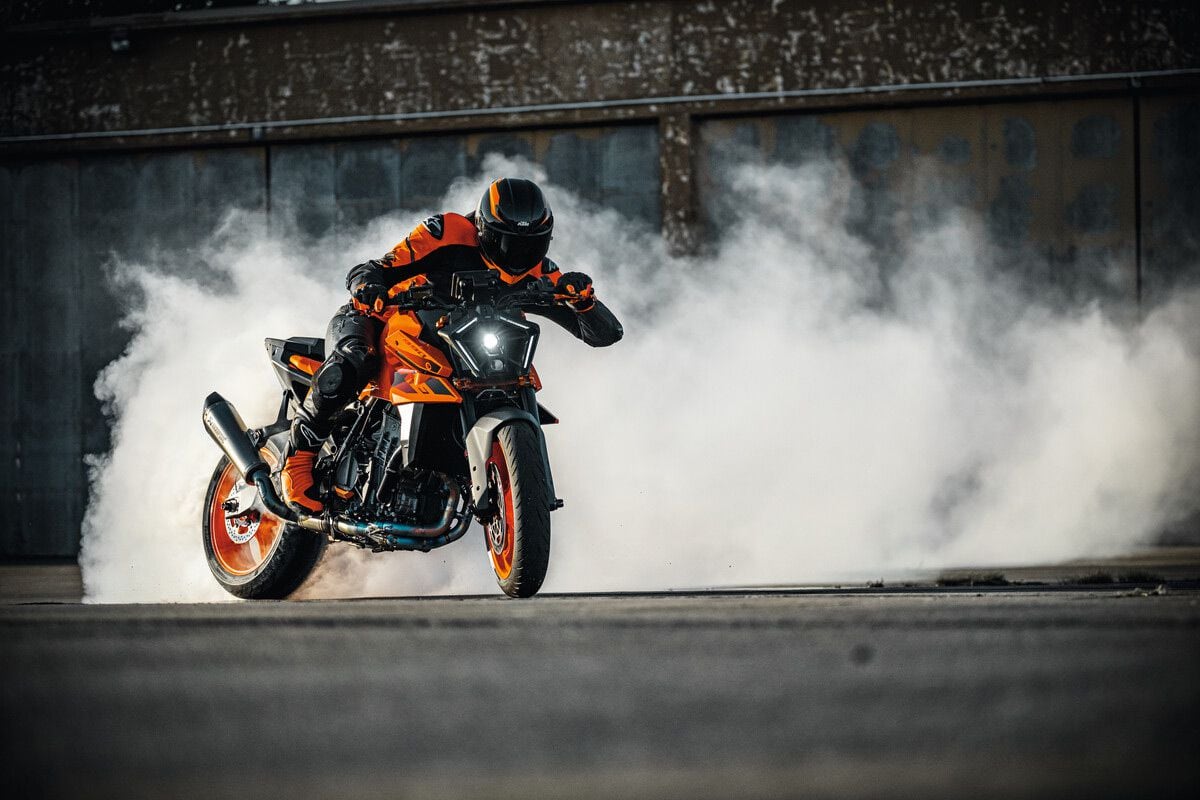
It wouldn’t be a KTM Duke photoshoot without smoke. The aim for the 990 Duke was more performance. (KTM/)Engine and Electronics
Progress starts at the 947cc parallel-twin engine that KTM claims is still the most compact twin in the middleweight naked class. Little information is available beyond that, though a spec sheet comparison between the 990 Duke and earlier-generation 890 Duke R suggests that bore and stroke are both new, with the bore measuring 92.5mm (versus 90.7mm) and stroke 70.4mm (versus 68.8mm). KTM claims 123 hp at 9,500 rpm and 76 lb.-ft. of torque at 6,750 rpm. Compare that with the 121 hp and 73 lb.-ft. of torque it claimed for the 890 Duke R.
More aggressive camshaft profiles and longer valve openings are used, KTM adding that “rideability is improved due to increased rotating mass.” The stainless steel exhaust is all-new as well. Suggested fuel mileage is right around 50 mpg.
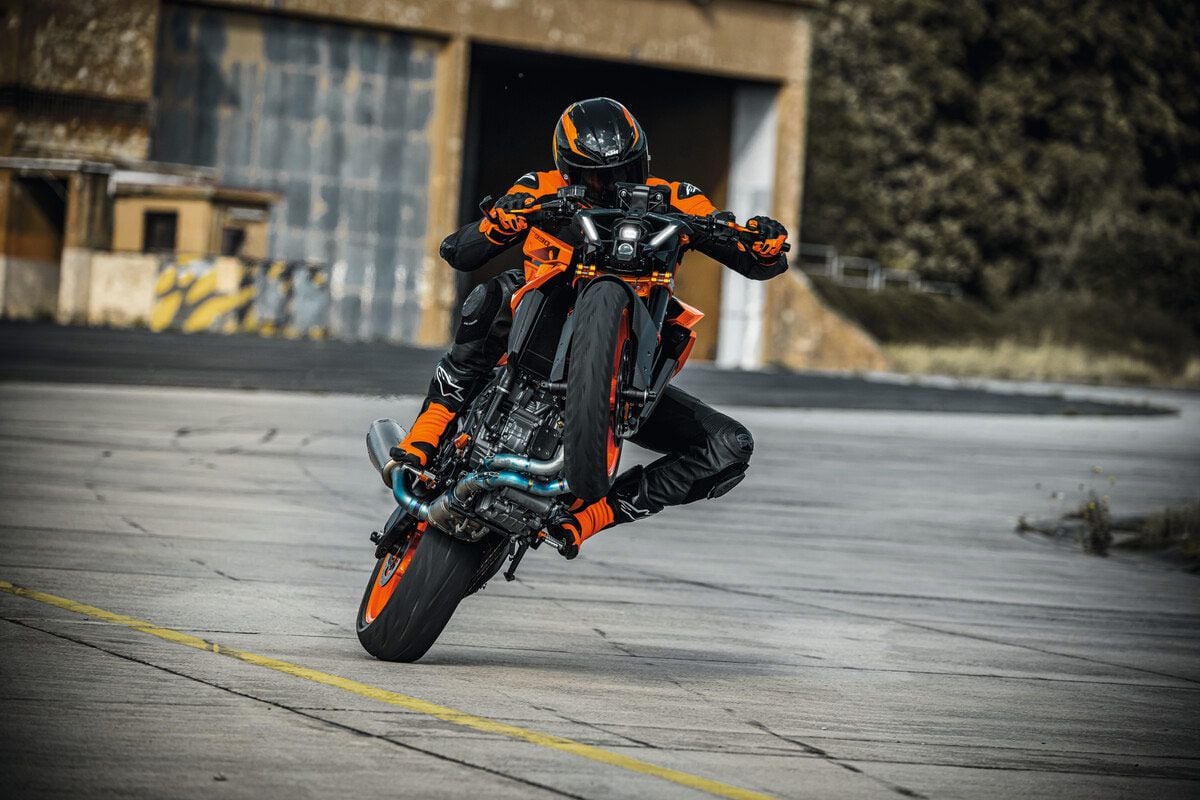
Wheelies? Yeah, the 990 Duke can do that too. There’s a catch though, as you’ll need to upgrade to the Performance or Track riding modes to fine-tune traction control settings. Those are available for the first 1,500 kilometers (932 miles), but need to be purchased once that demo period is over. (KTM/)Power is managed via a very traditional suite of electronics package that includes three standard ride modes: Sport, Street, and Rain. Those modes perform as follows:
- Sport: Made for spirited riding. Full power, more direct throttle control, and less traction control, allowing slight wheelspin and maximum wheelie.
- Street: The go-to mode for everyday riding. Full power, default throttle control, and traction control settings suitable for street riding. Limited wheelie allowed.
- Rain: Designed for slippery road conditions. Power output is reduced to 105 hp, throttle response is smoothed dramatically, and traction control is set to maximum.
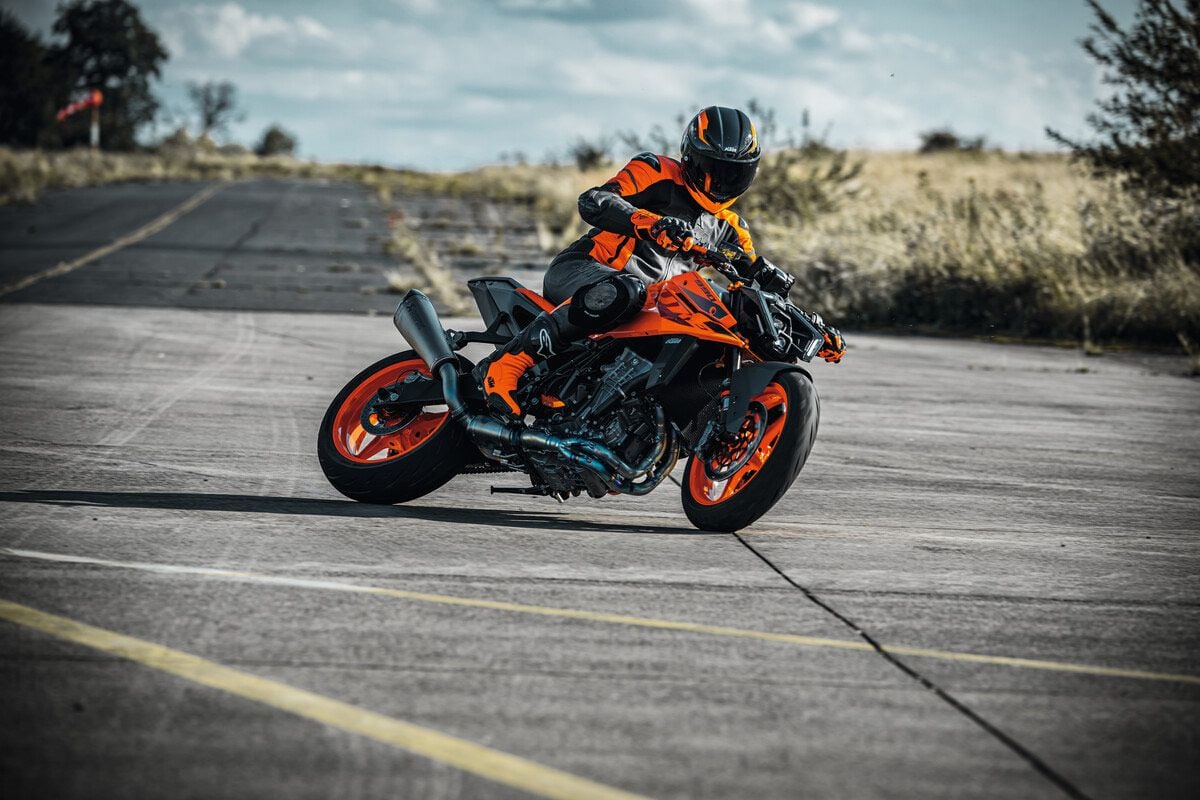
The 990 Duke retains KTM’s Supermoto ABS mode. (KTM/)Riders are limited by how much they can adjust rider-aid settings in standard ride modes, but KTM offers a solution in the form of optional Performance and Track modes, which are available as part of a “demo program” for the first 1,500 kilometers (932 miles), but must be purchased once that number is exceeded. The modes are described as follows:
- Performance: Allows a certain level of customization, with a selection of traction control intervention and throttle control. Wheelie control can also be switched off and launch control can be used. Cruise control is also available.
- Track: Same level of customization as Performance but race focused, with additional lap time and bike data displayed via the dash. Cruise control is disabled.
The aforementioned dash consists of a 5-inch TFT display that includes a USB-C connection for device charging. More importantly, KTM has redesigned the menu structure for faster access to various features.
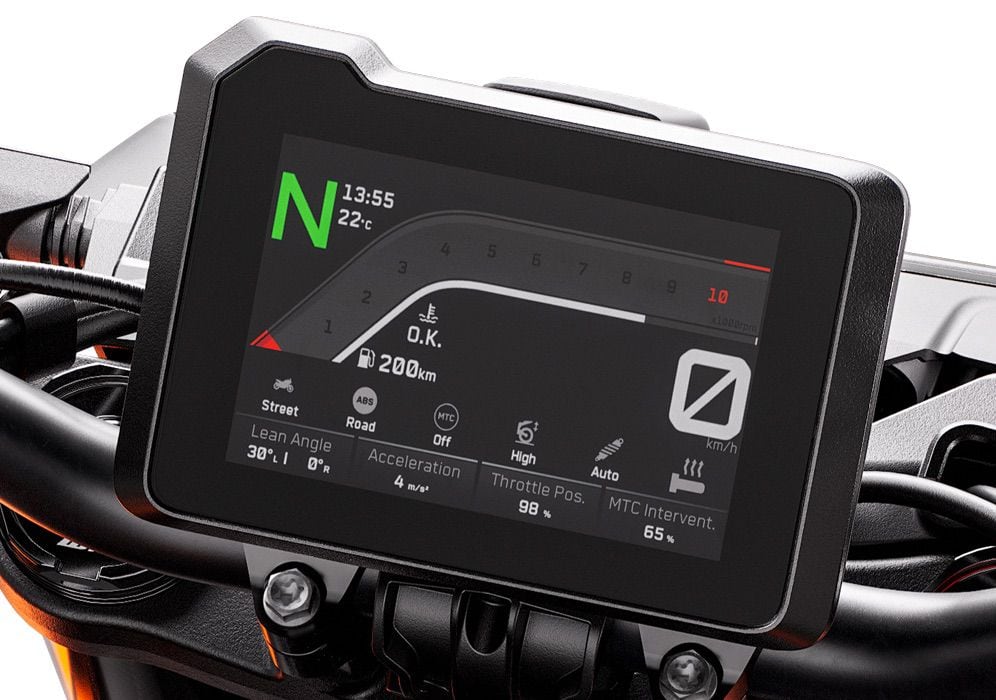
A 5-inch TFT display uses new graphics and an updated menu structure for improved usability. (KTM/)Chassis
Handling has always been a strong point for Duke models, but KTM looks to take another step with the 990 Duke by redesigning the steel tube frame, which is stiffer than in years past, for more feedback. More specifically, there’s an 8 percent increase in longitudinal stiffness and 5 percent increase in torsional stiffness.
For even more torsional stiffness and, in turn, increased stability, the swingarm is mounted inside the swingarm pivot area. A forged pivot bolt is said to offer similar benefits, on a smaller scale.
While increased stiffness is a big talking point when it comes to the frame, swingarm stiffness is actually reduced by 35 percent, for improved bump absorption and traction. Said swingarm is 3.3 pounds lighter too, thanks in part to a new gravity die-cast production method.
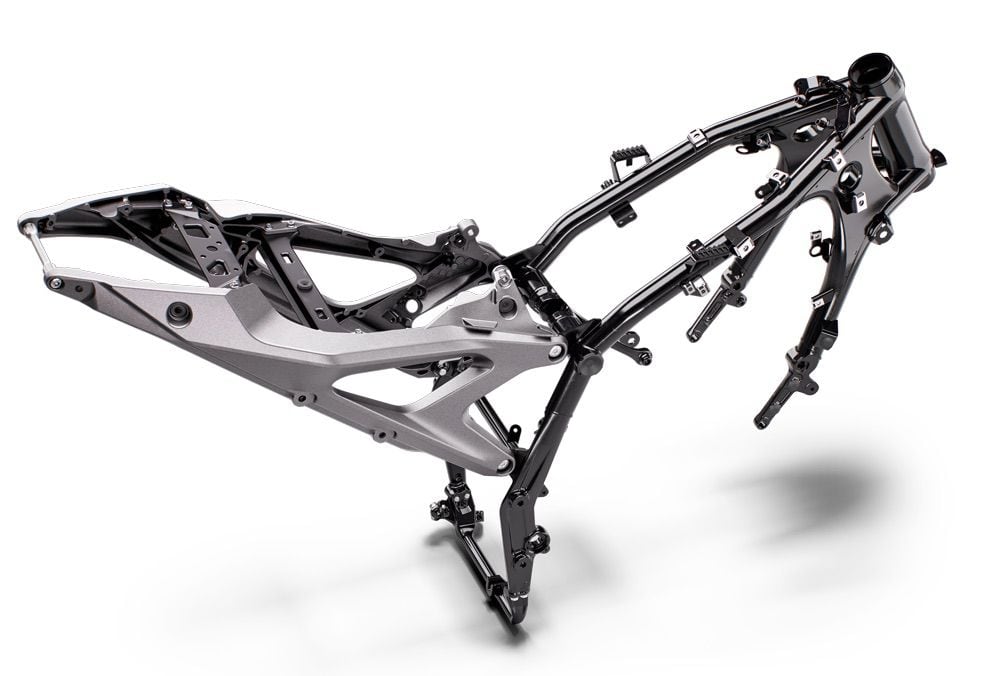
The 990 Duke’s frame is revised for increased rigidity. (KTM/)Forged-aluminum triple clamps hold a 43mm WP Apex fork with compression and rebound damping in separate legs; range of adjustment is designed to be easier with just five clicks for both.
A gas-assisted WP Apex shock uses a lighter linear spring, which together with all-new settings is claimed to improve comfort and responsiveness. Adjustment is limited to spring preload and rebound (five clicks).
The 1290 Super Duke R–culled wheels wear 120/70-17 and 180/55-17 sized rubber front and rear, but are modestly revised to work in the double-sided swingarm. Meanwhile, a pair of 300mm discs are used, which happens to be the same size rotor as is used on the 790 Duke, but smaller than the rotor on the more stout 890 Duke R. Is a 990 Duke R coming in the future? Past practices suggest that’s likely the case, and here’s where KTM might be leaving a little room for added performance.
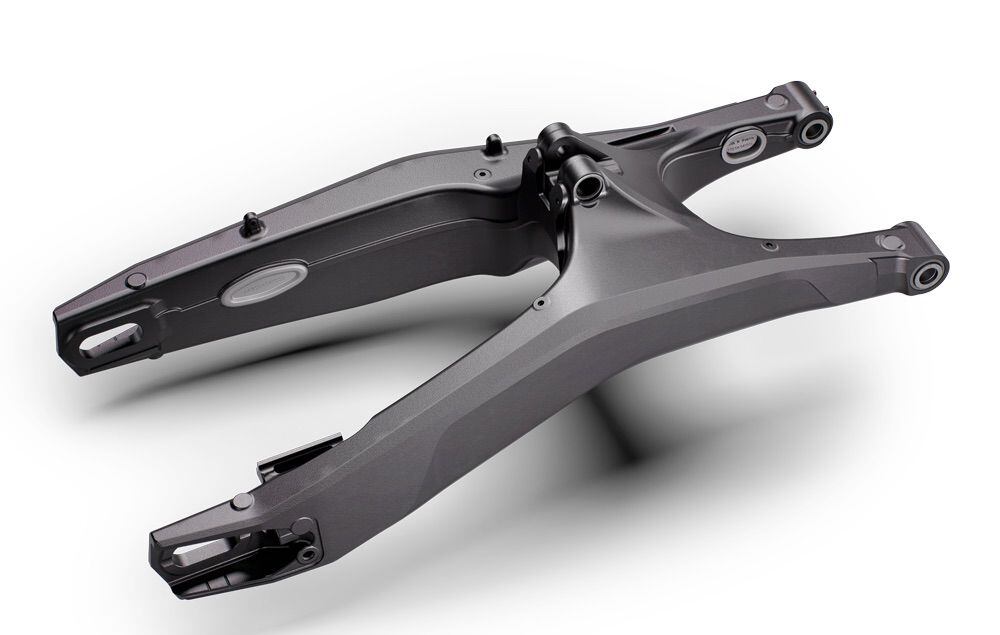
A new swingarm is gravity die-cast (versus pressure die-cast), resulting in a 3.3-pound weight savings. Stiffness is reduced for increased bump absorption. (KTM/)Styling and Ergonomics
While KTM says the 990 Duke has “larger proportions,” it doesn’t clarify exactly how the dimensions vary compared to the 790 Duke or 890 Duke R. What we do know is the 990 Duke has a minutely larger 3.8-gallon fuel tank with new lines that are sharp as ever. Those lines are carried through the rest of the bike, KTM very clearly sticking to its philosophy that “the sharper the lines, the better.” That design concept extends to the new and polarizing LED headlight.
The upright riding position is retained, though KTM has changed the seat shape to keep the rider from sliding forward. It has also raised the passenger seat 20mm (0.8 inch), for an unimpeded view.
Adjustability is limited to handlebar position; the one-piece bar can be moved to one of four positions by adjusting the position and rotation of the bar risers on the triple clamp.
More Details
The launch of the 990 Duke coincides with “30 years of Duke,” and KTM is celebrating that milestone with two colors: Electronic Orange and Black Metallic.
Exact pricing is not available, though sources suggest MSRP will come in at around $12,500. Bikes will be available in December.
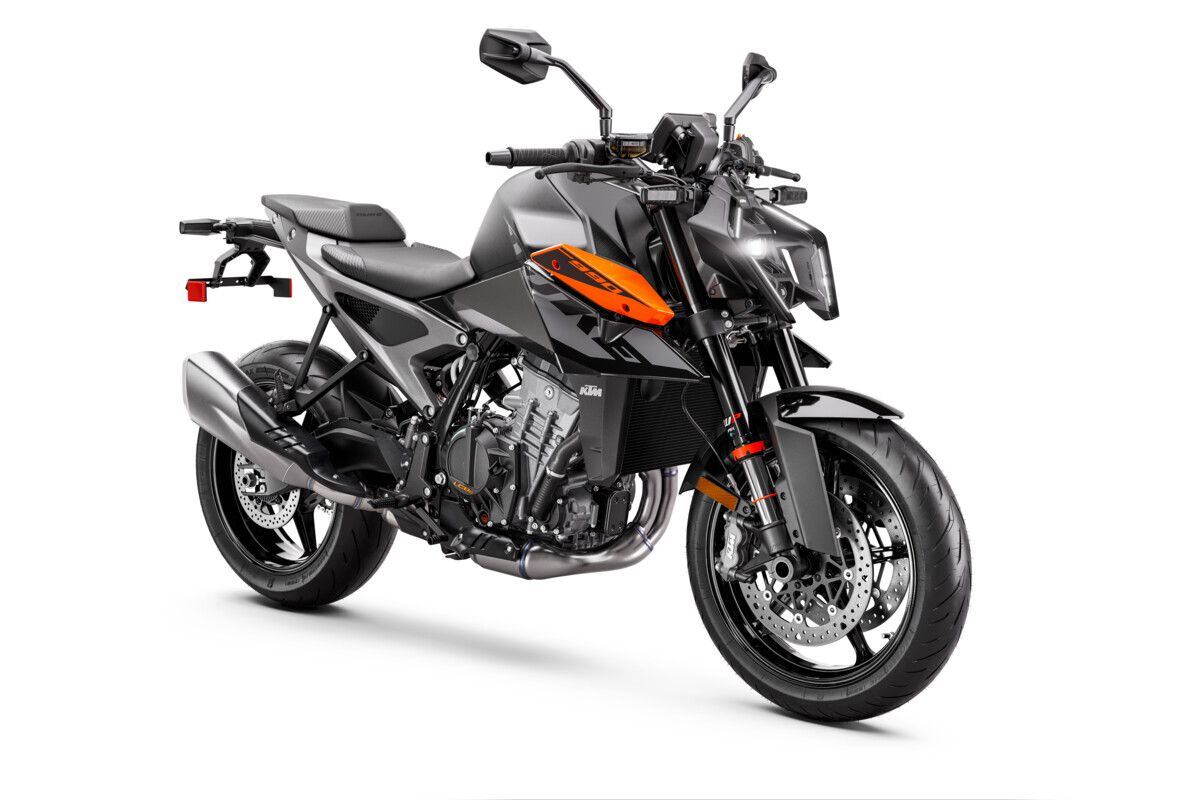
2024 KTM 990 Duke. (KTM/)2024 KTM 990 Duke Claimed Specs
MSRP: N/A Engine: DOHC, liquid-cooled, 4-stroke parallel twin Displacement: 947cc Bore x Stroke: 92.5 x 70.4mm Compression Ratio: N/A Transmission/Final Drive: 6-speed/chain Claimed Horsepower: 123 hp @ 9,500 rpm Claimed Torque: 76 lb.-ft. @ 6,750 rpm Fuel System: Electronic fuel injection Clutch: PASC (Power Assisted Slipper Clutch); cable actuation Engine Management/Ignition: Ride-by-wire/TCI Frame: Chromoly tubular steel Front Suspension: 43mm WP Apex USD fork, rebound and compression adjustable; 5.5 in. travel Rear Suspension: WP Apex shock, rebound and spring preload adjustable; 5.9 in. travel Front Brake: 4-piston calipers, 300mm discs (w/ ABS) Rear Brake: 2-piston caliper, 220mm disc (w/ ABS) Wheels, Front/Rear: Cast aluminum; 17 x 3.50 in. / 17 x 5.50 in. Tires, Front/Rear: 120/70-17 / 180/55-17 Rake/Trail: N/A Wheelbase: N/A Ground Clearance: 7.7 in. Seat Height: 32.5 in. Fuel Capacity: 3.8 gal. Claimed Wet Weight: 395 lb. Contact: ktm.com -
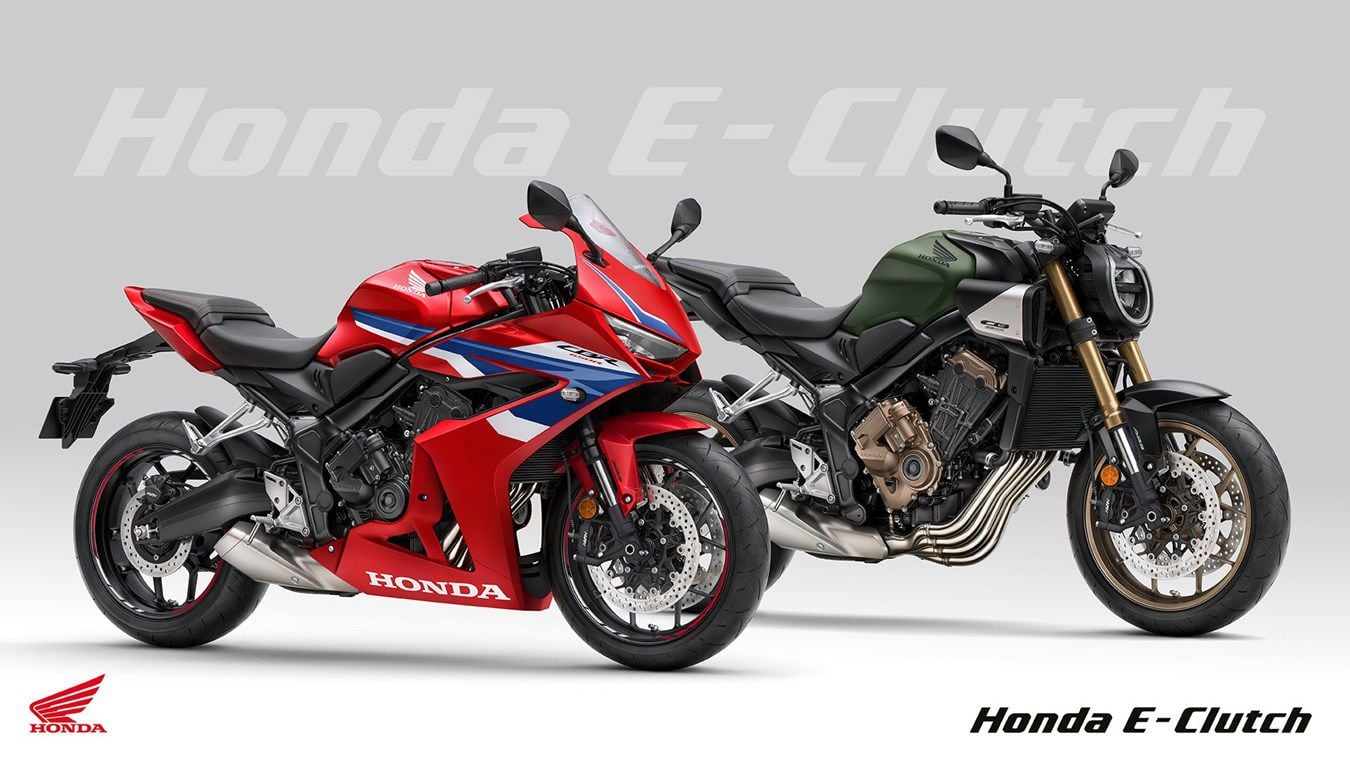
Honda’s 2024 CBR650R and CB650R get the recently announced E-Clutch in addition to updates to styling and electronics. (Honda/)Honda’s upgraded 2024 CB650R and its fully faired CBR650R sibling have been revealed at the EICMA show in Milan—including not only updated styling but a new TFT dash. More importantly they’re the first two Hondas to be offered with the company’s new E-Clutch option that promises to provide an unmatched level of versatility by allowing completely clutchless operation or letting you ride the bike using the conventional clutch lever.
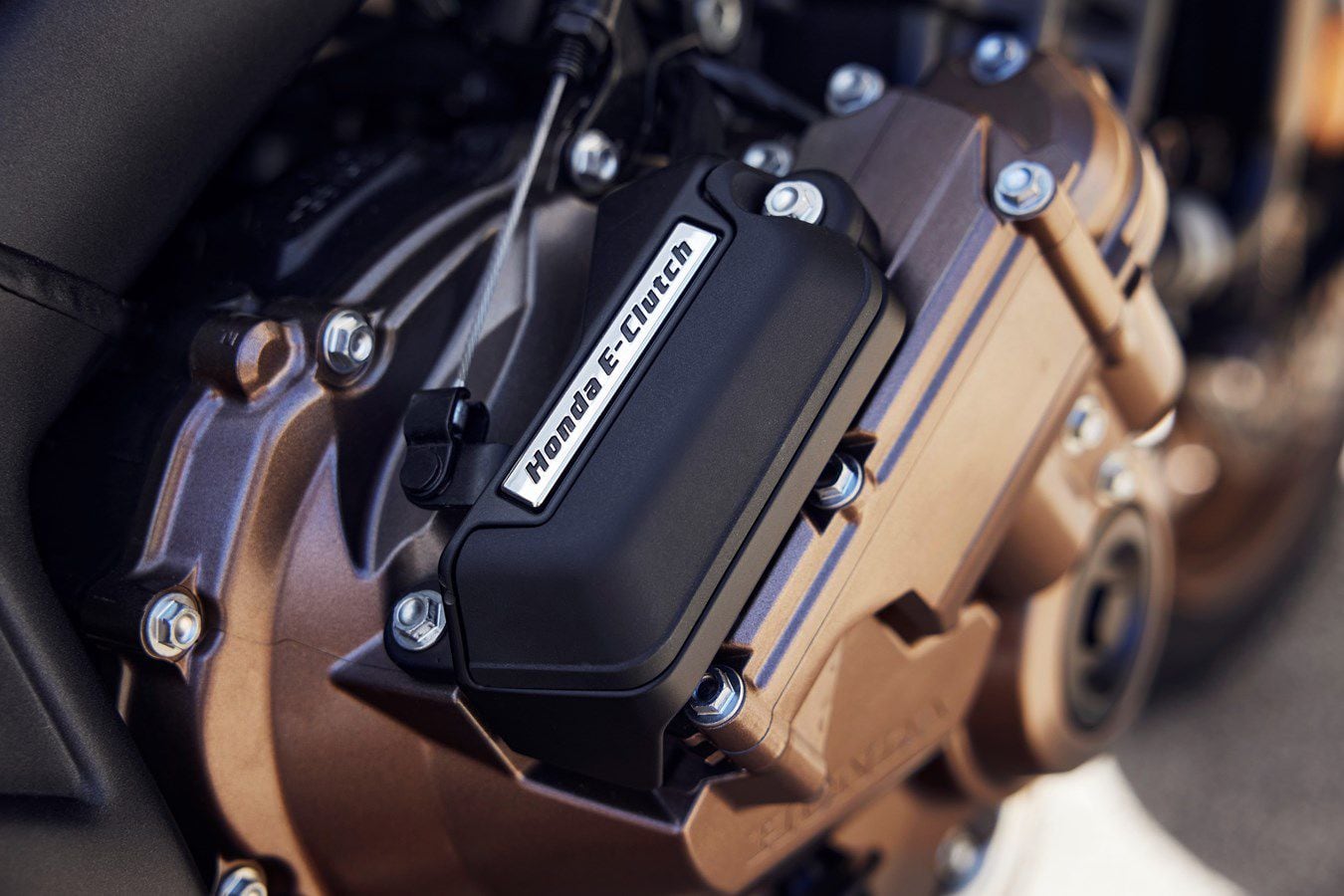
The 2024 Honda CBR650R and CB650R will be available with Honda’s new E-Clutch as an option. (Honda/)As in the past, the CB650R and CBR650R are mechanically identical, sharing the same 649cc inline four-cylinder engine and the same steel-tube chassis of last year’s models. There’s no change to peak power, remaining at 94 bhp at 12,000 rpm, with max torque of 46.5 lb.-ft. at 9,500 rpm, tamed by Honda’s HSTC traction-control system. The bikes’ suspension is also unaltered, with 41mm Showa SFF-BP forks and matching shocks, plus Tokico four-pot radial-mount front brakes and 310mm rotors with ABS as standard.
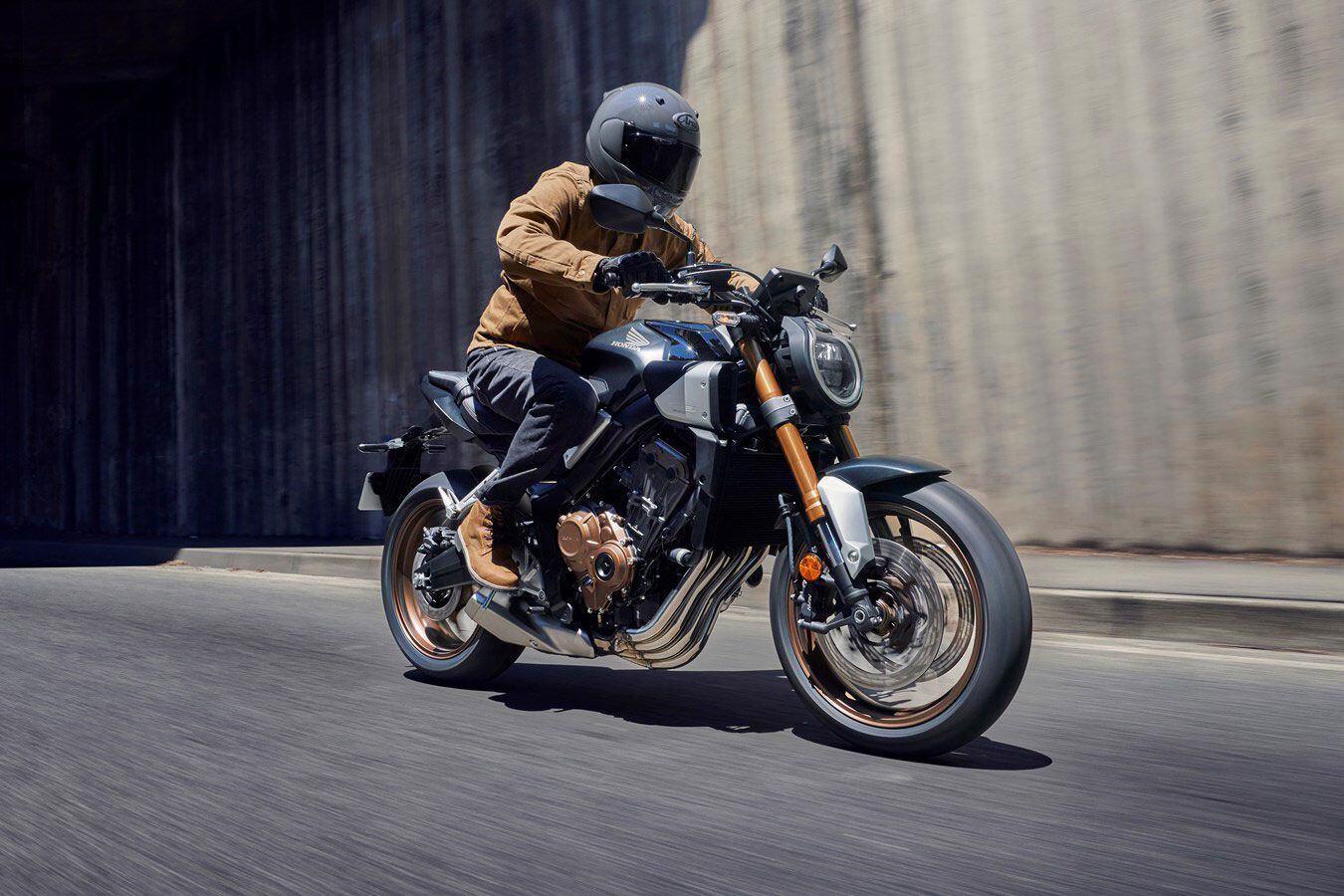
The 2024 Honda CB650R sticks with the Neo Sports Café styling. (Honda/)What is new is the styling. The CB650R keeps the signature Neo Sports Café style that was first previewed with the 2015 CB4 Concept, but for 2024 it gets revamped with the drooping LED headlight design from the CB1000R, a shorter, sharpened tail, and redesigned radiator cowls. On the CBR650R, the rear-end changes are the same, but a new front fairing takes its inspiration from the latest-generation CBR1000RR.
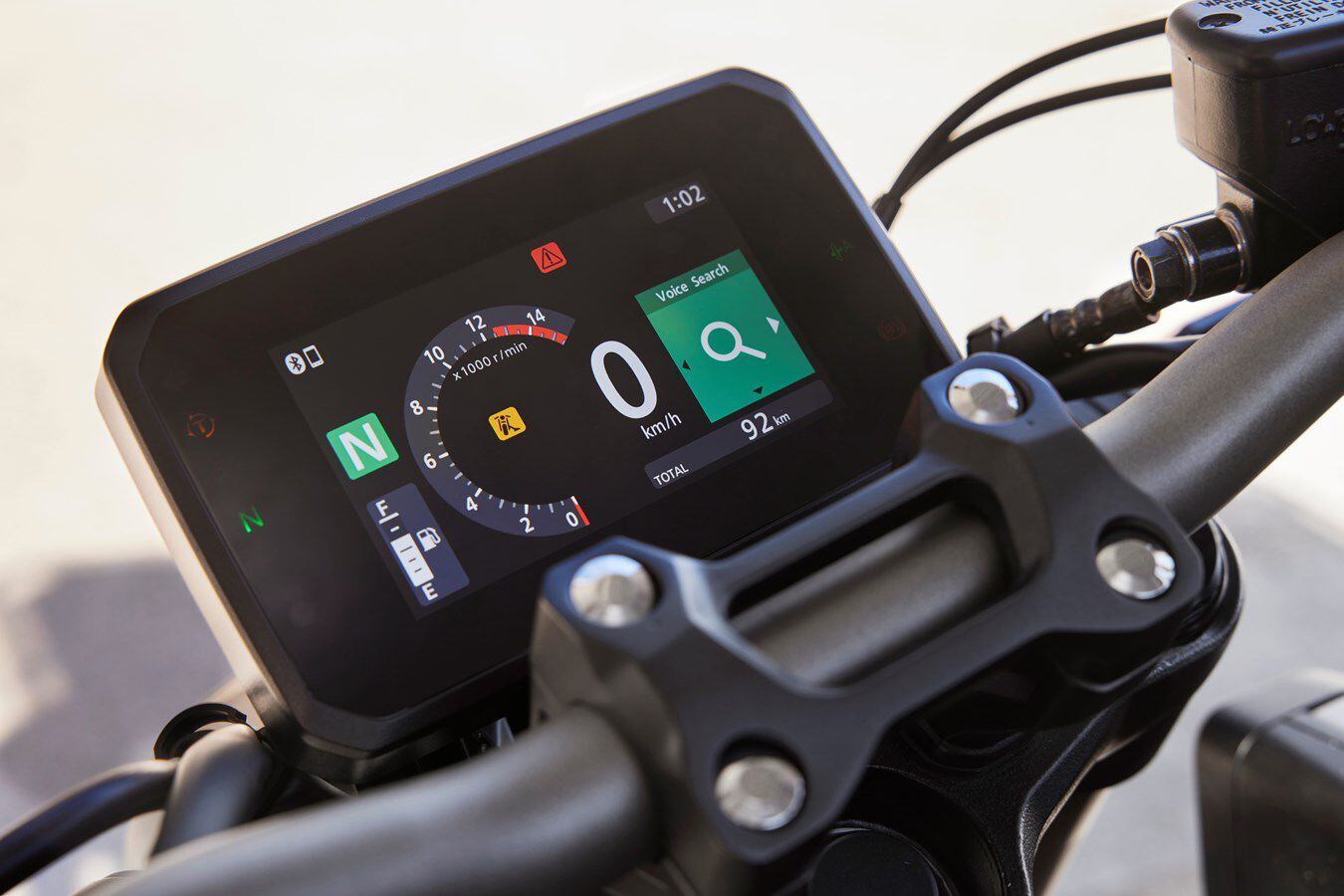
Both models get full-color TFT displays and backlit handlebar controls. (Honda/)On board, both bikes finally join the 2020s with a full-color TFT dash, plus new backlit bar controls to operate it, which gives phone connectivity and turn-by-turn navigation via Honda’s RoadSync app. Under the seat is a USB-C socket to charge modern phones (under the latest EU laws, phones have all adopted USB-C, even forcing Apple to ditch its proprietary Lightning connector on the latest iPhone).
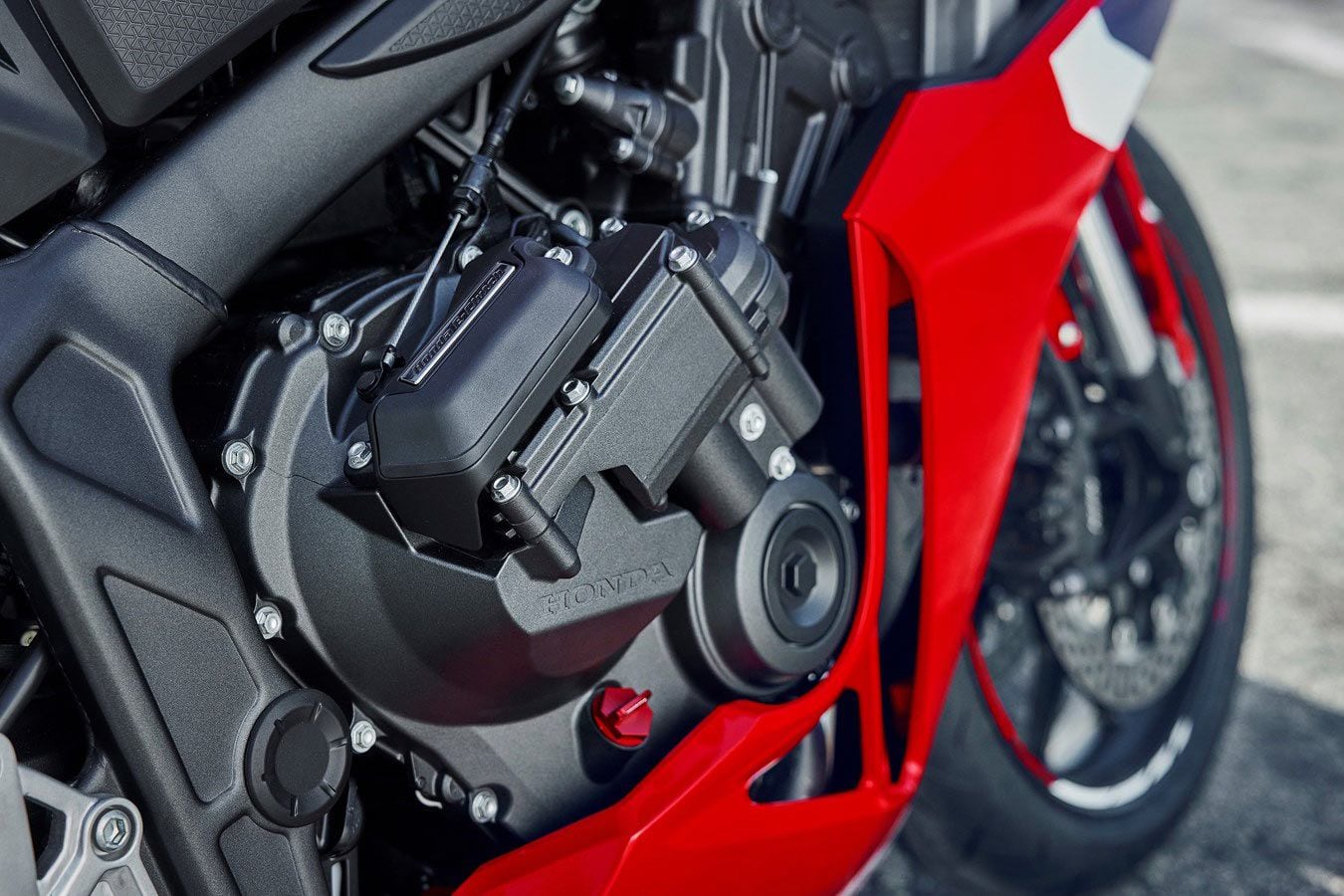
From the outside, the E-Clutch is visible as an external bulge on the engine case cover. (Honda/)The big news, however, is the E-Clutch, which Honda previewed a few weeks ago and has now been confirmed to be debuting on the CB650R and CBR650R. Available as an option, it’s a servo-operated clutch that retains the conventional, cable-operated manual lever allowing it to be overridden by the rider at any time. In operation, the E-Clutch uses two electric motors, controlled by its own ECU, to engage and disengage the clutch. The servo is mounted in a modified clutch cover and the whole package is compatible with exactly the same assist-and-slipper clutch unit and bar controls used on the normal, manual models. It adds just 4.4 pounds to the weight of the bikes.
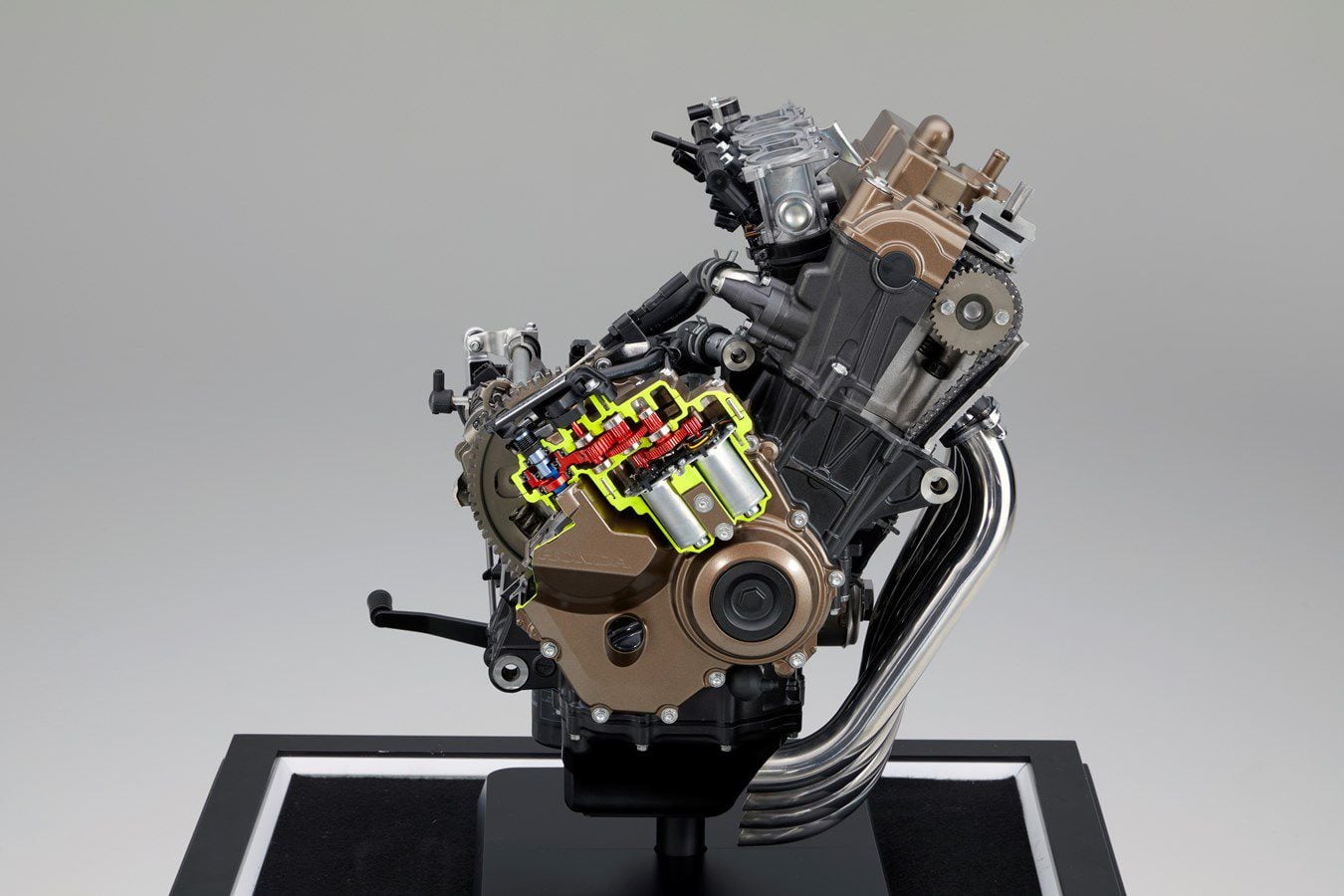
This cutaway image shows the mechanical internals of the E-Clutch. (Honda/)In operation, the E-Clutch uses a load sensor mounted in the gearshift linkage—essentially the same sort of electronics used in quickshifters—to tell the clutch when you want to change ratios. There are three presets to alter the sensitivity of the system (hard, medium, and soft), and the E-Clutch ECU combines with the engine’s ignition and injection system to ensure the smoothest shifts possible, both up and down through the ratios, without the need to use the bar-mounted lever.
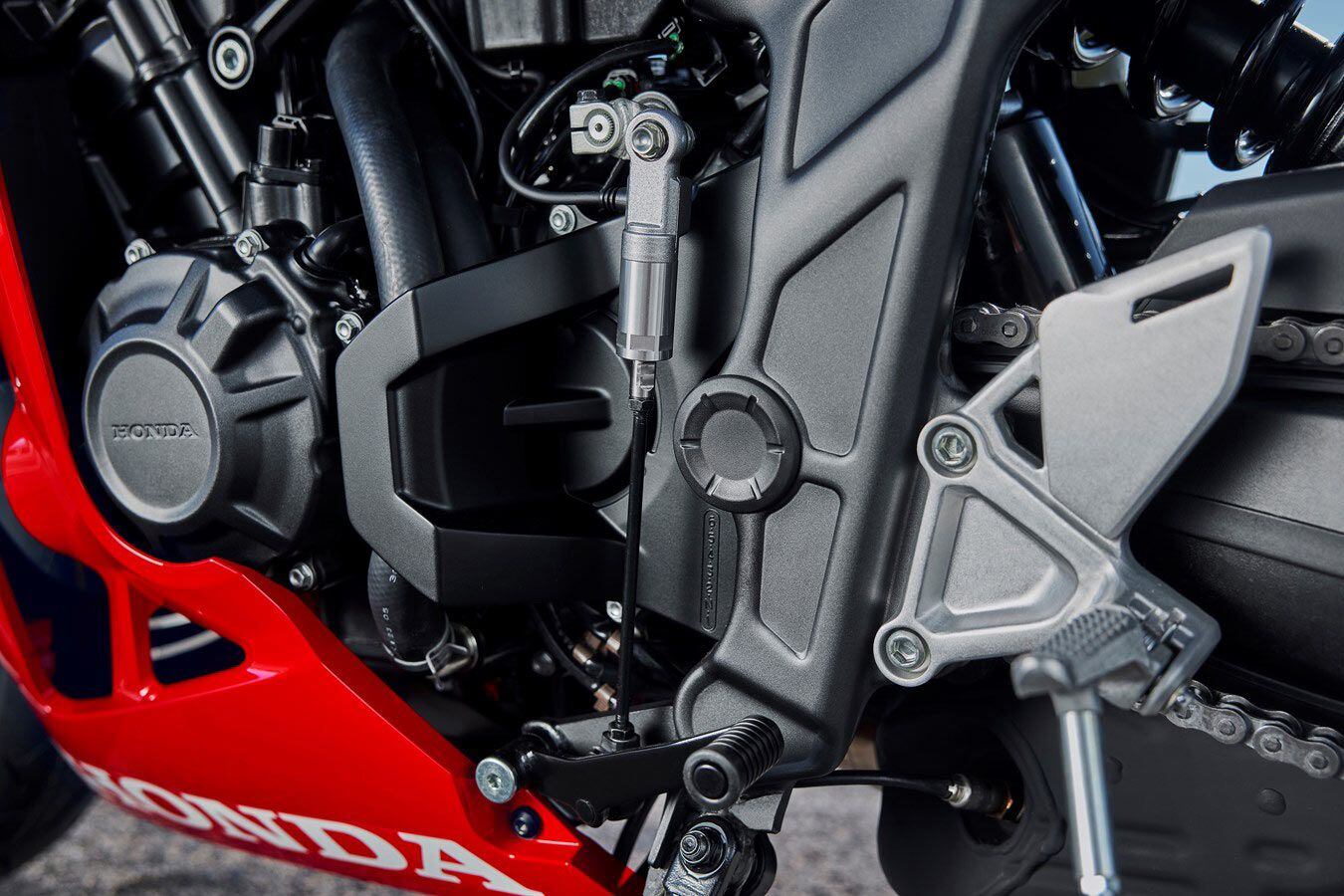
The E-Clutch uses a load sensor similar to a quickshifter to tell the clutch what action to take. (Honda/)Although some quickshifters perform a similar role once on the move, the E-Clutch also means you can start and stop without having to touch the lever on the bars. From a standstill, you simply select first gear and open the throttle—the E-Clutch will balance the clutch with the throttle input to make it impossible to stall and allow a smooth getaway. Come to a halt, and the E-Clutch disengages drive before the engine can stall, even without your pulling the lever in. Prefer to take control yourself? Simply select the manual mode on the dash and the bikes are completely conventional, and even when the E-Clutch is active you can override it at any time using the lever on the bars.
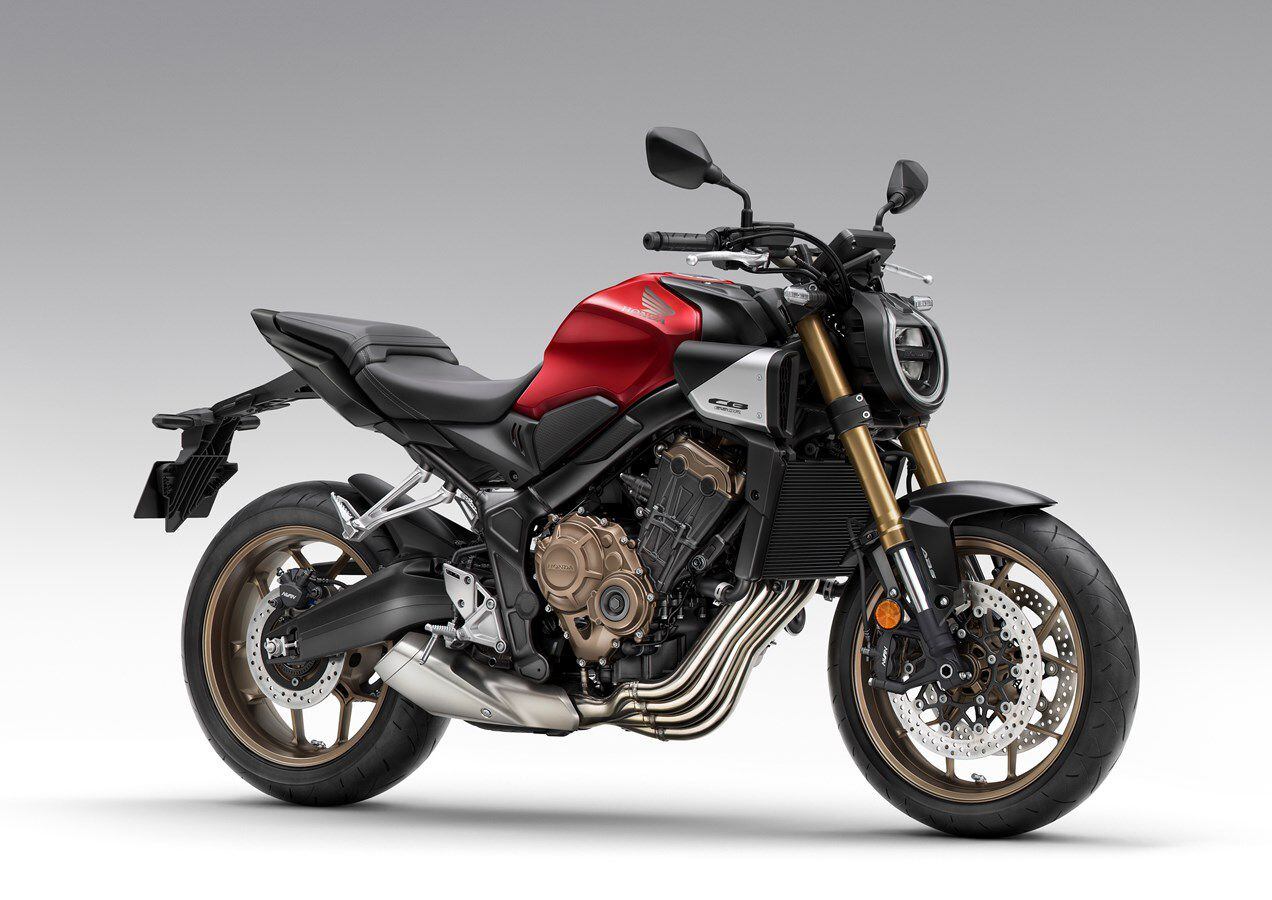
2024 Honda CB650R in red. (Honda/)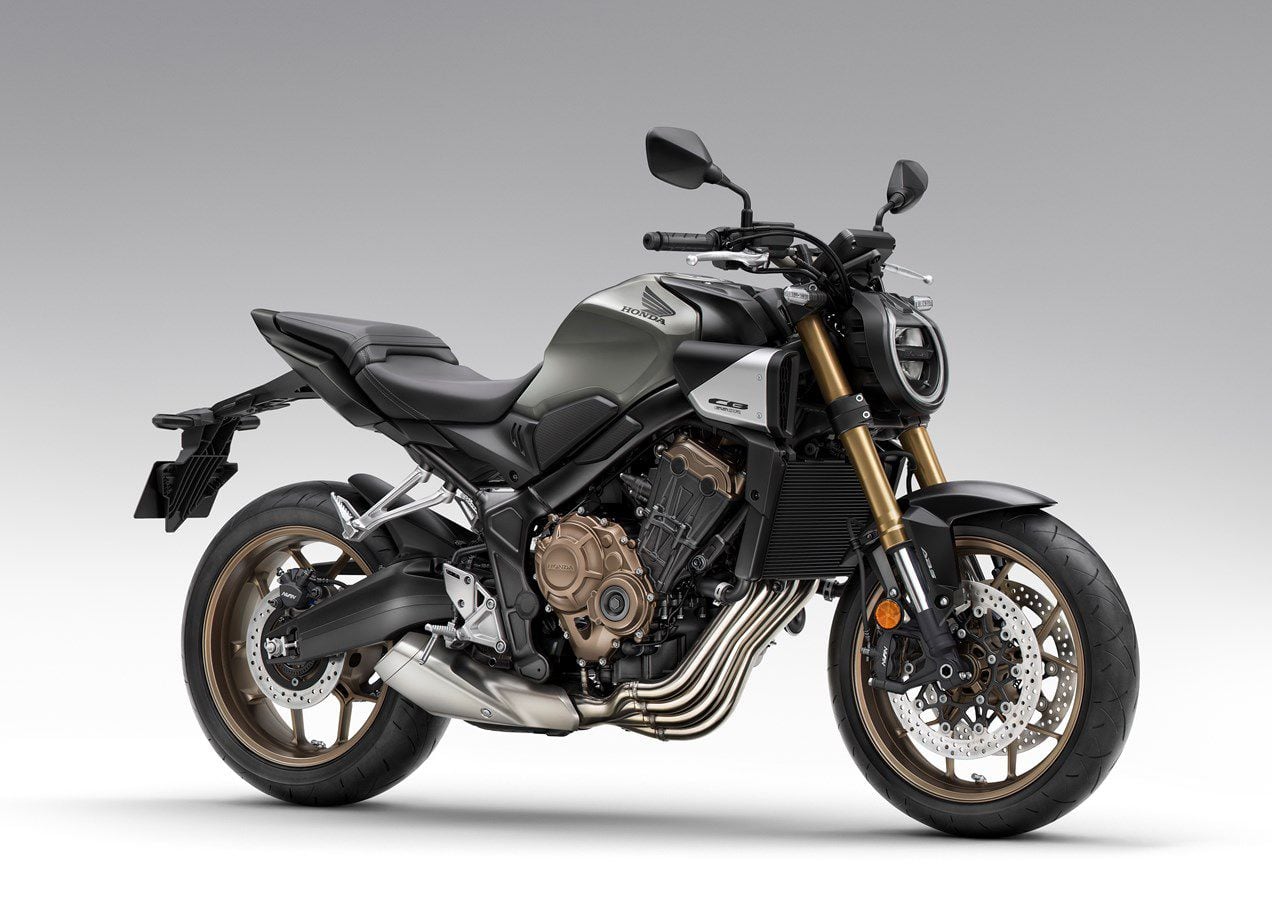
2024 Honda CB650R in gray. (Honda/)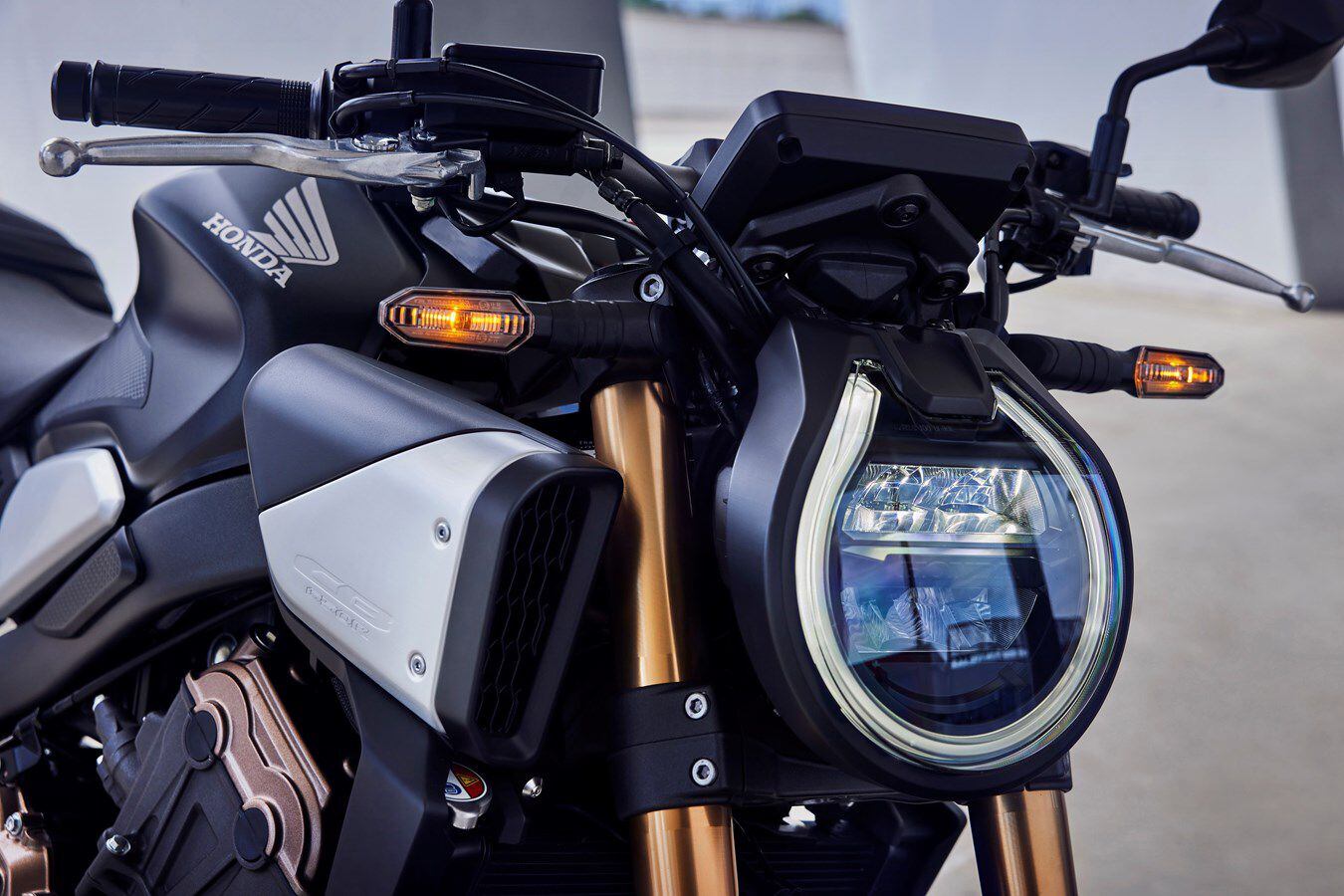
2024 Honda CB650R front styling. (Honda/)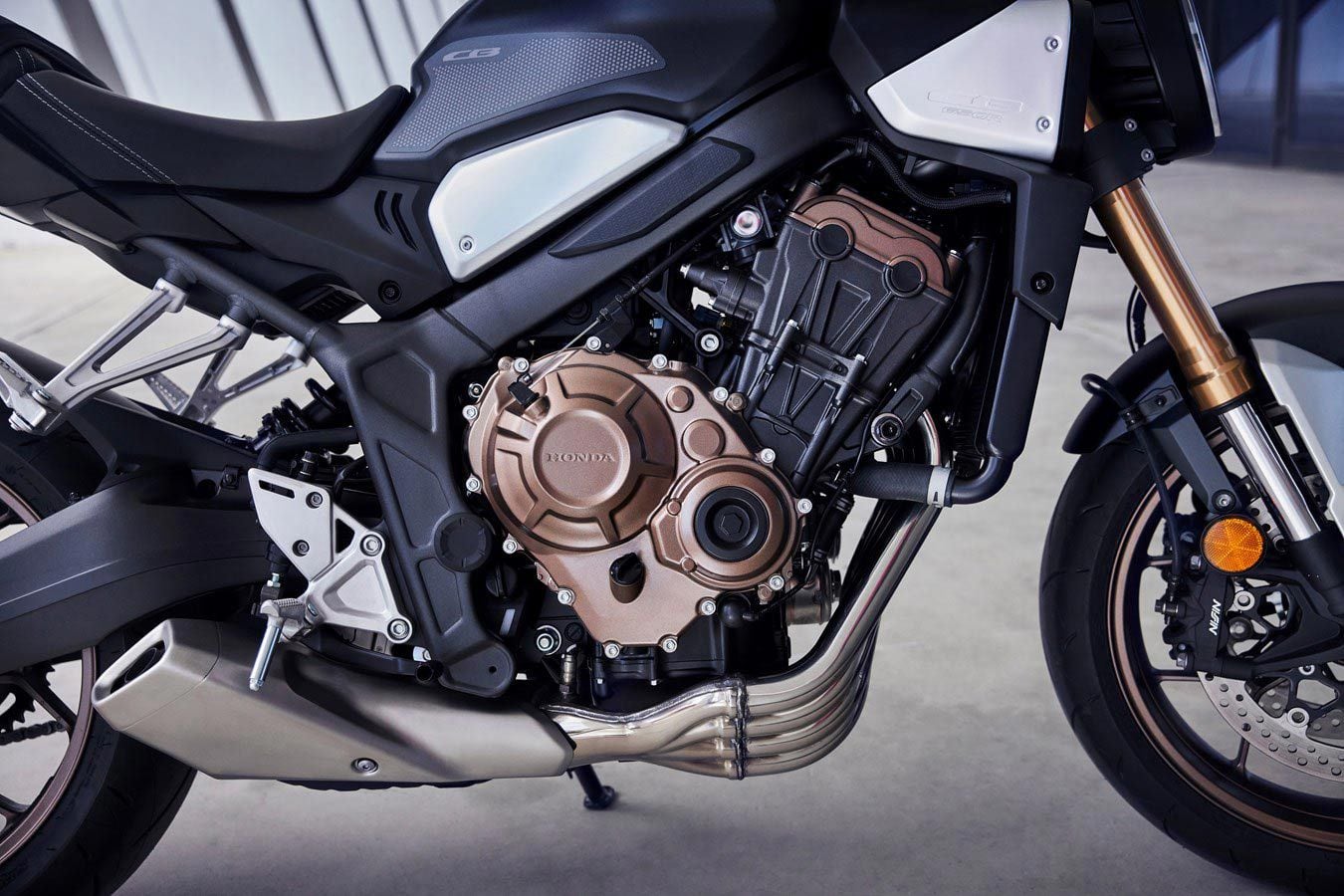
2024 Honda CB650R’s engine. (Honda/)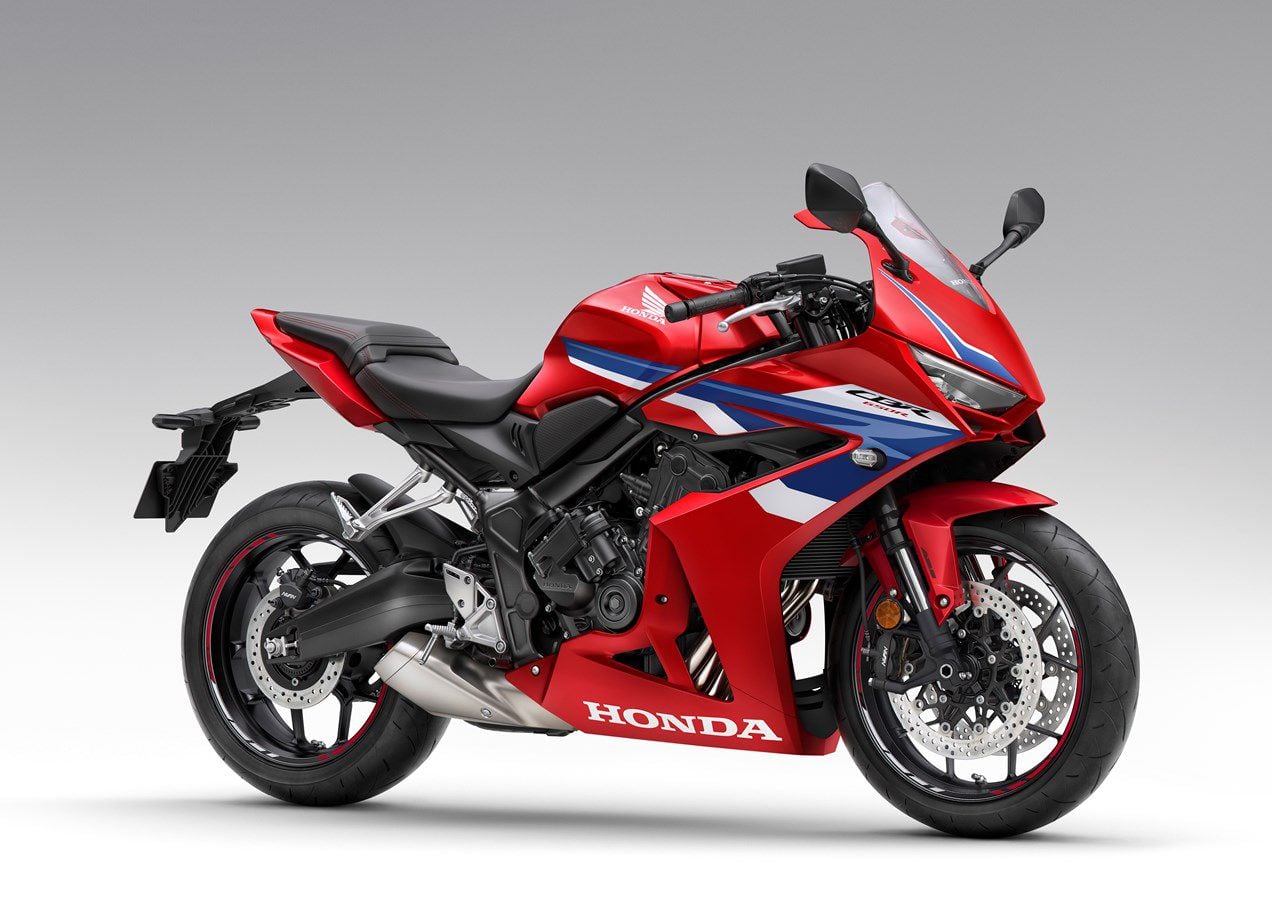
2024 Honda CBR650R gets the optional E-Clutch, new electronics, and updated styling. (Honda/)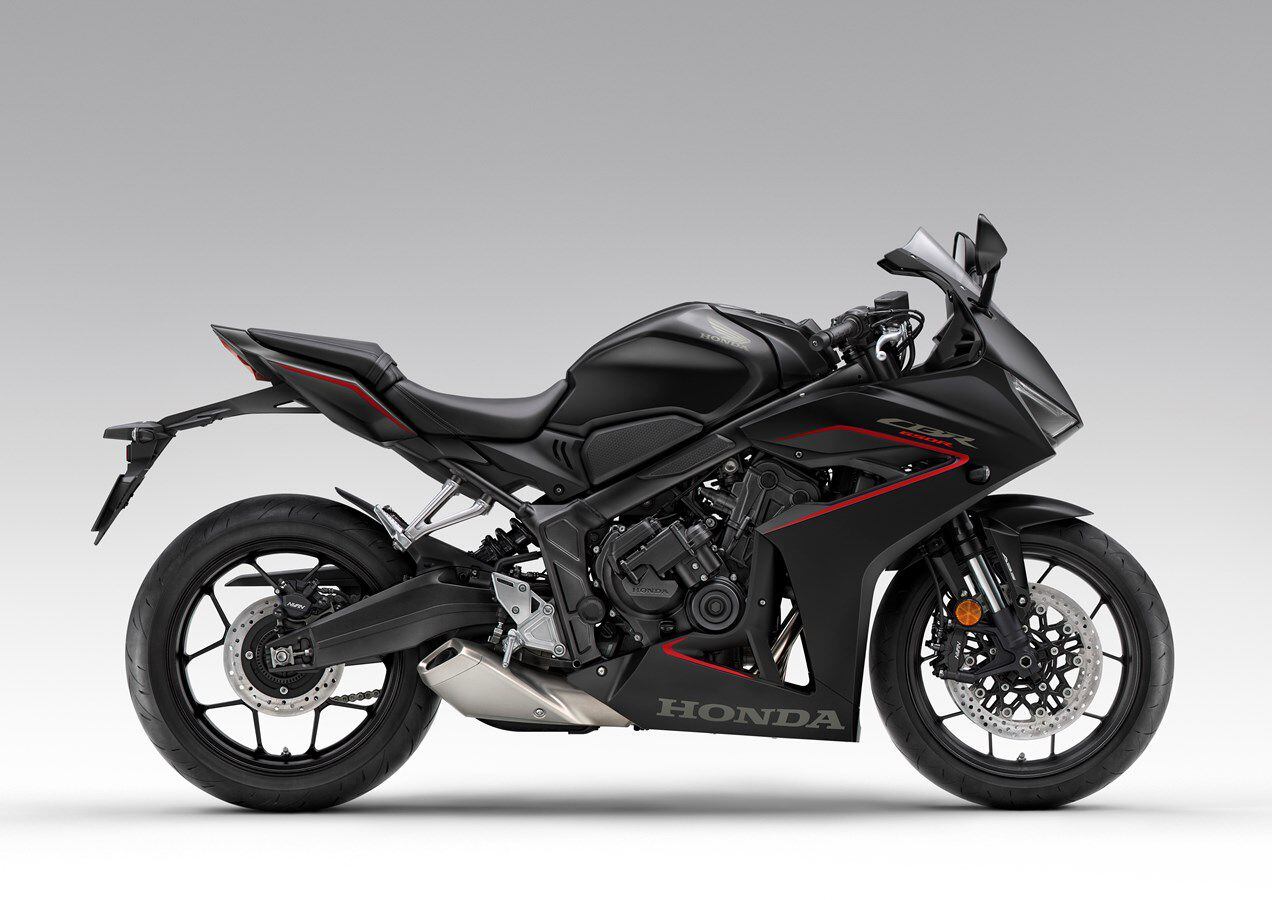
2024 Honda CBR650R in black. (Honda/)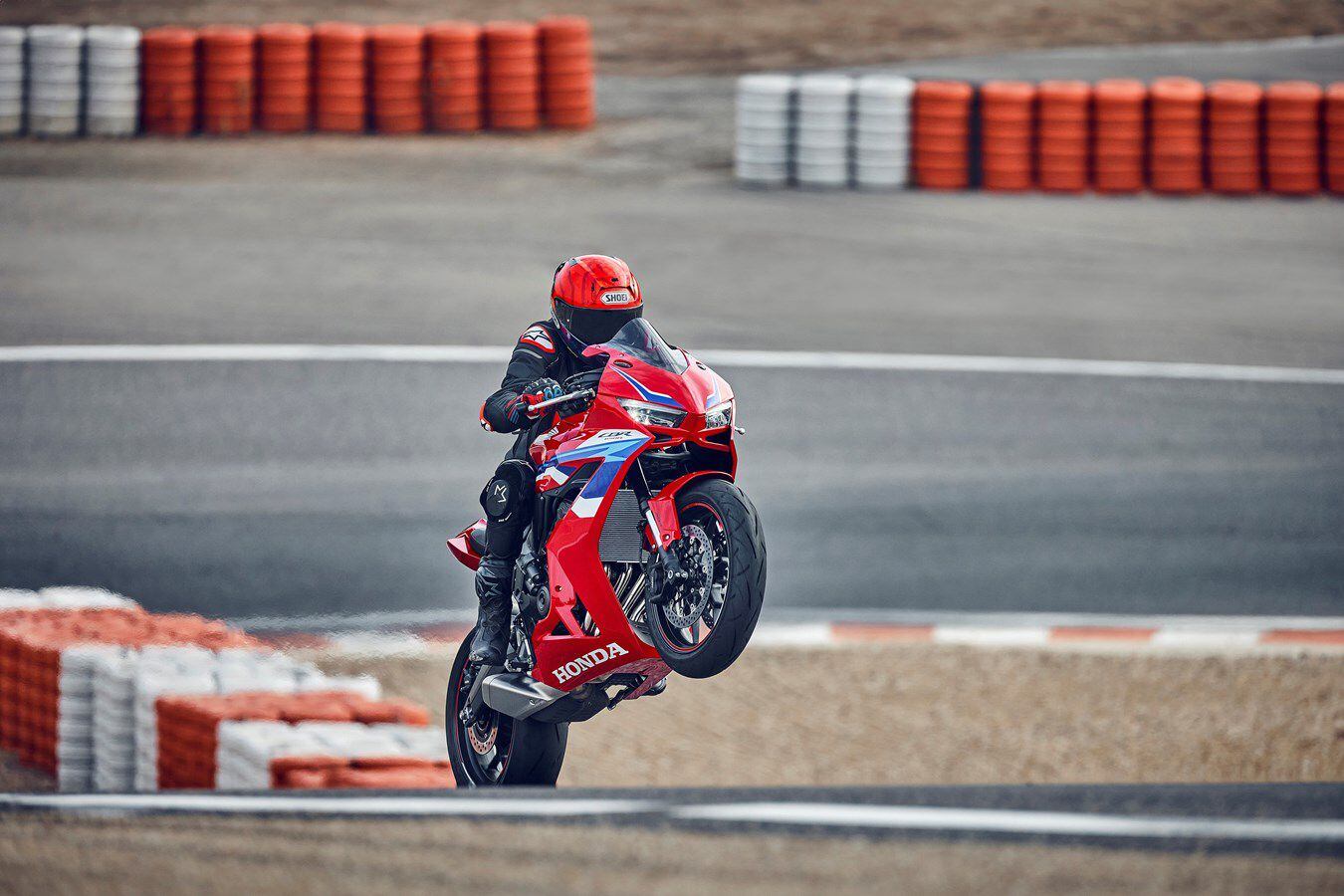
Honda CBR650R wheelies into 2024. (Honda/)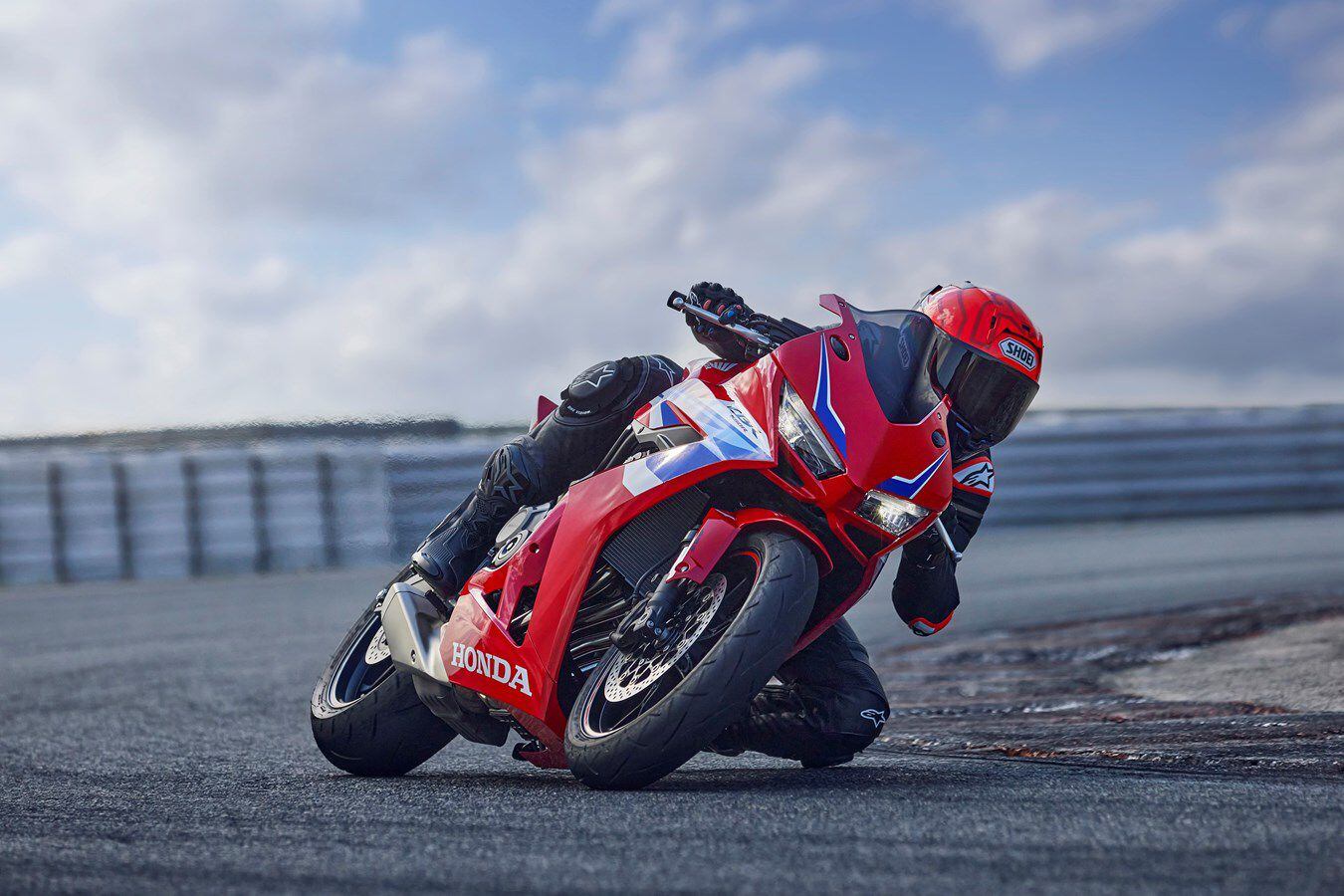
2024 Honda CBR650R action. (Honda/)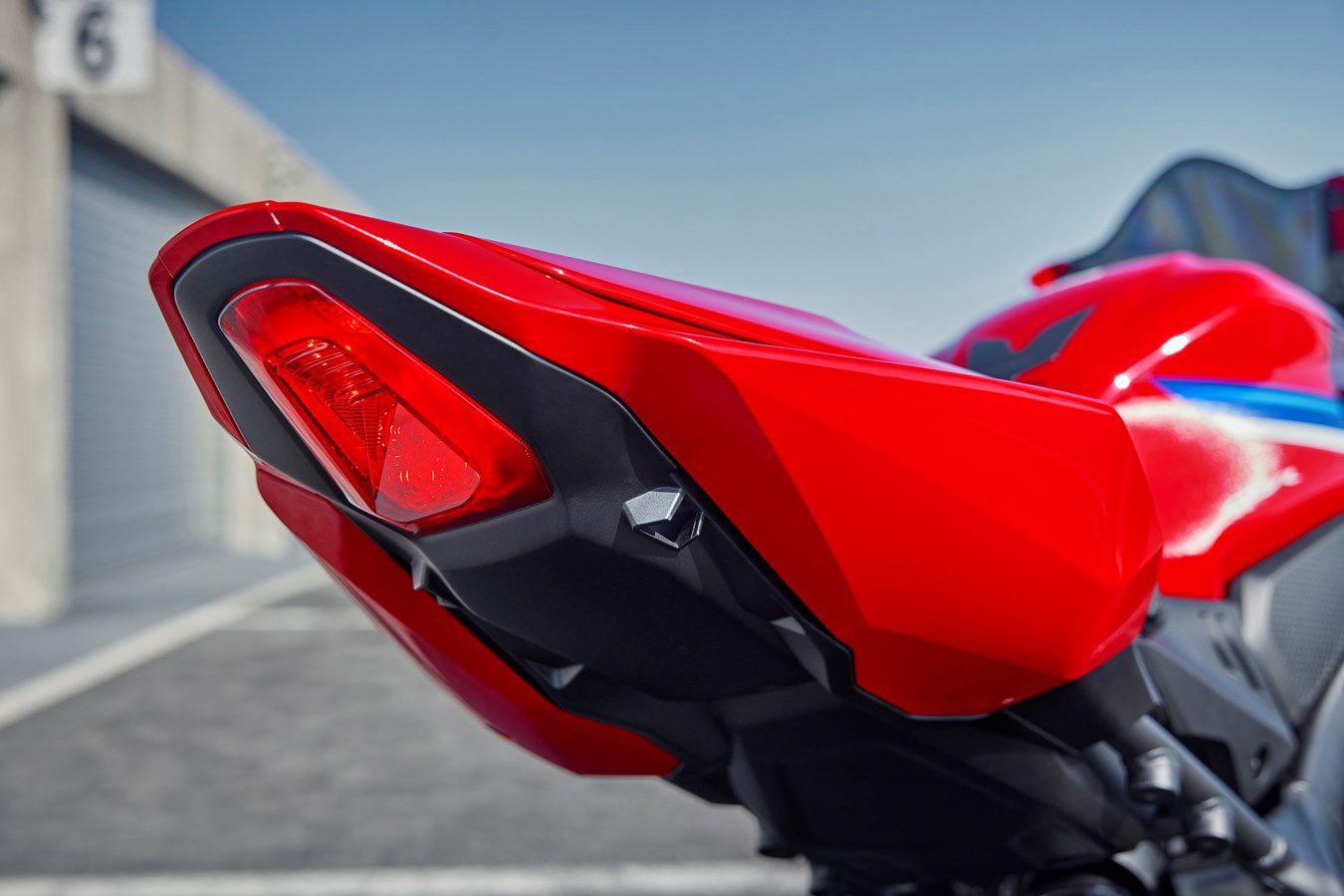
2024 Honda CBR650R’s new tailsection. (Honda/)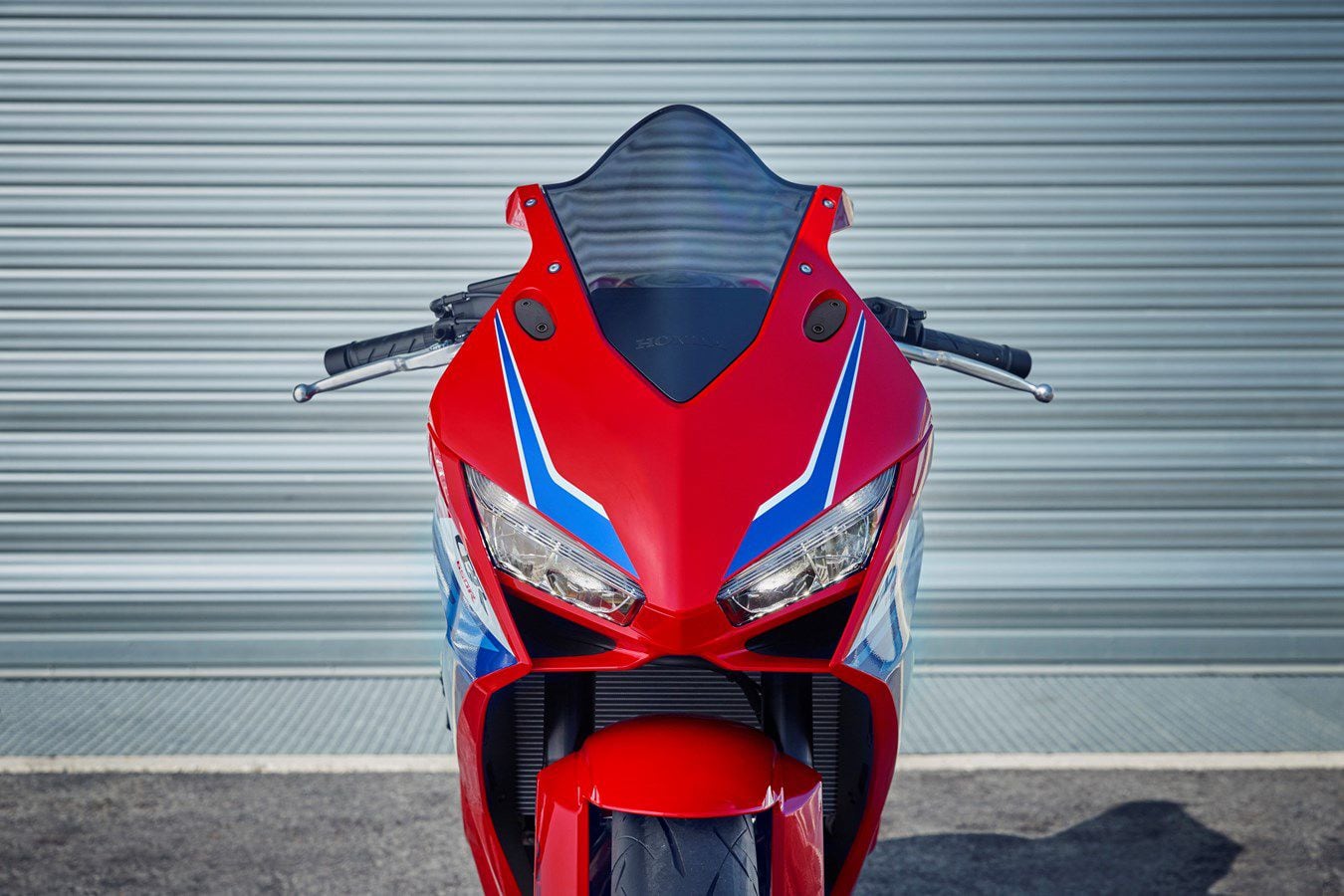
2024 Honda CBR650R’s front fairing now resembles the CBR1000RR. (Honda/)2024 Honda CB650R/CBR650R Specs
MSRP: TBA Engine: DOHC, liquid-cooled, four-stroke inline-four; 4 valves/cyl. Displacement: 649cc Bore x Stroke: 67.0 x 46.0mm Compression Ratio: 11.6:1 Transmission/Final Drive: 6-speed/chain Claimed Horsepower: 94.0 hp @ 12,000 rpm Claimed Torque: 46.5 lb.-ft. @ 9,500 rpm Fuel System: PGM-FI electronic fuel injection Clutch: Wet, multiplate; cable actuation; optional E-Clutch Engine Management/Ignition: Full transistorized Frame: Twin-spar, steel diamond Front Suspension: 41mm inverted Showa SFF-BP fork Rear Suspension: Showa shock, preload adjustable Front Brake: Dual radial-mounted 4-piston Tokico hydraulic calipers, floating 310mm discs w/ ABS Rear Brake: 1-piston caliper, 240mm disc w/ ABS Wheels, Front/Rear: Cast aluminum; 17 in./17 in. Tires, Front/Rear: 120/70-17 / 180/55-17 Rake/Trail: 25.5°/3.9 in. Wheelbase: 57.1 in. Ground Clearance: 5.9 in. / 5.1 in. (CBR650R) Seat Height: 31.9 in. Fuel Capacity: 4.1 gal. Claimed Wet Weight: 452 lb.; 456 lb. E-Clutch / 461 lb.; 465 lb. E-Clutch (CBR650R) Contact: powersports.honda.com -

Honda introduces the CB1000 Hornet as an all-new model. (Honda/)Honda’s been offering the CB1000R based on old-generation CBR1000RR tech for many years, but for 2024 there’s a new approach and style in the form of the CB1000 Hornet.
Adopting the “Hornet” title to conform with the CB750 Hornet and the newly launched CB500 Hornet, the upcoming CB1000 Hornet also takes on their approach, dropping the old CB1000R’s exotic, semi-retro style and single-sided swingarm in favor of a more straightforward roadster look and tech.

The 2024 Honda CB1000 Hornet utilizes the 2017-spec CBR1000RR engine with a new twin-spar steel frame and features three switchable ride modes. (Honda/)Underneath, a new twin-spar steel frame replaces the CB1000R’s spine-style design, and it carries the 2017-spec CBR1000RR engine in retuned form, including three riding modes, an assist and slipper clutch, and Honda’s HSTC traction control system. At the back is a dual-sided swingarm instead of the CB1000R’s single-sider, with a Showa monoshock and Pro-Link rising-rate linkage, while the front suspension is a USD Showa SFF-BP fork, fully adjustable for rebound and preload damping.
Radial four-pot brakes grip lightweight 310mm rotors at the front, and the tires are the 17-incher you’d expect, with a 120/70 front and 180/55 rear. A 5-inch TFT dash with phone connectivity via Honda’s RoadSync app is standard, along with full LED lighting.

Honda fitted the 2024 Honda CB1000 Hornet with Showa’s SFF-BP USD fork and a Showa monoshock with Pro-Link rising-rate linkage. (Honda/)Not expected to reach dealers until the middle of 2024 at the earliest, the CB1000 Hornet has still to reveal its full specifications. In terms of power, Honda says only that it makes “over” 147.5 bhp and has “more than” 73.8 lb.-ft. of torque. There’s no word yet on weight or other dimensions, and it’s unclear whether the new model will replace the CB1000R or supplement it in Big Red’s range.
-
 1
1
-
-
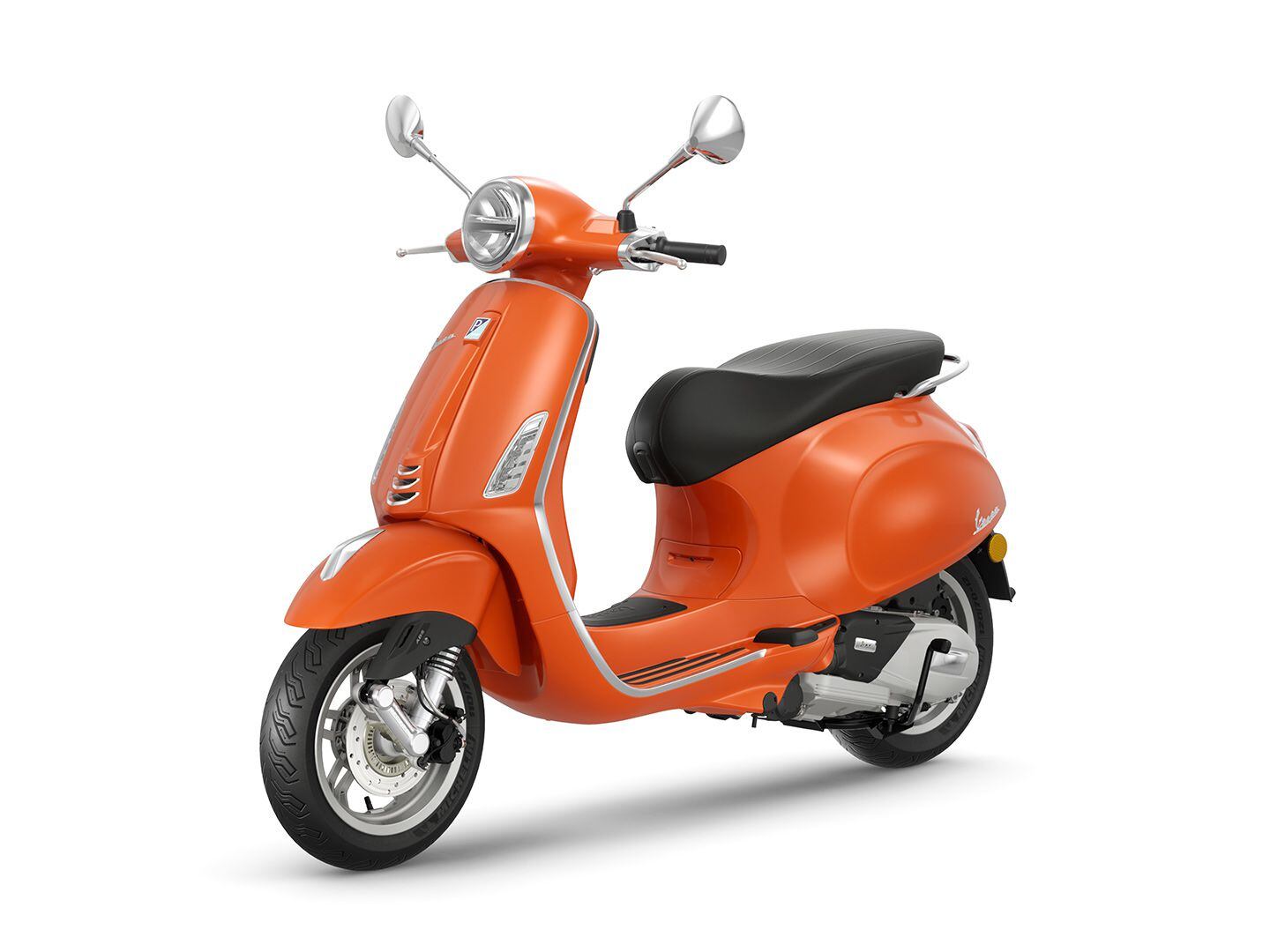
Vespa’s Primavera and Sprint S models get a refresh for 2024. (Vespa/)Vespa remains a unique case in the world of motorized two-wheel vehicles and a success that keeps growing after 77 years. It is through competence and hard work by the Piaggio Group that in fact there have been times when Vespa was the main pillar of the company, compensating for the losses generated by poor performance of Aprilia and Moto Guzzi in the past.
In 2003, the advent of the completely renewed Vespa 200 GT marked the start of the uninterrupted climb of Vespa success that Piaggio continues to develop with strong investments to cyclically update and upgrade. Never major changes—Vespa is Vespa forever, but well-calibrated touches keep gratifying the immense crowd of Vespa enthusiasts and lovers. This time it’s the turn of the “small body” models: the Primavera and the Sprint.

Vespa’s small-body Primavera and Sprint S come in three displacements: 50, 125, and 150cc. (Vespa/)In 1968, the 125cc Primavera was extracted from the tiny 50cc Vespa, and it was a big success. It was much more accessible than the regular Vespa 125 model, and it was young and zippy. The Sprint variation followed a few years later. The Vespa Primavera family was renewed in 2013 to become a lighter and more agile city commuter alternative to the larger GTS models. Ten years later, the Vespa Primavera and Sprint have now gotten their stamped steel sheet unibody structures revised. While still more compact and lighter than the upper-class Vespa GTS models, looks are stronger and richer with more refinement overall.
The handlebar now is fully enclosed with new grips and switch gear. New also is the inner side of the front shield, now a high-quality look and feel. The Primavera adopts a set of elegant five double-spoked cast aluminum wheels, while Sprint tries to be more aggressive with a set of elaborated six-spoked wheels.
Sprint shows its personality in a number of graphic touches in the “necktie” that splits the front shield, but in reality it is just a matter of well-placed color flashes. A major difference comes from the headlight, which is rounded on the Primavera and hexagonal on the Sprint. Both units are full LED technology.
Gasoline Power
Both the Primavera and Sprint S share the same range of power units: three “burning” and two “turning.” The four-stroke engines come in 50, 125, and 150cc sizing and are all SOHC three-valve air-cooled in design. All are fully Euro 5 emission compliant. The 150cc unit is particularly strong at more than 14 hp with a very solid torque curve that is smartly multiplied by the centrifugal clutch CVT transmission.
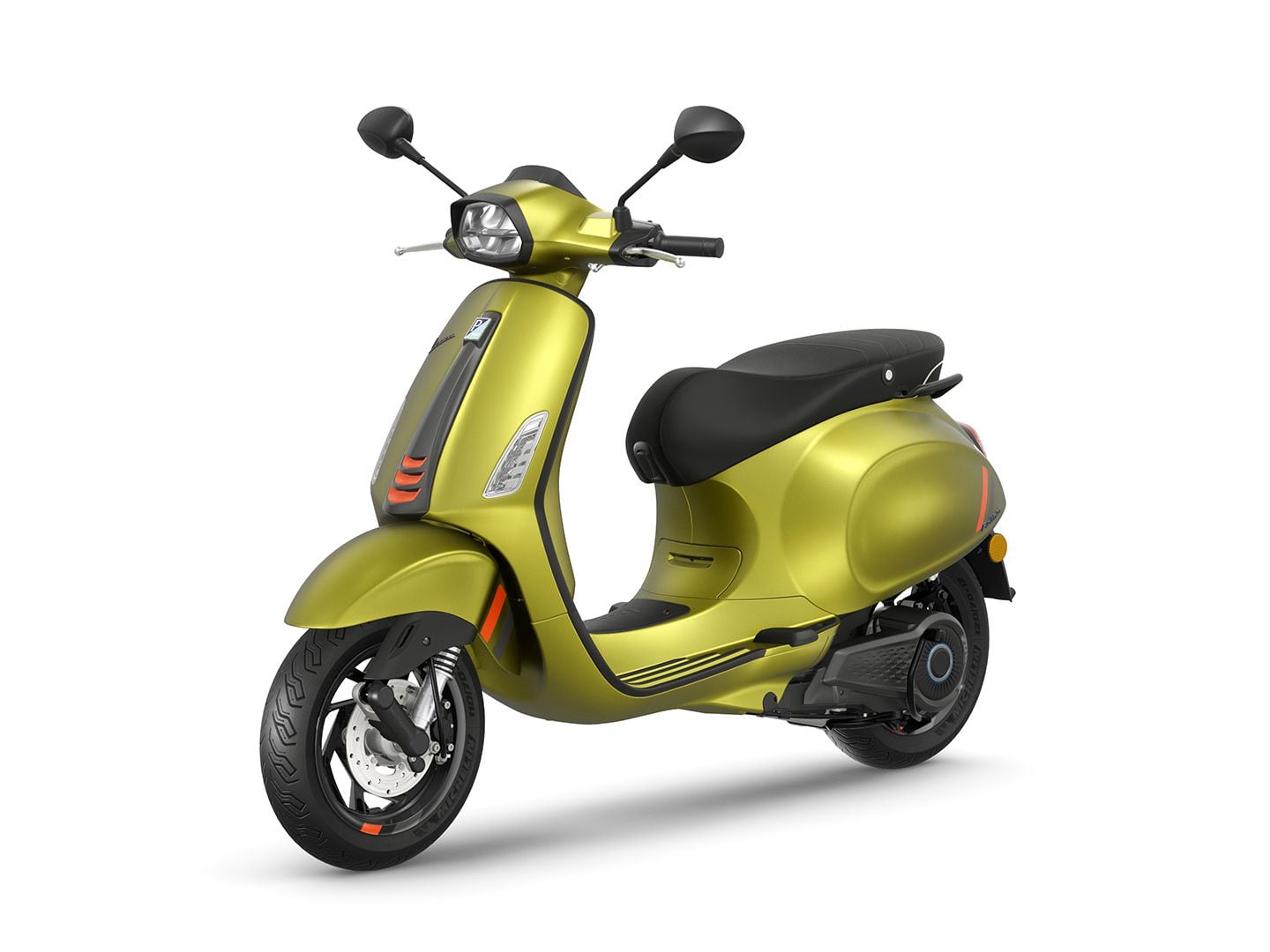
Two electric power options are available for both the Sprint (shown) and Primavera models. (Vespa/)Electric Power
Electric motor models come in two levels of power. A moped version, good for speeds not exceeding 28 mph. The motorcycle version is expected to exceed 60 mph. The e-Primavera and e-Sprint S draw from the experience the Piaggio technicians gathered with the Vespa Elettrica of 2021. The technology has progressed and the “moped” power version is equipped with easily removable batteries that can be charged at home.
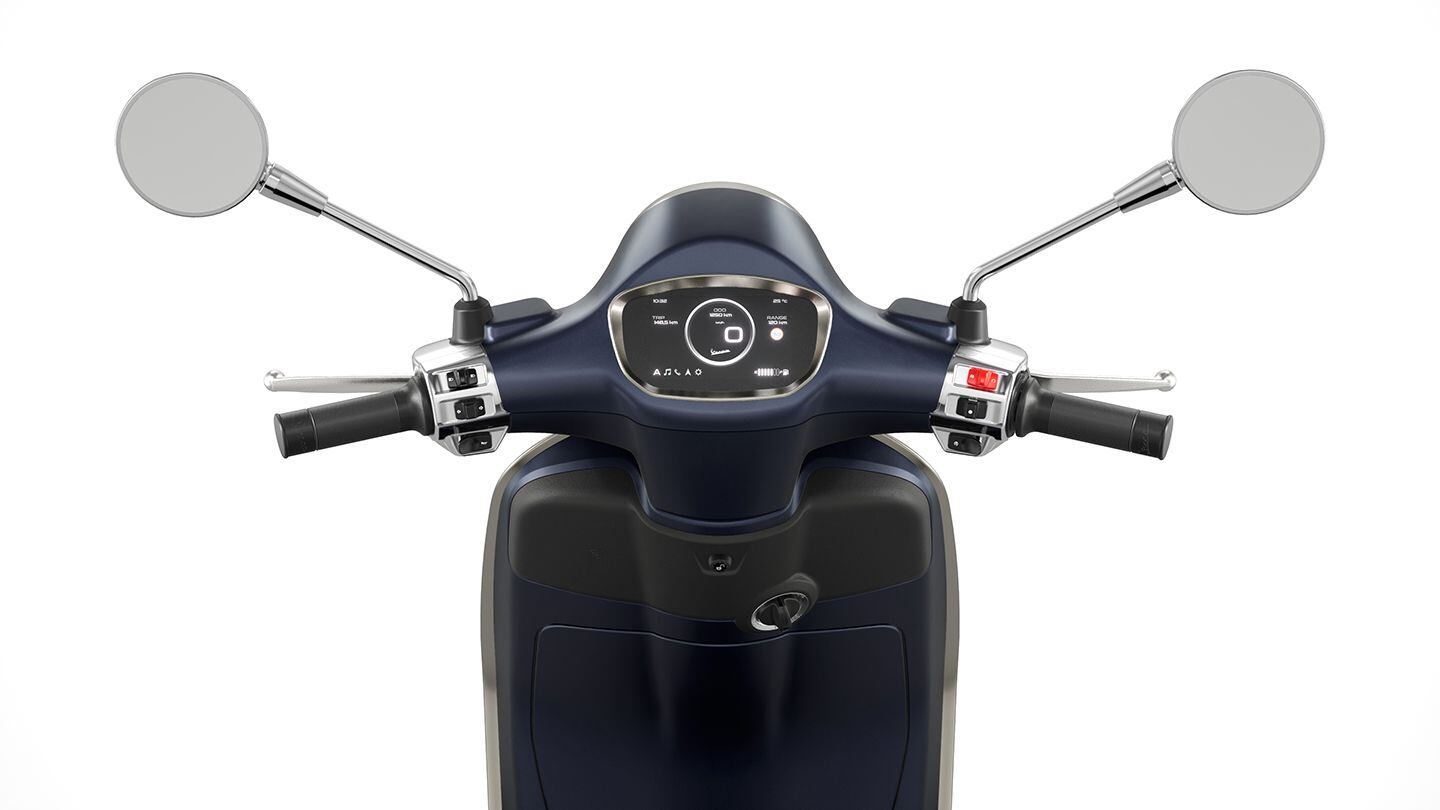
Vespa’s Primavera Tech 125 and 150 get a 5-inch TFT dash. (Vespa/)Vespa Primavera comes in three executions: Primavera, Primavera Tech, and Elettrica, Vespa Sprint S comes as Sprint S and Sprint S Elettrica. The base version of both models come with a new 3-inch LCD instrumentation display while the Primavera Tech 125 and 150 feature a new and very elegant 5-inch TFT display. Both instrumentations offer connectivity functions, with the top model including the powerful Vespa MIA infotainment app.
Pricing has not been announced for the US market.
-
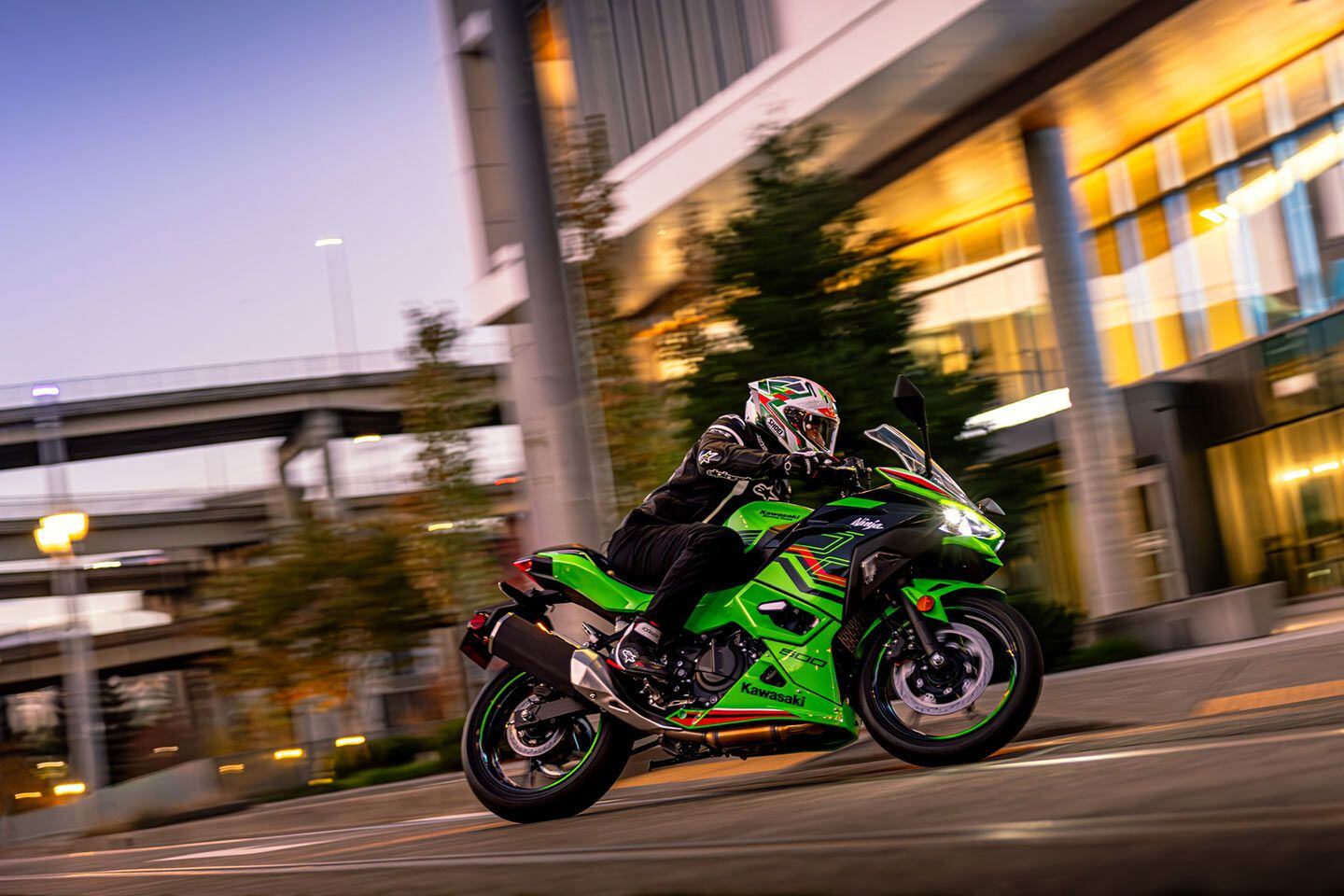
Kawasaki’s Ninja 500 receives a larger displacement of 451cc over its predecessor. (Kawasaki/)When Kawasaki introduced the 451cc Eliminator using a heavily uprated derivative of the old 399cc twin used in the Z400 and Ninja 400 it was always a matter of time before those models adopted the same upgraded powertrain. Now that’s happened with the global launch of the Z500 and Ninja 500 at EICMA in Milan.
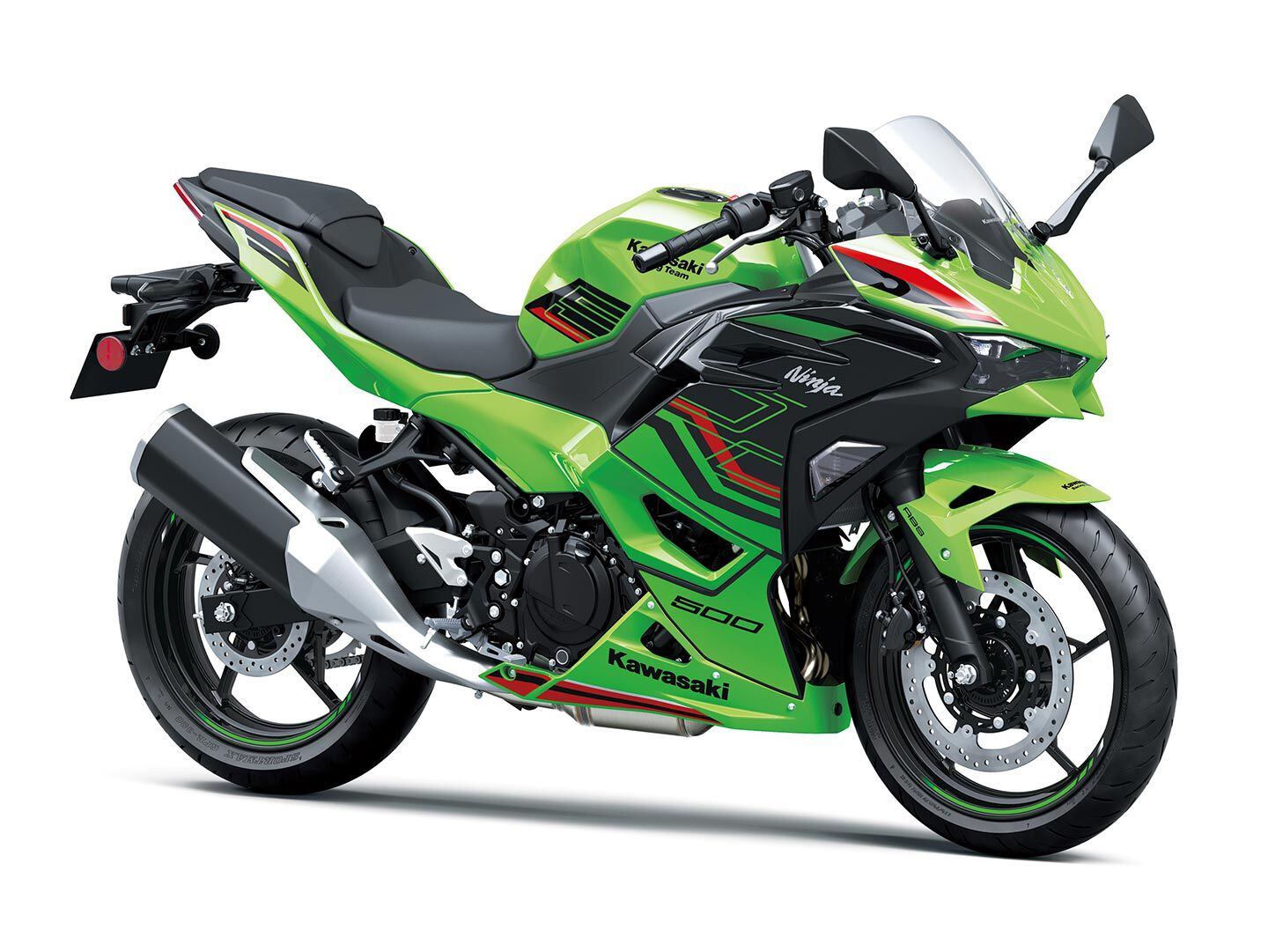
The Ninja 500 is available in a KRT-inspired livery. (Kawasaki/)Both models carry over a huge amount of their DNA from the existing Ninja 400 and Z400, including the familiar steel trellis frame and their suspension, as well as major components like the fuel tank, but get revised styling to set them apart from the earlier generation.
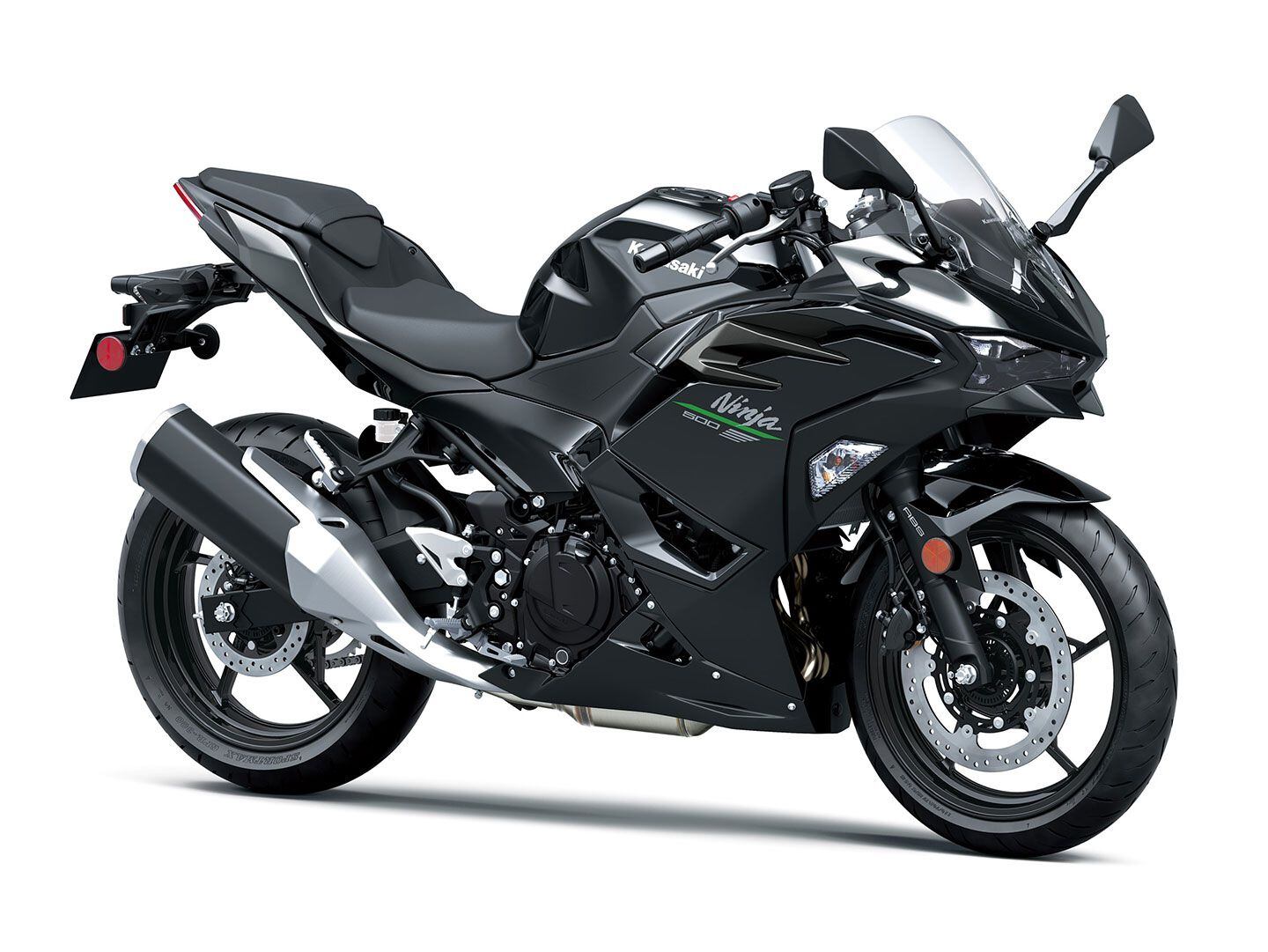
The 2024 Kawasaki Ninja 500 also receives a redesigned headlight and front fairing. (Kawasaki/)The Ninja 500 is, of course, the full-faired model. Its new nose and headlight design are instantly clear compared to the older Ninja 400, but closer inspection reveals that the side panels are also new, as is the lower fairing section and the seat unit.
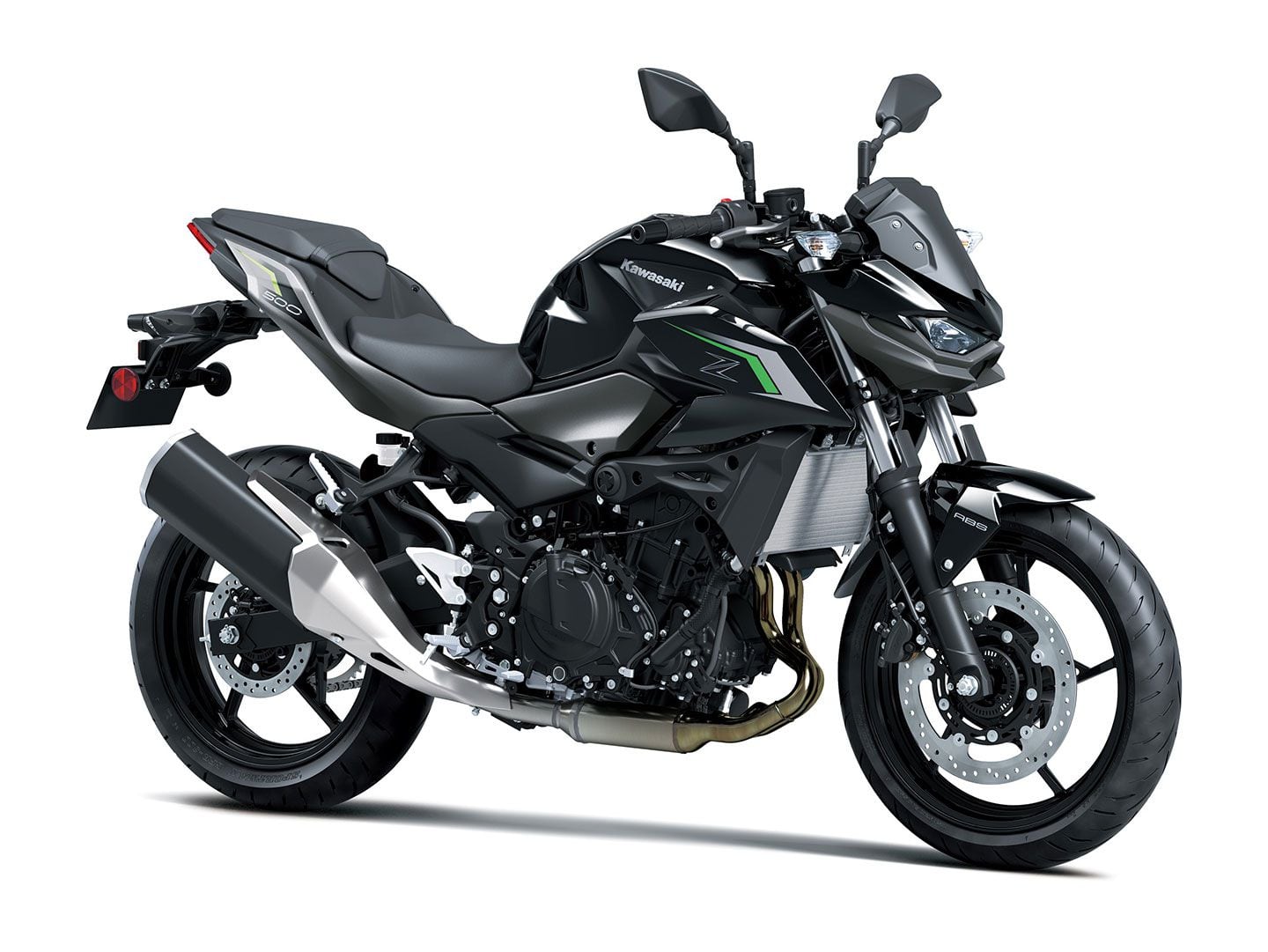
Kawasaki also fitted the Ninja 500 and Z500 with a color TFT display with smartphone connectivity and a USB-C port. (Kawasaki/)The same new rear section also appears on the Z500, which adds redesigned ducts on the sides of the tank and a more compact nose cowl with a much smaller headlight unit than the old Z400′s.
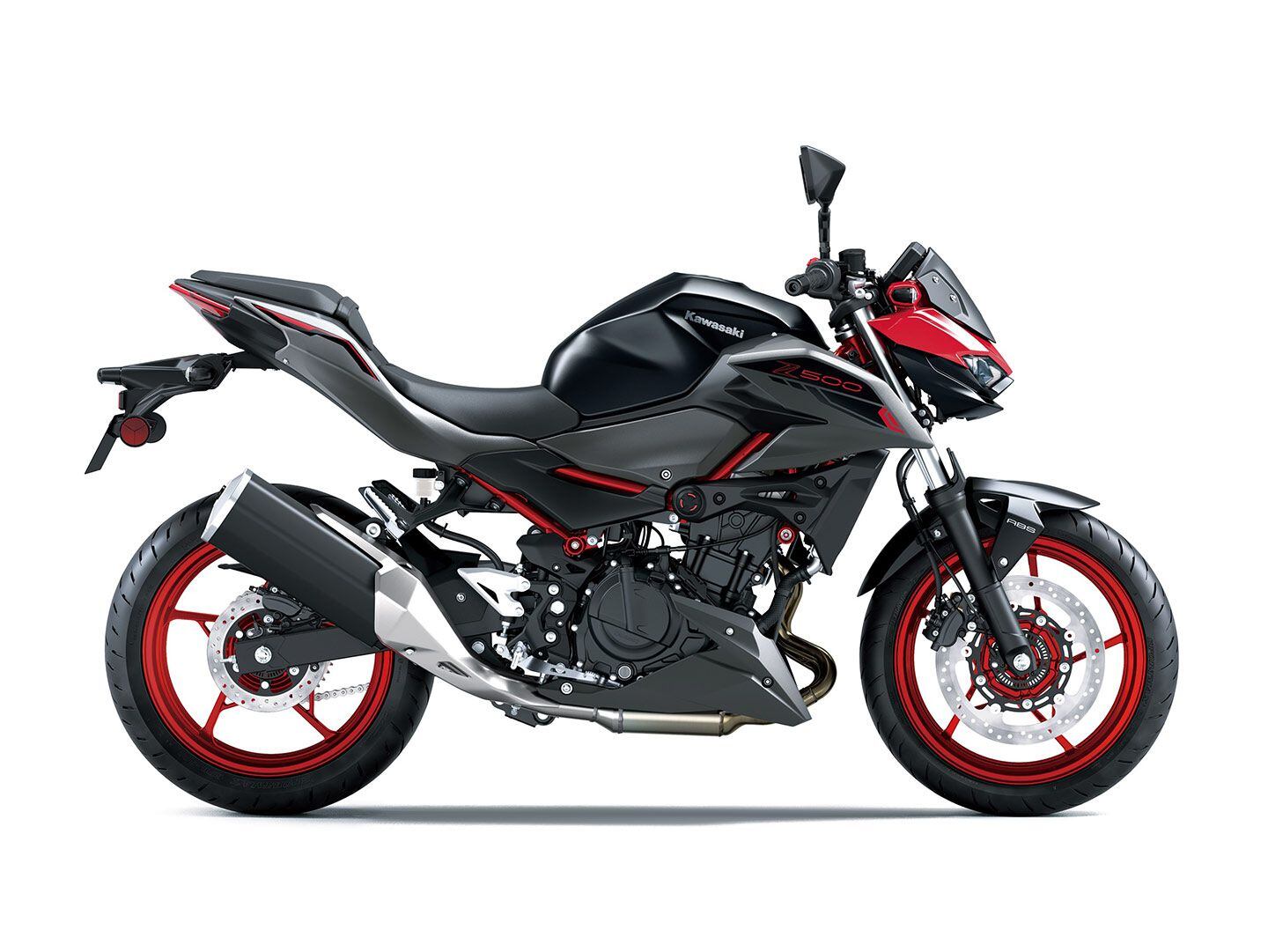
Other than the increased engine displacement, revised styling, and the addition of a color TFT display, the chassis of the two models are not expected to change from their predecessors. (Kawasaki/)Both new bikes were officially unveiled within an hour of their most significant rivals, Honda’s CB500 Hornet and CBR500R, and like those machines the two Kawasaki’s gain color TFT instruments with smartphone connectivity as well as a USB-C power port.
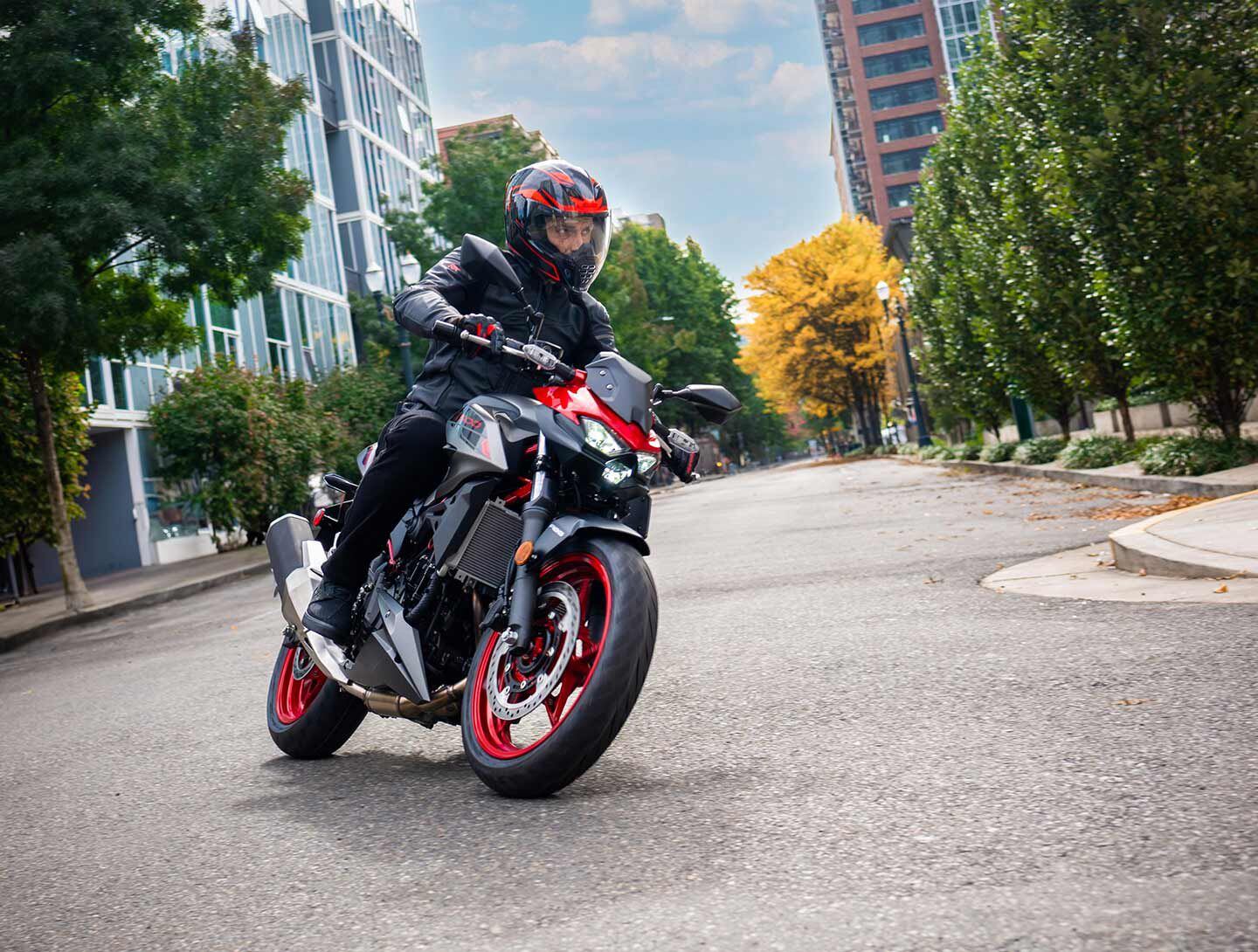
The Z500’s increased displacement is achieved through a larger stroke of 58.6mm while retaining the same bore of 70mm. (Kawasaki/)Kawasaki hasn’t announced detailed specifications for the bikes yet, but most of their main dimensions aren’t expected to change compared to the Ninja 400 and Z400 they’re based on. The additional engine capacity, achieved via a 58.6mm stroke (up from 51.8mm) while retaining the previous 399cc engine’s 70mm bore, is likely to have a bigger impact on torque and low-down pull than on peak power.
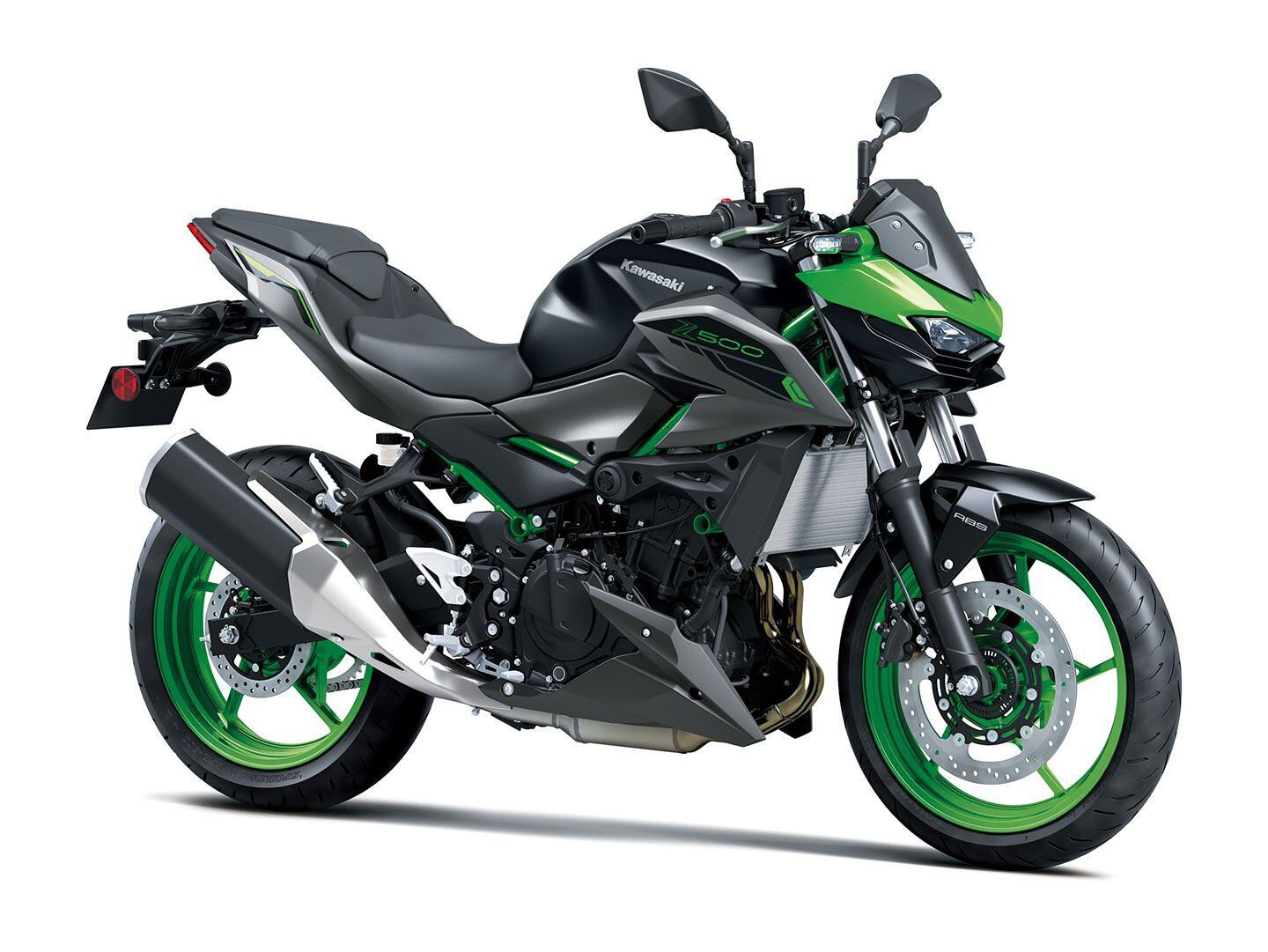
In the European market, the Z500 and Ninja 500 are claimed to be A2-license compliant. (Kawasaki/)In European markets, the two “500″ models are claimed to be A2-license compliant, which means they can’t make more than 48 hp and also have a limited power-to-weight ratio (restricted to 0.2kW per kilogram, or 0.122 hp per pound). Since the existing Ninja 400 and Z400 make 45 hp and weigh 370 pounds and 368 pounds, respectively, they’re already right on the power-to-weight limit. This means the bigger engine isn’t likely to lead to more horsepower, although the Eliminator’s 451cc mill makes 3.7 more pound-feet of torque.
Full specs and pricing have not been released yet.
-
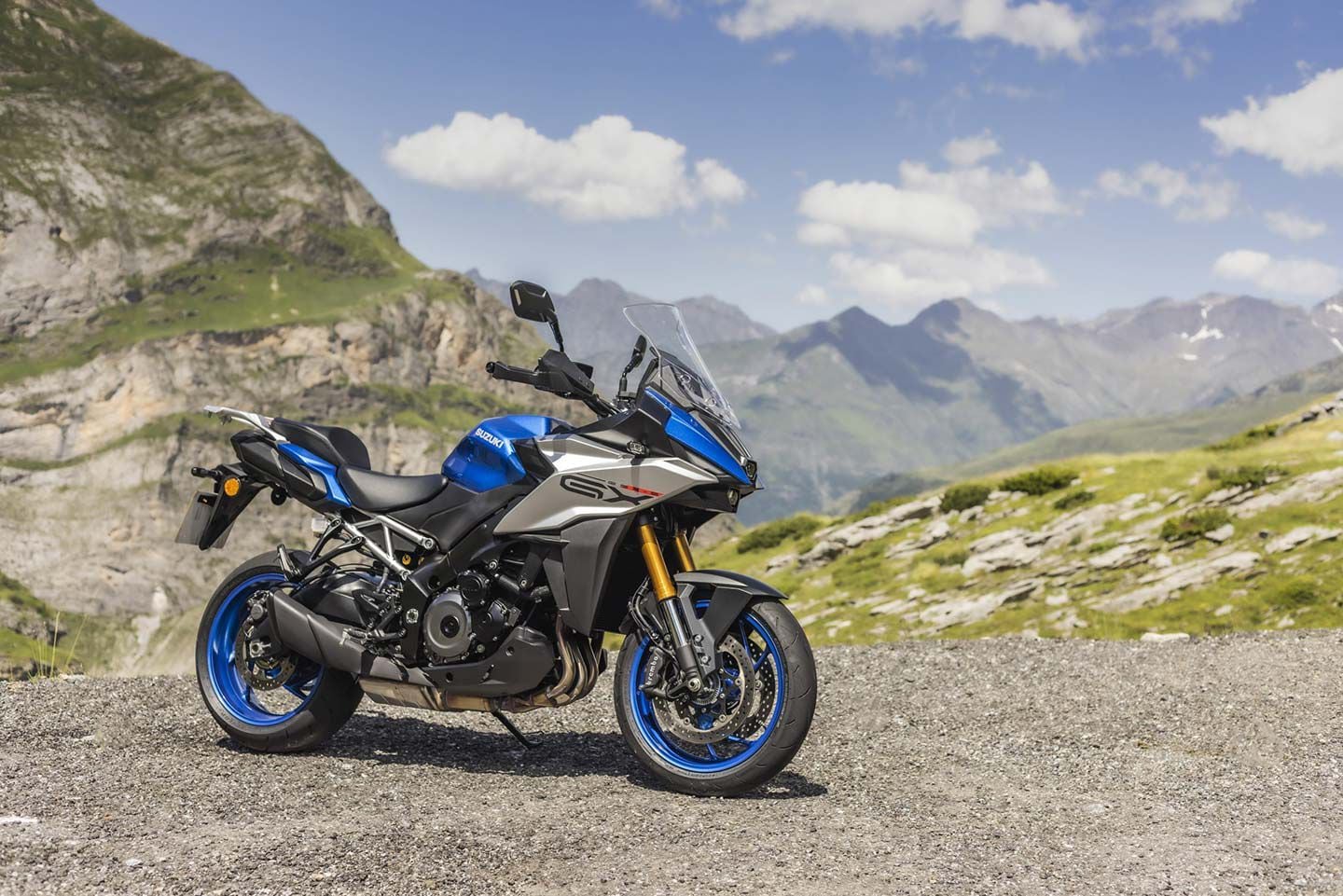
Suzuki has continued to expand its platform that includes the GSX-S1000 and GSX-S1000GT with the new GSX-S1000GX. (Suzuki/)Back in September documents filed by Suzuki appeared to confirm a new model based on the GSX-S1000GT with the name “GSX-S1000X.” It’s a taller machine combining an adventure-bike stance with street-oriented suspension and wheels. Now Suzuki has officially launched it—albeit with the name GSX-S1000GX.
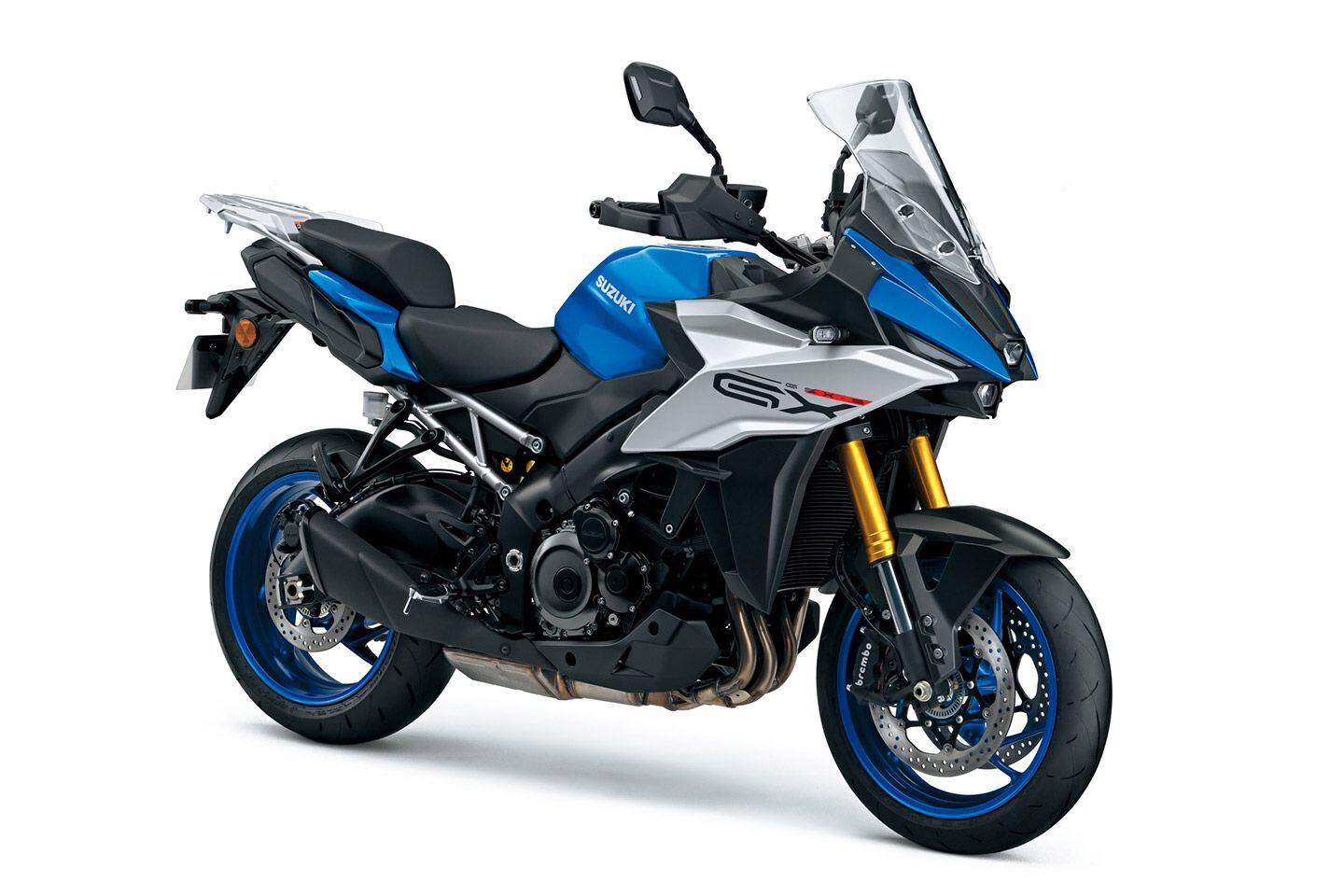
The brand-new 2024 Suzuki GSX-S1000GX in blue. (Suzuki/)Suzuki calls the bike a “crossover”—mirroring the language used in the car market for vehicles that have the taller stature and rugged stance of SUVs but aren’t really designed to be used off-road. It might seem to be a small niche, tucked between the GSX-S1000GT tourer and the V-Strom 1050 (itself a bike that’s oriented more toward the street than the trail), but for Suzuki the GSX-S1000GX is a relatively easy way to use existing components to expand its model range, appealing to a slightly different customer who might not be interested in either the GT or the V-Strom.
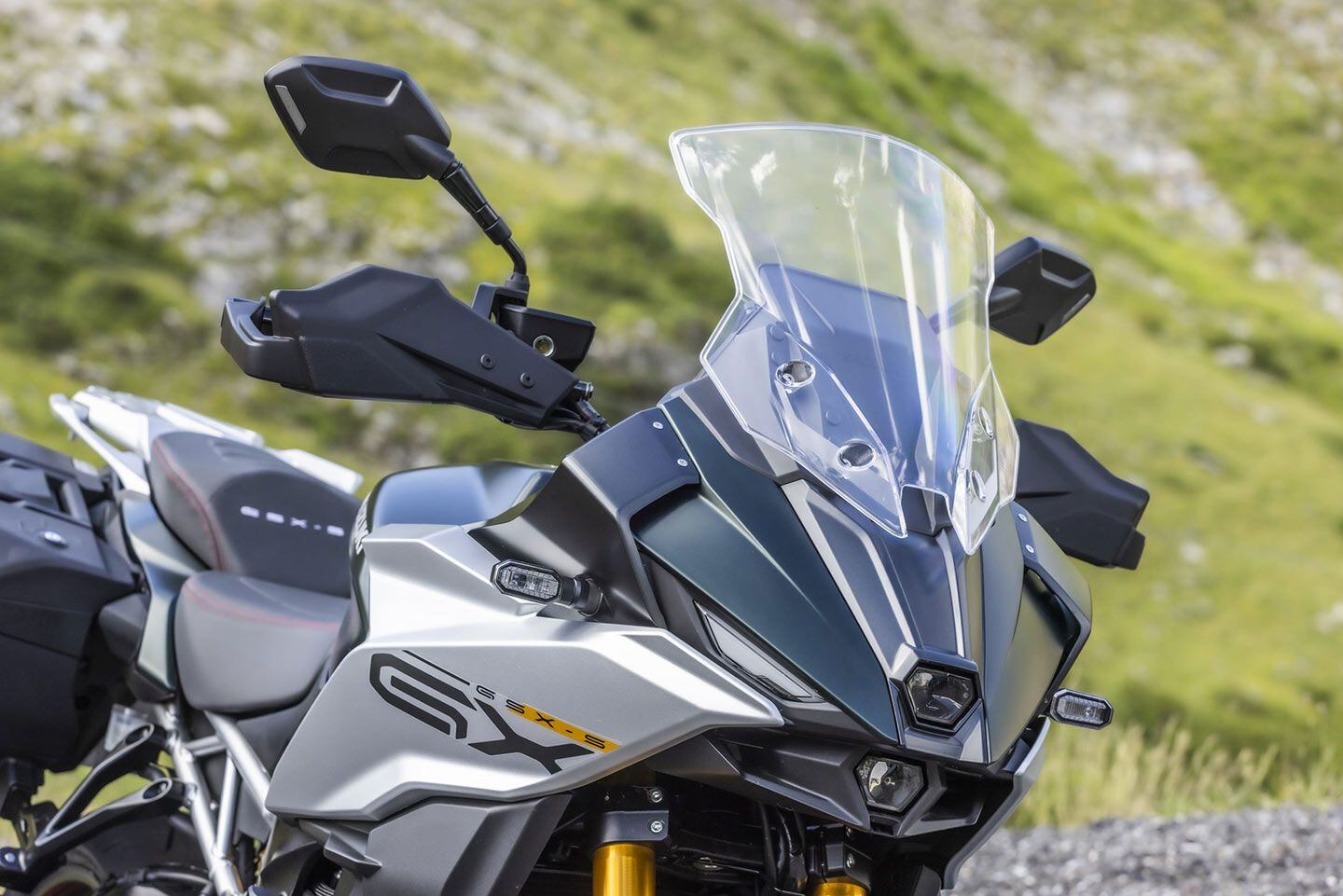
The 2024 Suzuki GSX-S1000GX is an upright, street-oriented crossover. (Suzuki/)Compared to the GT, the GX’s styling is more on-trend, hitting the “adventure” notes that rivals like the Ducati Multistrada V4 RS and BMW S 1000 XR exploit, while offering a similar level of touring comfort. Up against the V-Strom 1050, the GSX-S1000GX has substantially more power thanks to an engine that can trace its heritage directly back to the 2005 GSX-R1000K5.
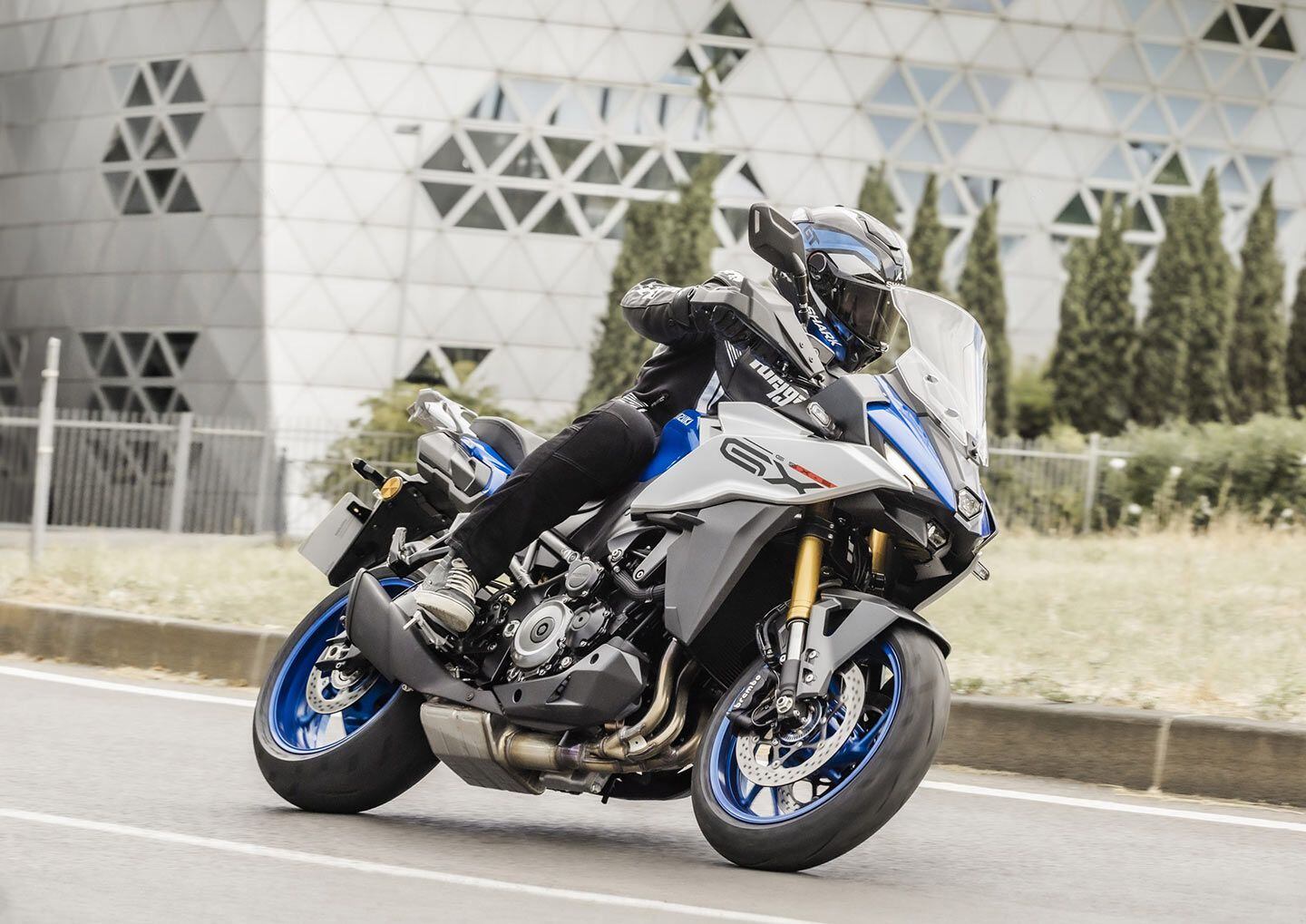
An upright riding position combined with a sporty wheel and tire package and touring capabilities puts the GSX-S1000GX up against the likes of BMW’s S 1000 XR. (Suzuki/)That engine and the aluminum chassis it’s bolted into are shared with a host of existing Suzukis including the GSX-S1000, the Katana, and the GSX-S1000GT, minimizing the R&D and production costs associated with the new model. That should help it undercut the most obvious rivals when it comes to sticker price, although in terms of outright power it’s a step down compared to the BMW S 1000 XR and Ducati Multistrada V4, which both hover around the 170-hp mark.
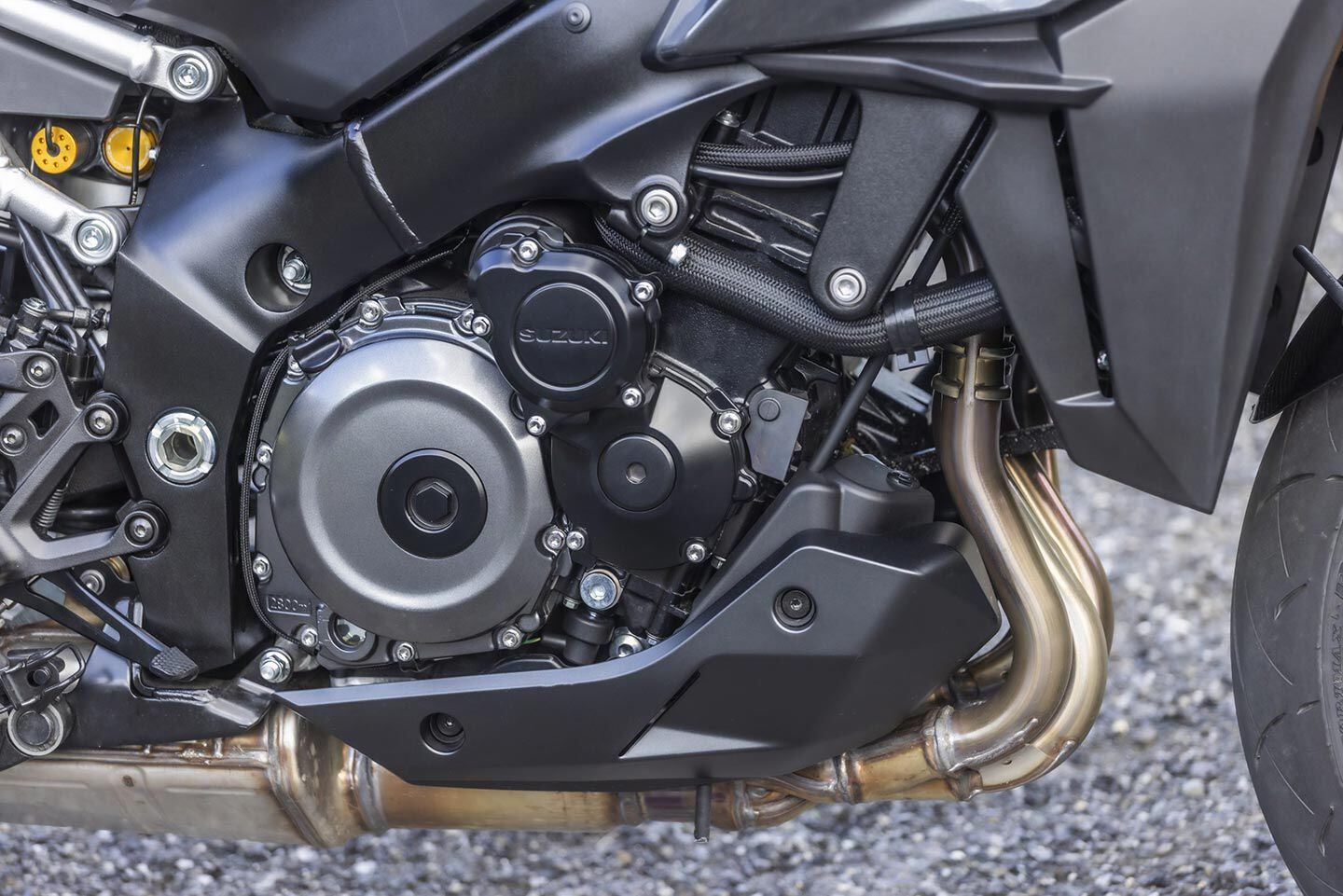
The engine, like the unit in the GSX-S1000GT, can trace its roots back to the GSX-R1000 engine from 2005. (Suzuki/)The GSX-S1000GX, meanwhile, peaks at a claimed 150 hp—still a sizable chunk—at 11,000 rpm, and backs it up with 78 lb.-ft. of peak torque at 9,250 rpm from a 999cc inline-four. Compared to the latest generation of superbike engines, the Suzuki motor has a relatively small 73.4mm bore and long 59mm stroke (the S 1000 XR, for comparison, has an 80mm bore and 49.7mm stroke), which bodes well for its low-down thrust even if it limits the outright peak power. As in other models that use the same engine, there’s a modern suite of electronics including ride-by-wire, a trio of riding modes, and cornering traction control.
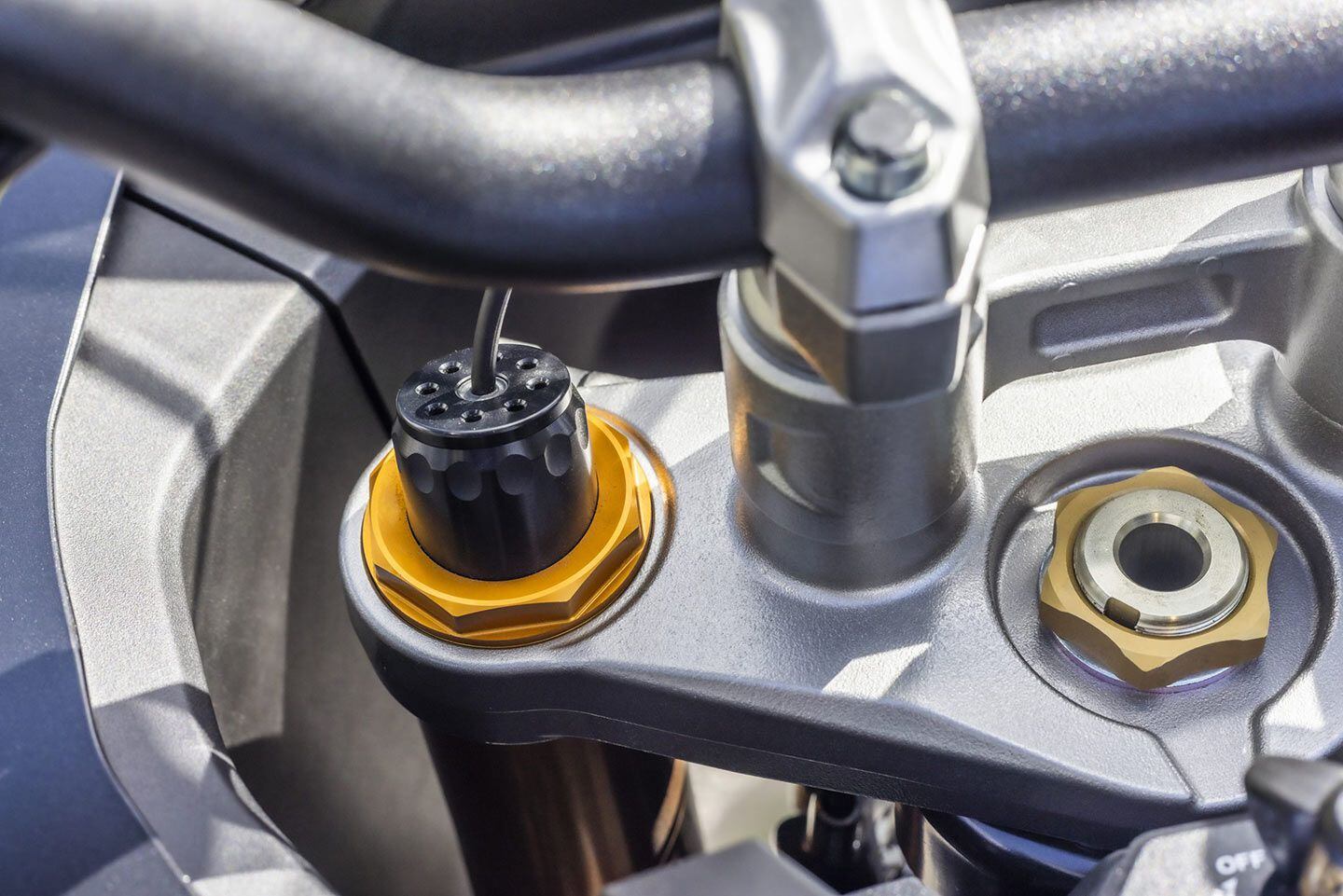
A Showa SFF-CA electronic fork uses Suzuki Floating Ride Control software. (Suzuki/)The frame is familiar but the GX’s suspension is new, with a Showa SFF-CA upside-down fork featuring electronic adjustment and Suzuki Floating Ride Control that uses a skyhook-style system—monitoring the bike’s position compared to an imaginary point in the air above it and trying to keep it steady underneath, tweaking the damping constantly to absorb bumps as seamlessly as possible. The same system is used for the rear shock, and there are stroke sensors at each end that are accurate to 1/1,000th of a millimeter and allow the damping to be adjusted 1,000 times every second.
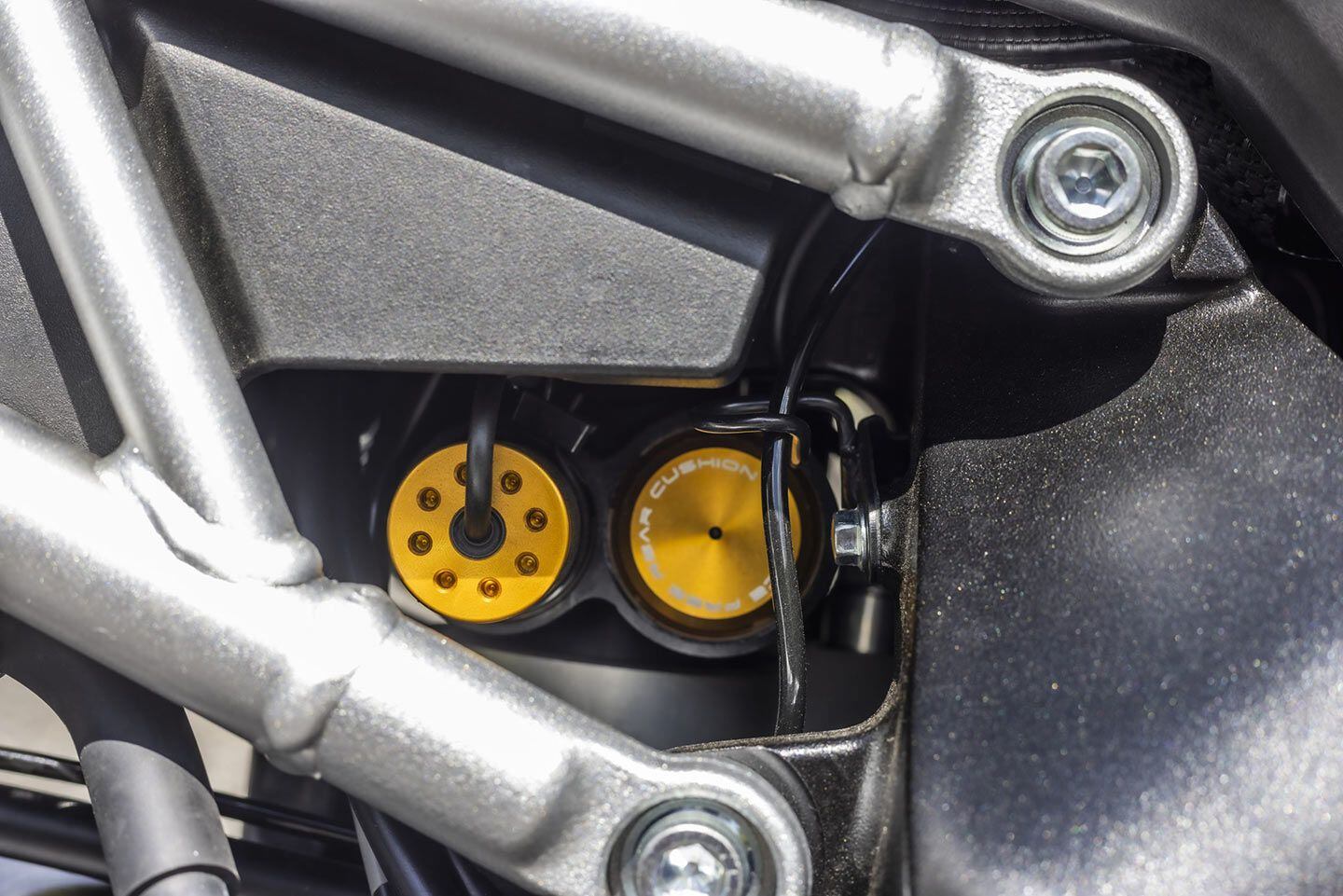
A Showa shock is also electronically controlled and utilizes the SFRC system. (Suzuki/)The suspension, like the engine, is tied into the bike’s riding modes, but it also reacts to the bike’s speed, adjusting the damping to increase stability as you go faster without limiting the low-speed responsiveness. Another system—Suzuki Deceleration Damping Control— alters the suspension characteristics on a closed throttle and under braking to reduce dive. The riding mode system—dubbed SDMS-α—has three factory settings. Mode A (for Active) offers max power, a relatively low traction-control setting, and Firm damping. Mode B (Basic) puts the power to level 2, traction control to level 4, and the suspension to Medium. Mode C (Comfort) sets power at level 3, traction control to level 6 and the damping to Soft. Other tech found in the system includes wheelie control and engine-braking control.
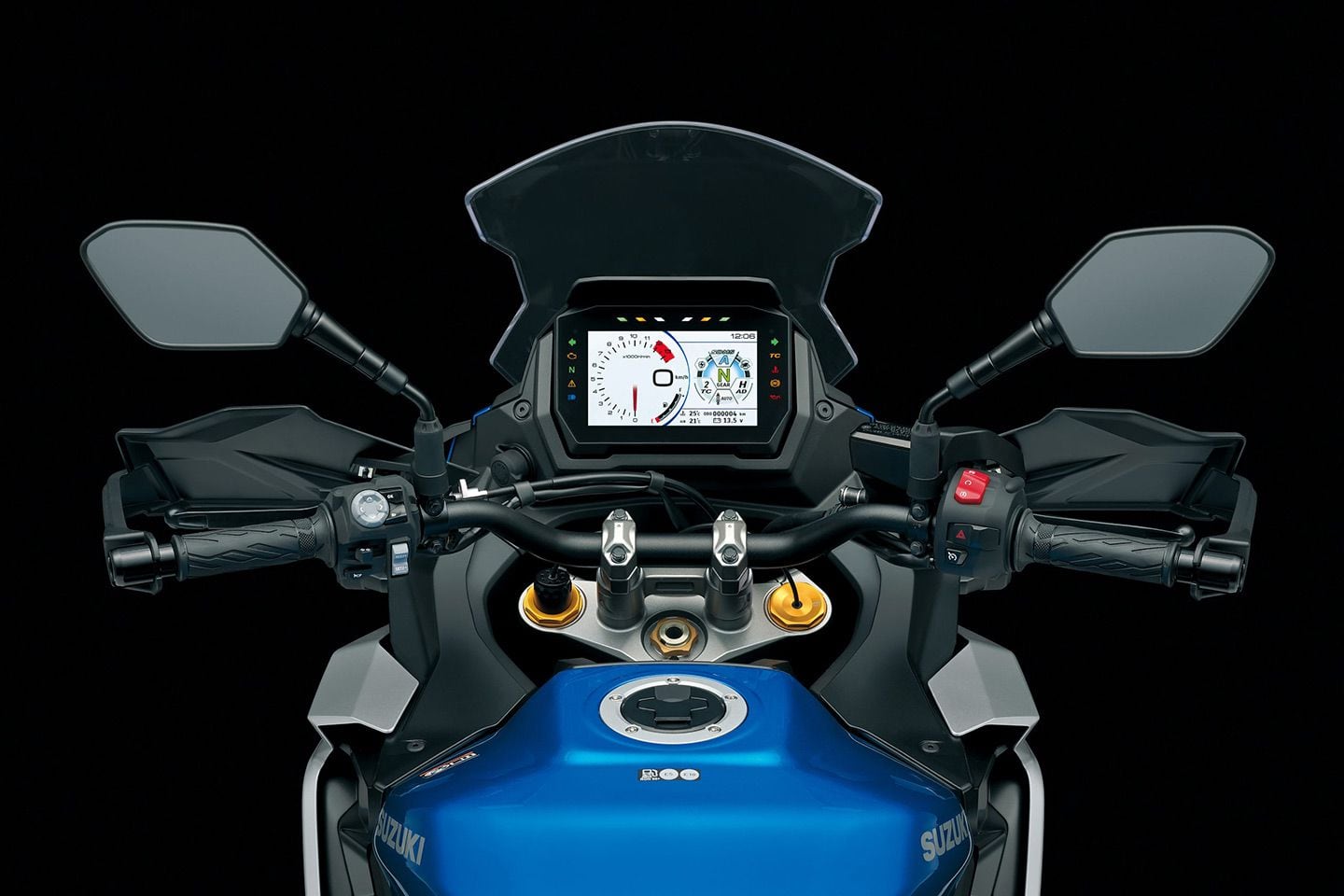
A full-color TFT display has all the electronic features like media connectivity and navigation. (Suzuki/)A 6.5-inch color TFT accesses all the systems, along with dedicated bar controls, and also includes all the usual phone connectivity for media and a full map-based navigation system. With all that kit in mind, the bike’s 511-pound wet weight, including a full 5-gallon tank of fuel, seems more than reasonable.
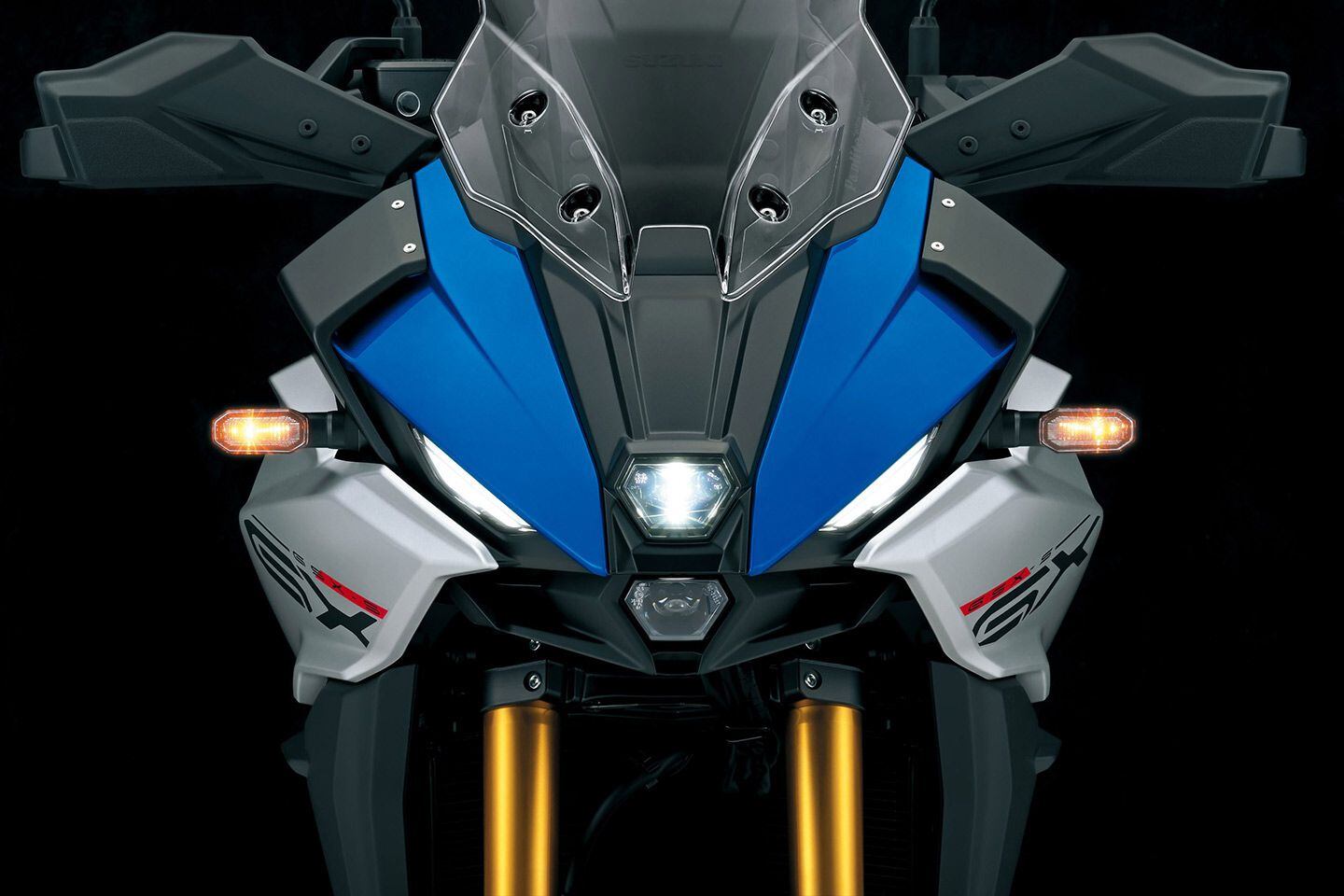
The stacked headlights resemble the rest of Suzuki’s family members. (Suzuki/)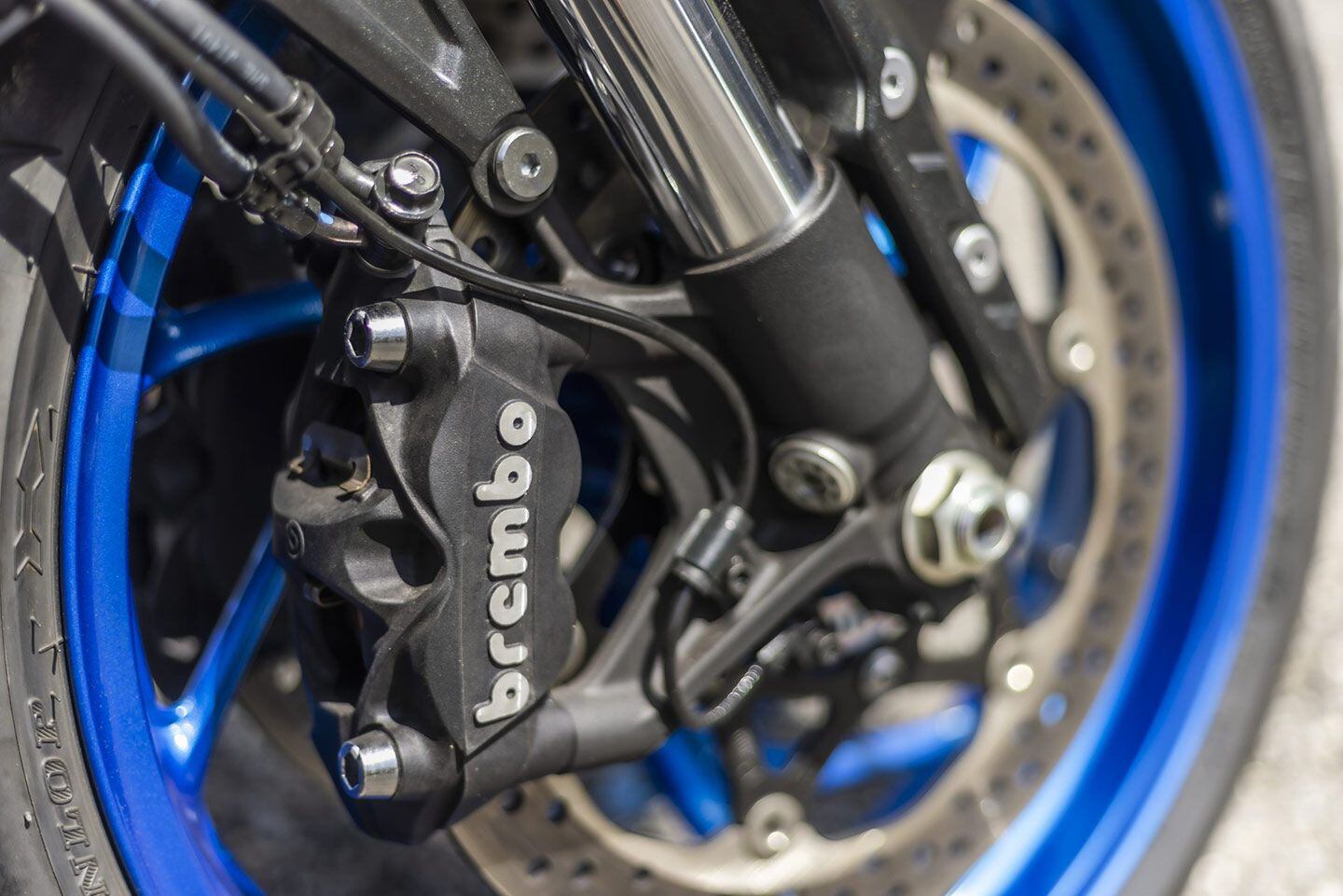
Brembo four-piston brakes are used up front. (Suzuki/)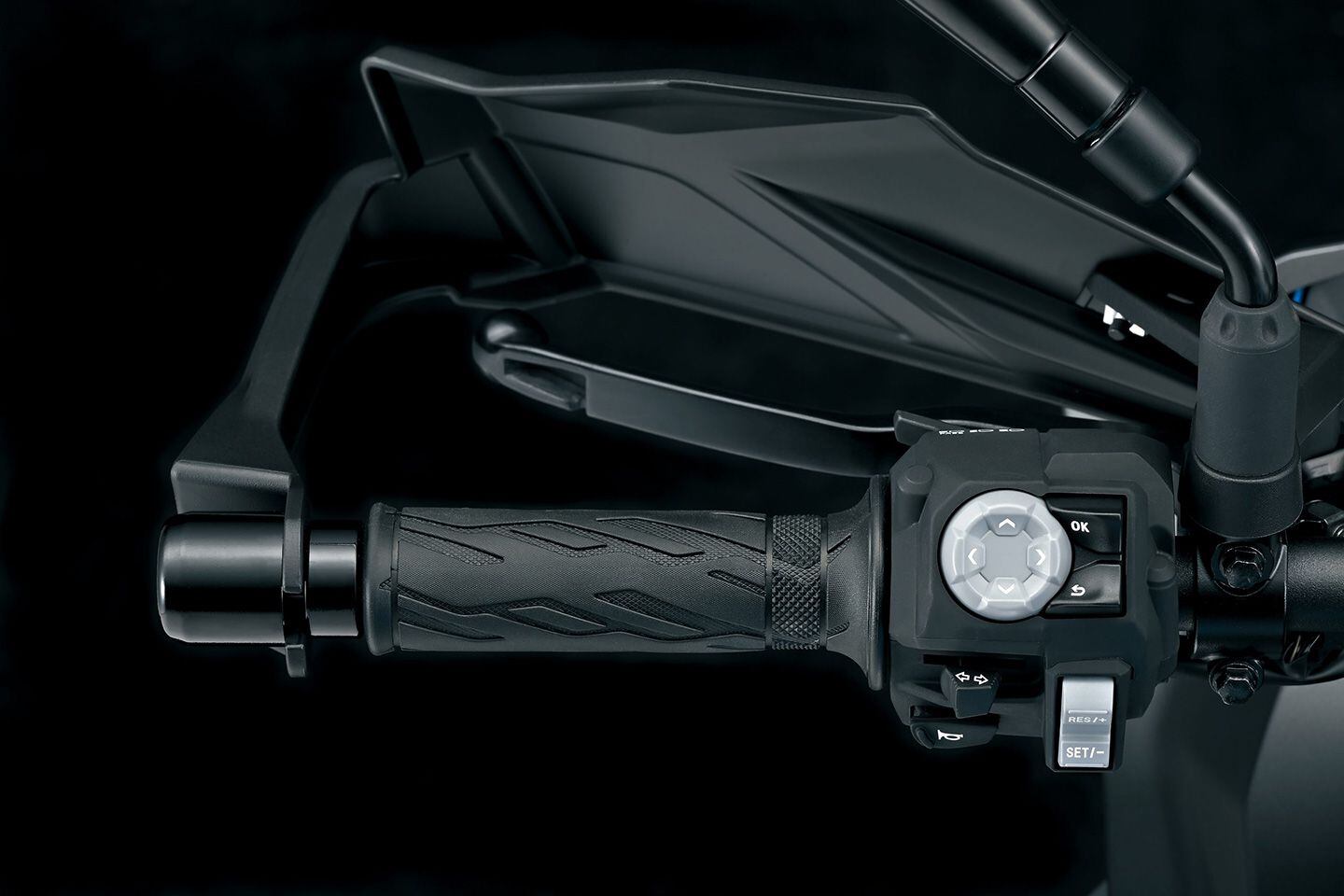
Dash and mode navigation is accomplished via this left-bar-mounted control pod. (Suzuki/)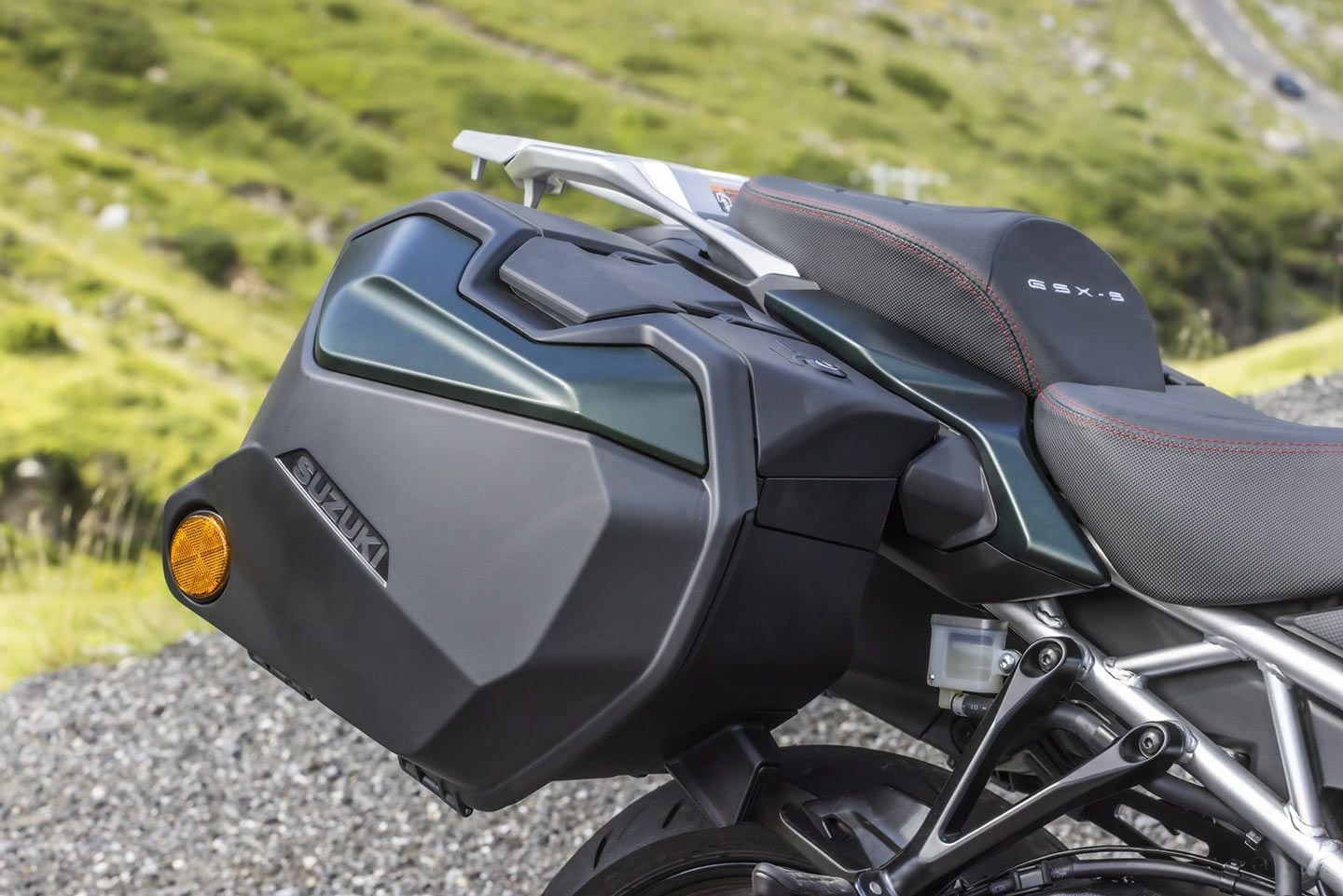
Suzuki will offer hard luggage for the GSX-S1000GX. (Suzuki/)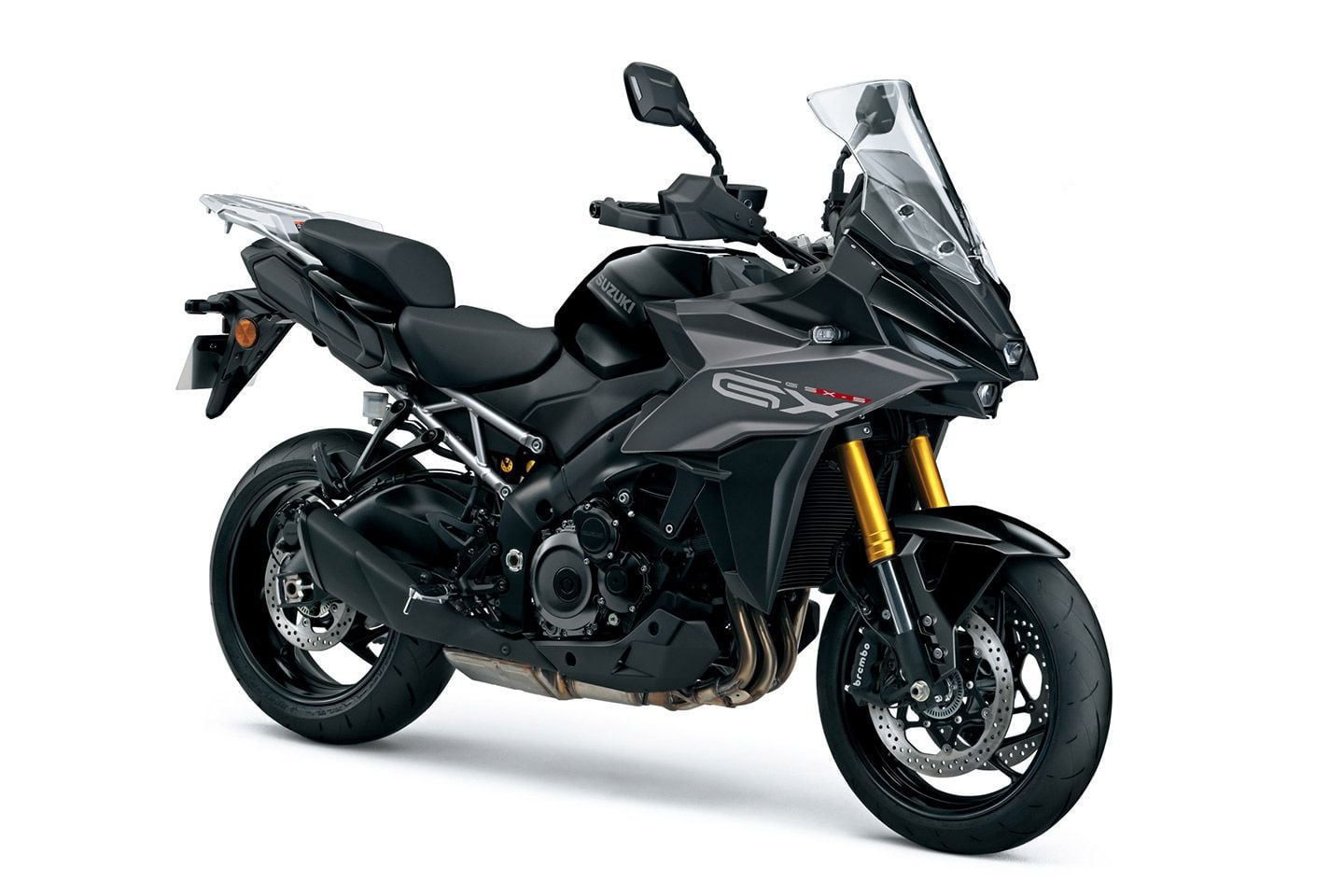
The 2024 GSX-S1000GX in black. (Suzuki/)2024 Suzuki GSX-S1000GX Specs
MSRP: $18,499 Engine: DOHC, liquid-cooled inline-four; 16 valves Displacement: 999cc Bore x Stroke: 73.4 x 59.0mm Compression Ratio: 12.2:1 Transmission/Final Drive: 6-speed/chain Claimed Horsepower: 150 hp @ 11,000 rpm Claimed Torque: 78.2 lb.-ft. @ 9,250 rpm Fuel System: Fuel injection w/ ride-by-wire Clutch: Wet, multiplate SCAS type; cable actuated Engine Management/Ignition: Electronic (transistorized) Frame: Twin-spar aluminum Front Suspension: Showa inverted fork, electronically controlled damping; 5.9 in. travel Rear Suspension: Showa monoshock, electronically controlled damping; 5.9 in. travel Front Brake: Brembo 4-piston Monoblock calipers, dual 310mm discs w/ ABS Rear Brake: Nissin 1-piston caliper, 240mm disc w/ ABS Wheels, Front/Rear: Cast aluminum; 17 in./17 in. Tires, Front/Rear: Dunlop Sportmax Roadsport 2; 120/70-17 / 190/50-17 Rake/Trail: 25.0°/3.8 in. Wheelbase: 57.9 in. Ground Clearance: 6.1 in. Seat Height: 33.3. in. Fuel Capacity: 5.0 gal. Claimed Wet Weight: 511 lb. Contact: suzukicycles.com -
 1
1
-
-
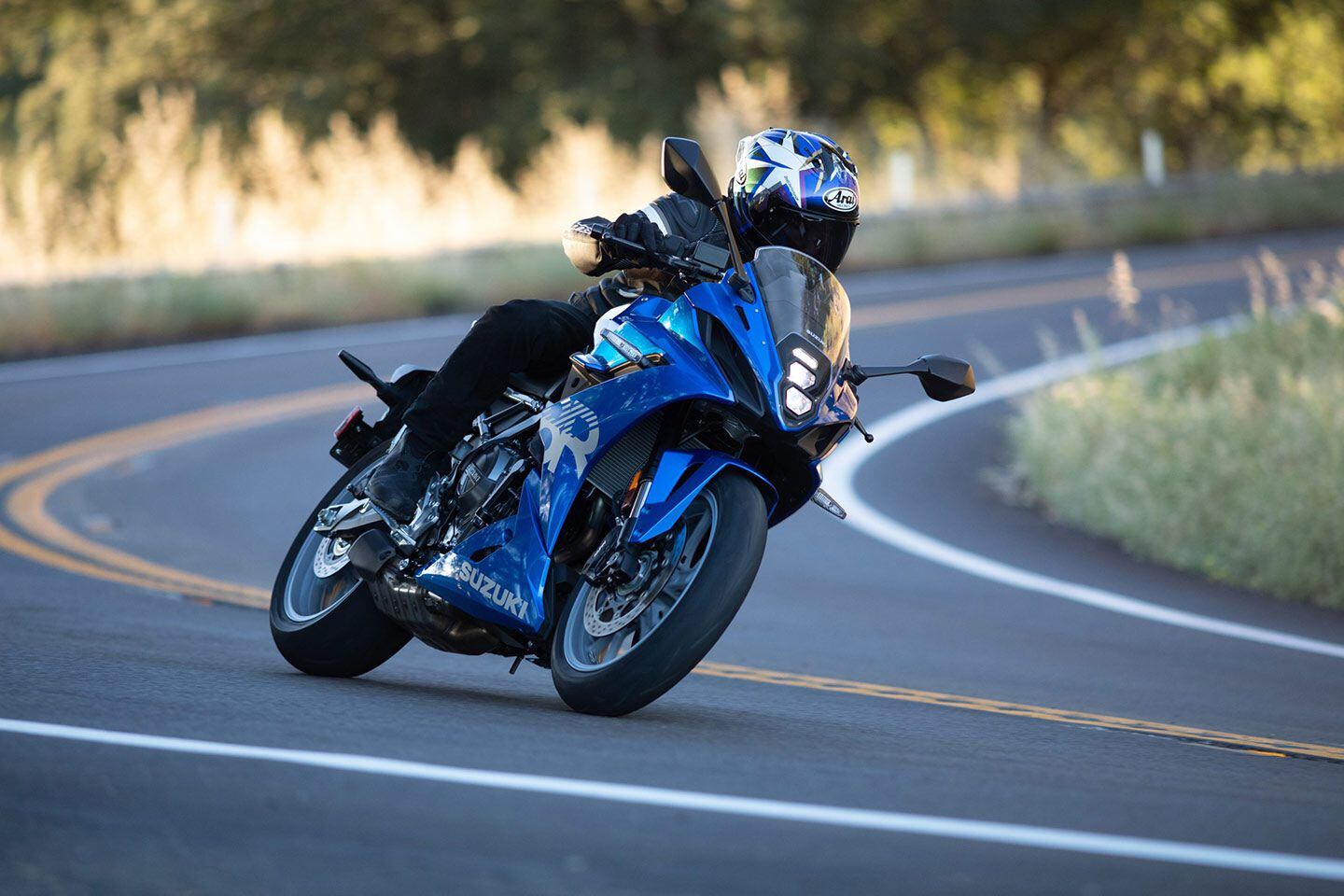
As anticipated, another new model based on Suzuki’s 776cc parallel-twin platform has arrived in the form of the GSX-8R. (Suzuki/)We’ve been saying for a while that a fully faired supersport version of Suzuki’s new GSX-8S has been on the way, and now that bike has been officially unveiled at EICMA in Milan as a 2024 model. Called the GSX-8R, it’s Suzuki’s response to Yamaha’s R7 and thanks to uprated suspension and a reworked riding position it promises to be one of next year’s most interesting new sportbikes.
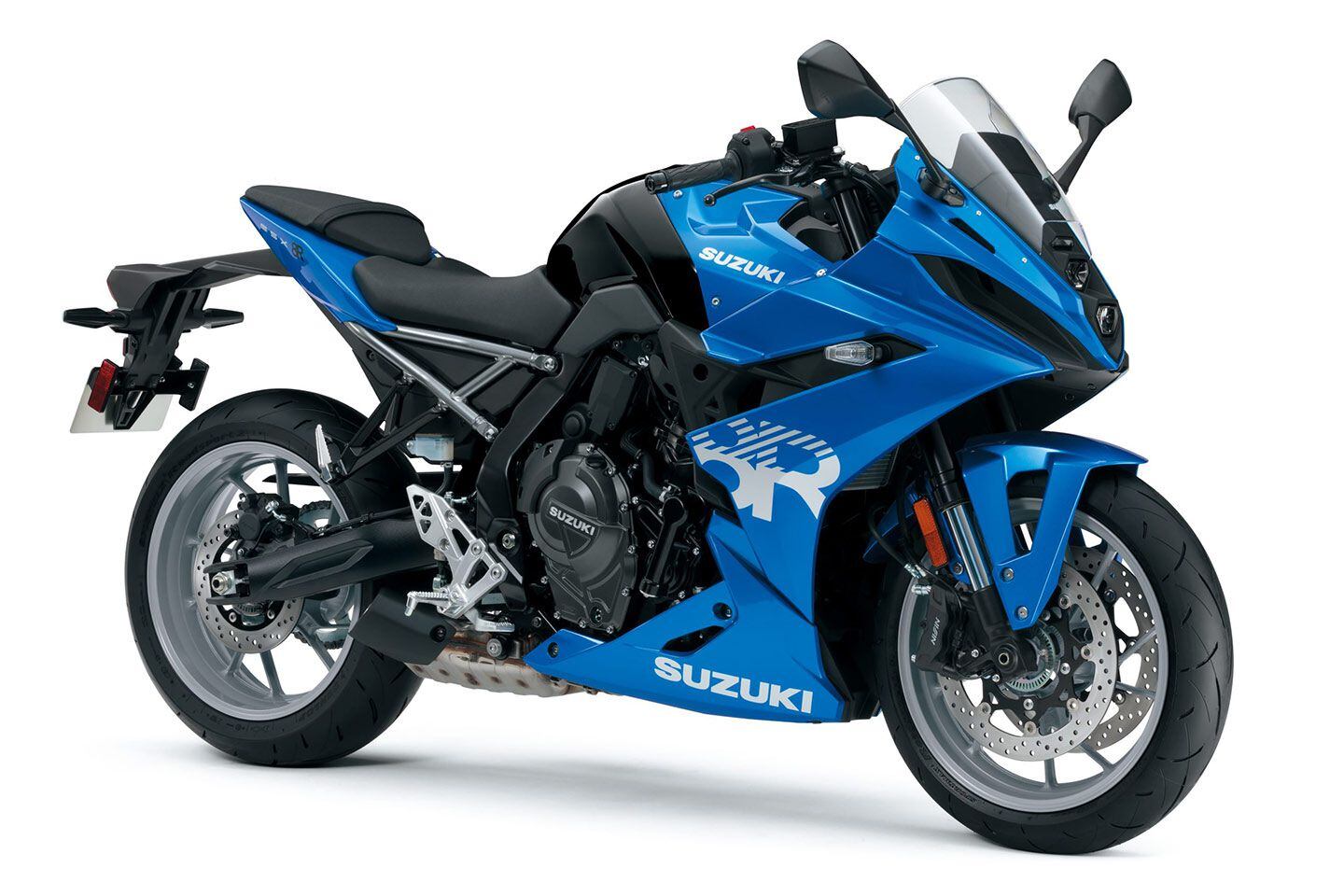
The 2024 Suzuki GSX-8R in traditional blue. (Suzuki/)There’s a quiet revolution going on in the market for middleweight sportbikes at the moment. The long-established standard of 600cc inline-four machines is disappearing—those bikes, fun though they are on track, have become too hardcore to be the all-rounders that their ancestors were, leaving customers who want a single, affordable bike that doubles as a useful weekday commuter with the ability to take to backroads or racetracks on the weekend, looking for something a bit less extreme. That’s where the GSX-8R promises to come to the fore.
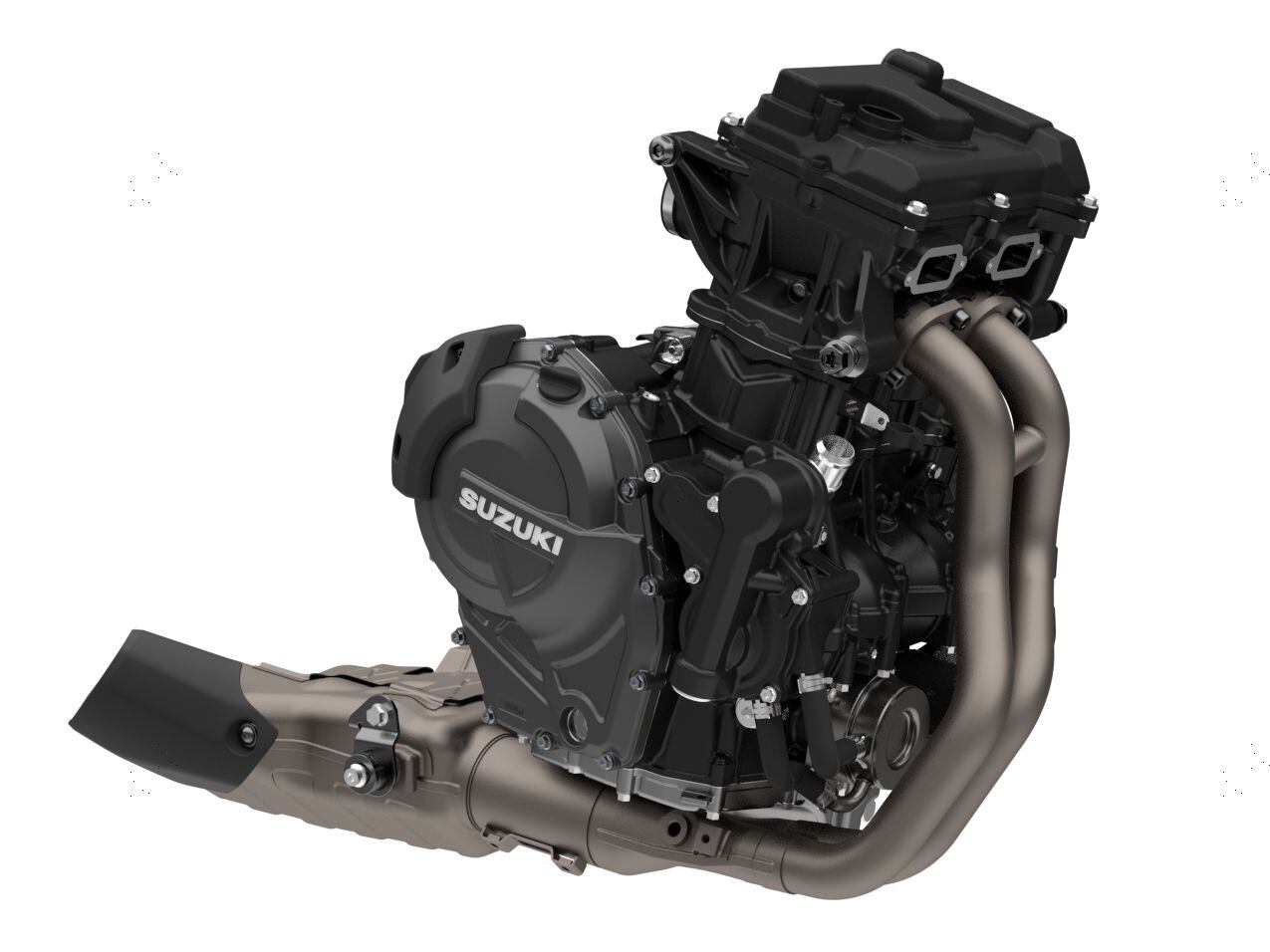
Suzuki’s new-for-2023 parallel twin now finds itself powering a faired sportbike in addition to the naked GSX-8S and V-Strom 800 lineup. (Suzuki/)Under the new bodywork, the mechanical bits are largely familiar. The engine is the same 270-degree crank, 776cc parallel twin that’s used in the GSX-8S and the V-Strom 800DE, putting out an unchanged 81.8 hp at 8,500 rpm and 57.5 lb.-ft. at 6,800 rpm. Far from superbike numbers but enough to have some fun without scaring yourself with every twitch of your right wrist. That engine sits in the same steel tube frame used in the GSX-8S, and as in the naked bike it’s controlled via a ride-by-wire system that allows three riding modes, three power settings, traction control, and a bidirectional quickshifter fitted standard.
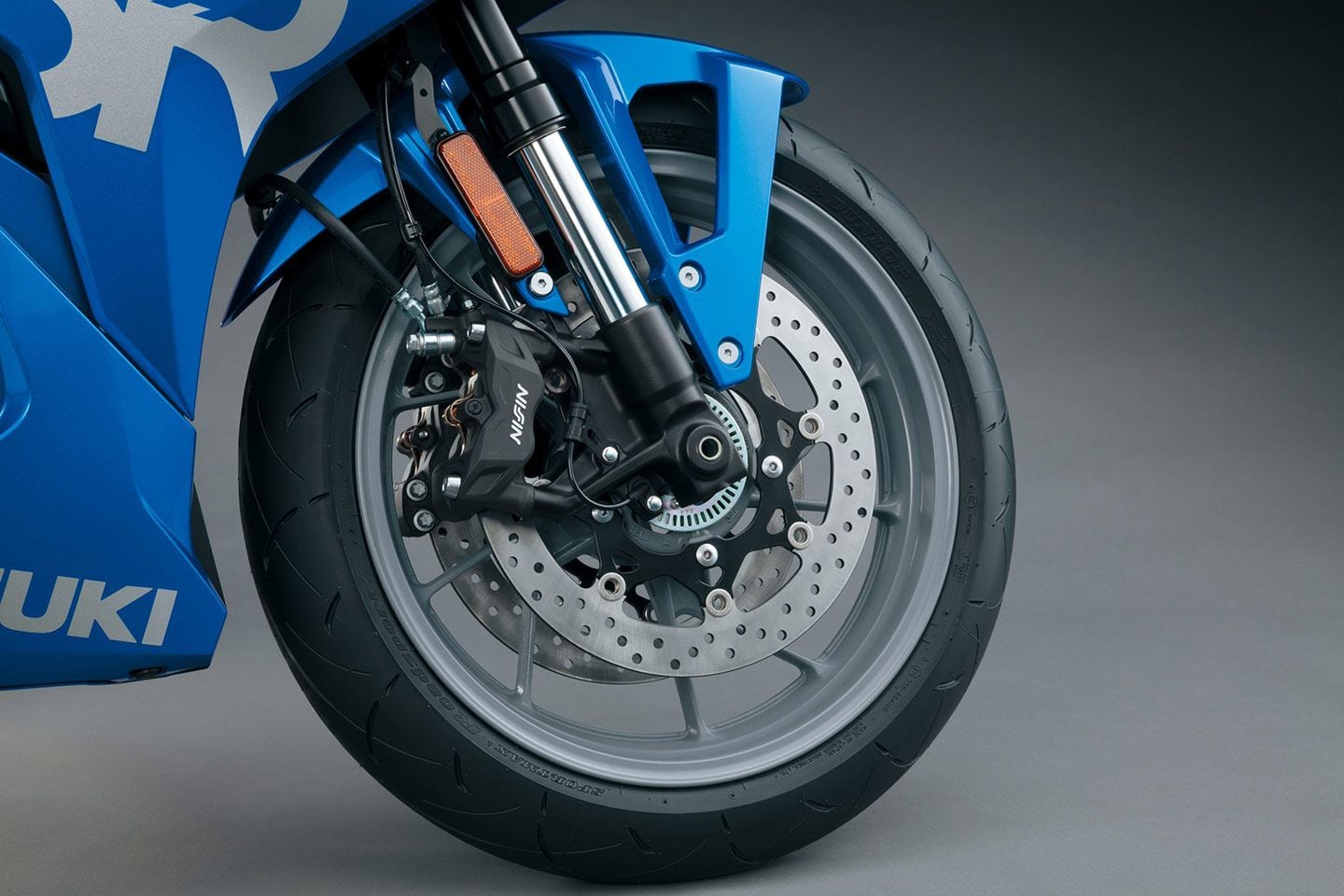
A pair of Nissin radial-mount calipers with 310mm discs are fitted up front, while a new Showa SFF-BP fork replaces the KYB units from the GSX-8S. (Suzuki/)The brakes—dual four-piston radial-mount Nissin calipers at the front with 310mm discs allied to a single-piston rear and 240mm rotor—are straight from the GSX-8S, as are the 17-inch wheels and the aluminum swingarm, but Suzuki has opted to upgrade the fork and monoshock to ratchet up the chassis’ ability. The GSX-8S features KYB suspension at both ends, but the new GSX-8R switches it out for Showa kit, with an SFF-BP upside-down fork and a shock from the same company. They’re still nonadjustable, other than for rear preload, but the uprated parts promise improved handling.
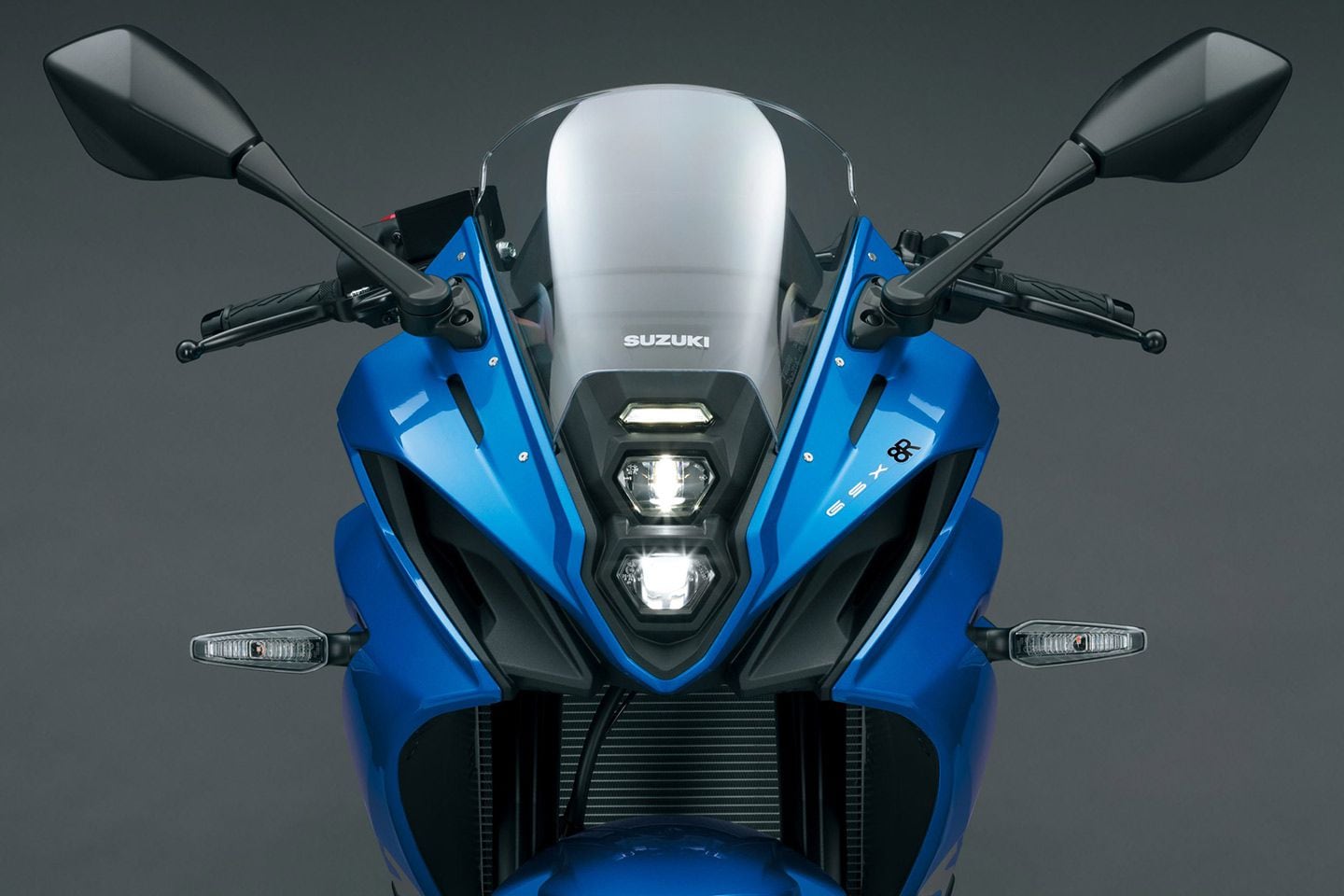
The stacked headlights conform to the rest of Suzuki’s middleweight twin family, but are mounted to the fairing instead of to the bars. (Suzuki/)With the stacked LED headlights and the mirrors firmly mounted on the new fairing instead of movably attached to the bars, there’s less mass on the steering components—a change that should make for sharper responses—and the use of separate, forged aluminum bars instead of a one-piece bar above the top yoke gives a racier riding position, even though the footpegs are unaltered. In fact, the rear section of the bike is carried directly across from the GSX-8S, including the seat and tail bodywork, as is the 3.7-gallon fuel tank, albeit with a redesigned plastic front section to make space for those lower-mounted bars.
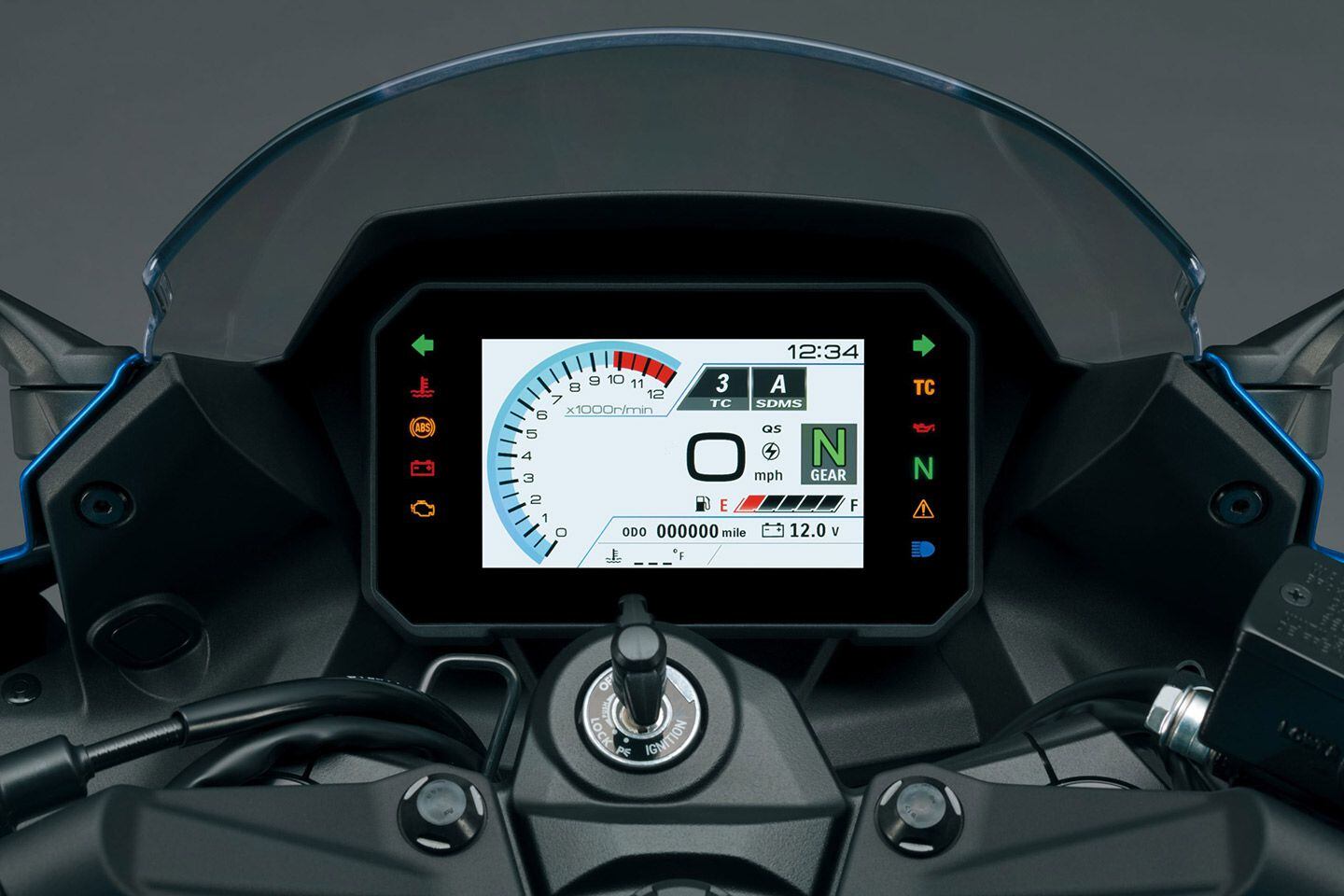
The TFT display is shared with the 8S, but is mounted to the fairing instead of to the handlebars. (Suzuki/)On board, the color TFT screen is again straight from the GSX-8S, including the same display options, but is bolted to the inner fairing rather than the bars, further reducing the mass on the movable parts of the steering.
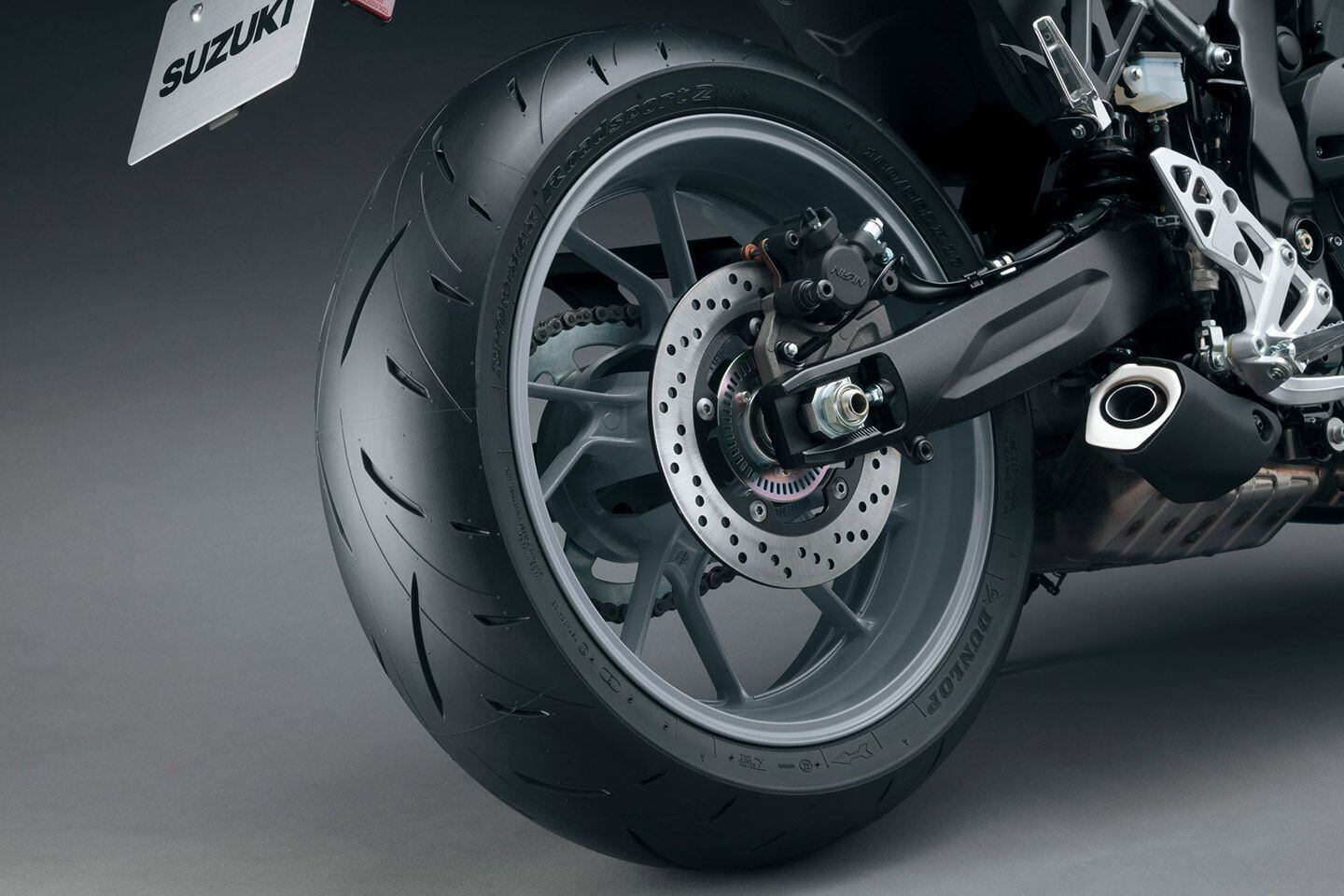
The 8R uses the same wheel and tire package as its naked sibling, but the shock is now a Showa unit. (Suzuki/)How the GSX-8R will stack up against existing competition in the affordable sportbike class remains to be seen, but its competition will come from not only established models like the Yamaha R7 and Honda’s CBR650R but also from an array of new bikes entering the same segment but using an assortment of different capacities and layouts, including Kawasaki’s Ninja ZX-4R, the upcoming 675cc three-cylinder CFMoto 675SR and 500cc four-cylinder CFMoto 500SR, and even an expected Triumph Daytona 660 based on the engine and running gear of the Trident.
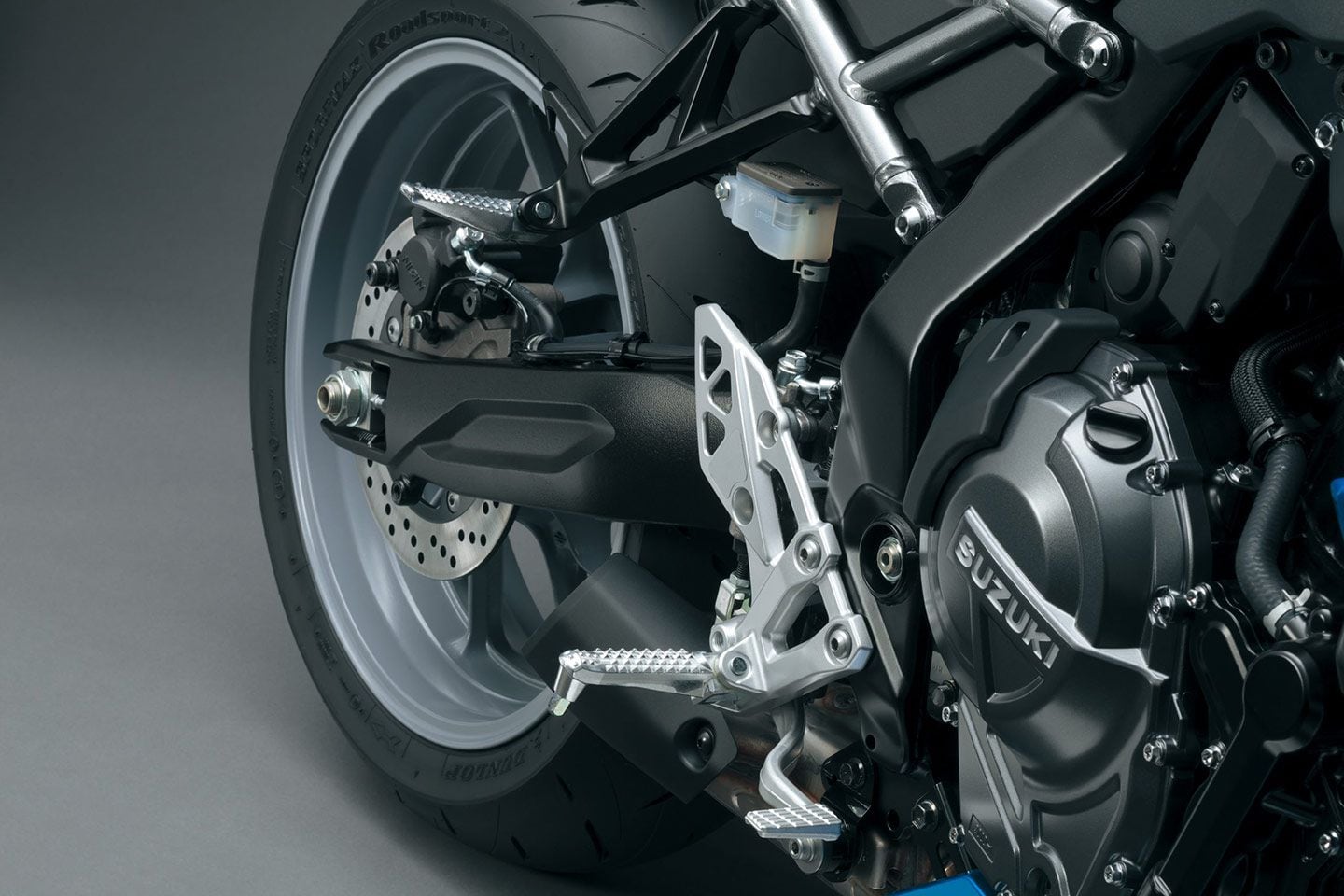
The footpeg controls carry over from the 8S. (Suzuki/)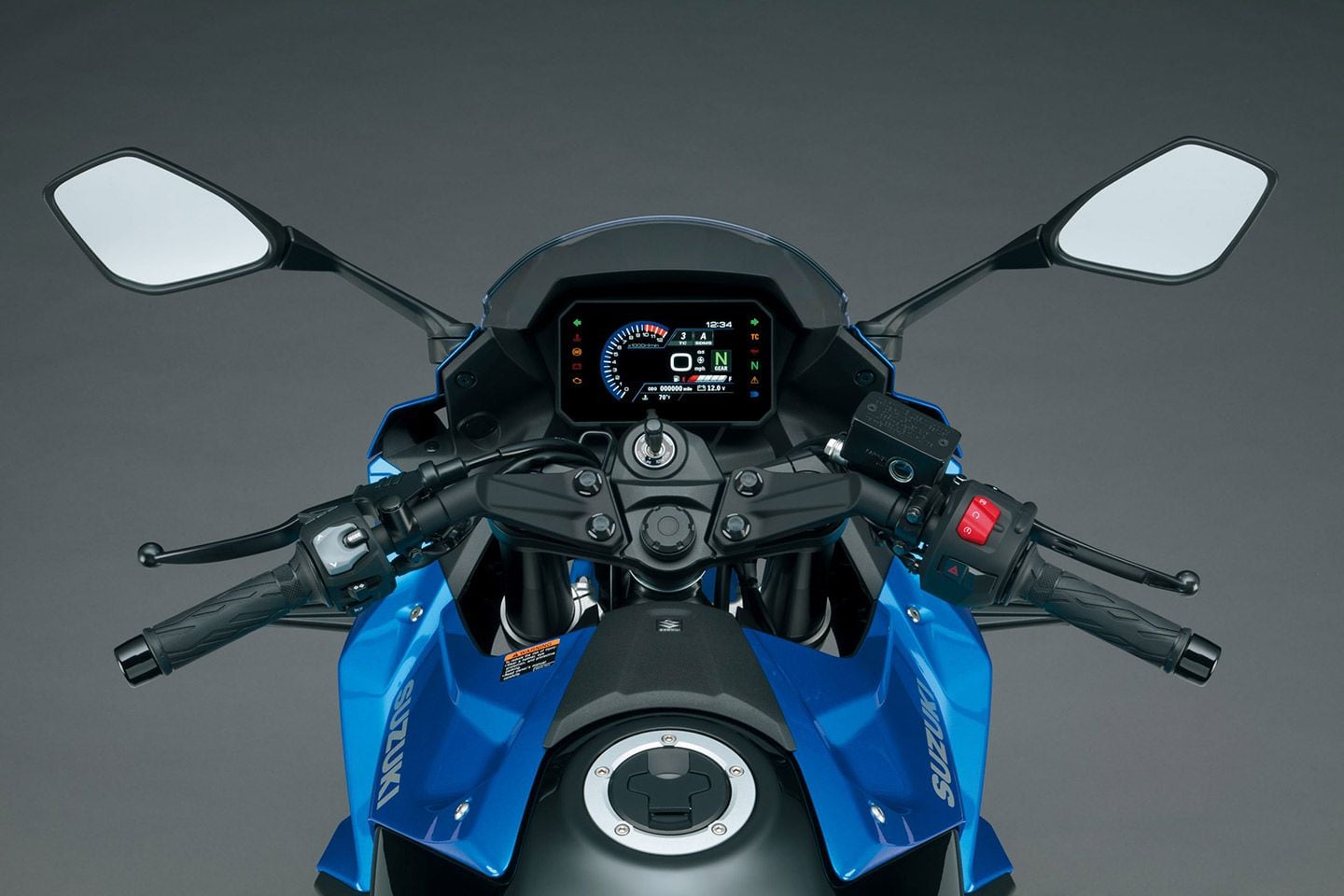
A view of the 8R’s cockpit. (Suzuki/)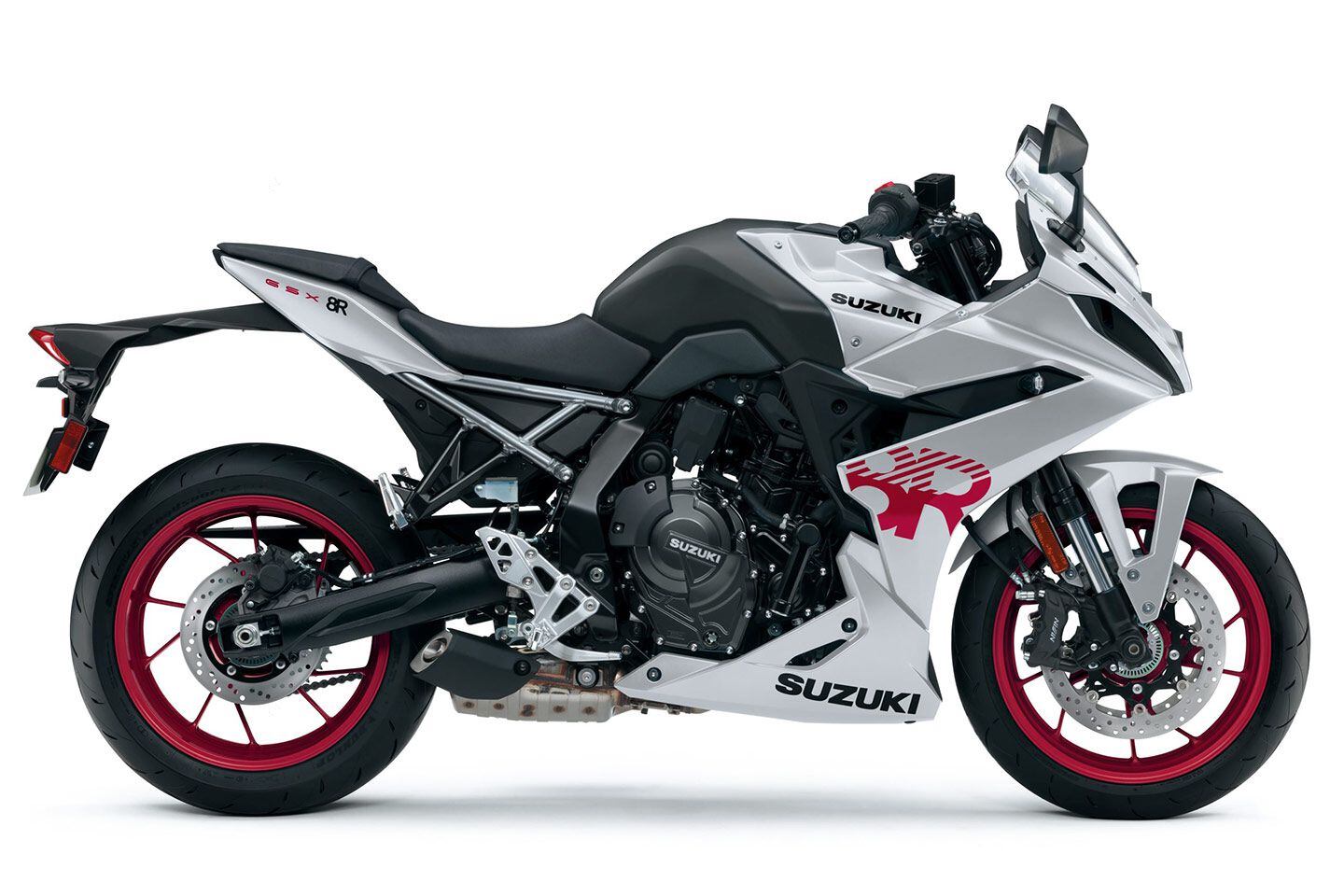
The 2024 Suzuki GSX-8R in white. (Suzuki/)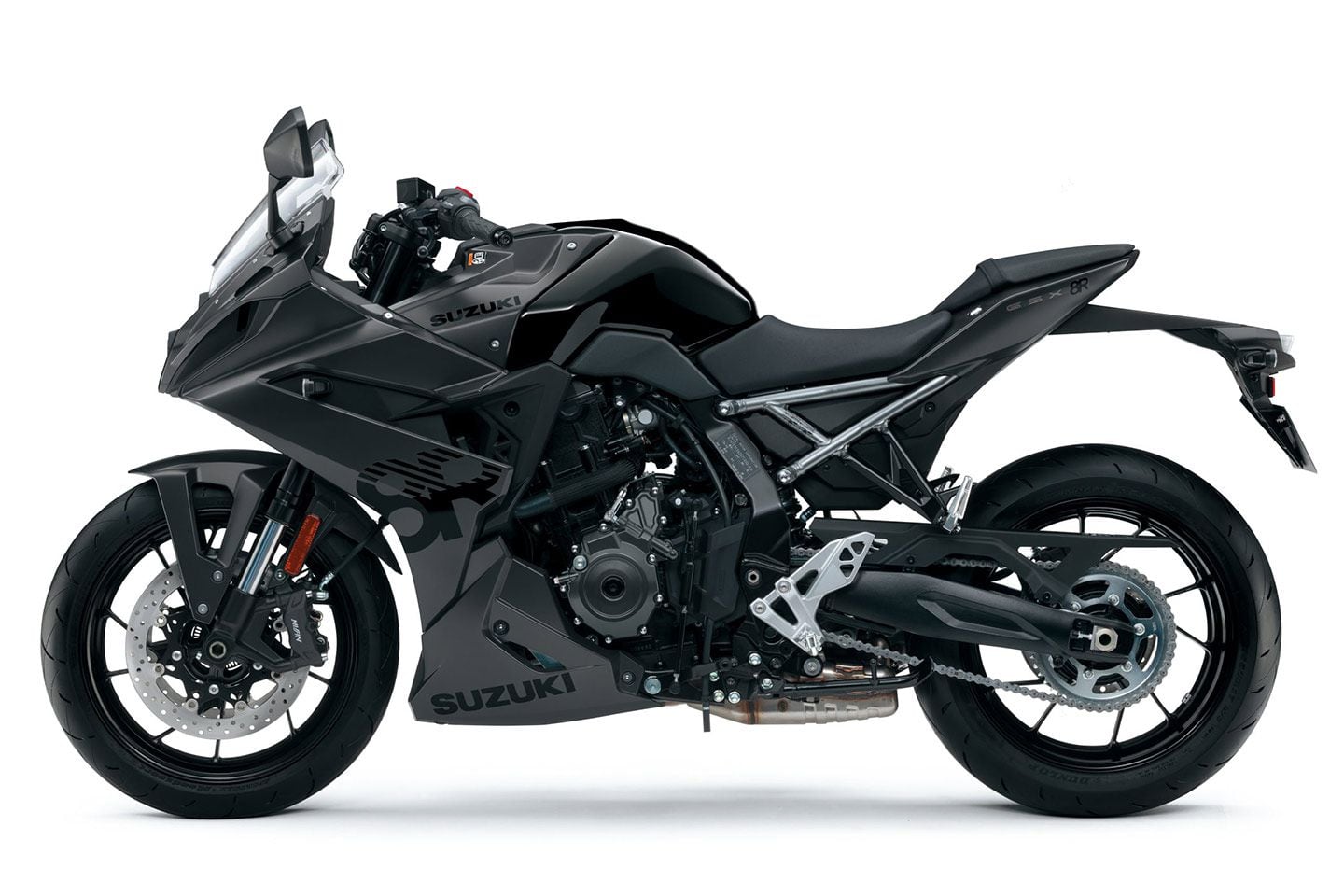
The 2024 Suzuki GSX-8R in black. (Suzuki/)2024 Suzuki GSX-8R Specs
MSRP: $9,439 Engine: DOHC, liquid-cooled, four-stroke parallel twin; 4 valves/cyl. Displacement: 776cc Bore x Stroke: 84.0 x 70.0mm Compression Ratio: 12.8:1 Transmission/Final Drive: 6-speed constant mesh/chain Claimed Horsepower: 81.8 hp @ 8,500 rpm Claimed Torque: 57.5 lb.-ft. @ 6,800 rpm Fuel System: Electronic fuel injection w/ 42mm throttle bodies Clutch: Wet, multiplate; cable actuation Engine Management/Ignition: Ride-by-wire w/ multiple modes Frame: Steel tube w/ bolt-on trellis subframe Front Suspension: 41mm Showa SFF-BP inverted fork; 5.1 in. travel Rear Suspension: Showa monoshock, preload adjustable; 5.1 in. travel Front Brake: Nissin radial-mount 4-piston calipers, 310mm discs w/ ABS Rear Brake: Nissin 1-piston caliper, 240mm disc w/ ABS Wheels, Front/Rear: Cast aluminum alloy; 17 in./17 in. Tires, Front/Rear: Dunlop Roadsport 2; 120/70-17 / 180/55-17 Rake/Trail: 25.0°/4.1in. Wheelbase: 57.7 in. Ground Clearance: 5.7 in. Seat Height: 31.9 in. Fuel Capacity: 3.7 gal. Claimed Wet Weight: 452 lb. Contact: suzukicycles.com -
CFMoto is ready to tackle the entry-level ADV segment with its newest parallel-twin-powered machine.
-
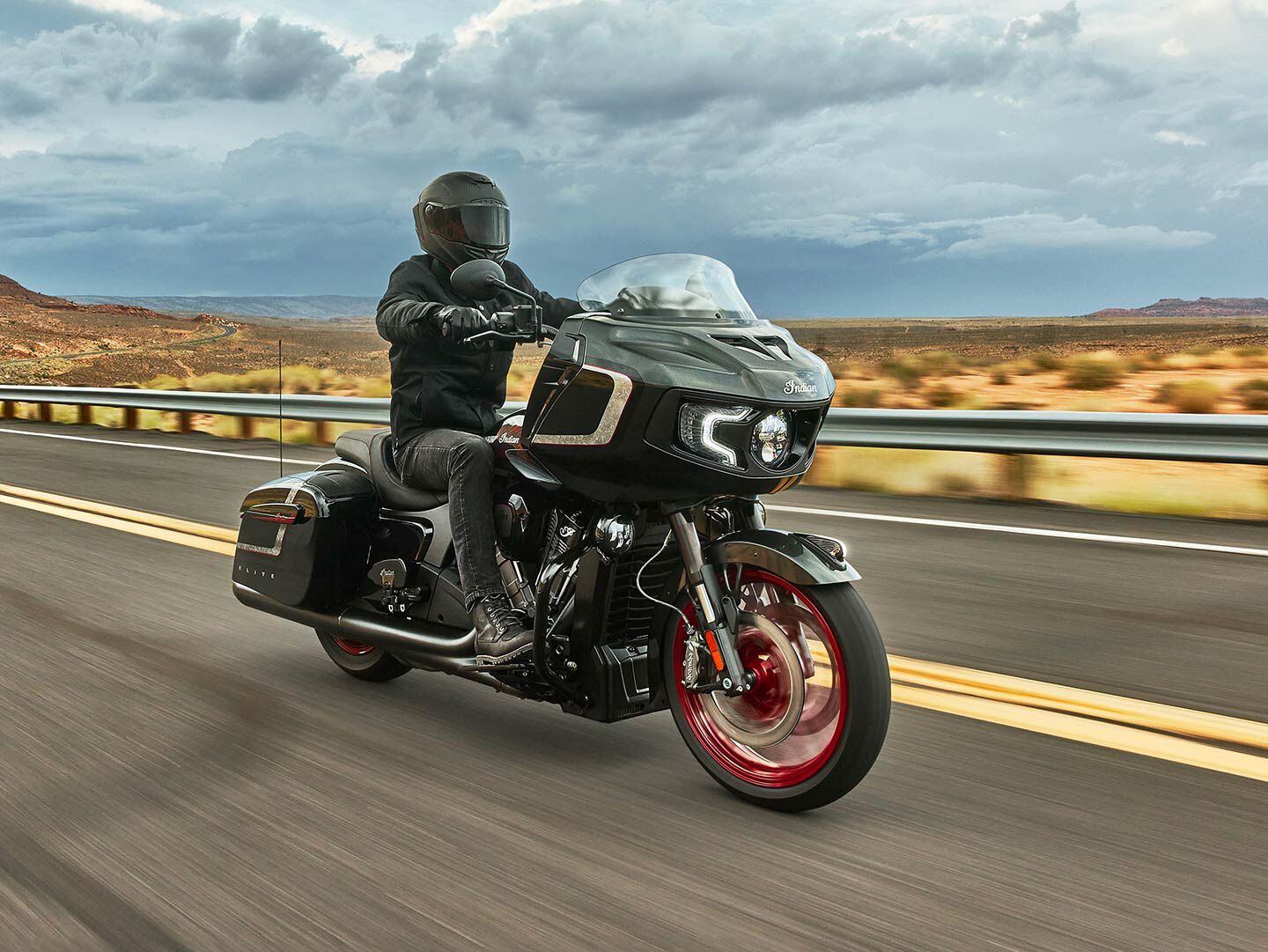
Indian has just announced the new 2024 Challenger Elite tourer, which is the only model in the Elite series this year (so far). (Indian Motorcycle/)Maybe the market for luxury tourers ain’t what it used to be, but for 2024 it looks like Indian Motorcycle is trimming its limited-edition Elite model lineup. Last year we saw the new full-dress Pursuit Elite, the 116ci Chieftain Elite, and a mildly updated Challenger Elite representing the tricked-out touring lineup, but for 2024, the brand is counting on just the Challenger to carry the Elite torch. That may be why the 2024 Challenger Elite looks a bit more spiffed up than last year’s subdued effort, with the class-leading bagger packing a raft of features like Indian’s completely redesigned PowerBand audio system, an all-new, custom-stitched seat, and a refined, custom Charcoal Candy paint scheme that’s a great fit for the premium tourer’s top-of-the-line standing. Indian says just 325 units will be available worldwide.
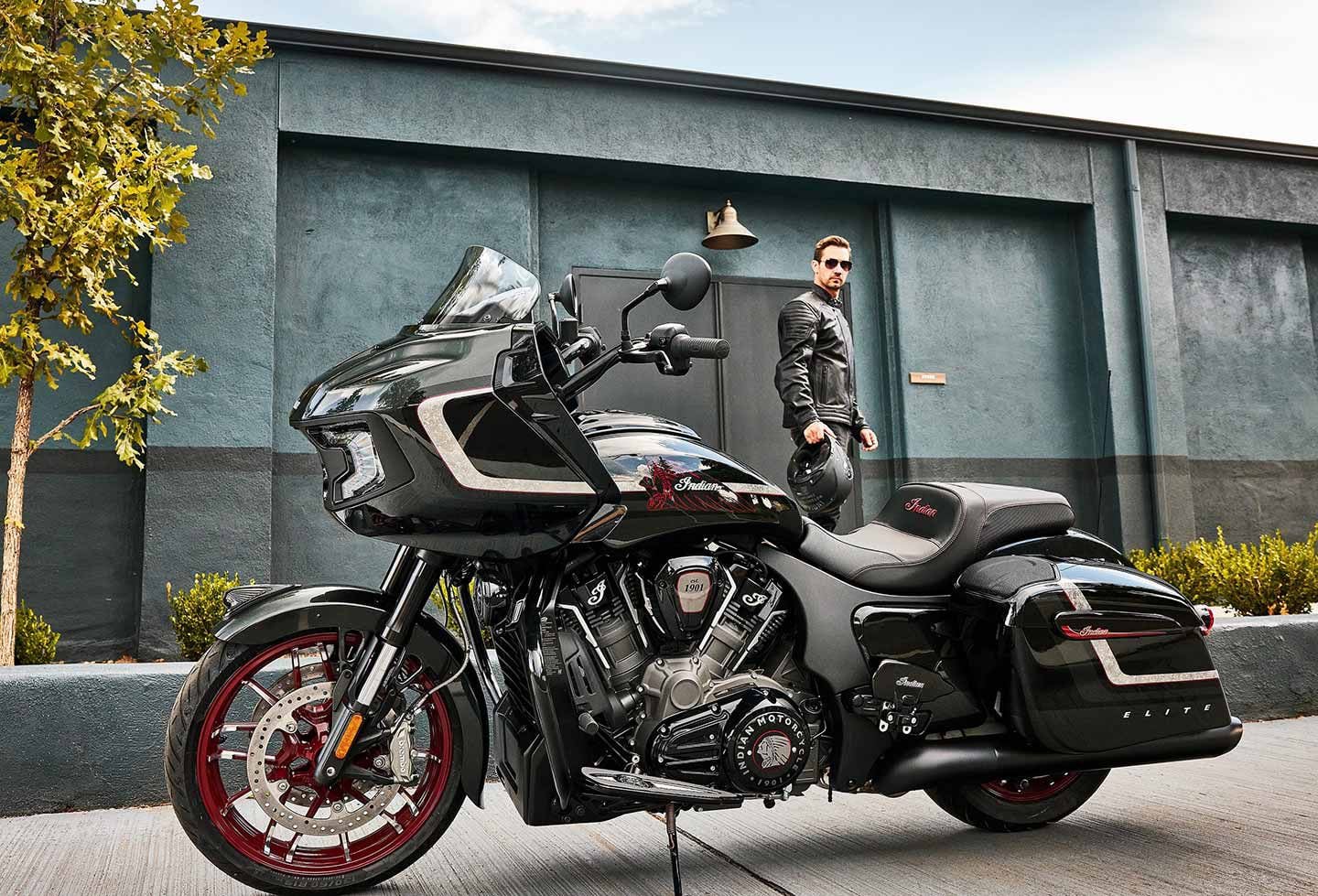
The limited-edition 2024 Challenger Elite will have a production run of only 325 units worldwide. (Indian Motorcycle/)The Minneapolis brand does call the Challenger Elite the “ultimate American bagger,” which is due largely to the 122-hp liquid-cooled PowerPlus engine, though that is unchanged this year, and it’s the same one in the standard Challenger. Still, 128 lb.-ft. of torque is nothing to sneeze at. In fact, you’ll find that much of the Challenger Elite’s running gear is shared with its base-model brother, down to the lightweight cast aluminum frame, inverted fork, chassis-mounted fairing, radially mounted Brembo brakes, 7-inch touchscreen display, and 18 gallons of cargo capacity.
Related: 2022 Indian Challenger Elite and Chieftain Elite First Look
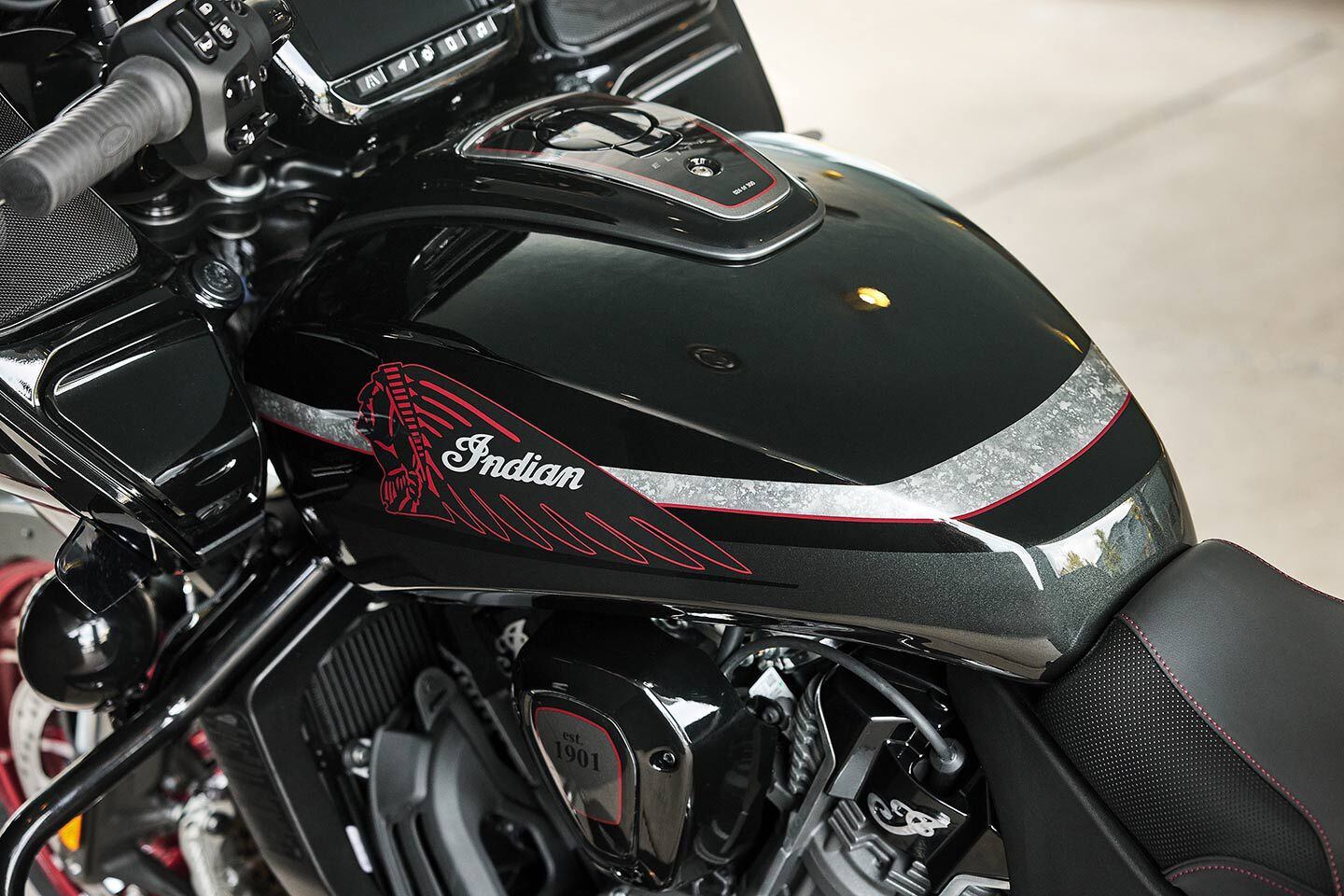
Richly detailed, custom Charcoal Candy paint treatment adds a refined attitude to the top-line bagger. (Indian Motorcycle/)You do get a raft of goodies on the Elite trim though; for starters, the electronically adjustable Fox rear suspension is standard issue on the Challenger Elite, so you can adjust the preload right from the bike’s infotainment system. The heart of that system is the 7-inch touchscreen powered by Indian’s Ride Command OS, which, as before, offers Apple CarPlay integration, turn-by-turn navigation, Bluetooth connectivity, and more.
The Elite also offers what Indian calls Smart Lean Technology, a suite of aids that uses a six-axis Bosch IMU to tune traction control and ABS by monitoring wheel slip and torque while optimizing output based on lean angle and whichever ride mode you’re in (Rain, Standard, or Sport). An adaptive LED headlight and LED driving light brighten the entire road for nighttime runs, and an adjustable flare windscreen ensures a smooth pocket of air when it’s time for a road trip. The long list of premium touring amenities continues with driver and passenger floorboards, heated grips, saddlebag lights, and saddlebag closeouts.
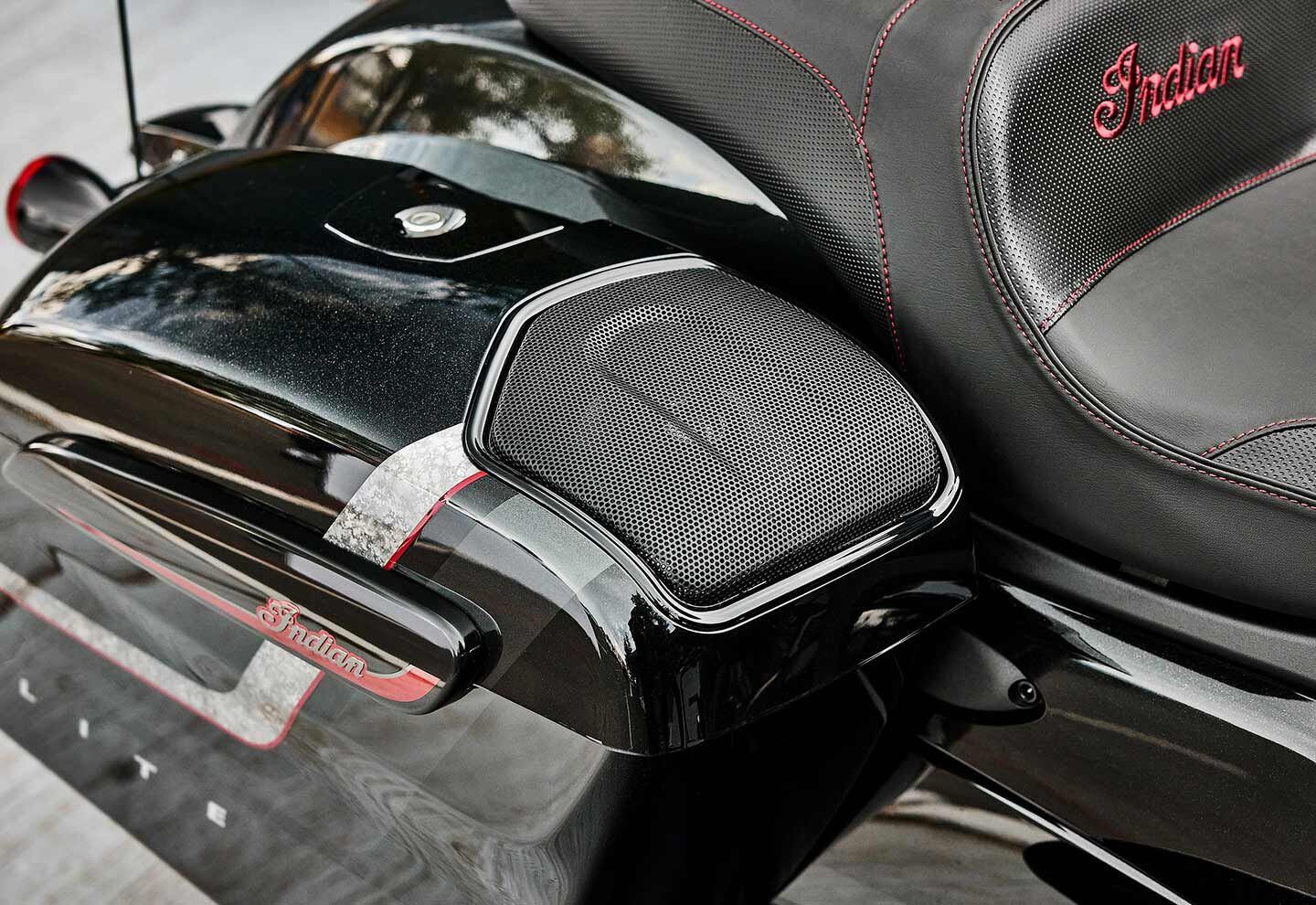
The Challenger Elite comes standard with the new PowerBand audio system. The 100-watt saddlebag speakers sport a modern look and UnderGlow, soft-white LED accent rings. (Indian Motorcycle/)The Elite’s biggest news for 2024 is the new PowerBand audio setup, which likewise uses the Ride Command brain to tap into an array of built-in amplifiers, a nine-band equalizer, and 16 speakers to deliver increased volume, more bass, and better sound clarity at speed. The 100-watt speakers utilize new Dynamic EQ for the highest-quality audio as speed and conditions change. Indian says the speakers are durable, water-resistant, and also bring a visual component, with a modern look and UnderGlow soft-LED accent lighting that will definitely stand out from your buddy’s system at bike night. The new PowerBand audio system is compatible with 2020–2024 models and comes standard on the Challenger Elite as well as a few other Indian bagger models.
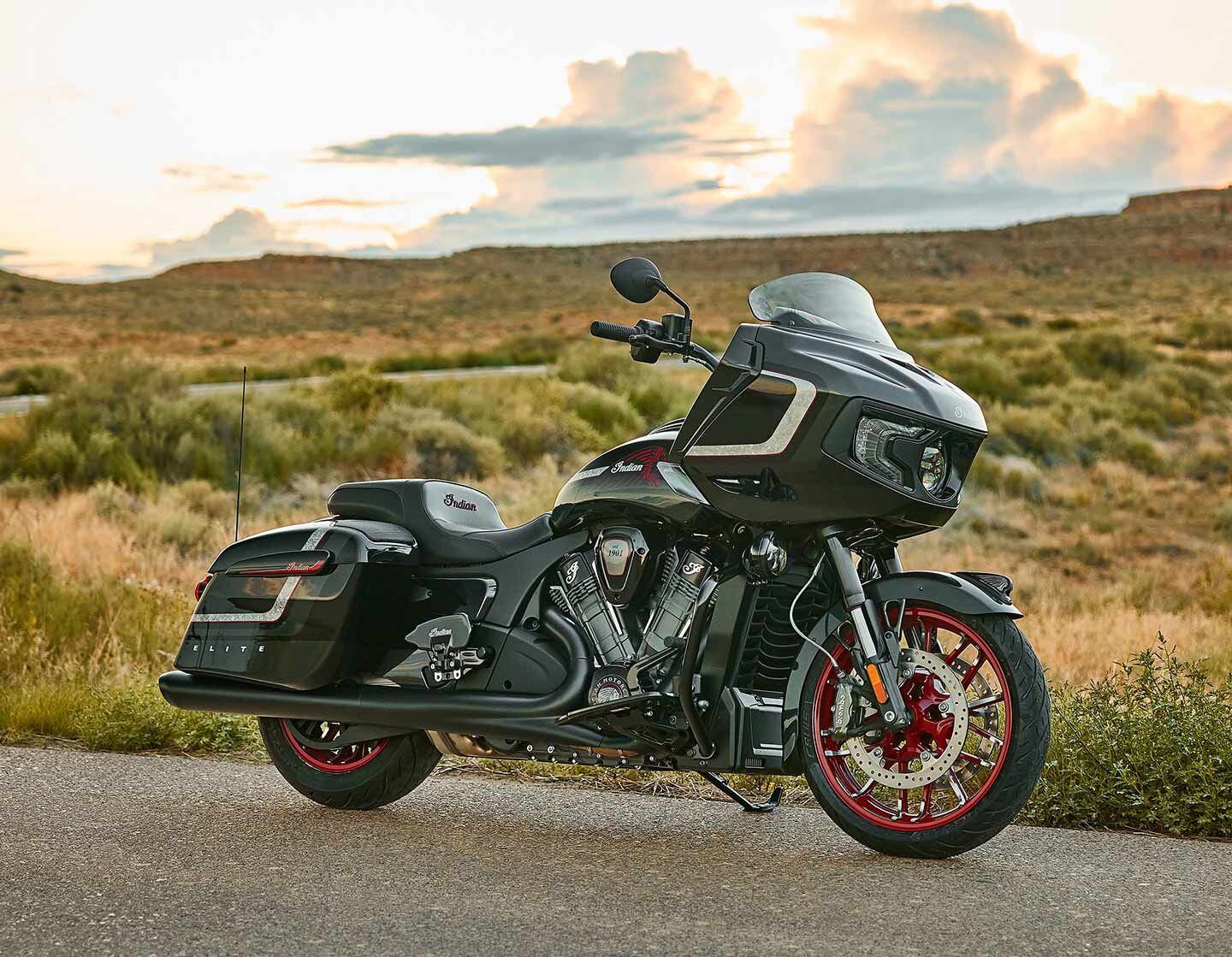
Precision-cut cast spoked 19-inch front wheel adds custom flair. Premium touches include Indian headdress, adaptive headlight (with LED driving lights integrated into the lower fairing), Elite badging, and rider and passenger floorboards. (Indian Motorcycle/)Pricing for the Challenger Elite begins at $38,499, and it’ll begin shipping this month to US and Canada Indian dealers.
The regular Challenger, the Challenger Dark Horse, and Challenger Limited are also returning for 2024, with no changes except color swaps and minor cosmetic refinements to the dash visor, storage door, dash trim, and gauge bezel. Prices start at $24,999 for the base-model Challenger. More info can be found at indianmotorcycle.com.
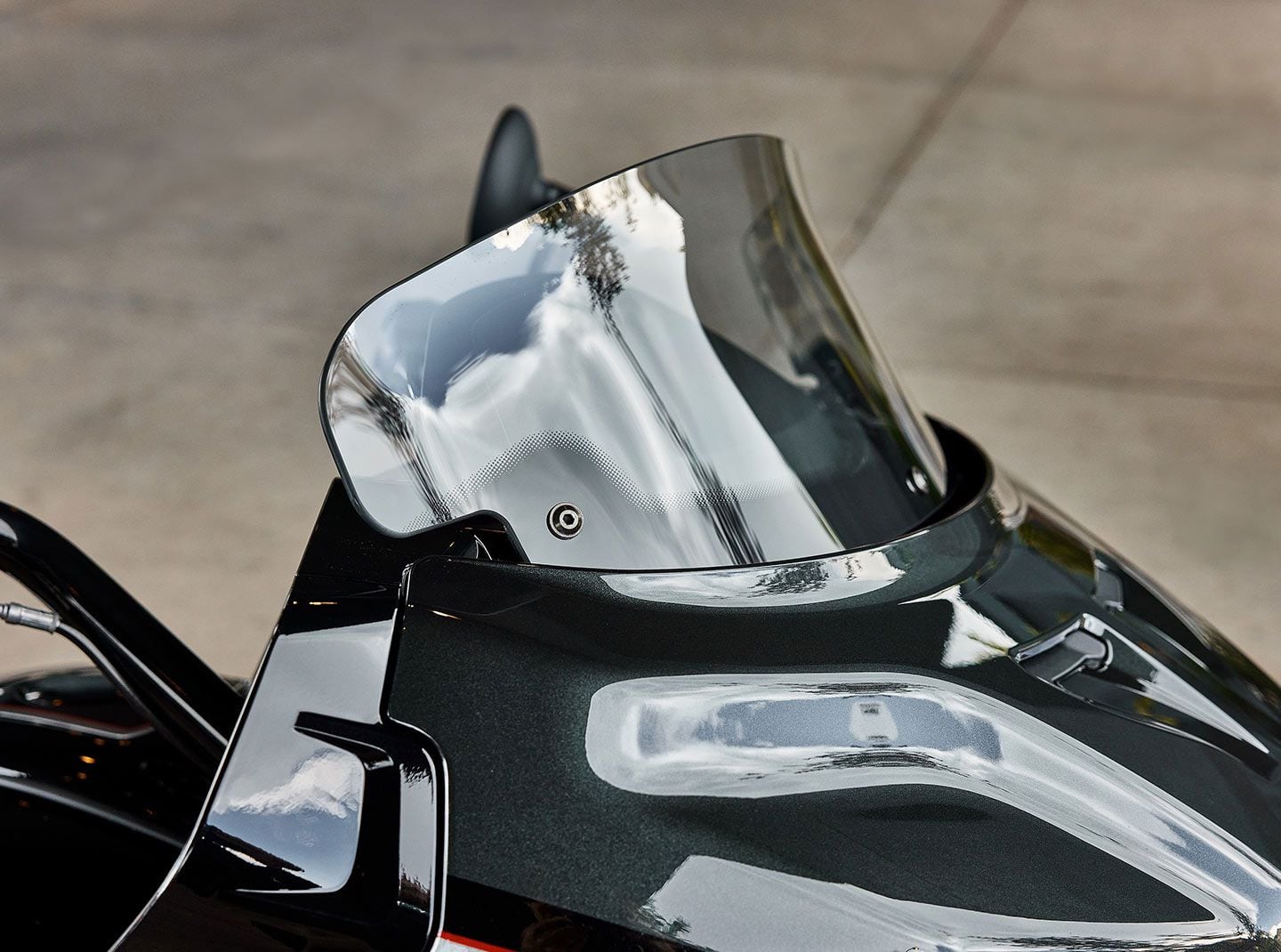
Adjustable flare windscreen on the 2024 Indian Challenger Elite. (Indian Motorcycle/)2024 Indian Challenger Elite Specs
MSRP: $38,499 Engine: 1,768cc, liquid-cooled 60-degree V-twin Bore x Stroke: 108.0 x 96.5mm Compression Ratio: 11.0:1 Claimed Horsepower: 122 hp Claimed Torque: 128 lb.-ft. @ 3,800 rpm Transmission/Final Drive: 6-speed/belt Fuel Delivery: Closed-loop electronic fuel injection w/ 52mm throttle bodies Clutch: Wet, multiplate w/ assist Front Suspension: 43mm telescopic fork; 5.1 in. travel Rear Suspension: Fox single shock, electronically adjustable preload; 4.5 in. travel Front Brake: 4-piston calipers, dual 320mm floating discs w/ ABS Rear Brake: 2-piston caliper, 298mm floating disc w/ ABS Wheels, Front/Rear: 5-spoke cast; 19 x 3.5 in./16 x 5 in. (w/ tire pressure monitoring) Tires, Front/Rear: Metzeler Cruisetec; 130/60B-19 / 180/60R-16 Rake/Trail: 25.0°/5.9 in. Wheelbase: 65.7 in. Ground Clearance: 5.4 in. Seat Height: 26.5 in. Fuel Capacity: 6.0 gal. Claimed Dry Weight: 804 lb. Contact: indianmotorcycle.com -
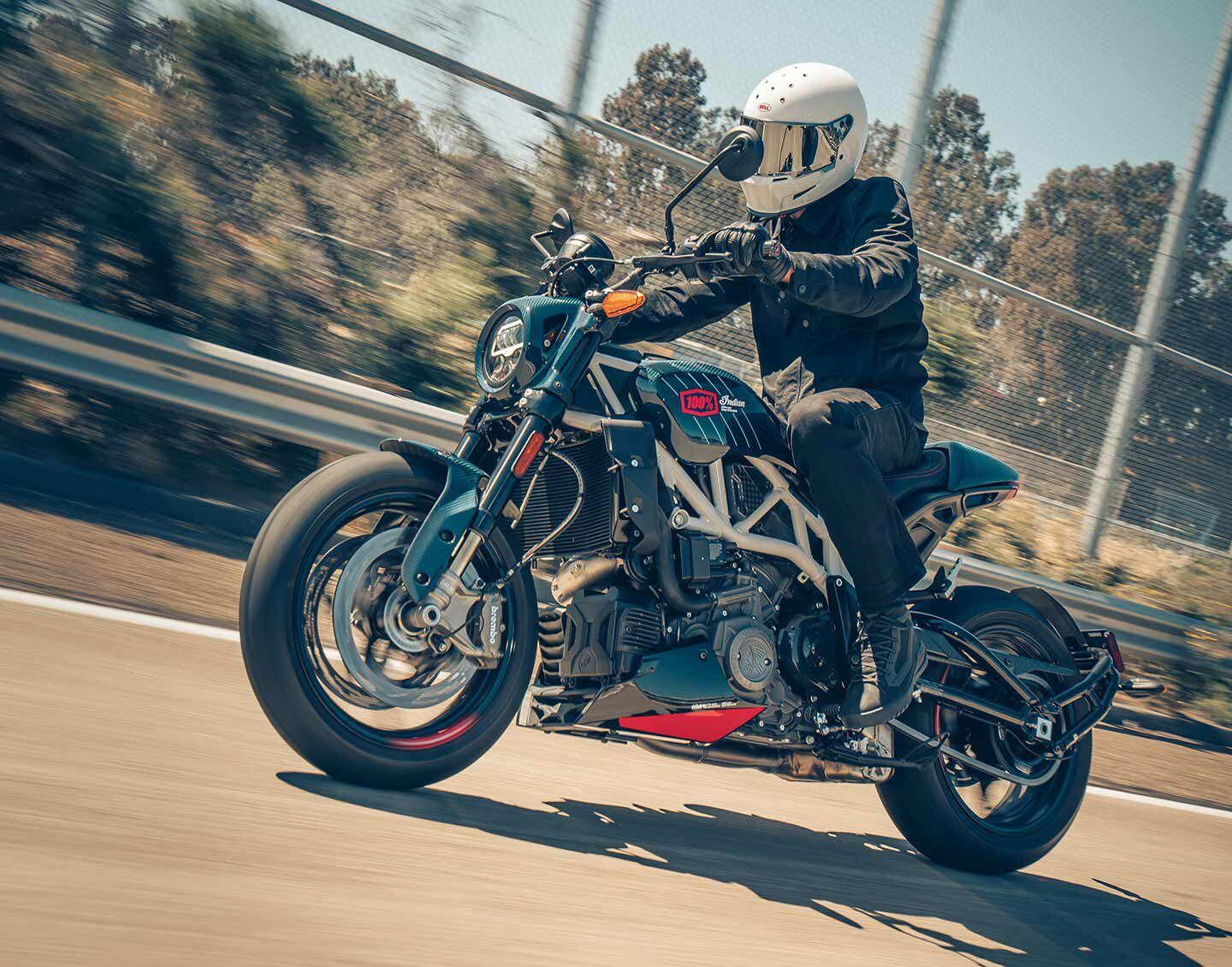
Indian teams up with motocross gear maven 100% to bring us the FTR x 100% R Carbon for 2024. (Indian Motorcycle/)The Indian FTR took the moto world a bit by surprise when it hit the streets in 2019. A V-twin sport standard with modern tech wearing a classic badge from a bygone era? We all cheered for the new hooligan in town, and when the FTRs were refined even more a couple of years ago, getting 17-inch wheels with sport tires rather than the taller, flat-track-inspired 18- and 19-inchers of Gen 1, their street worthiness got even more of a boost. A fresh ECU tune, narrower handlebar, and a switch to fully adjustable suspension (which lost a bit of travel in the process) in 2022 now brings us to 2024. We’ll see four trim levels for the model year, including this new FTR x 100% R Carbon model.
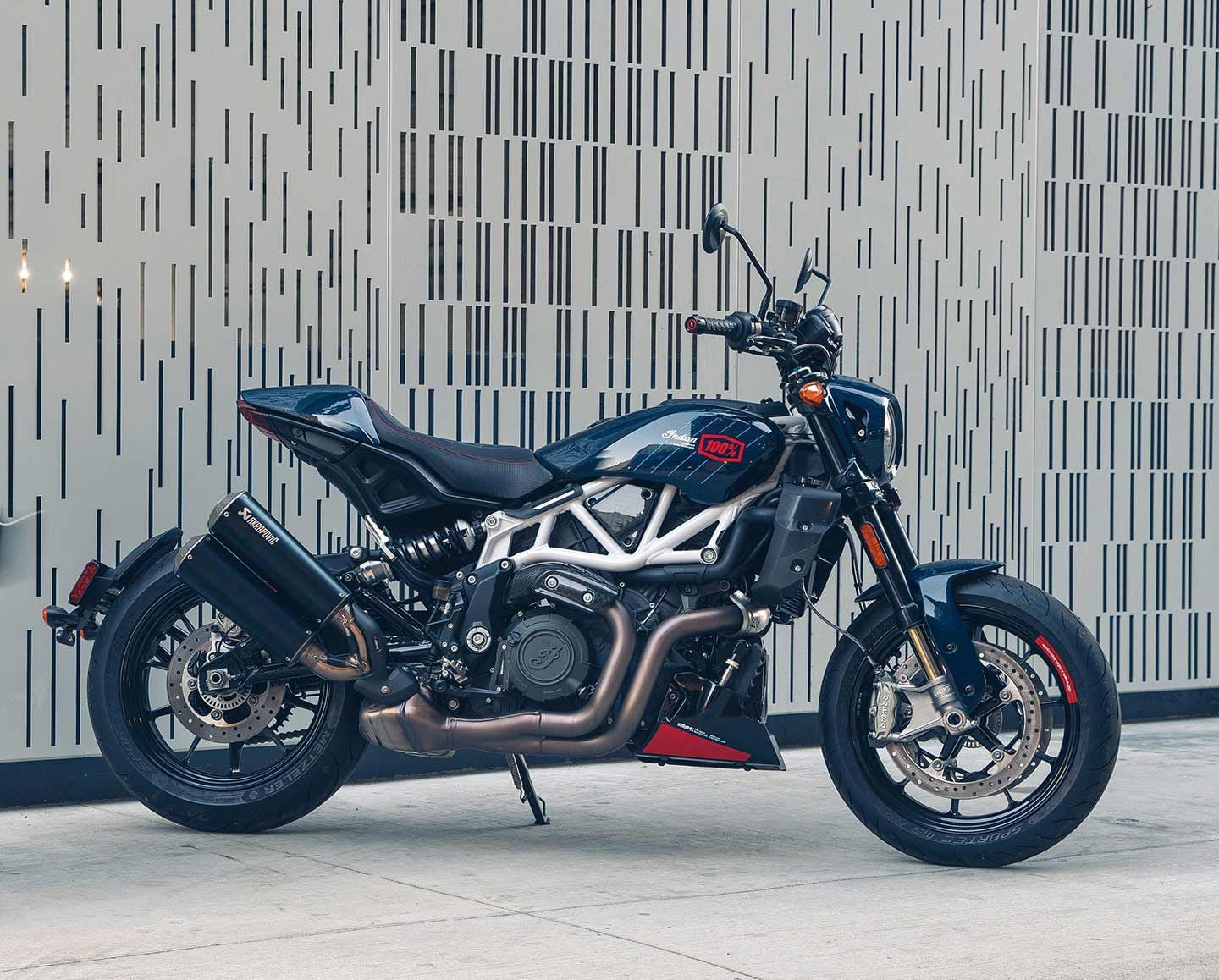
The limited-edition FTR x 100% R Carbon will have only 400 units available worldwide. (Indian Motorcycle/)The “x” part, as you’ve already guessed, signals a collaboration and in this case it’s Indian partnering up with 100%, a brand with deep roots in the modern motocross world. The logo was prevalent on early 1980s factory racing equipment, and today has seen a resurgence with a new generation of racers answering to the original tagline: “How much effort do you give?”
Indian aims to tap into that action-sport vibe by outfitting its top-of-the-line FTR R Carbon model with a host of trick details to set it apart from the already high-spec R Carbon (which is back this year unchanged). Below the covers, both bikes roll with
a 120 hp, liquid-cooled 1,203cc V-twin engine paired to a steel trellis frame, fully adjustable Öhlins suspension front and rear, radially mounted dual-disc Brembo brakes, a 4-inch touchscreen display powered by Indian’s Ride Command system and three selectable ride modes. An assist/slip clutch eases gear swaps and Metzeler Sportec rubber rolls below. So what, then, distinguishes the FTR x 100% R Carbon from its donor bike?
Related: 2022 Indian FTR 1200 First Ride Review
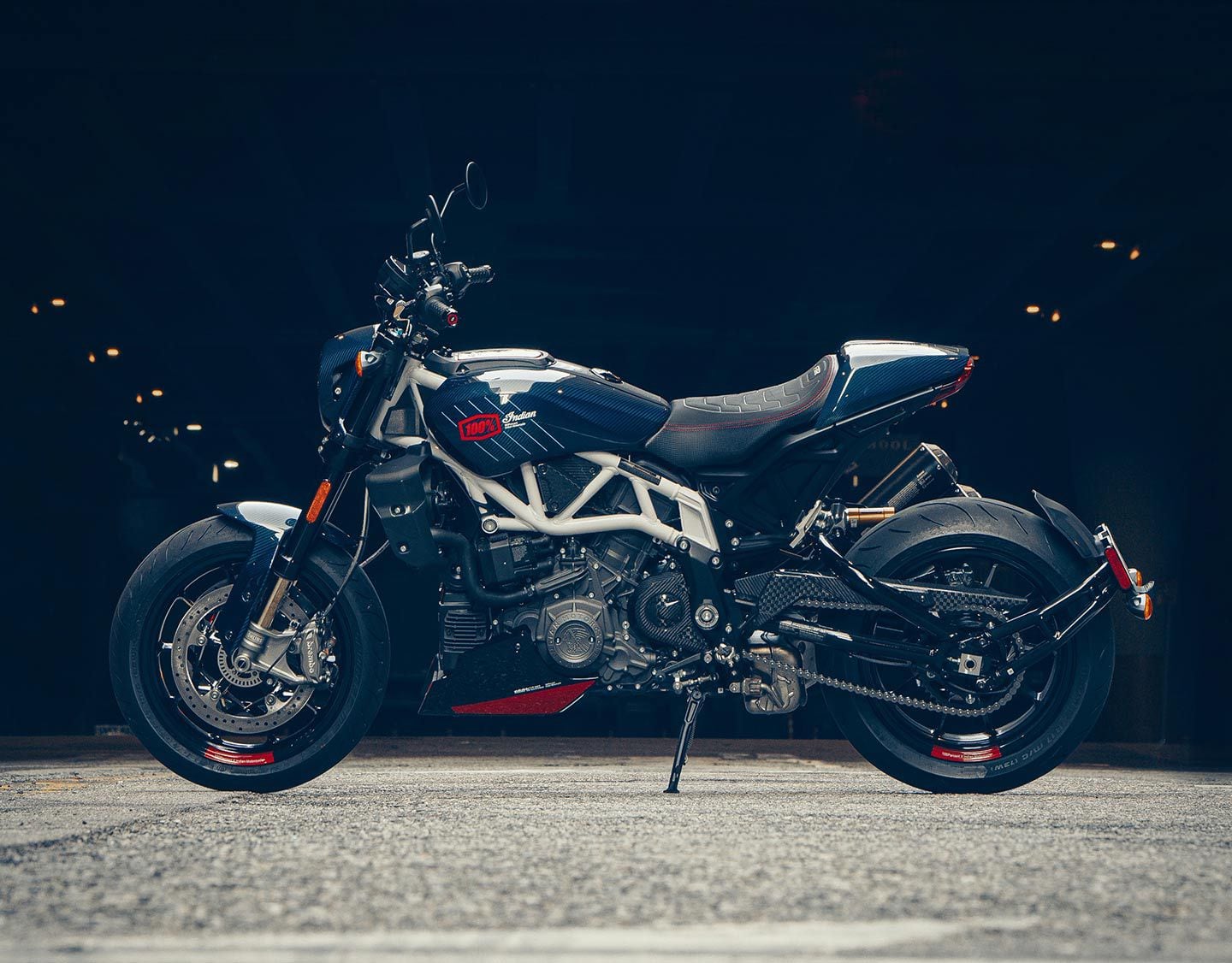
A powdercoated frame, one-off Blue Candy carbon fiber body parts, and a plethora of red accents and logos tell you this is the 100% FTR. (Indian Motorcycle/)According to Indian, it’s “for the performance-minded rider who wants to stand out from the crowd.” In other words, branding is the key here, with Indian Motorcycle and 100% logos highlighting each tank side, the chin scoop, its rear seat cowl, and even a swath on the wheel rim. The already awesome Öhlins fork and rear shock spring get a custom blacked-out treatment for—ahem—”100% more attitude.” A black-finished stacked titanium Akrapovič exhaust and carbon fiber components—engine covers, chain guard, and exhaust heat shield—add the kind of unique detailing you’d expect on a limited-edition model.
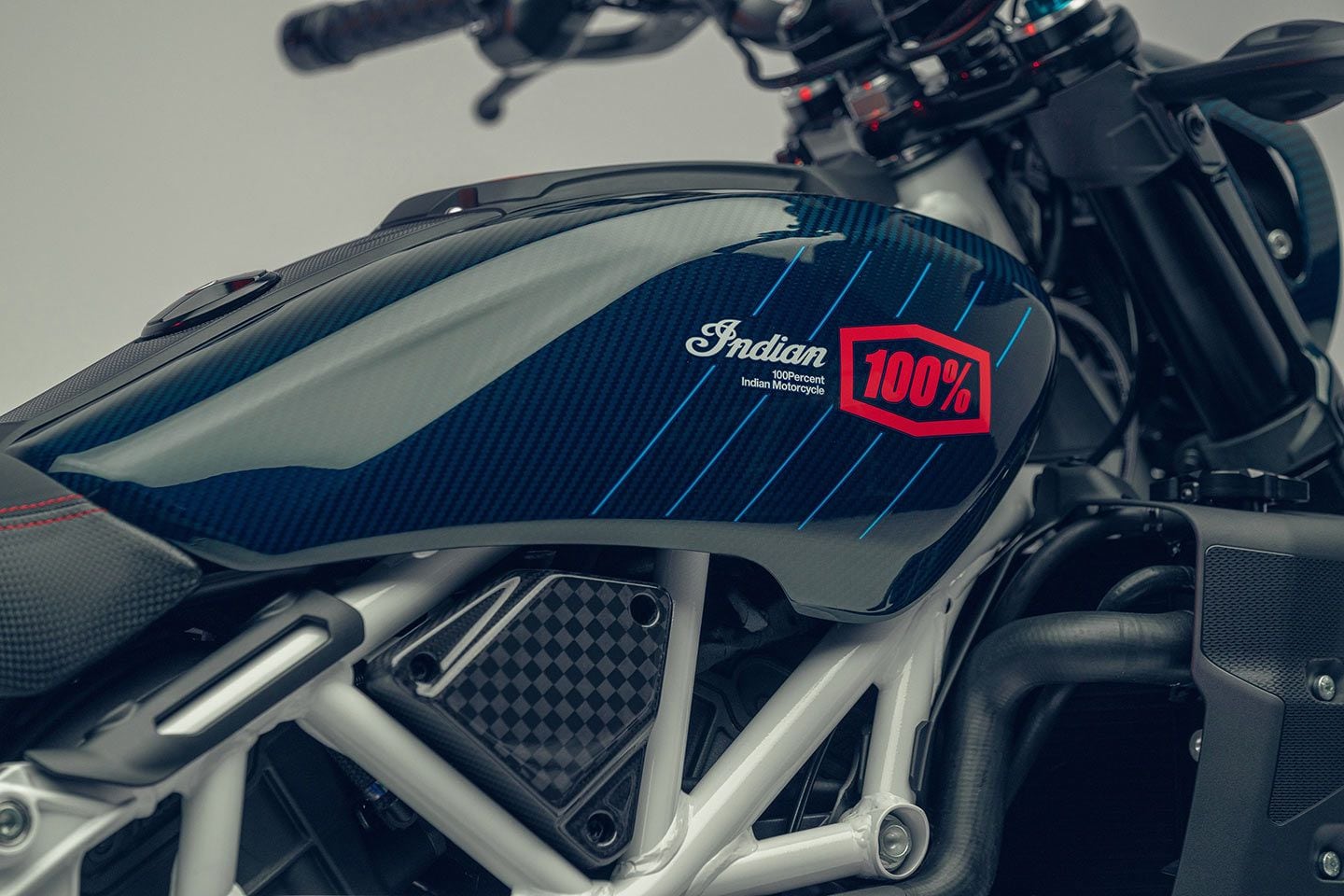
Close-up of the FTR x 100% R Carbon’s carbon fiber tank with 100% logo set off by the lighter powdercoated frame. (Indian Motorcycle/)And then there’s the one-off color treatment. The 100% bike goes with a one-of-a-kind Blue Candy carbon fiber tank, with the headlight nacelle, seat cowl, and front fender also matching, and a frame powdercoated in bright white to add contrast. Red stitching on the custom seat classes things up, while Gilles Tooling parts (which include bar-end weights, oil cap, and radiator cap) likewise reinforce the premium theme.
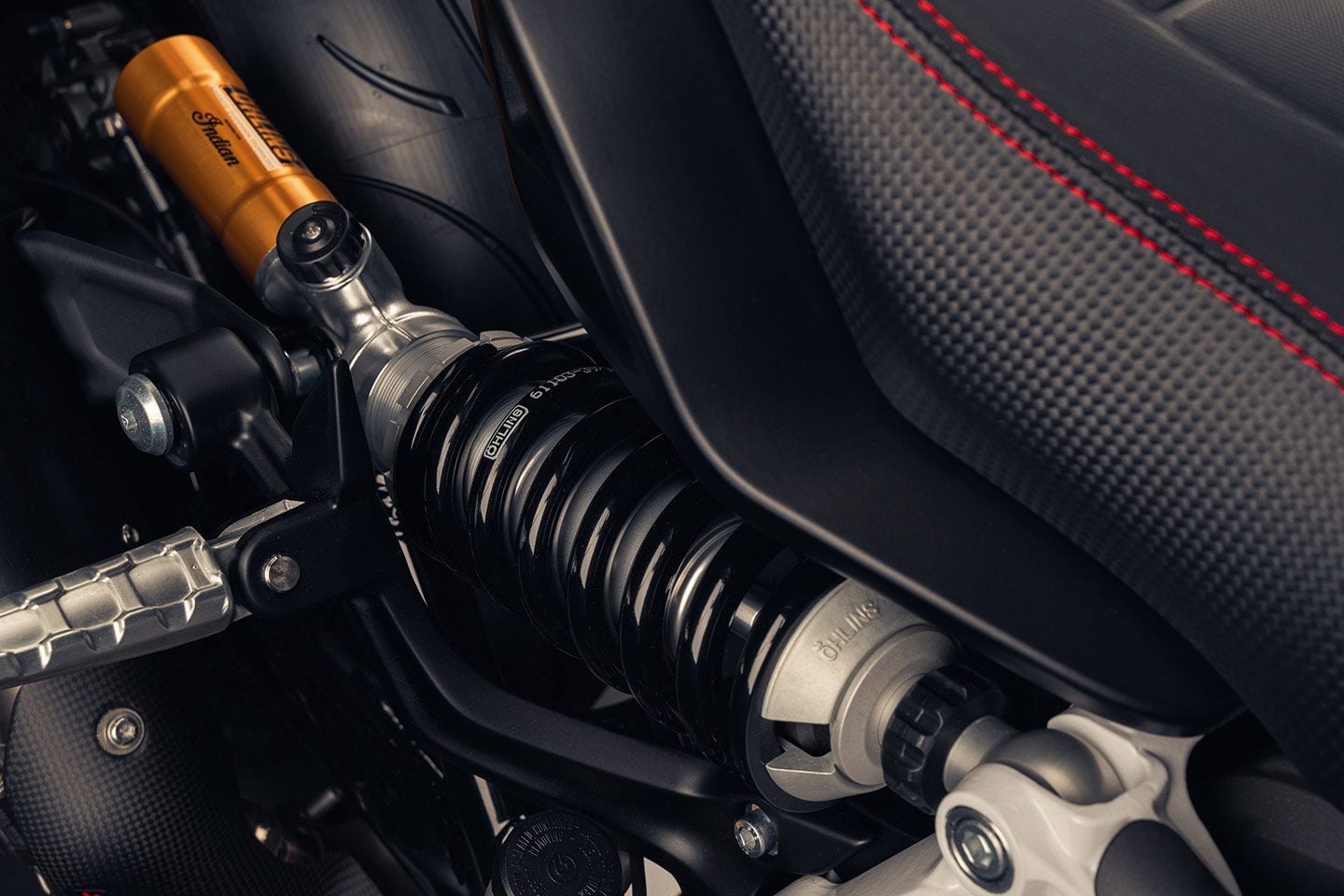
As on the regular R Carbon model, the Öhlins rear IFP shock on the 100% bike is fully adjustable. (Indian Motorcycle/)Decked out in all that finery, it’s not surprising that the FTR x 100% R Carbon is a limited-edition bike, and only 400 units will be offered worldwide. The bike will have a starting MSRP of $18,999 and will begin arriving to dealers in the US and Canada this month. For more info see indianmotorcycle.com.
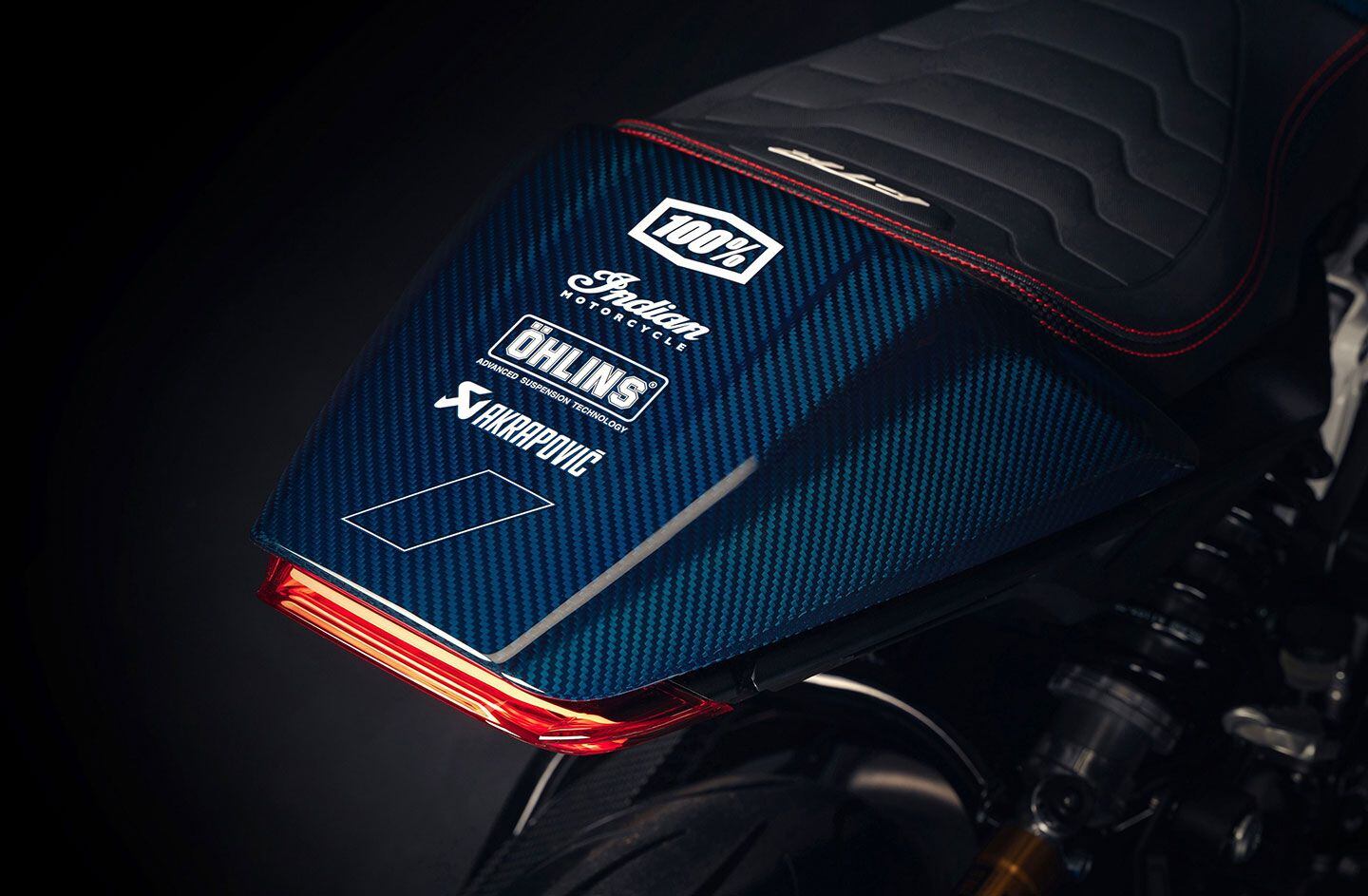
The FTR x 100% bike is swimming in carbon fiber, custom paint, and premium components. (Indian Motorcycle/)Also in keeping with the gear theme, Indian is throwing in a pair of Indian Motorcycle x 100% sunglasses with the purchase of the bike, though no other details about said shades (carbon fiber frame though, we’re guessing?) were offered. The gear theme continues (at least they’re consistent) with the brand also rolling out an Indian Motorcycle x 100% apparel line with the usual mix of shirts, hoodies, hats, and sunglasses, all available at Indian Motorcycle dealerships and online.
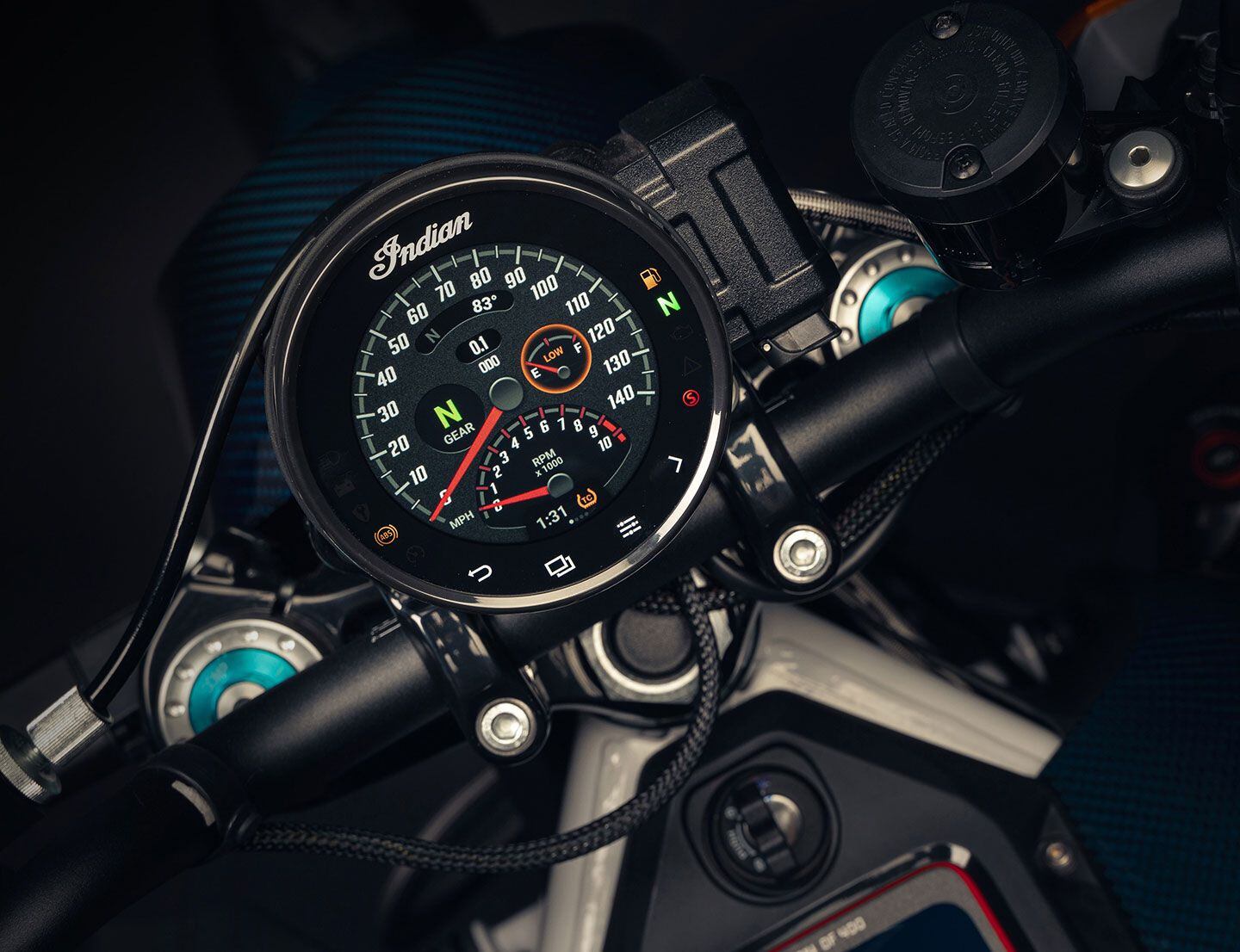
Indian’s Ride Command system powers the 4-inch touchscreen display. As with the R Carbon, there are three ride modes, lean-angle-sensitive ABS, stability control, traction control, wheelie and rear lift mitigation, a USB port, and cruise control. (Indian Motorcycle/)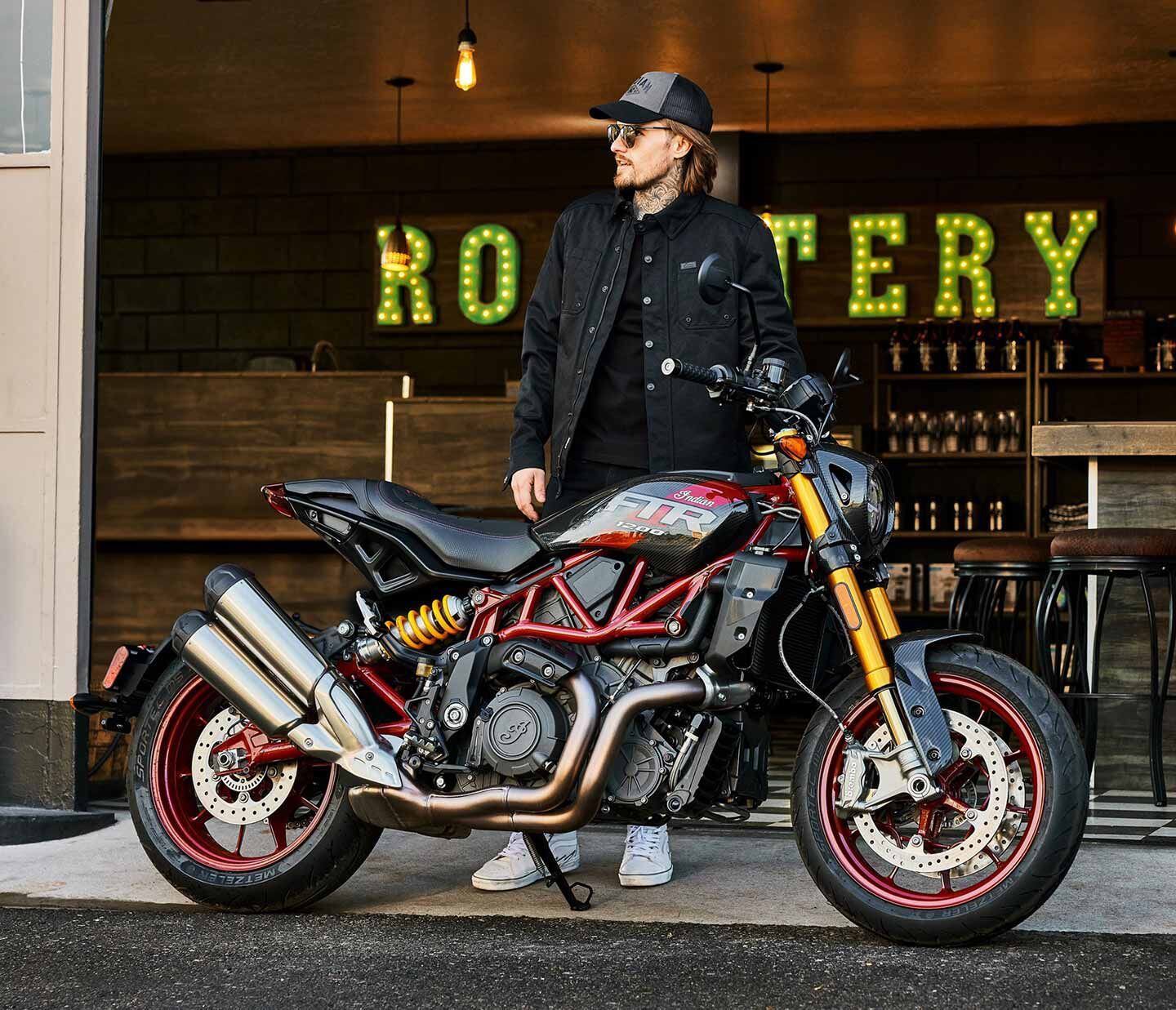
The FTR R Carbon is back in the line for 2024, with an MSRP of $17,249. The FTR Sport and base-model FTR also return this year. (Indian Motorcycle/)2024 Indian FTR x 100% R Carbon Specs
MSRP: $18,999 Engine: 1,203cc, liquid-cooled 60-degree V-twin Bore x Stroke: 102.0 x 73.6mm Compression Ratio: 12.5:1 Claimed Horsepower: 120 hp @ 7,750 rpm Claimed Torque: 87 lb.-ft. @ 6,000 rpm Transmission/Final Drive: 6-speed/chain Fuel Delivery: Closed-loop electronic fuel injection w/ 60mm throttle bodies Clutch: Wet, multiplate, slipper/assist Front Suspension: 43mm Öhlins inverted telescopic fork, fully adjustable; 4.7 in. travel Rear Suspension: Öhlins piggyback IFP shock, fully adjustable; 4.7 in. travel Front Brake: 4-piston calipers, dual Brembo 320mm discs w/ ABS Rear Brake: 2-piston caliper, Brembo 260mm disc w/ ABS Wheels, Front/Rear: Cast; 17 x 3.5 in. / 17 x 5.5 in. Tires, Front/Rear: Metzeler Sportec; 120/70ZR-17 / 180/55ZR-17 Rake/Trail: 25.3°/3.9 in. Wheelbase: 60.0 in. Ground Clearance: 6.5 in. Seat Height: 32.2 in. Fuel Capacity: 3.4 gal. Claimed Dry Weight: 486 lb. Contact: indianmotorcycle.com -
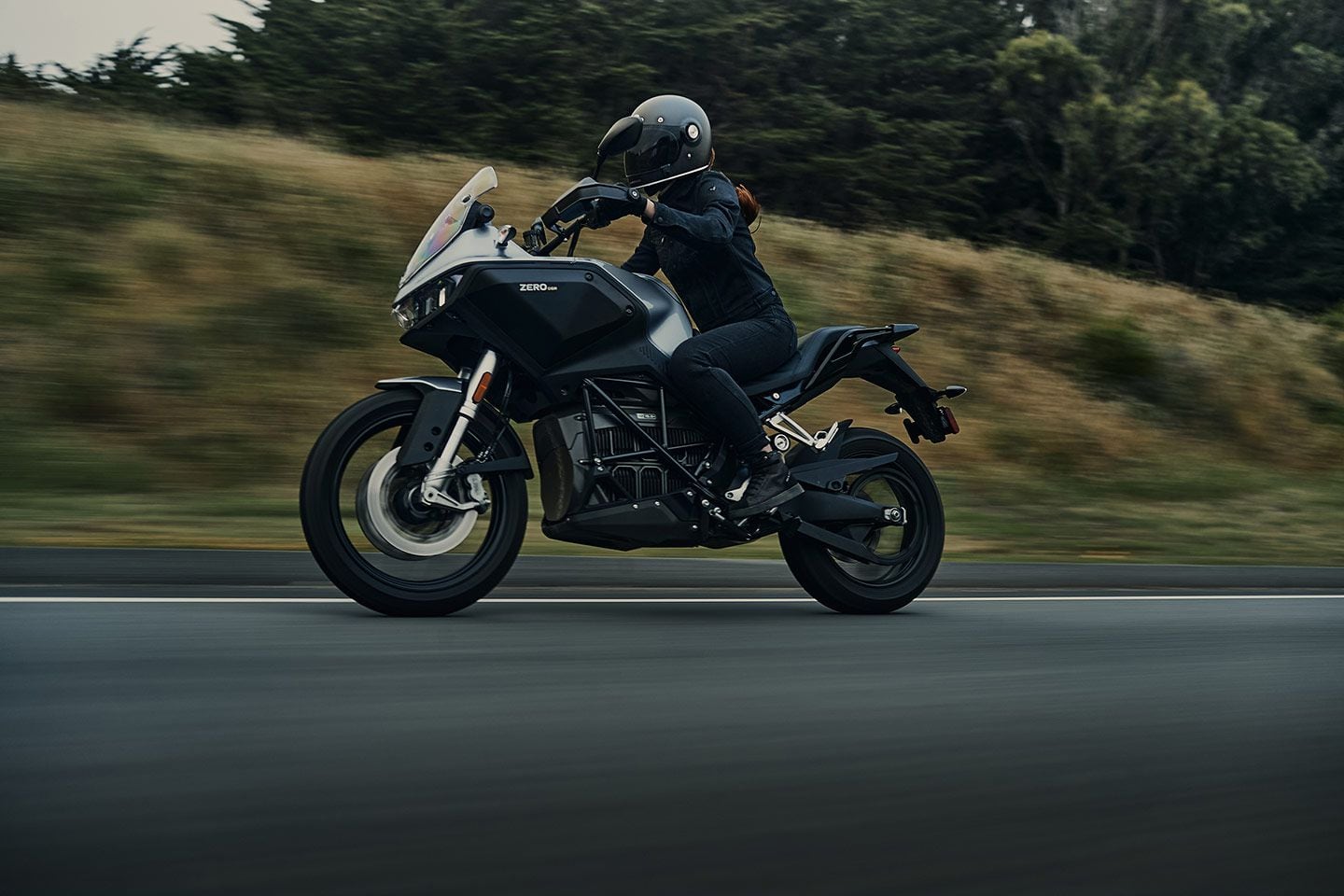
Zero’s DSR is all new with an uprated motor, higher-capacity battery pack, and all-new styling. (Zero Motorcycles/)Zero Motorcycles has released information on its 2024 model lineup, which includes three models that have been completely redesigned. Key to those additions are motorcycles aimed at the mid-power-output category, ensuring that riders from novice to expert can find an electric motorcycle that suits their needs and budgets.
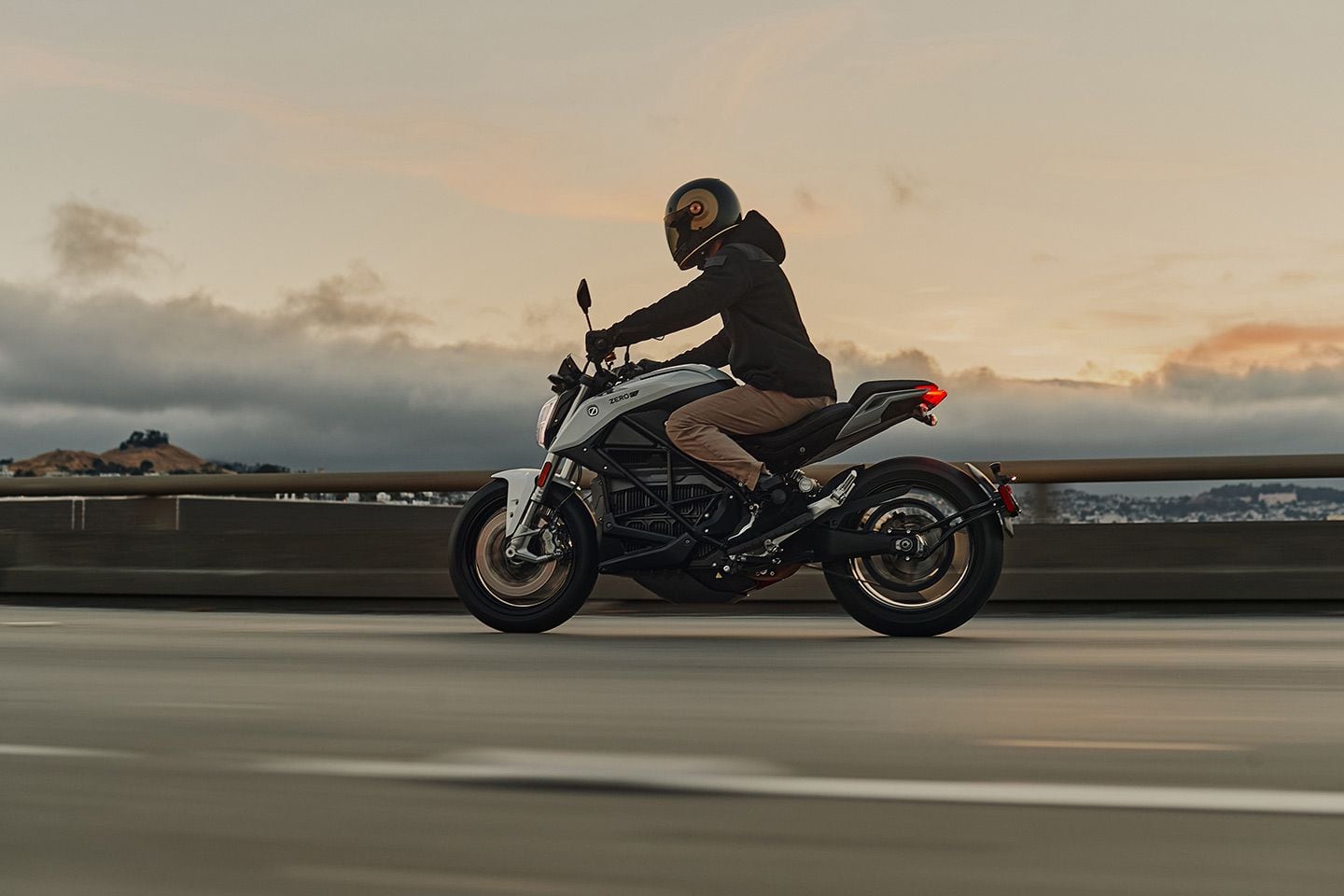
Zero’s Model S gets updates across the board with a more powerful motor, higher-capacity battery, and new styling. (Zero Motorcycles/)Topping the list is the all-new Model S that is fitted with a brand-new motor, new battery pack, and updated styling. The Model S now comes with a 14.4kWh battery pack which offers twice the capacity of the previous model’s 7.2kWh unit. The new motor offers much improved output with claimed power increasing from 46 to 68 hp and torque increasing from 78 to 97 lb.-ft. of peak output compared to the 2023 S. Top speed is a claimed 104 mph.
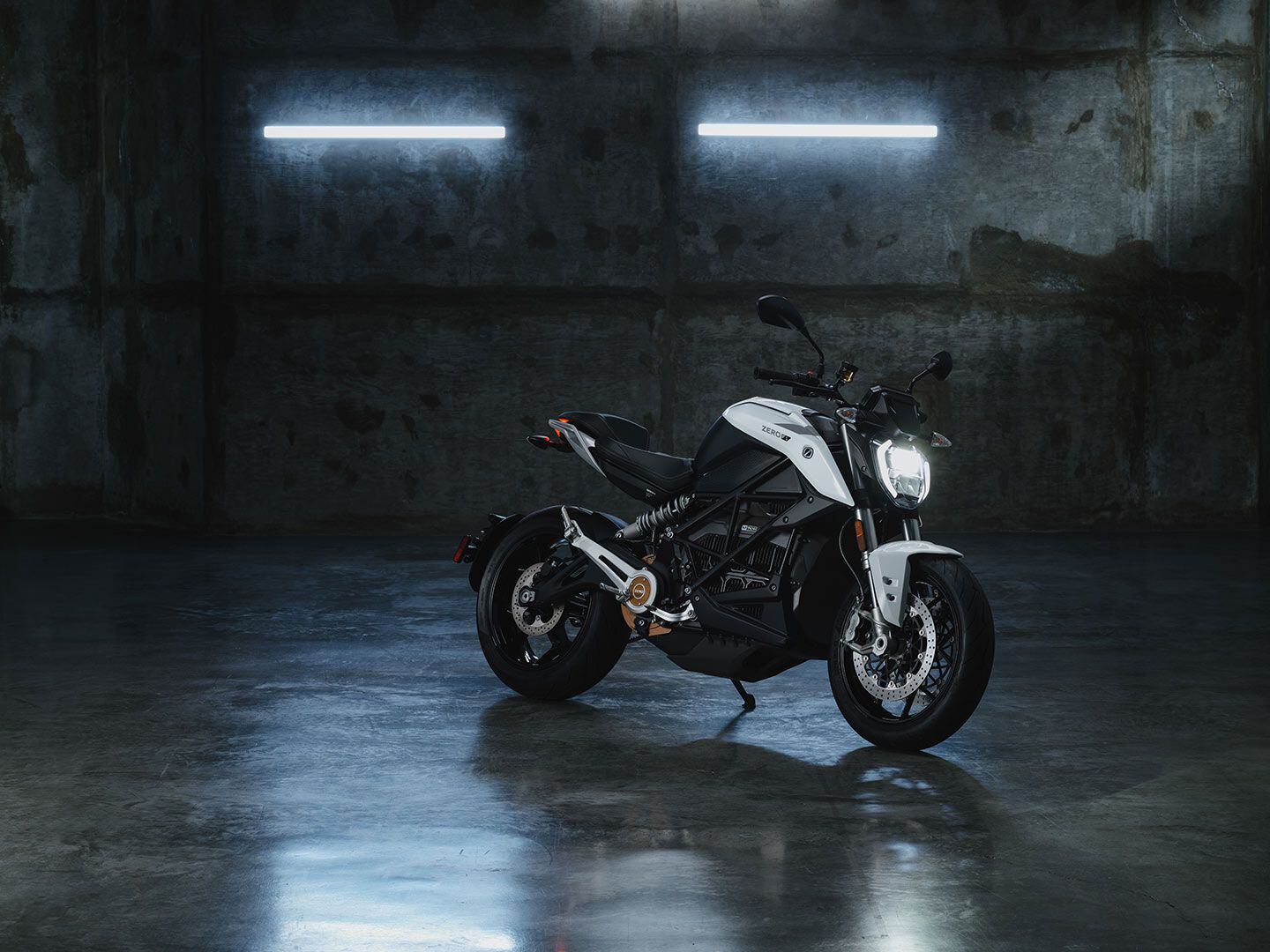
The Model S gets a motor rated at 68 hp and 97 lb.-ft. of peak torque. (Zero Motorcycles/)Claimed ranges are 154 miles in urban use, 113 miles in mixed (urban/highway) use, and 101 miles of highway range. Charge time varies dramatically depending on the charger used. When plugged into a standard household outlet it will take around nine hours, while at the opposite end of the spectrum a 6kW rapid charger can get the battery to 95 percent in just under an hour and a half.
The press release for the naked Model S doesn’t list the specifics of the chassis and its components, but the previous model used a 41mm Showa fork with provisions for preload, compression, and rebound adjustability, while a shock of the same make was also fully adjustable. Braking is likely to be identical to those used on the previous model with a J.Juan caliper and 320mm disc up front and a 240mm disc out back. Seat height has dropped from 31.8 to 31 inches, which will allow the bike to appeal to a wider group of riders. With all that extra battery capacity comes a big chunk of additional weight, increasing by 179 (!) pounds to 492.
The Model S will be available in a white and silver paint scheme for $14,995.
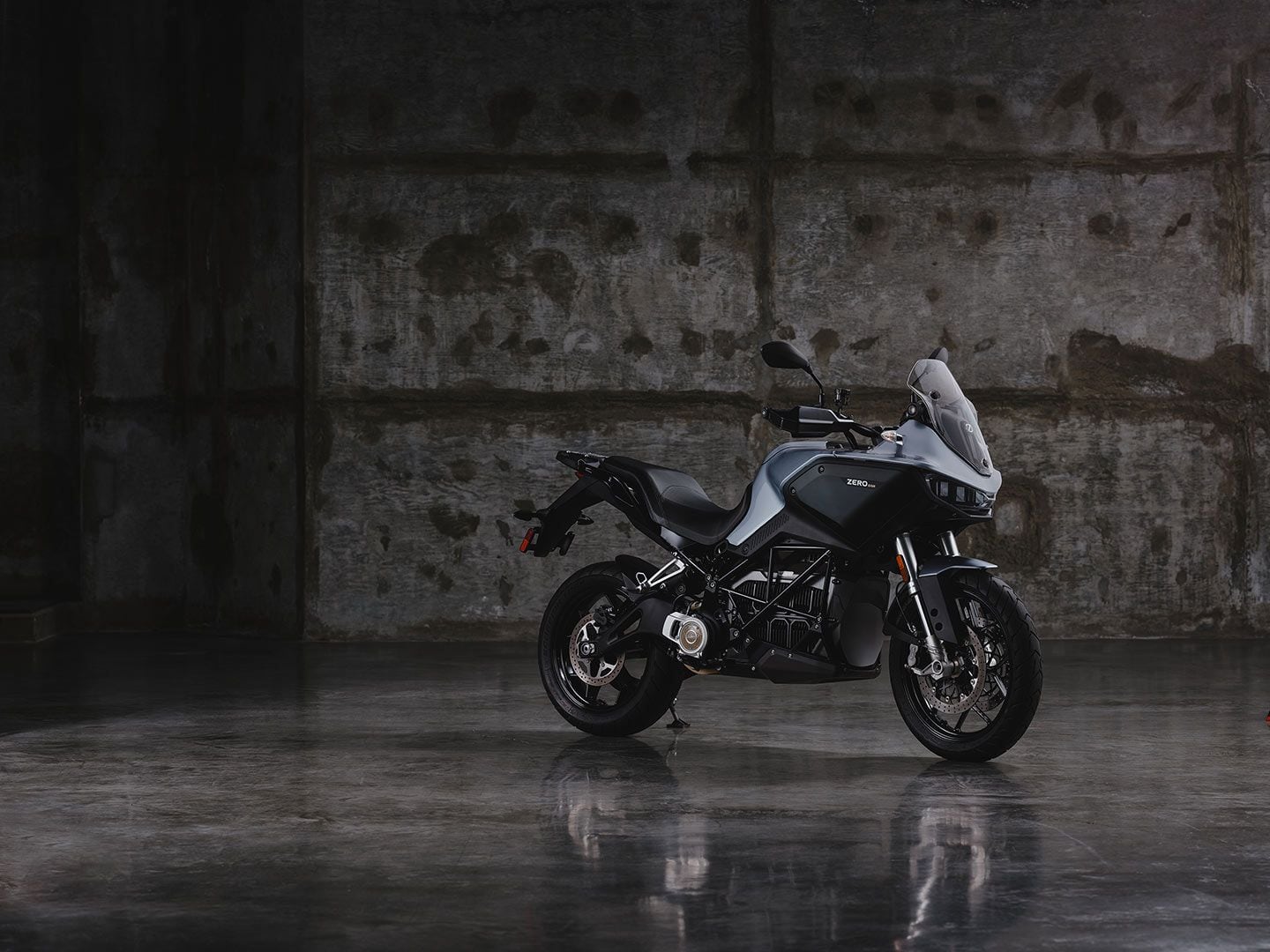
The brand-new DSR follows in the footsteps of the DSR/X that was released last year. A large ADV-style fairing is a big departure from the bike it replaces. (Zero Motorcycles/)Following in the footsteps of last year’s DSR/X adventure bike, Zero has announced two new DS line models including the DSR and DS. The dual sport offerings feature stout reinforced chassis and uprated Gates carbon belt drives in addition to other off-road-oriented features.
The DSR has a brand-new 15.6kWh battery pack with a claimed 155-mile city range and 100-mile mixed city/highway range. Top speed is a claimed 104 mph from the new 80 hp/144 lb.-ft. motor.
Styling on the DSR is a dramatic departure from the previous model with the new bike offering a large upper fairing and much more enclosed cockpit behind the tall windscreen reminiscent of the DSR/X. Seat height on the DSR measures 32.6 inches, while the claimed weight is 524 pounds. The DSR will be available in silver for $19,995.
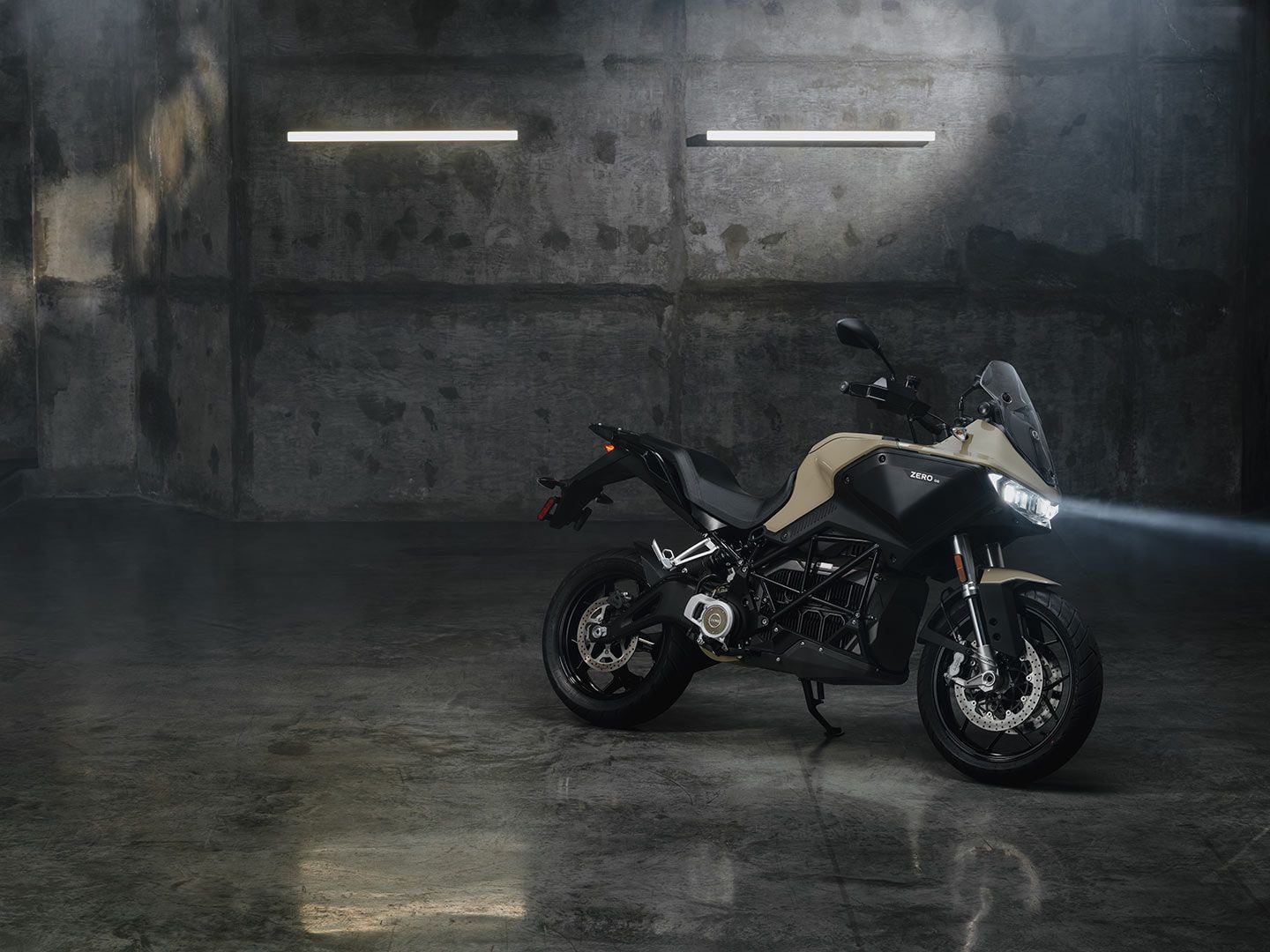
The DS is also updated substantially with new styling including the larger upper fairing and windshield, new motor, and new battery pack. (Zero Motorcycles/)The all-new DS is the ideal gateway model into Zero’s dual sport lineup. Like the Model S, the DS gets a new 14.4kWh battery pack which offers double the capacity of the previous model’s 7.2kWh unit. Power from the new motor has also increased and is now rated at 68 hp at 4,500 rpm with a stout 97 lb.-ft. of peak torque.
Claimed in-town range is 144 miles, while mixed city/highway range drops to 107 miles. Top speed is quoted at 104 mph. Seat height on the DS is identical to the DSR at 32.6 inches, while the claimed weight increases dramatically from 317 to 527 pounds with the much larger (heavier) battery pack, when compared to the previous 2023 DS model.
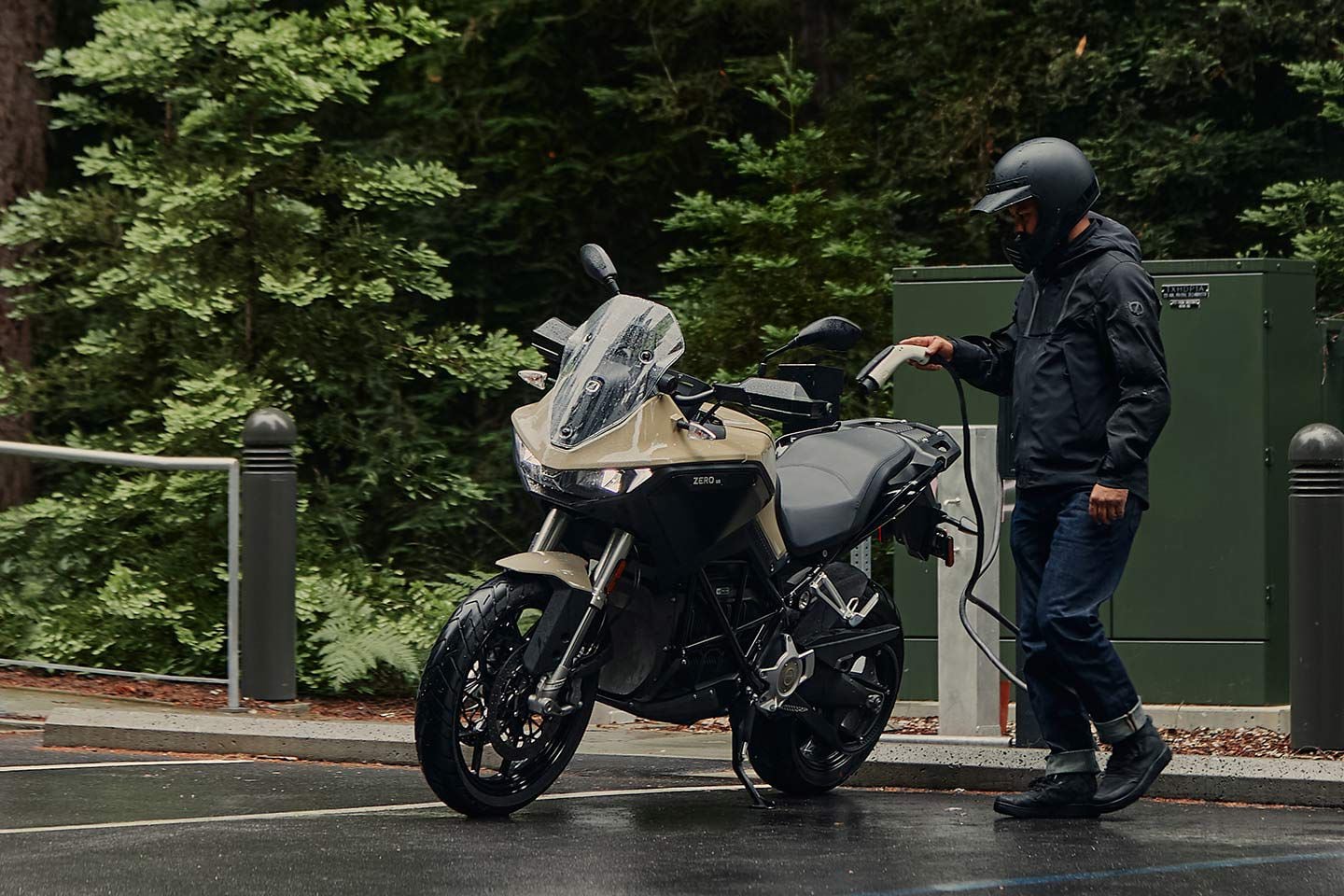
The DS gets a new 14.4kWh battery pack. (Zero Motorcycles/)Like the DSR, the DS gets a completely new look, with a large upper fairing and windshield in place of the minimalist front end of the former model. The DS is available in one color called Quicksand and will retail for $15,995.
For regions outside of the US, Zero will offer models that will conform to tiered-licensing laws like A2 (47 hp max) and then can be upgraded at the dealer to unleash the full A3 or A level performance (depending on regional rules) as the rider progresses through the tiers. The Model S and DS can also be purchased in an 11kW configuration in certain areas.
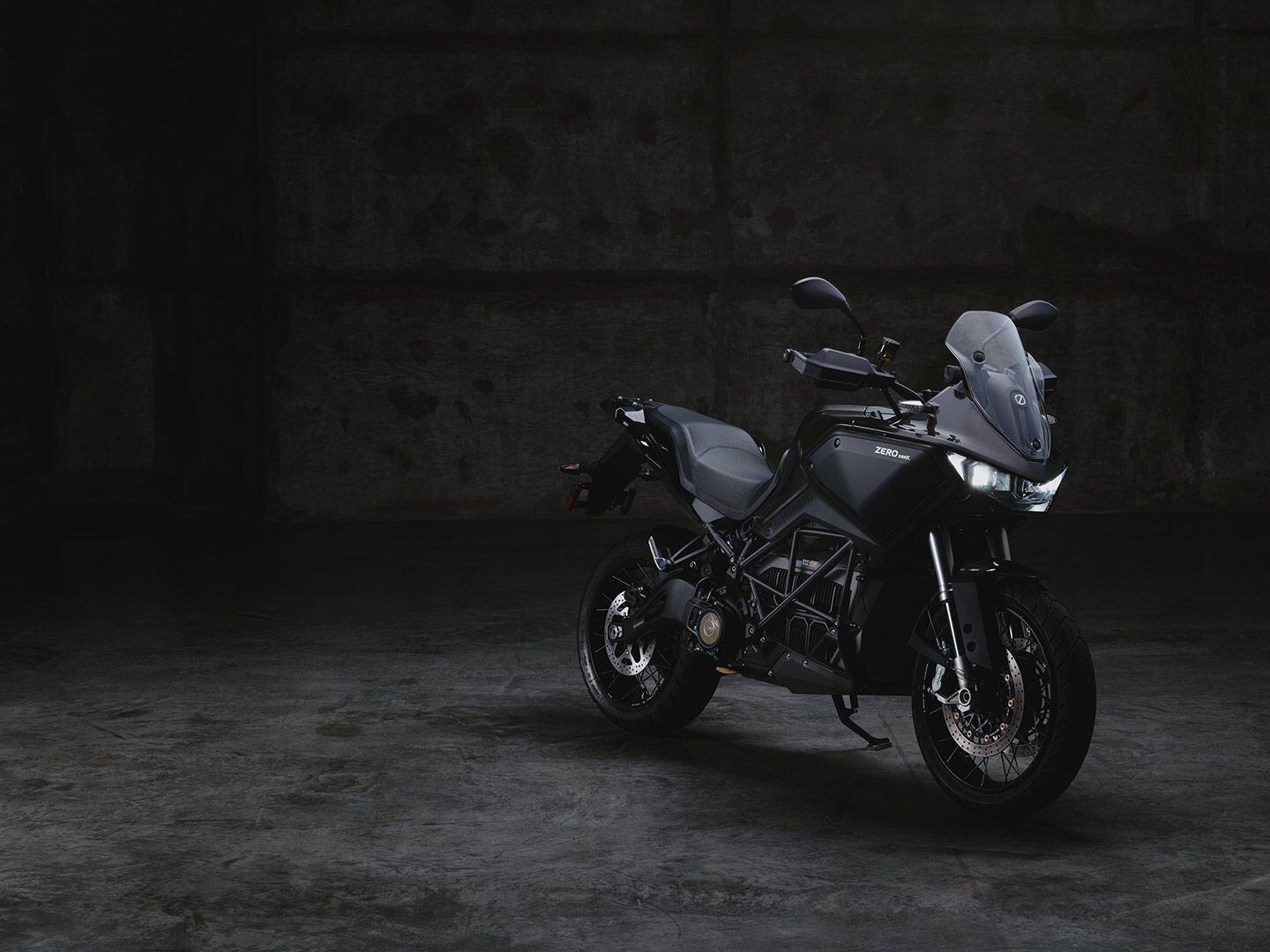
The Zero DSR/X returns for 2024 at $22,995. (Zero Motorcycles/)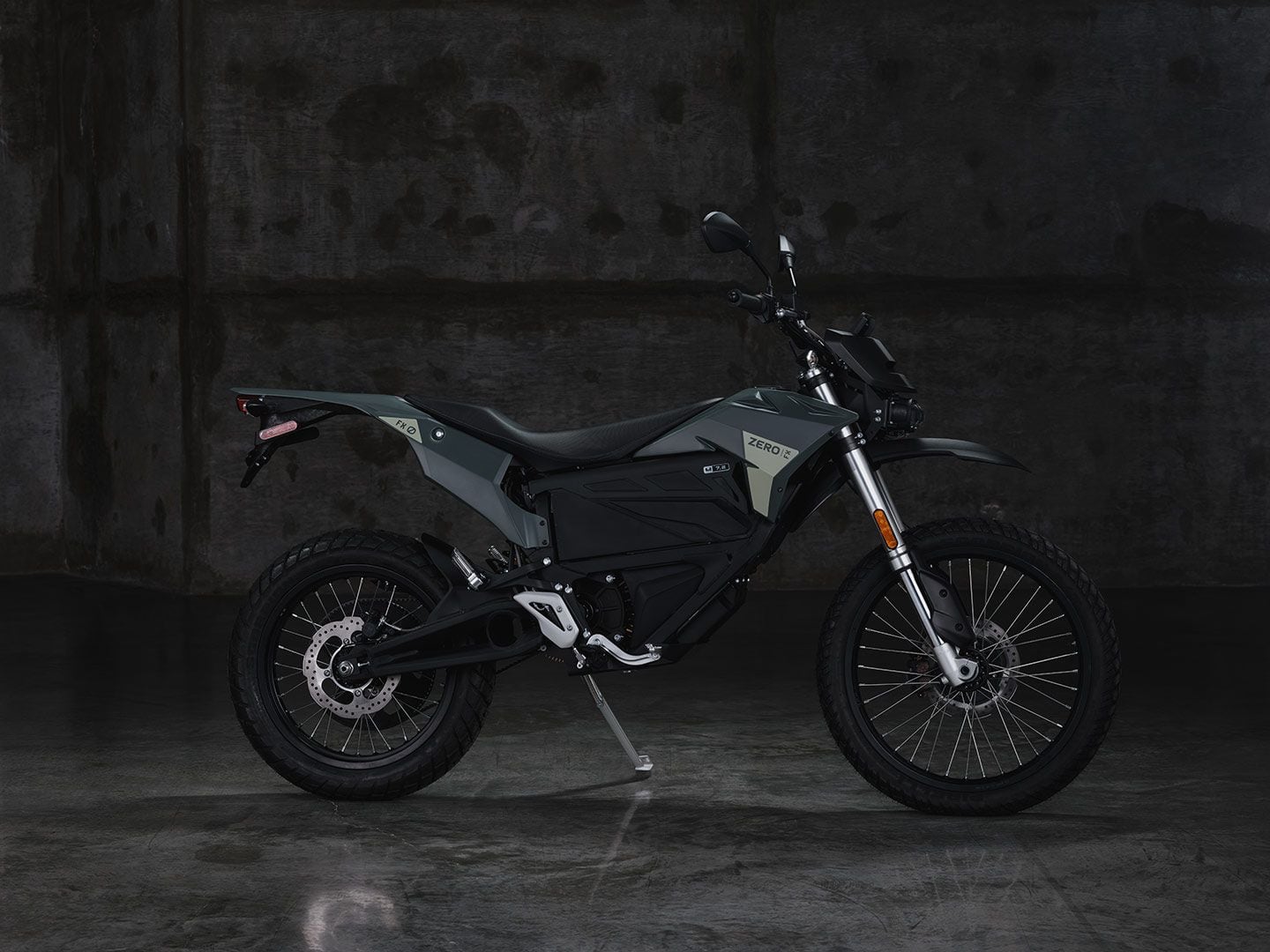
2024 Zero FX will retail for $12,495. (Zero Motorcycles/)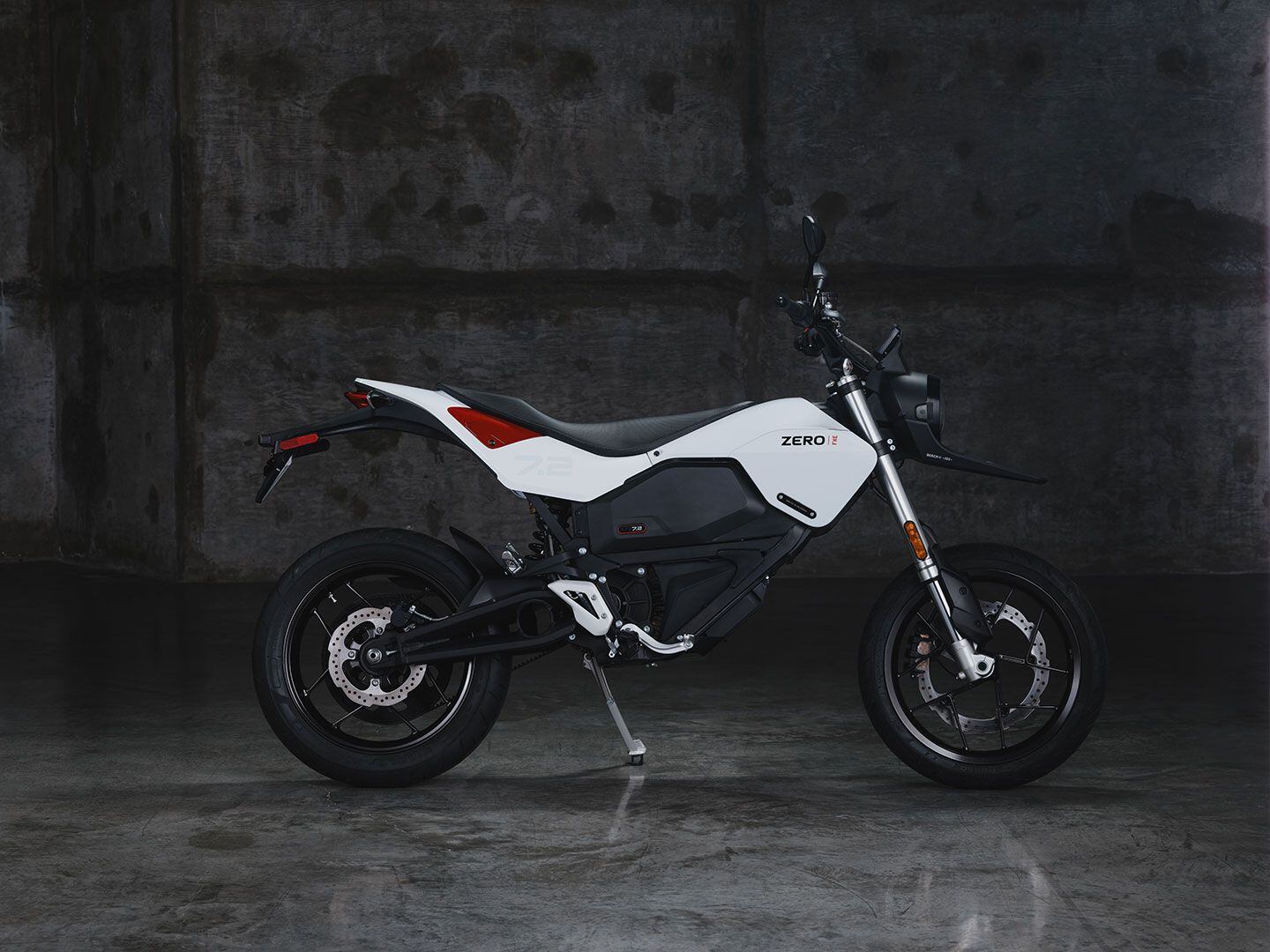
The $12,495 2024 Zero FXE. (Zero Motorcycles/)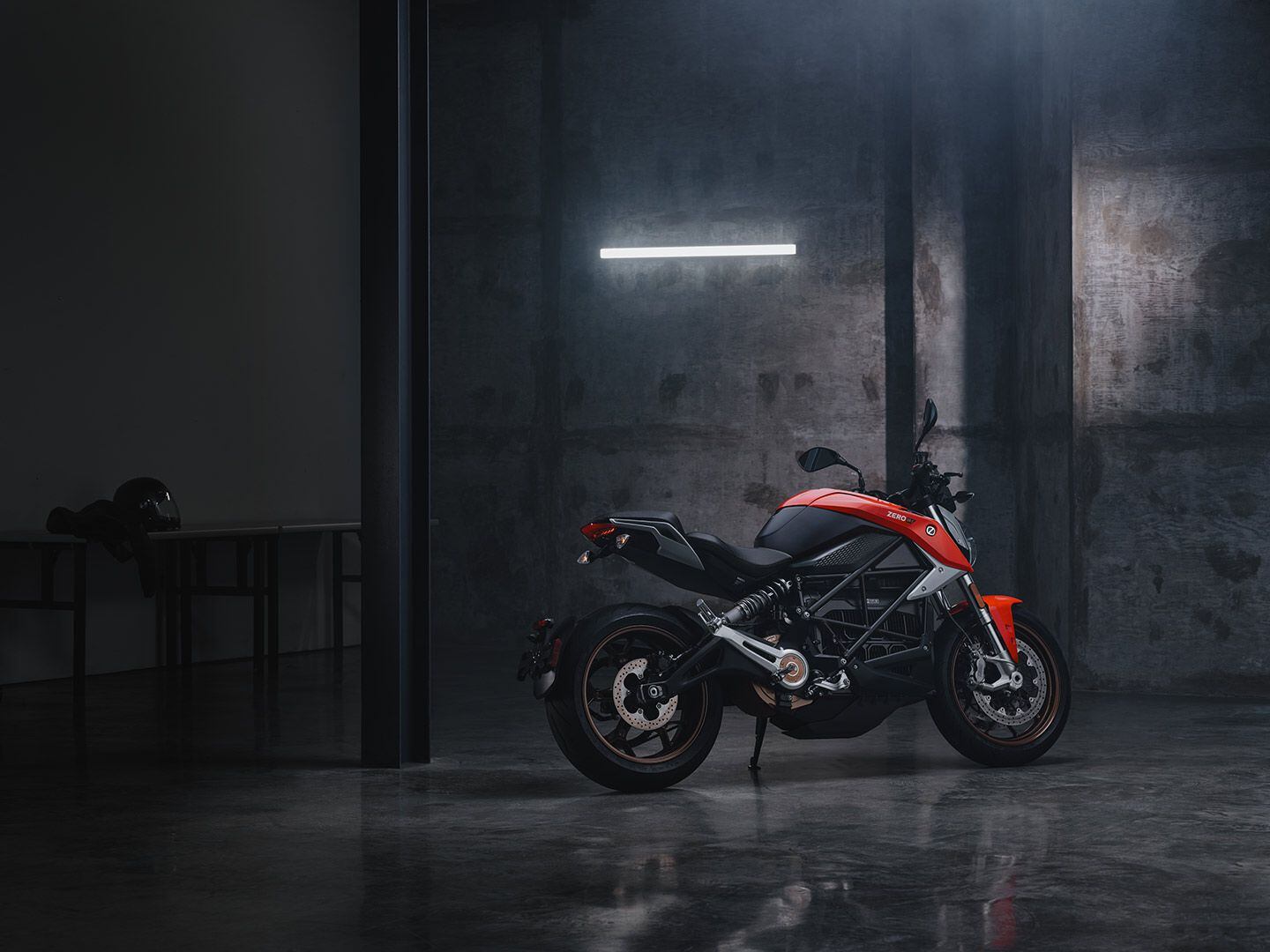
The 2024 Zero SR/F will return at $20,495. (Zero Motorcycles/)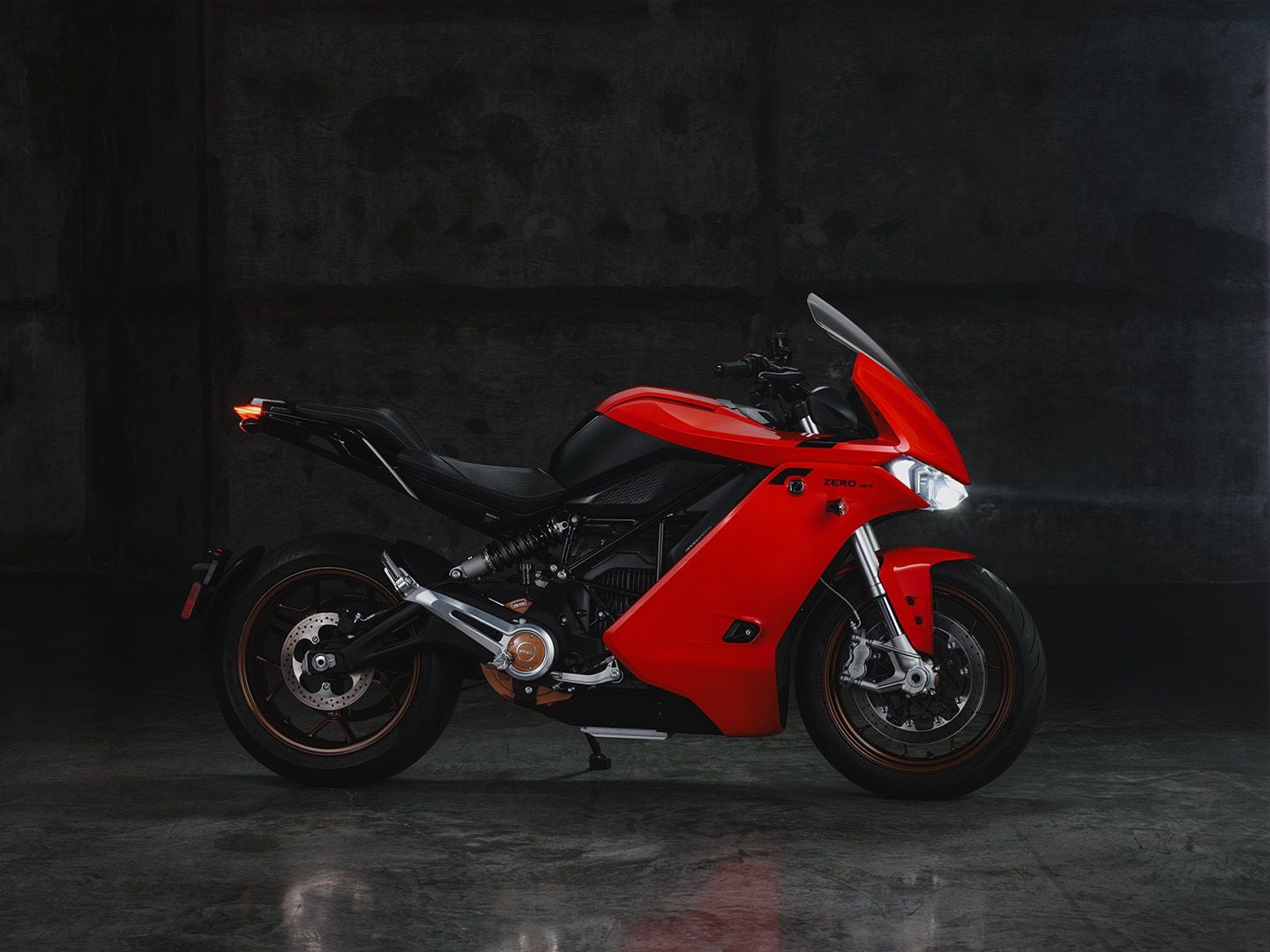
The $20,995 Zero SR/S also returns for 2024. (Zero Motorcycles/) -
The Electric Himalayan Test Bed is living proof that RE is serious about going electric.

CFMoto 450MT Coming in 2024
in Motorbike news
Posted
The 2024 CFMoto 450MT utilizes a 449.5cc parallel twin with a claimed 43.6 hp at 8,500 rpm. (CFMoto/)
CFMoto has been on a roll recently and chose EICMA in Milan to reveal the latest addition to its lineup in the form of the 450MT adventure bike. Packing a variant of the modern 449.5cc DOHC liquid-cooled parallel twin that made its debut in the 450SS and 450NK, the 450MT puts an adventure spin on the idea, retuning the motor to prioritize torque at lower rpm over peak power and wedging it into a lightweight, steel-tube chassis with long-travel suspension and a genuine adventure bike look.
The 2024 CFMoto 450MT features spoked wheels (21-inch front, 18-inch rear) with a single 320mm disc and four-piston J.Juan caliper up front and a 240mm disc with a single-piston caliper at the rear. (CFMoto/)
In the 450MT the engine puts out a claimed 43.6 bhp at 8,500 rpm, a fraction down on the 50 hp that the 450NK and 450SS manage, but also peaking 1,000 rpm lower in the rev range. Torque maxes out at 32.5 lb.-ft. and 6,250 rpm, which is around 4 lb.-ft. more than the sportier 450 twins manage, and arrives 1,350 rpm lower down in the curve. For an adventure bike, whether it’s being used off-road or for day-to-day use, those changes make a lot of sense. The engine’s 72mm bore and 55.2mm stroke are unchanged, as is the 11.5:1 compression ratio, suggesting the alterations come down to tweaks to the electronics and the camshafts.
CFMoto’s 450MT features a steel tube frame with an adjustable USD 41mm KYB fork and KYB monoshock both providing 7.9 inches of travel. (CFMoto/)
The engine slots into a steel-tube frame with adjustable KYB suspension at either end: a 41mm upside-down fork at the front and a rising-rate monoshock at the back with a remote adjuster, mounted on an aluminum swingarm. There are 7.9 inches of travel at each end and 8.7 inches of ground clearance. As you’d expect from a bike with off-road ideas, the wheels are wires with a 21-inch front and 18-inch rear. Braking duties are by a single 320mm front disc with a four-piston J.Juan caliper and a 240mm rear rotor with a single-pot caliper. Bosch ABS is standard, but can be switched off, and traction control is supplied by the same German brand.
The CFMoto 450MT has a 5-inch curved TFT display with smartphone connectivity and full LED lighting. (CFMoto/)
Once aboard you’re faced with a 5-inch curved TFT screen that includes all the usual connectivity for smartphones and a USB-C charging port, and all the lighting is LED—again in line with expectations in 2024. Unusually, CFMoto only quotes a dry weight for the bike, coming in at 386 pounds without fluids. Once the 4.6-gallon fuel tank is full and there’s oil and water in the engine, that will equate to somewhere in the region of 420 pounds ready to ride.
On the 2024 CFMoto 450MT, switchable Bosch supplied ABS comes standard. (CFMoto/)
CFMoto expects to get the 450MT into production in the first quarter of 2024, but there’s no definitive news on when the bike will reach US dealers or its price.
CFMoto’s 450MT features Bosch supplied traction control. (CFMoto/)
2024 CFMoto 450MT Specs
View the full article